-
 @ 6b0a60cf:b952e7d4
2025-05-19 22:33:33
@ 6b0a60cf:b952e7d4
2025-05-19 22:33:33タイトルは釣りです。そんなこと微塵も思っていません。 本稿はアウトボックスモデルの実装に関してうだうだ考えるコーナーです。 ダムスに関して何か言いたいわけではないので先にタイトル回収しておきます。
- NIP-65を守る気なんかさらさら無いのにNIP-65に書いてあるkind:10002のReadリレーの意味を知っていながら全然違う使い方をしているのは一部の和製クライアントの方だよね
- NIP-65を守る気が無いならkind:10002を使うべきではなく、独自仕様でリレーを保存するべきだよね
- アウトボックスモデルを採用しているクライアントからすれば仕様と異なる実装をしてしまっているクライアントが迷惑だと思われても仕方ないよね
- と考えればダムスの方が潔いよね
- とはいえkind:3のcontentは空にしろって言われてんだからやっぱダムスはゴミだわ
- やるとしたらRabbitみたいにローカルに保存するか、別デバイス間で同期したいならkind:30078を使うべきだよね
アウトボックスモデルはなぜ人気がないのか
言ってることはとてもいいと思うんですよ。 欠点があるとすれば、
- 末端のユーザーからすればreadリレーとwriteリレーと書かれると直感的にイメージされるものとかけ離れている
- 正しく設定してもらうには相当の説明が必要
- フォローTLを表示しようとすれば非常にたくさんのリレーと接続することになり現実的ではない
- なるほど完璧な作戦っスねーっ 不可能だという点に目をつぶればよぉ~
余談ですが昔irisでログインした時に localhost のリレーに繋ごうとしてiris壊れたって思ったけど今思えばアウトボックスモデルを忠実に実装してたんじゃないかな…。
現実的に実装する方法は無いのか
これでReadすべきリレーをシミュレーションできる。 https://nikolat.github.io/nostr-relay-trend/ フォローイーのWriteリレーを全部購読しようとすると100個近いリレー数になるので現実的ではありません。 しかしフォローイーのWriteリレーのうち1個だけでよい、とする条件を仮に追加すると一気にハードルが下がります。私の場合はReadリレー含めて7個のリレーに収まりました。 Nos Haikuはとりあえずこの方針でいくことにしました。
今後どうしていきたいのか
エンドユーザーとしての自分の志向としては、自分が指定したリレーだけを購読してほしい、勝手に余計なリレーを読みに行かないでほしい、という気持ちがあり、現状の和製クライアントの仕様を気に入っています。 仮にNos Haikuでアウトボックスモデルを採用しつつ自分の決めたリレーに接続するハイブリッド実装を考えるとすれば、
あなたの購読するリレーはこれですよー - Read(inbox) Relays (あなたへのメンションが届くリレー) - wss://relay1.example.com/ - wss://relay2.example.com/ - wss://relay3.example.com/ - Followee's Write Relays (フォローイーが書き込んでいるリレー) - wss://relay4.example.com/ - wss://relay5.example.com/ - wss://relay6.example.com/って出して、チェックボックス付けてON/OFFできるようにして最終的に購読するリレーをユーザーに決めてもらう感じかな……って漠然と考えています。よほど時間を持て余したときがあればやってみるかも。
あとリレーを数は仕方ないとしてリレーごとにフォローイーの投稿だけを取得するようにした方が理にかなってるよね。全部のリレーから全部のフォローイーの投稿を取得しようとしたら(実装はシンプルで楽だけど)通信量が大変だよね。 rx-nostr の Forward Strategy ってリレーごとにREQかえて一度に購読できるっけ?
常にひとつ以下の REQ サブスクリプションを保持します。
って書いてあるから無理なのかな? あとReadリレーは純粋に自分へのメンション(pタグ付き)イベントのみを購読するようにした方がいい気がする。スパム対策としてかなり有効だと思うので。スパムはNIP-65に準拠したりはしていないでしょうし。 まぁ、NIP-65に準拠していないクライアントからのメンションは届かなくなってしまうわけですが。
-
 @ 84b0c46a:417782f5
2025-05-18 12:22:32
@ 84b0c46a:417782f5
2025-05-18 12:22:32- Lumilumi The Nostr Web Client.
Lightweight modes are available, such as not displaying icon images, not loading images automatically, etc.
-
MAKIMONO A lightweight Long Form Content Editor with editing functionality for your articles. It supports embedding Nostr IDs via NIP-19 and custom emoji integration.
-
Nostr Share Component Demo A simple web component for sharing content to Nostr. Create customizable share buttons that let users easily post to Nostr clients with pre-filled content. Perfect for blogs, websites, or any content you want shared on the Nostr network. Try the interactive demo to see how seamlessly it integrates with your website.
Only clients that support receiving shared text via URL parameters can be added to the client list. If your preferred client meets this requirement, feel free to submit a pull request.
-
Nostr Follow Organizer A practical tool for managing your Nostr follows(kind3) with ease.
-
NAKE NAKE is a powerful utility for Nostr developers and users that simplifies working with NIP-19 and NIP-49 formats. This versatile tool allows you to easily encode and decode Nostr identifiers and encrypted data according to these protocol specifications.
- chrome extension
- firefox add-on
-
Nostviewstr A versatile Nostr tool that specializes in creating and editing addressable or replaceable events on the Nostr network. This comprehensive editor allows you to manage various types of lists and structured content within the Nostr ecosystem.
-
Luminostr Luminostr is a recovery tool for Nostr that helps you retrieve and restore Addressable or Replaceable events (such as kind: 0, 3, 10002, 10000, etc.) from relays. It allows you to search for these events across multiple relays and optionally re-publish them to ensure their persistence.
-
Nostr Bookmark Recovery Tool Nostr Bookmark Recovery Tool is a utility for retrieving and re-publishing past bookmark events ( kind:10003,30001,30003 ) from public relays. Rather than automatically selecting the latest version, it allows users to pick any previous version and overwrite the current one with it. This is useful for restoring a preferred snapshot of your bookmark list.
-
Profile Editor Profile Editor is a simple tool for editing and publishing your Nostr profile (kind: 0 event). It allows you to update fields such as name, display name, picture, and about text, and then publish the updated profile to selected relays.
-
Nostr bookmark viewer Nostr Bookmark Viewer is a tool for viewing and editing Nostr bookmark events (kind: 10003, 30001, 30003). It allows users to load bookmark data from relays, browse saved posts, and optionally edit and publish their own bookmark lists.
-
Nostr Note Duplicater Nostr Note Duplicater is a tool that rebroadcasts an existing Nostr event from a relay to other selected relays.
-
 @ e0a8cbd7:f642d154
2025-05-06 03:29:12
@ e0a8cbd7:f642d154
2025-05-06 03:29:12分散型プロトコルNostr上でWeb bookmarkを見たり書いたりする「Nostr Web Bookmark Trend」を試してみました。
NostrのWeb Bookmarkingは「nip-B0 Web Bookmarking· nostr-protocol/nips · GitHub」で定義されています。
WEBブラウザの拡張による認証(NIP-07)でログインしました。
create new web bookmark(新規ブックマーク作成)を開くとこんな感じ。
URL入力部分において、https:// が外に出ているので、URLのhttps:// 部分を消して入力しないといけないのがちょっと面倒。 ↓
↓

1個、投稿してみました。
アカウント名をクリックするとそのユーザが登録したbookmark一覧が表示されます。
以上、Nostr Web Bookmark Trendについてでした。
なお、本記事は「Nostr NIP-23 マークダウンエディタ」のテストのため、「NostrでWeb bookmark - あたしンちのおとうさんの独り言」と同じ内容を投稿したものです。 -
 @ 6b0a60cf:b952e7d4
2025-03-20 07:36:17
@ 6b0a60cf:b952e7d4
2025-03-20 07:36:17このイベント自身をnaddr形式で参照する nostr:naddr1qvzqqqr4gupzq6c2vr8l8m9952e9qhxt8acn8kzzypzuhm6q70fvvxylkzu49e75qydhwumn8ghj7mnjv4kxz7fwvvkhxar9d3kxzu3wdejhgtcqp5cnwdpjxs6n2de3xyenxwql6rq76
-
 @ 8fb140b4:f948000c
2025-03-20 01:29:06
@ 8fb140b4:f948000c
2025-03-20 01:29:06As many of you know, https://nostr.build has recently launched a new compatibility layer for the Blossom protocol blossom.band. You can find all the details about what it supports and its limitations by visiting the URL.
I wanted to cover some of the technical details about how it works here. One key difference you may notice is that the service acts as a linker, redirecting requests for the media hash to the actual source of the media—specifically, the nostr.build URL. This allows us to maintain a unified CDN cache and ensure that your media is served as quickly as possible.
Another difference is that each uploaded media/blob is served under its own subdomain (e.g.,
npub1[...].blossom.band), ensuring that your association with the blob is controlled by you. If you decide to delete the media for any reason, we ensure that the link is broken, even if someone else has duplicated it using the same hash.To comply with the Blossom protocol, we also link the same hash under the main (apex) domain (blossom.band) and collect all associations under it. This ensures that Blossom clients can fetch media based on users’ Blossom server settings. If you are the sole owner of the hash and there are no duplicates, deleting the media removes the link from the main domain as well.
Lastly, in line with our mission to protect users’ privacy, we reject any media that contains private metadata (such as GPS coordinates, user comments, or camera serial numbers) or strip it if you use the
/media/endpoint for upload.As always, your feedback is welcome and appreciated. Thank you!
-
 @ c631e267:c2b78d3e
2025-05-16 18:40:18
@ c631e267:c2b78d3e
2025-05-16 18:40:18Die zwei mächtigsten Krieger sind Geduld und Zeit. \ Leo Tolstoi
Zum Wohle unserer Gesundheit, unserer Leistungsfähigkeit und letztlich unseres Glücks ist es wichtig, die eigene Energie bewusst zu pflegen. Das gilt umso mehr für an gesellschaftlichen Themen interessierte, selbstbewusste und kritisch denkende Menschen. Denn für deren Wahrnehmung und Wohlbefinden waren und sind die rasanten, krisen- und propagandagefüllten letzten Jahre in Absurdistan eine harte Probe.
Nur wer regelmäßig Kraft tankt und Wege findet, mit den Herausforderungen umzugehen, kann eine solche Tortur überstehen, emotionale Erschöpfung vermeiden und trotz allem zufrieden sein. Dazu müssen wir erkunden, was uns Energie gibt und was sie uns raubt. Durch Selbstreflexion und Achtsamkeit finden wir sicher Dinge, die uns erfreuen und inspirieren, und andere, die uns eher stressen und belasten.
Die eigene Energie ist eng mit unserer körperlichen und mentalen Gesundheit verbunden. Methoden zur Förderung der körperlichen Gesundheit sind gut bekannt: eine ausgewogene Ernährung, regelmäßige Bewegung sowie ausreichend Schlaf und Erholung. Bei der nicht minder wichtigen emotionalen Balance wird es schon etwas komplizierter. Stress abzubauen, die eigenen Grenzen zu kennen oder solche zum Schutz zu setzen sowie die Konzentration auf Positives und Sinnvolles wären Ansätze.
Der emotionale ist auch der Bereich, über den «Energie-Räuber» bevorzugt attackieren. Das sind zum Beispiel Dinge wie Überforderung, Perfektionismus oder mangelhafte Kommunikation. Social Media gehören ganz sicher auch dazu. Sie stehlen uns nicht nur Zeit, sondern sind höchst manipulativ und erhöhen laut einer aktuellen Studie das Risiko für psychische Probleme wie Angstzustände und Depressionen.
Geben wir negativen oder gar bösen Menschen keine Macht über uns. Das Dauerfeuer der letzten Jahre mit Krisen, Konflikten und Gefahren sollte man zwar kennen, darf sich aber davon nicht runterziehen lassen. Das Ziel derartiger konzertierter Aktionen ist vor allem, unsere innere Stabilität zu zerstören, denn dann sind wir leichter zu steuern. Aber Geduld: Selbst vermeintliche «Sonnenköniginnen» wie EU-Kommissionspräsidentin von der Leyen fallen, wenn die Zeit reif ist.
Es ist wichtig, dass wir unsere ganz eigenen Bedürfnisse und Werte erkennen. Unsere Energiequellen müssen wir identifizieren und aktiv nutzen. Dazu gehören soziale Kontakte genauso wie zum Beispiel Hobbys und Leidenschaften. Umgeben wir uns mit Sinnhaftigkeit und lassen wir uns nicht die Energie rauben!
Mein Wahlspruch ist schon lange: «Was die Menschen wirklich bewegt, ist die Kultur.» Jetzt im Frühjahr beginnt hier in Andalusien die Zeit der «Ferias», jener traditionellen Volksfeste, die vor Lebensfreude sprudeln. Konzentrieren wir uns auf die schönen Dinge und auf unsere eigenen Talente – soziale Verbundenheit wird helfen, unsere innere Kraft zu stärken und zu bewahren.
[Titelbild: Pixabay]
Dieser Beitrag wurde mit dem Pareto-Client geschrieben und ist zuerst auf Transition News erschienen.
-
 @ 82b30d30:40c6c003
2025-03-17 15:26:29
@ 82b30d30:40c6c003
2025-03-17 15:26:29[3]
[4]
[5]
[6]
[7]
[8]
[9]
[10]
[11]
[12]
[13]
[14]
[15]
[16]
[17]
[18]
[19]
[20]
[21]
[22]
[23]
[24]
[25]
[26]
[27]
[28]
[29]
[30]
[31]
[32]
[33]
-
 @ c631e267:c2b78d3e
2025-05-10 09:50:45
@ c631e267:c2b78d3e
2025-05-10 09:50:45Information ohne Reflexion ist geistiger Flugsand. \ Ernst Reinhardt
Der lateinische Ausdruck «Quo vadis» als Frage nach einer Entwicklung oder Ausrichtung hat biblische Wurzeln. Er wird aber auch in unserer Alltagssprache verwendet, laut Duden meist als Ausdruck von Besorgnis oder Skepsis im Sinne von: «Wohin wird das führen?»
Der Sinn und Zweck von so mancher politischen Entscheidung erschließt sich heutzutage nicht mehr so leicht, und viele Trends können uns Sorge bereiten. Das sind einerseits sehr konkrete Themen wie die zunehmende Militarisierung und die geschichtsvergessene Kriegstreiberei in Europa, deren Feindbildpflege aktuell beim Gedenken an das Ende des Zweiten Weltkriegs beschämende Formen annimmt.
Auch das hohe Gut der Schweizer Neutralität scheint immer mehr in Gefahr. Die schleichende Bewegung der Eidgenossenschaft in Richtung NATO und damit weg von einer Vermittlerposition erhält auch durch den neuen Verteidigungsminister Anschub. Martin Pfister möchte eine stärkere Einbindung in die europäische Verteidigungsarchitektur, verwechselt bei der Argumentation jedoch Ursache und Wirkung.
Das Thema Gesundheit ist als Zugpferd für Geschäfte und Kontrolle offenbar schon zuverlässig etabliert. Die hauptsächlich privat finanzierte Weltgesundheitsorganisation (WHO) ist dabei durch ein Netzwerk von sogenannten «Collaborating Centres» sogar so weit in nationale Einrichtungen eingedrungen, dass man sich fragen kann, ob diese nicht von Genf aus gesteuert werden.
Das Schweizer Bundesamt für Gesundheit (BAG) übernimmt in dieser Funktion ebenso von der WHO definierte Aufgaben und Pflichten wie das deutsche Robert Koch-Institut (RKI). Gegen die Covid-«Impfung» für Schwangere, die das BAG empfiehlt, obwohl es fehlende wissenschaftliche Belege für deren Schutzwirkung einräumt, formiert sich im Tessin gerade Widerstand.
Unter dem Stichwort «Gesundheitssicherheit» werden uns die Bestrebungen verkauft, essenzielle Dienste mit einer biometrischen digitalen ID zu verknüpfen. Das dient dem Profit mit unseren Daten und führt im Ergebnis zum Verlust unserer demokratischen Freiheiten. Die deutsche elektronische Patientenakte (ePA) ist ein Element mit solchem Potenzial. Die Schweizer Bürger haben gerade ein Referendum gegen das revidierte E-ID-Gesetz erzwungen. In Thailand ist seit Anfang Mai für die Einreise eine «Digital Arrival Card» notwendig, die mit ihrer Gesundheitserklärung einen Impfpass «durch die Hintertür» befürchten lässt.
Der massive Blackout auf der iberischen Halbinsel hat vermehrt Fragen dazu aufgeworfen, wohin uns Klimawandel-Hysterie und «grüne» Energiepolitik führen werden. Meine Kollegin Wiltrud Schwetje ist dem nachgegangen und hat in mehreren Beiträgen darüber berichtet. Wenig überraschend führen interessante Spuren mal wieder zu internationalen Großbanken, Globalisten und zur EU-Kommission.
Zunehmend bedenklich ist aber ganz allgemein auch die manifestierte Spaltung unserer Gesellschaften. Angesichts der tiefen und sorgsam gepflegten Gräben fällt es inzwischen schwer, eine zukunftsfähige Perspektive zu erkennen. Umso begrüßenswerter sind Initiativen wie die Kölner Veranstaltungsreihe «Neue Visionen für die Zukunft». Diese möchte die Diskussionskultur reanimieren und dazu beitragen, dass Menschen wieder ohne Angst und ergebnisoffen über kontroverse Themen der Zeit sprechen.
Quo vadis – Wohin gehen wir also? Die Suche nach Orientierung in diesem vermeintlichen Chaos führt auch zur Reflexion über den eigenen Lebensweg. Das ist positiv insofern, als wir daraus Kraft schöpfen können. Ob derweil der neue Papst, dessen «Vorgänger» Petrus unsere Ausgangsfrage durch die christliche Legende zugeschrieben wird, dabei eine Rolle spielt, muss jede/r selbst wissen. Mir persönlich ist allein schon ein Führungsanspruch wie der des Petrusprimats der römisch-katholischen Kirche eher suspekt.
[Titelbild: Pixabay]
Dieser Beitrag wurde mit dem Pareto-Client geschrieben und ist zuerst auf Transition News erschienen.
-
 @ 6b0a60cf:b952e7d4
2025-03-17 11:03:41
@ 6b0a60cf:b952e7d4
2025-03-17 11:03:41ものさんに説明する用
CreateEntry.svelte で
previewEvent = $bindable()として受け取っているのがプレビュー用のイベント。
ここでごちゃごちゃ変更して呼び出し元に変更を反映させる。
呼び出し元は Page.svelte と Entry.svelte の2つ。
前者が投稿欄、後者が返信欄のプレビューをそれぞれこんな感じでリアクティブで定義している。let previewEvent: UnsignedEvent | undefined = $state();CreateEntry.svelte では受け取った previewEvent を $derived.by() や $effect() を使って他の変数に依存して勝手に変わるようにしている。
特に contentToSend に依存して変わるので、入力の度に勝手に変わる。
contentToSend は textarea で bind:value しているので onChange とか onKeyPress とかはまったく使わない。勝手に変わってくれる。 ```makeEvent() っていうのが入力された色々を突っ込むとプレビュー用の UnsignedEvent を返してくれるやつ。 1文字入力されてcontentToSendが変わる度にこれが処理される。うわー。 このイベントには付与すべきpタグも含まれている。 これをpubkeysMentioningToとして定義する。const pubkeysMentioningTo = $derived( previewEvent?.tags.filter((tag) => tag.length >= 2 && tag[0] === 'p').map((tag) => tag[1]) ?? [] );あとは除外したいpタグリストpubkeysExcludedを定義して、let pubkeysExcluded: string[] = $state([]); ``` pubkeysMentioningToの中からユーザーに選んでもらう。
実際に送信するイベントはpubkeysExcludedも考慮して署名する。
送信する際もmakeEvent()を呼んでるけど、こっちは引数にpubkeysExcludedが入ってる。プレビューの方には入ってない。 -
 @ c631e267:c2b78d3e
2025-05-02 20:05:22
@ c631e267:c2b78d3e
2025-05-02 20:05:22Du bist recht appetitlich oben anzuschauen, \ doch unten hin die Bestie macht mir Grauen. \ Johann Wolfgang von Goethe
Wie wenig bekömmlich sogenannte «Ultra-Processed Foods» wie Fertiggerichte, abgepackte Snacks oder Softdrinks sind, hat kürzlich eine neue Studie untersucht. Derweil kann Fleisch auch wegen des Einsatzes antimikrobieller Mittel in der Massentierhaltung ein Problem darstellen. Internationale Bemühungen, diesen Gebrauch zu reduzieren, um die Antibiotikaresistenz bei Menschen einzudämmen, sind nun möglicherweise gefährdet.
Leider ist Politik oft mindestens genauso unappetitlich und ungesund wie diverse Lebensmittel. Die «Corona-Zeit» und ihre Auswirkungen sind ein beredtes Beispiel. Der Thüringer Landtag diskutiert gerade den Entwurf eines «Coronamaßnahmen-Unrechtsbereinigungsgesetzes» und das kanadische Gesundheitsministerium versucht, tausende Entschädigungsanträge wegen Impfnebenwirkungen mit dem Budget von 75 Millionen Dollar unter einen Hut zu bekommen. In den USA soll die Zulassung von Covid-«Impfstoffen» überdacht werden, während man sich mit China um die Herkunft des Virus streitet.
Wo Corona-Verbrecher von Medien und Justiz gedeckt werden, verfolgt man Aufklärer und Aufdecker mit aller Härte. Der Anwalt und Mitbegründer des Corona-Ausschusses Reiner Fuellmich, der seit Oktober 2023 in Untersuchungshaft sitzt, wurde letzte Woche zu drei Jahren und neun Monaten verurteilt – wegen Veruntreuung. Am Mittwoch teilte der von vielen Impfschadensprozessen bekannte Anwalt Tobias Ulbrich mit, dass er vom Staatsschutz verfolgt wird und sich daher künftig nicht mehr öffentlich äußern werde.
Von der kommenden deutschen Bundesregierung aus Wählerbetrügern, Transatlantikern, Corona-Hardlinern und Russenhassern kann unmöglich eine Verbesserung erwartet werden. Nina Warken beispielsweise, die das Ressort Gesundheit übernehmen soll, diffamierte Maßnahmenkritiker als «Coronaleugner» und forderte eine Impfpflicht, da die wundersamen Injektionen angeblich «nachweislich helfen». Laut dem designierten Außenminister Johann Wadephul wird Russland «für uns immer der Feind» bleiben. Deswegen will er die Ukraine «nicht verlieren lassen» und sieht die Bevölkerung hinter sich, solange nicht deutsche Soldaten dort sterben könnten.
Eine wichtige Personalie ist auch die des künftigen Regierungssprechers. Wenngleich Hebestreit an Arroganz schwer zu überbieten sein wird, dürfte sich die Art der Kommunikation mit Stefan Kornelius in der Sache kaum ändern. Der Politikchef der Süddeutschen Zeitung «prägte den Meinungsjournalismus der SZ» und schrieb «in dieser Rolle auch für die Titel der Tamedia». Allerdings ist, anders als noch vor zehn Jahren, die Einbindung von Journalisten in Thinktanks wie die Deutsche Atlantische Gesellschaft (DAG) ja heute eher eine Empfehlung als ein Problem.
Ungesund ist definitiv auch die totale Digitalisierung, nicht nur im Gesundheitswesen. Lauterbachs Abschiedsgeschenk, die «abgesicherte» elektronische Patientenakte (ePA) ist völlig überraschenderweise direkt nach dem Bundesstart erneut gehackt worden. Norbert Häring kommentiert angesichts der Datenlecks, wer die ePA nicht abwähle, könne seine Gesundheitsdaten ebensogut auf Facebook posten.
Dass die staatlichen Kontrolleure so wenig auf freie Software und dezentrale Lösungen setzen, verdeutlicht die eigentlichen Intentionen hinter der Digitalisierungswut. Um Sicherheit und Souveränität geht es ihnen jedenfalls nicht – sonst gäbe es zum Beispiel mehr Unterstützung für Bitcoin und für Initiativen wie die der Spar-Supermärkte in der Schweiz.
[Titelbild: Pixabay]
Dieser Beitrag wurde mit dem Pareto-Client geschrieben und ist zuerst auf Transition News erschienen.
-
 @ 6b0a60cf:b952e7d4
2025-03-06 02:45:45
@ 6b0a60cf:b952e7d4
2025-03-06 02:45:45とあるSNSで海外の相互さん(以降、Aさんと呼ぶ)からDMで相談されたことがあって、思ったことをつらつらと書いてみる。
非公開の場での相談なので多少ぼかしを入れるけど。事の経緯
発端は、Aさんの友人が作品に日本人作者の素材を使用しようとしていて、その利用規約を翻訳して読んだらうまく翻訳されなくて理解が正しいのかわからない、なので間違いが無いか確認してほしい、という相談だった。
あー、確かに日本語特有の回りくどい表現があるねー、と思いながらバシッと簡潔に意訳してお伝えしたところ、スッキリ理解していただけたらしく一件落着となった。独自ライセンス文化
しかしまあ、創作界隈における作品・素材の利用規約というものは総じて長くて細かい。
ジャンルによるのかもしれないけれど。
自分は絵や音を創ることは無いがプログラムのコードを書く趣味はあるのでプログラム向けのライセンスを利用している。MITとかGPLとかいうやつ。
創作向けであればCCライセンスが適しているだろう。しかしこれがなかなか広まらない。
杓子定規のライセンスでは表しきれないような特別な希望があるのだろう。
そして独自ライセンスが跋扈することとなる。NO MORE 映画泥棒
特に気になるのが、「泥棒をしてはいけません」レベルの注意書きが散見されるのだ。
わざわざライセンスに書くことではない。あなたが警告するまでもなく、違法な行為は処罰される。
でも、たぶん効果があるからこういうのが広まるのだろう。
「泥棒してはいけないって書いてないから泥棒しました」というレベルの利用者が存在するのだろう。
そういう人は書いてあっても読んでないか、理屈をこねて泥棒するんだろうと思うけれども。その術はオレに効く
で、そういう警告文が魔除けの札のごとくびっしり貼られていると、こちらにやましい心が無くても、ちょっとこの素材は利用しないほうがよさそうだな……と思って引き返してしまうことがある。
SNSで可愛い絵を見て、作者さんをフォローしようと思ったら「無断転載禁止」みたいなのがプロフにずらずら書いてあって「おっと……」みたいに引き返すことがあるが、それに似ている。
きっと過去によくない体験をしてしまって、そのようにプロフに書くことでそれが改善するという実体験があって、そうなっているのだろうと推測している。異文化の壁を超えて
冒頭で話したAさんはきわめて紳士的な方であり、日本文化に対してもよく理解しようと努めてくれるので、話が通じやすくて助かったし、件の素材についても臆すること無く使用することになりそうだった。
ただ魔除けの札が効かないような魑魅魍魎にはいくら札を貼っても意味がないし、実際の悪魔祓いの効果と善良な利用者をも祓ってしまう機会損失(?)を比べて合理的なのだろうか、と考えたりしたのでした。オチは無い。ライセンス
この文章は CC0 1.0 でライセンスします。
Nostrイベントとして公開する以上はNIPsに従う範囲内で自由に利用されることを望みます。
NIPsに違反したご利用は他のクライアントの利用者にご迷惑になるのでご遠慮いただくことを希望します。^1 -
 @ c631e267:c2b78d3e
2025-04-25 20:06:24
@ c631e267:c2b78d3e
2025-04-25 20:06:24Die Wahrheit verletzt tiefer als jede Beleidigung. \ Marquis de Sade
Sagen Sie niemals «Terroristin B.», «Schwachkopf H.», «korrupter Drecksack S.» oder «Meinungsfreiheitshasserin F.» und verkneifen Sie sich Memes, denn so etwas könnte Ihnen als Beleidigung oder Verleumdung ausgelegt werden und rechtliche Konsequenzen haben. Auch mit einer Frau M.-A. S.-Z. ist in dieser Beziehung nicht zu spaßen, sie gehört zu den Top-Anzeigenstellern.
«Politikerbeleidigung» als Straftatbestand wurde 2021 im Kampf gegen «Rechtsextremismus und Hasskriminalität» in Deutschland eingeführt, damals noch unter der Regierung Merkel. Im Gesetz nicht festgehalten ist die Unterscheidung zwischen schlechter Hetze und guter Hetze – trotzdem ist das gängige Praxis, wie der Titel fast schon nahelegt.
So dürfen Sie als Politikerin heute den Tesla als «Nazi-Auto» bezeichnen und dies ausdrücklich auf den Firmengründer Elon Musk und dessen «rechtsextreme Positionen» beziehen, welche Sie nicht einmal belegen müssen. [1] Vielleicht ernten Sie Proteste, jedoch vorrangig wegen der «gut bezahlten, unbefristeten Arbeitsplätze» in Brandenburg. Ihren Tweet hat die Berliner Senatorin Cansel Kiziltepe inzwischen offenbar dennoch gelöscht.
Dass es um die Meinungs- und Pressefreiheit in der Bundesrepublik nicht mehr allzu gut bestellt ist, befürchtet man inzwischen auch schon im Ausland. Der Fall des Journalisten David Bendels, der kürzlich wegen eines Faeser-Memes zu sieben Monaten Haft auf Bewährung verurteilt wurde, führte in diversen Medien zu Empörung. Die Welt versteckte ihre Kritik mit dem Titel «Ein Urteil wie aus einer Diktatur» hinter einer Bezahlschranke.
Unschöne, heutzutage vielleicht strafbare Kommentare würden mir auch zu einigen anderen Themen und Akteuren einfallen. Ein Kandidat wäre der deutsche Bundesgesundheitsminister (ja, er ist es tatsächlich immer noch). Während sich in den USA auf dem Gebiet etwas bewegt und zum Beispiel Robert F. Kennedy Jr. will, dass die Gesundheitsbehörde (CDC) keine Covid-Impfungen für Kinder mehr empfiehlt, möchte Karl Lauterbach vor allem das Corona-Lügengebäude vor dem Einsturz bewahren.
«Ich habe nie geglaubt, dass die Impfungen nebenwirkungsfrei sind», sagte Lauterbach jüngst der ZDF-Journalistin Sarah Tacke. Das steht in krassem Widerspruch zu seiner früher verbreiteten Behauptung, die Gen-Injektionen hätten keine Nebenwirkungen. Damit entlarvt er sich selbst als Lügner. Die Bezeichnung ist absolut berechtigt, dieser Mann dürfte keinerlei politische Verantwortung tragen und das Verhalten verlangt nach einer rechtlichen Überprüfung. Leider ist ja die Justiz anderweitig beschäftigt und hat außerdem selbst keine weiße Weste.
Obendrein kämpfte der Herr Minister für eine allgemeine Impfpflicht. Er beschwor dabei das Schließen einer «Impflücke», wie es die Weltgesundheitsorganisation – die «wegen Trump» in finanziellen Schwierigkeiten steckt – bis heute tut. Die WHO lässt aktuell ihre «Europäische Impfwoche» propagieren, bei der interessanterweise von Covid nicht mehr groß die Rede ist.
Einen «Klima-Leugner» würden manche wohl Nir Shaviv nennen, das ist ja nicht strafbar. Der Astrophysiker weist nämlich die Behauptung von einer Klimakrise zurück. Gemäß seiner Forschung ist mindestens die Hälfte der Erderwärmung nicht auf menschliche Emissionen, sondern auf Veränderungen im Sonnenverhalten zurückzuführen.
Das passt vielleicht auch den «Klima-Hysterikern» der britischen Regierung ins Konzept, die gerade Experimente zur Verdunkelung der Sonne angekündigt haben. Produzenten von Kunstfleisch oder Betreiber von Insektenfarmen würden dagegen vermutlich die Geschichte vom fatalen CO2 bevorzugen. Ihnen würde es besser passen, wenn der verantwortungsvolle Erdenbürger sein Verhalten gründlich ändern müsste.
In unserer völlig verkehrten Welt, in der praktisch jede Verlautbarung außerhalb der abgesegneten Narrative potenziell strafbar sein kann, gehört fast schon Mut dazu, Dinge offen anzusprechen. Im «besten Deutschland aller Zeiten» glaubten letztes Jahr nur noch 40 Prozent der Menschen, ihre Meinung frei äußern zu können. Das ist ein Armutszeugnis, und es sieht nicht gerade nach Besserung aus. Umso wichtiger ist es, dagegen anzugehen.
[Titelbild: Pixabay]
--- Quellen: ---
[1] Zur Orientierung wenigstens ein paar Hinweise zur NS-Vergangenheit deutscher Automobilhersteller:
- Volkswagen
- Porsche
- Daimler-Benz
- BMW
- Audi
- Opel
- Heute: «Auto-Werke für die Rüstung? Rheinmetall prüft Übernahmen»
Dieser Beitrag wurde mit dem Pareto-Client geschrieben und ist zuerst auf Transition News erschienen.
-
 @ ec42c765:328c0600
2025-02-05 23:45:09
@ ec42c765:328c0600
2025-02-05 23:45:09test
test
-
 @ ec42c765:328c0600
2025-02-05 23:43:35
@ ec42c765:328c0600
2025-02-05 23:43:35test
-
 @ c631e267:c2b78d3e
2025-04-20 19:54:32
@ c631e267:c2b78d3e
2025-04-20 19:54:32Es ist völlig unbestritten, dass der Angriff der russischen Armee auf die Ukraine im Februar 2022 strikt zu verurteilen ist. Ebenso unbestritten ist Russland unter Wladimir Putin keine brillante Demokratie. Aus diesen Tatsachen lässt sich jedoch nicht das finstere Bild des russischen Präsidenten – und erst recht nicht des Landes – begründen, das uns durchweg vorgesetzt wird und den Kern des aktuellen europäischen Bedrohungs-Szenarios darstellt. Da müssen wir schon etwas genauer hinschauen.
Der vorliegende Artikel versucht derweil nicht, den Einsatz von Gewalt oder die Verletzung von Menschenrechten zu rechtfertigen oder zu entschuldigen – ganz im Gegenteil. Dass jedoch der Verdacht des «Putinverstehers» sofort latent im Raume steht, verdeutlicht, was beim Thema «Russland» passiert: Meinungsmache und Manipulation.
Angesichts der mentalen Mobilmachung seitens Politik und Medien sowie des Bestrebens, einen bevorstehenden Krieg mit Russland geradezu herbeizureden, ist es notwendig, dieser fatalen Entwicklung entgegenzutreten. Wenn wir uns nur ein wenig von der herrschenden Schwarz-Weiß-Malerei freimachen, tauchen automatisch Fragen auf, die Risse im offiziellen Narrativ enthüllen. Grund genug, nachzuhaken.
Wer sich schon länger auch abseits der Staats- und sogenannten Leitmedien informiert, der wird in diesem Artikel vermutlich nicht viel Neues erfahren. Andere könnten hier ein paar unbekannte oder vergessene Aspekte entdecken. Möglicherweise klärt sich in diesem Kontext die Wahrnehmung der aktuellen (unserer eigenen!) Situation ein wenig.
Manipulation erkennen
Corona-«Pandemie», menschengemachter Klimawandel oder auch Ukraine-Krieg: Jede Menge Krisen, und für alle gibt es ein offizielles Narrativ, dessen Hinterfragung unerwünscht ist. Nun ist aber ein Narrativ einfach eine Erzählung, eine Geschichte (Latein: «narratio») und kein Tatsachenbericht. Und so wie ein Märchen soll auch das Narrativ eine Botschaft vermitteln.
Über die Methoden der Manipulation ist viel geschrieben worden, sowohl in Bezug auf das Individuum als auch auf die Massen. Sehr wertvolle Tipps dazu, wie man Manipulationen durchschauen kann, gibt ein Büchlein [1] von Albrecht Müller, dem Herausgeber der NachDenkSeiten.
Die Sprache selber eignet sich perfekt für die Manipulation. Beispielsweise kann die Wortwahl Bewertungen mitschwingen lassen, regelmäßiges Wiederholen (gerne auch von verschiedenen Seiten) lässt Dinge irgendwann «wahr» erscheinen, Übertreibungen fallen auf und hinterlassen wenigstens eine Spur im Gedächtnis, genauso wie Andeutungen. Belege spielen dabei keine Rolle.
Es gibt auffällig viele Sprachregelungen, die offenbar irgendwo getroffen und irgendwie koordiniert werden. Oder alle Redenschreiber und alle Medien kopieren sich neuerdings permanent gegenseitig. Welchen Zweck hat es wohl, wenn der Krieg in der Ukraine durchgängig und quasi wörtlich als «russischer Angriffskrieg auf die Ukraine» bezeichnet wird? Obwohl das in der Sache richtig ist, deutet die Art der Verwendung auf gezielte Beeinflussung hin und soll vor allem das Feindbild zementieren.
Sprachregelungen dienen oft der Absicherung einer einseitigen Darstellung. Das Gleiche gilt für das Verkürzen von Informationen bis hin zum hartnäckigen Verschweigen ganzer Themenbereiche. Auch hierfür gibt es rund um den Ukraine-Konflikt viele gute Beispiele.
Das gewünschte Ergebnis solcher Methoden ist eine Schwarz-Weiß-Malerei, bei der einer eindeutig als «der Böse» markiert ist und die anderen automatisch «die Guten» sind. Das ist praktisch und demonstriert gleichzeitig ein weiteres Manipulationswerkzeug: die Verwendung von Doppelstandards. Wenn man es schafft, bei wichtigen Themen regelmäßig mit zweierlei Maß zu messen, ohne dass das Publikum protestiert, dann hat man freie Bahn.
Experten zu bemühen, um bestimmte Sachverhalte zu erläutern, ist sicher sinnvoll, kann aber ebenso missbraucht werden, schon allein durch die Auswahl der jeweiligen Spezialisten. Seit «Corona» werden viele erfahrene und ehemals hoch angesehene Fachleute wegen der «falschen Meinung» diffamiert und gecancelt. [2] Das ist nicht nur ein brutaler Umgang mit Menschen, sondern auch eine extreme Form, die öffentliche Meinung zu steuern.
Wann immer wir also erkennen (weil wir aufmerksam waren), dass wir bei einem bestimmten Thema manipuliert werden, dann sind zwei logische und notwendige Fragen: Warum? Und was ist denn richtig? In unserem Russland-Kontext haben die Antworten darauf viel mit Geopolitik und Geschichte zu tun.
Ist Russland aggressiv und expansiv?
Angeblich plant Russland, europäische NATO-Staaten anzugreifen, nach dem Motto: «Zuerst die Ukraine, dann den Rest». In Deutschland weiß man dafür sogar das Datum: «Wir müssen bis 2029 kriegstüchtig sein», versichert Verteidigungsminister Pistorius.
Historisch gesehen ist es allerdings eher umgekehrt: Russland, bzw. die Sowjetunion, ist bereits dreimal von Westeuropa aus militärisch angegriffen worden. Die Feldzüge Napoleons, des deutschen Kaiserreichs und Nazi-Deutschlands haben Millionen Menschen das Leben gekostet. Bei dem ausdrücklichen Vernichtungskrieg ab 1941 kam es außerdem zu Brutalitäten wie der zweieinhalbjährigen Belagerung Leningrads (heute St. Petersburg) durch Hitlers Wehrmacht. Deren Ziel, die Bevölkerung auszuhungern, wurde erreicht: über eine Million tote Zivilisten.
Trotz dieser Erfahrungen stimmte Michail Gorbatschow 1990 der deutschen Wiedervereinigung zu und die Sowjetunion zog ihre Truppen aus Osteuropa zurück (vgl. Abb. 1). Der Warschauer Pakt wurde aufgelöst, der Kalte Krieg formell beendet. Die Sowjets erhielten damals von führenden westlichen Politikern die Zusicherung, dass sich die NATO «keinen Zentimeter ostwärts» ausdehnen würde, das ist dokumentiert. [3]

Expandiert ist die NATO trotzdem, und zwar bis an Russlands Grenzen (vgl. Abb. 2). Laut dem Politikberater Jeffrey Sachs handelt es sich dabei um ein langfristiges US-Projekt, das von Anfang an die Ukraine und Georgien mit einschloss. Offiziell wurde der Beitritt beiden Staaten 2008 angeboten. In jedem Fall könnte die massive Ost-Erweiterung seit 1999 aus russischer Sicht nicht nur als Vertrauensbruch, sondern durchaus auch als aggressiv betrachtet werden.

Russland hat den europäischen Staaten mehrfach die Hand ausgestreckt [4] für ein friedliches Zusammenleben und den «Aufbau des europäischen Hauses». Präsident Putin sei «in seiner ersten Amtszeit eine Chance für Europa» gewesen, urteilt die Journalistin und langjährige Russland-Korrespondentin der ARD, Gabriele Krone-Schmalz. Er habe damals viele positive Signale Richtung Westen gesendet.
Die Europäer jedoch waren scheinbar an einer Partnerschaft mit dem kontinentalen Nachbarn weniger interessiert als an der mit dem transatlantischen Hegemon. Sie verkennen bis heute, dass eine gedeihliche Zusammenarbeit in Eurasien eine Gefahr für die USA und deren bekundetes Bestreben ist, die «einzige Weltmacht» zu sein – «Full Spectrum Dominance» [5] nannte das Pentagon das. Statt einem neuen Kalten Krieg entgegenzuarbeiten, ließen sich europäische Staaten selber in völkerrechtswidrige «US-dominierte Angriffskriege» [6] verwickeln, wie in Serbien, Afghanistan, dem Irak, Libyen oder Syrien. Diese werden aber selten so benannt.

Speziell den Deutschen stünde außer einer Portion Realismus auch etwas mehr Dankbarkeit gut zu Gesicht. Das Geschichtsbewusstsein der Mehrheit scheint doch recht selektiv und das Selbstbewusstsein einiger etwas desorientiert zu sein. Bekanntermaßen waren es die Soldaten der sowjetischen Roten Armee, die unter hohen Opfern 1945 Deutschland «vom Faschismus befreit» haben. Bei den Gedenkfeiern zu 80 Jahren Kriegsende will jedoch das Auswärtige Amt – noch unter der Diplomatie-Expertin Baerbock, die sich schon länger offiziell im Krieg mit Russland wähnt, – nun keine Russen sehen: Sie sollen notfalls rausgeschmissen werden.
«Die Grundsatzfrage lautet: Geht es Russland um einen angemessenen Platz in einer globalen Sicherheitsarchitektur, oder ist Moskau schon seit langem auf einem imperialistischen Trip, der befürchten lassen muss, dass die Russen in fünf Jahren in Berlin stehen?»
So bringt Gabriele Krone-Schmalz [7] die eigentliche Frage auf den Punkt, die zur Einschätzung der Situation letztlich auch jeder für sich beantworten muss.
Was ist los in der Ukraine?
In der internationalen Politik geht es nie um Demokratie oder Menschenrechte, sondern immer um Interessen von Staaten. Diese These stammt von Egon Bahr, einem der Architekten der deutschen Ostpolitik des «Wandels durch Annäherung» aus den 1960er und 70er Jahren. Sie trifft auch auf den Ukraine-Konflikt zu, den handfeste geostrategische und wirtschaftliche Interessen beherrschen, obwohl dort angeblich «unsere Demokratie» verteidigt wird.
Es ist ein wesentliches Element des Ukraine-Narrativs und Teil der Manipulation, die Vorgeschichte des Krieges wegzulassen – mindestens die vor der russischen «Annexion» der Halbinsel Krim im März 2014, aber oft sogar komplett diejenige vor der Invasion Ende Februar 2022. Das Thema ist komplex, aber einige Aspekte, die für eine Beurteilung nicht unwichtig sind, will ich wenigstens kurz skizzieren. [8]
Das Gebiet der heutigen Ukraine und Russlands – die übrigens in der «Kiewer Rus» gemeinsame Wurzeln haben – hat der britische Geostratege Halford Mackinder bereits 1904 als eurasisches «Heartland» bezeichnet, dessen Kontrolle er eine große Bedeutung für die imperiale Strategie Großbritanniens zumaß. Für den ehemaligen Sicherheits- und außenpolitischen Berater mehrerer US-amerikanischer Präsidenten und Mitgründer der Trilateralen Kommission, Zbigniew Brzezinski, war die Ukraine nach der Auflösung der Sowjetunion ein wichtiger Spielstein auf dem «eurasischen Schachbrett», wegen seiner Nähe zu Russland, seiner Bodenschätze und seines Zugangs zum Schwarzen Meer.
Die Ukraine ist seit langem ein gespaltenes Land. Historisch zerrissen als Spielball externer Interessen und geprägt von ethnischen, kulturellen, religiösen und geografischen Unterschieden existiert bis heute, grob gesagt, eine Ost-West-Spaltung, welche die Suche nach einer nationalen Identität stark erschwert.
Insbesondere im Zuge der beiden Weltkriege sowie der Russischen Revolution entstanden tiefe Risse in der Bevölkerung. Ukrainer kämpften gegen Ukrainer, zum Beispiel die einen auf der Seite von Hitlers faschistischer Nazi-Armee und die anderen auf der von Stalins kommunistischer Roter Armee. Die Verbrechen auf beiden Seiten sind nicht vergessen. Dass nach der Unabhängigkeit 1991 versucht wurde, Figuren wie den radikalen Nationalisten Symon Petljura oder den Faschisten und Nazi-Kollaborateur Stepan Bandera als «Nationalhelden» zu installieren, verbessert die Sache nicht.
Während die USA und EU-Staaten zunehmend «ausländische Einmischung» (speziell russische) in «ihre Demokratien» wittern, betreiben sie genau dies seit Jahrzehnten in vielen Ländern der Welt. Die seit den 2000er Jahren bekannten «Farbrevolutionen» in Osteuropa werden oft als Methode des Regierungsumsturzes durch von außen gesteuerte «demokratische» Volksaufstände beschrieben. Diese Strategie geht auf Analysen zum «Schwarmverhalten» [9] seit den 1960er Jahren zurück (Studentenproteste), wo es um die potenzielle Wirksamkeit einer «rebellischen Hysterie» von Jugendlichen bei postmodernen Staatsstreichen geht. Heute nennt sich dieses gezielte Kanalisieren der Massen zur Beseitigung unkooperativer Regierungen «Soft-Power».
In der Ukraine gab es mit der «Orangen Revolution» 2004 und dem «Euromaidan» 2014 gleich zwei solcher «Aufstände». Der erste erzwang wegen angeblicher Unregelmäßigkeiten eine Wiederholung der Wahlen, was mit Wiktor Juschtschenko als neuem Präsidenten endete. Dieser war ehemaliger Direktor der Nationalbank und Befürworter einer Annäherung an EU und NATO. Seine Frau, die First Lady, ist US-amerikanische «Philanthropin» und war Beamtin im Weißen Haus in der Reagan- und der Bush-Administration.
Im Gegensatz zu diesem ersten Event endete der sogenannte Euromaidan unfriedlich und blutig. Die mehrwöchigen Proteste gegen Präsident Wiktor Janukowitsch, in Teilen wegen des nicht unterzeichneten Assoziierungsabkommens mit der EU, wurden zunehmend gewalttätiger und von Nationalisten und Faschisten des «Rechten Sektors» dominiert. Sie mündeten Ende Februar 2014 auf dem Kiewer Unabhängigkeitsplatz (Maidan) in einem Massaker durch Scharfschützen. Dass deren Herkunft und die genauen Umstände nicht geklärt wurden, störte die Medien nur wenig. [10]
Janukowitsch musste fliehen, er trat nicht zurück. Vielmehr handelte es sich um einen gewaltsamen, allem Anschein nach vom Westen inszenierten Putsch. Laut Jeffrey Sachs war das kein Geheimnis, außer vielleicht für die Bürger. Die USA unterstützten die Post-Maidan-Regierung nicht nur, sie beeinflussten auch ihre Bildung. Das geht unter anderem aus dem berühmten «Fuck the EU»-Telefonat der US-Chefdiplomatin für die Ukraine, Victoria Nuland, mit Botschafter Geoffrey Pyatt hervor.
Dieser Bruch der demokratischen Verfassung war letztlich der Auslöser für die anschließenden Krisen auf der Krim und im Donbass (Ostukraine). Angesichts der ukrainischen Geschichte mussten die nationalistischen Tendenzen und die Beteiligung der rechten Gruppen an dem Umsturz bei der russigsprachigen Bevölkerung im Osten ungute Gefühle auslösen. Es gab Kritik an der Übergangsregierung, Befürworter einer Abspaltung und auch für einen Anschluss an Russland.
Ebenso konnte Wladimir Putin in dieser Situation durchaus Bedenken wegen des Status der russischen Militärbasis für seine Schwarzmeerflotte in Sewastopol auf der Krim haben, für die es einen langfristigen Pachtvertrag mit der Ukraine gab. Was im März 2014 auf der Krim stattfand, sei keine Annexion, sondern eine Abspaltung (Sezession) nach einem Referendum gewesen, also keine gewaltsame Aneignung, urteilte der Rechtswissenschaftler Reinhard Merkel in der FAZ sehr detailliert begründet. Übrigens hatte die Krim bereits zu Zeiten der Sowjetunion den Status einer autonomen Republik innerhalb der Ukrainischen SSR.
Anfang April 2014 wurden in der Ostukraine die «Volksrepubliken» Donezk und Lugansk ausgerufen. Die Kiewer Übergangsregierung ging unter der Bezeichnung «Anti-Terror-Operation» (ATO) militärisch gegen diesen, auch von Russland instrumentalisierten Widerstand vor. Zufällig war kurz zuvor CIA-Chef John Brennan in Kiew. Die Maßnahmen gingen unter dem seit Mai neuen ukrainischen Präsidenten, dem Milliardär Petro Poroschenko, weiter. Auch Wolodymyr Selenskyj beendete den Bürgerkrieg nicht, als er 2019 vom Präsidenten-Schauspieler, der Oligarchen entmachtet, zum Präsidenten wurde. Er fuhr fort, die eigene Bevölkerung zu bombardieren.
Mit dem Einmarsch russischer Truppen in die Ostukraine am 24. Februar 2022 begann die zweite Phase des Krieges. Die Wochen und Monate davor waren intensiv. Im November hatte die Ukraine mit den USA ein Abkommen über eine «strategische Partnerschaft» unterzeichnet. Darin sagten die Amerikaner ihre Unterstützung der EU- und NATO-Perspektive der Ukraine sowie quasi für die Rückeroberung der Krim zu. Dagegen ließ Putin der NATO und den USA im Dezember 2021 einen Vertragsentwurf über beiderseitige verbindliche Sicherheitsgarantien zukommen, den die NATO im Januar ablehnte. Im Februar eskalierte laut OSZE die Gewalt im Donbass.
Bereits wenige Wochen nach der Invasion, Ende März 2022, kam es in Istanbul zu Friedensverhandlungen, die fast zu einer Lösung geführt hätten. Dass der Krieg nicht damals bereits beendet wurde, lag daran, dass der Westen dies nicht wollte. Man war der Meinung, Russland durch die Ukraine in diesem Stellvertreterkrieg auf Dauer militärisch schwächen zu können. Angesichts von Hunderttausenden Toten, Verletzten und Traumatisierten, die als Folge seitdem zu beklagen sind, sowie dem Ausmaß der Zerstörung, fehlen einem die Worte.
Hasst der Westen die Russen?
Diese Frage drängt sich auf, wenn man das oft unerträglich feindselige Gebaren beobachtet, das beileibe nicht neu ist und vor Doppelmoral trieft. Russland und speziell die Person Wladimir Putins werden regelrecht dämonisiert, was gleichzeitig scheinbar jede Form von Diplomatie ausschließt.
Russlands militärische Stärke, seine geografische Lage, sein Rohstoffreichtum oder seine unabhängige diplomatische Tradition sind sicher Störfaktoren für das US-amerikanische Bestreben, der Boss in einer unipolaren Welt zu sein. Ein womöglich funktionierender eurasischer Kontinent, insbesondere gute Beziehungen zwischen Russland und Deutschland, war indes schon vor dem Ersten Weltkrieg eine Sorge des britischen Imperiums.
Ein «Vergehen» von Präsident Putin könnte gewesen sein, dass er die neoliberale Schocktherapie à la IWF und den Ausverkauf des Landes (auch an US-Konzerne) beendete, der unter seinem Vorgänger herrschte. Dabei zeigte er sich als Führungspersönlichkeit und als nicht so formbar wie Jelzin. Diese Aspekte allein sind aber heute vermutlich keine ausreichende Erklärung für ein derart gepflegtes Feindbild.
Der Historiker und Philosoph Hauke Ritz erweitert den Fokus der Fragestellung zu: «Warum hasst der Westen die Russen so sehr?», was er zum Beispiel mit dem Medienforscher Michael Meyen und mit der Politikwissenschaftlerin Ulrike Guérot bespricht. Ritz stellt die interessante These [11] auf, dass Russland eine Provokation für den Westen sei, welcher vor allem dessen kulturelles und intellektuelles Potenzial fürchte.
Die Russen sind Europäer aber anders, sagt Ritz. Diese «Fremdheit in der Ähnlichkeit» erzeuge vielleicht tiefe Ablehnungsgefühle. Obwohl Russlands Identität in der europäischen Kultur verwurzelt ist, verbinde es sich immer mit der Opposition in Europa. Als Beispiele nennt er die Kritik an der katholischen Kirche oder die Verbindung mit der Arbeiterbewegung. Christen, aber orthodox; Sozialismus statt Liberalismus. Das mache das Land zum Antagonisten des Westens und zu einer Bedrohung der Machtstrukturen in Europa.
Fazit
Selbstverständlich kann man Geschichte, Ereignisse und Entwicklungen immer auf verschiedene Arten lesen. Dieser Artikel, obwohl viel zu lang, konnte nur einige Aspekte der Ukraine-Tragödie anreißen, die in den offiziellen Darstellungen in der Regel nicht vorkommen. Mindestens dürfte damit jedoch klar geworden sein, dass die Russische Föderation bzw. Wladimir Putin nicht der alleinige Aggressor in diesem Konflikt ist. Das ist ein Stellvertreterkrieg zwischen USA/NATO (gut) und Russland (böse); die Ukraine (edel) wird dabei schlicht verheizt.
Das ist insofern von Bedeutung, als die gesamte europäische Kriegshysterie auf sorgsam kultivierten Freund-Feind-Bildern beruht. Nur so kann Konfrontation und Eskalation betrieben werden, denn damit werden die wahren Hintergründe und Motive verschleiert. Angst und Propaganda sind notwendig, damit die Menschen den Wahnsinn mitmachen. Sie werden belogen, um sie zuerst zu schröpfen und anschließend auf die Schlachtbank zu schicken. Das kann niemand wollen, außer den stets gleichen Profiteuren: die Rüstungs-Lobby und die großen Investoren, die schon immer an Zerstörung und Wiederaufbau verdient haben.
Apropos Investoren: Zu den Top-Verdienern und somit Hauptinteressenten an einer Fortführung des Krieges zählt BlackRock, einer der weltgrößten Vermögensverwalter. Der deutsche Bundeskanzler in spe, Friedrich Merz, der gerne «Taurus»-Marschflugkörper an die Ukraine liefern und die Krim-Brücke zerstören möchte, war von 2016 bis 2020 Aufsichtsratsvorsitzender von BlackRock in Deutschland. Aber das hat natürlich nichts zu sagen, der Mann macht nur seinen Job.
Es ist ein Spiel der Kräfte, es geht um Macht und strategische Kontrolle, um Geheimdienste und die Kontrolle der öffentlichen Meinung, um Bodenschätze, Rohstoffe, Pipelines und Märkte. Das klingt aber nicht sexy, «Demokratie und Menschenrechte» hört sich besser und einfacher an. Dabei wäre eine für alle Seiten förderliche Politik auch nicht so kompliziert; das Handwerkszeug dazu nennt sich Diplomatie. Noch einmal Gabriele Krone-Schmalz:
«Friedliche Politik ist nichts anderes als funktionierender Interessenausgleich. Da geht’s nicht um Moral.»
Die Situation in der Ukraine ist sicher komplex, vor allem wegen der inneren Zerrissenheit. Es dürfte nicht leicht sein, eine friedliche Lösung für das Zusammenleben zu finden, aber die Beteiligten müssen es vor allem wollen. Unter den gegebenen Umständen könnte eine sinnvolle Perspektive mit Neutralität und föderalen Strukturen zu tun haben.
Allen, die sich bis hierher durch die Lektüre gearbeitet (oder auch einfach nur runtergescrollt) haben, wünsche ich frohe Oster-Friedenstage!
[Titelbild: Pixabay; Abb. 1 und 2: nach Ganser/SIPER; Abb. 3: SIPER]
--- Quellen: ---
[1] Albrecht Müller, «Glaube wenig. Hinterfrage alles. Denke selbst.», Westend 2019
[2] Zwei nette Beispiele:
- ARD-faktenfinder (sic), «Viel Aufmerksamkeit für fragwürdige Experten», 03/2023
- Neue Zürcher Zeitung, «Aufstieg und Fall einer Russlandversteherin – die ehemalige ARD-Korrespondentin Gabriele Krone-Schmalz rechtfertigt seit Jahren Putins Politik», 12/2022
[3] George Washington University, «NATO Expansion: What Gorbachev Heard – Declassified documents show security assurances against NATO expansion to Soviet leaders from Baker, Bush, Genscher, Kohl, Gates, Mitterrand, Thatcher, Hurd, Major, and Woerner», 12/2017
[4] Beispielsweise Wladimir Putin bei seiner Rede im Deutschen Bundestag, 25/09/2001
[5] William Engdahl, «Full Spectrum Dominance, Totalitarian Democracy In The New World Order», edition.engdahl 2009
[6] Daniele Ganser, «Illegale Kriege – Wie die NATO-Länder die UNO sabotieren. Eine Chronik von Kuba bis Syrien», Orell Füssli 2016
[7] Gabriele Krone-Schmalz, «Mit Friedensjournalismus gegen ‘Kriegstüchtigkeit’», Vortrag und Diskussion an der Universität Hamburg, veranstaltet von engagierten Studenten, 16/01/2025\ → Hier ist ein ähnlicher Vortrag von ihr (Video), den ich mit spanischer Übersetzung gefunden habe.
[8] Für mehr Hintergrund und Details empfehlen sich z.B. folgende Bücher:
- Mathias Bröckers, Paul Schreyer, «Wir sind immer die Guten», Westend 2019
- Gabriele Krone-Schmalz, «Russland verstehen? Der Kampf um die Ukraine und die Arroganz des Westens», Westend 2023
- Patrik Baab, «Auf beiden Seiten der Front – Meine Reisen in die Ukraine», Fiftyfifty 2023
[9] vgl. Jonathan Mowat, «Washington's New World Order "Democratization" Template», 02/2005 und RAND Corporation, «Swarming and the Future of Conflict», 2000
[10] Bemerkenswert einige Beiträge, von denen man später nichts mehr wissen wollte:
- ARD Monitor, «Todesschüsse in Kiew: Wer ist für das Blutbad vom Maidan verantwortlich», 10/04/2014, Transkript hier
- Telepolis, «Blutbad am Maidan: Wer waren die Todesschützen?», 12/04/2014
- Telepolis, «Scharfschützenmorde in Kiew», 14/12/2014
- Deutschlandfunk, «Gefahr einer Spirale nach unten», Interview mit Günter Verheugen, 18/03/2014
- NDR Panorama, «Putsch in Kiew: Welche Rolle spielen die Faschisten?», 06/03/2014
[11] Hauke Ritz, «Vom Niedergang des Westens zur Neuerfindung Europas», 2024
Dieser Beitrag wurde mit dem Pareto-Client geschrieben.
-
 @ ec42c765:328c0600
2025-02-05 23:38:12
@ ec42c765:328c0600
2025-02-05 23:38:12カスタム絵文字とは
任意のオリジナル画像を絵文字のように文中に挿入できる機能です。
また、リアクション(Twitterの いいね のような機能)にもカスタム絵文字を使えます。

カスタム絵文字の対応状況(2025/02/06)

カスタム絵文字を使うためにはカスタム絵文字に対応したクライアントを使う必要があります。
※表は一例です。クライアントは他にもたくさんあります。
使っているクライアントが対応していない場合は、クライアントを変更する、対応するまで待つ、開発者に要望を送る(または自分で実装する)などしましょう。
対応クライアント
ここではnostterを使って説明していきます。
準備
カスタム絵文字を使うための準備です。
- Nostrエクステンション(NIP-07)を導入する
- 使いたいカスタム絵文字をリストに登録する
Nostrエクステンション(NIP-07)を導入する
Nostrエクステンションは使いたいカスタム絵文字を登録する時に必要になります。
また、環境(パソコン、iPhone、androidなど)によって導入方法が違います。
Nostrエクステンションを導入する端末は、実際にNostrを閲覧する端末と違っても構いません(リスト登録はPC、Nostr閲覧はiPhoneなど)。
Nostrエクステンション(NIP-07)の導入方法は以下のページを参照してください。
ログイン拡張機能 (NIP-07)を使ってみよう | Welcome to Nostr! ~ Nostrをはじめよう! ~
少し面倒ですが、これを導入しておくとNostr上の様々な場面で役立つのでより快適になります。
使いたいカスタム絵文字をリストに登録する
以下のサイトで行います。
右上のGet startedからNostrエクステンションでログインしてください。
例として以下のカスタム絵文字を導入してみます。
実際より絵文字が少なく表示されることがありますが、古い状態のデータを取得してしまっているためです。その場合はブラウザの更新ボタンを押してください。

- 右側のOptionsからBookmarkを選択

これでカスタム絵文字を使用するためのリストに登録できます。
カスタム絵文字を使用する
例としてブラウザから使えるクライアント nostter から使用してみます。
nostterにNostrエクステンションでログイン、もしくは秘密鍵を入れてログインしてください。
文章中に使用
- 投稿ボタンを押して投稿ウィンドウを表示
- 顔😀のボタンを押し、絵文字ウィンドウを表示
- *タブを押し、カスタム絵文字一覧を表示
- カスタム絵文字を選択
- : 記号に挟まれたアルファベットのショートコードとして挿入される

この状態で投稿するとカスタム絵文字として表示されます。
カスタム絵文字対応クライアントを使っている他ユーザーにもカスタム絵文字として表示されます。
対応していないクライアントの場合、ショートコードのまま表示されます。

ショートコードを直接入力することでカスタム絵文字の候補が表示されるのでそこから選択することもできます。

リアクションに使用
- 任意の投稿の顔😀のボタンを押し、絵文字ウィンドウを表示
- *タブを押し、カスタム絵文字一覧を表示
- カスタム絵文字を選択

カスタム絵文字リアクションを送ることができます。

カスタム絵文字を探す
先述したemojitoからカスタム絵文字を探せます。
例えば任意のユーザーのページ emojito ロクヨウ から探したり、 emojito Browse all からnostr全体で最近作成、更新された絵文字を見たりできます。
また、以下のリンクは日本語圏ユーザーが作ったカスタム絵文字を集めたリストです(2025/02/06)
※漏れがあるかもしれません
各絵文字セットにあるOpen in emojitoのリンクからemojitoに飛び、使用リストに追加できます。
以上です。
次:Nostrのカスタム絵文字の作り方
Yakihonneリンク Nostrのカスタム絵文字の作り方
Nostrリンク nostr:naddr1qqxnzdesxuunzv358ycrgveeqgswcsk8v4qck0deepdtluag3a9rh0jh2d0wh0w9g53qg8a9x2xqvqqrqsqqqa28r5psx3
仕様
-
 @ ec42c765:328c0600
2025-02-05 23:16:35
@ ec42c765:328c0600
2025-02-05 23:16:35てすと
nostr:nevent1qqst3uqlls4yr9vys4dza2sgjle3ly37trck7jgdmtr23uuz52usjrqqqnjgr
nostr:nevent1qqsdvchy5d27zt3z05rr3q6vvmzgslslxwu0p4dfkvxwhmvxldn9djguvagp2
test
てs
-
 @ c631e267:c2b78d3e
2025-04-18 15:53:07
@ c631e267:c2b78d3e
2025-04-18 15:53:07Verstand ohne Gefühl ist unmenschlich; \ Gefühl ohne Verstand ist Dummheit. \ Egon Bahr
Seit Jahren werden wir darauf getrimmt, dass Fakten eigentlich gefühlt seien. Aber nicht alles ist relativ und nicht alles ist nach Belieben interpretierbar. Diese Schokoladenhasen beispielsweise, die an Ostern in unseren Gefilden typisch sind, «ostern» zwar nicht, sondern sie sitzen in der Regel, trotzdem verwandelt sie das nicht in «Sitzhasen».
Nichts soll mehr gelten, außer den immer invasiveren Gesetzen. Die eigenen Traditionen und Wurzeln sind potenziell «pfui», um andere Menschen nicht auszuschließen, aber wir mögen uns toleranterweise an die fremden Symbole und Rituale gewöhnen. Dabei ist es mir prinzipiell völlig egal, ob und wann jemand ein Fastenbrechen feiert, am Karsamstag oder jedem anderen Tag oder nie – aber bitte freiwillig.
Und vor allem: Lasst die Finger von den Kindern! In Bern setzten kürzlich Demonstranten ein Zeichen gegen die zunehmende Verbreitung woker Ideologie im Bildungssystem und forderten ein Ende der sexuellen Indoktrination von Schulkindern.
Wenn es nicht wegen des heiklen Themas Migration oder wegen des Regenbogens ist, dann wegen des Klimas. Im Rahmen der «Netto Null»-Agenda zum Kampf gegen das angeblich teuflische CO2 sollen die Menschen ihre Ernährungsgewohnheiten komplett ändern. Nach dem Willen von Produzenten synthetischer Lebensmittel, wie Bill Gates, sollen wir baldmöglichst praktisch auf Fleisch und alle Milchprodukte wie Milch und Käse verzichten. Ein lukratives Geschäftsmodell, das neben der EU aktuell auch von einem britischen Lobby-Konsortium unterstützt wird.
Sollten alle ideologischen Stricke zu reißen drohen, ist da immer noch «der Putin». Die Unions-Europäer offenbaren sich dabei ständig mehr als Vertreter der Rüstungsindustrie. Allen voran zündelt Deutschland an der Kriegslunte, angeführt von einem scheinbar todesmutigen Kanzlerkandidaten Friedrich Merz. Nach dessen erneuter Aussage, «Taurus»-Marschflugkörper an Kiew liefern zu wollen, hat Russland eindeutig klargestellt, dass man dies als direkte Kriegsbeteiligung werten würde – «mit allen sich daraus ergebenden Konsequenzen für Deutschland».
Wohltuend sind Nachrichten über Aktivitäten, die sich der allgemeinen Kriegstreiberei entgegenstellen oder diese öffentlich hinterfragen. Dazu zählt auch ein Kongress kritischer Psychologen und Psychotherapeuten, der letzte Woche in Berlin stattfand. Die vielen Vorträge im Kontext von «Krieg und Frieden» deckten ein breites Themenspektrum ab, darunter Friedensarbeit oder die Notwendigkeit einer «Pädagogik der Kriegsuntüchtigkeit».
Der heutige «stille Freitag», an dem Christen des Leidens und Sterbens von Jesus gedenken, ist vielleicht unabhängig von jeder religiösen oder spirituellen Prägung eine passende Einladung zur Reflexion. In der Ruhe liegt die Kraft. In diesem Sinne wünsche ich Ihnen frohe Ostertage!
[Titelbild: Pixabay]
Dieser Beitrag wurde mit dem Pareto-Client geschrieben und ist zuerst auf Transition News erschienen.
-
 @ c631e267:c2b78d3e
2025-04-04 18:47:27
@ c631e267:c2b78d3e
2025-04-04 18:47:27Zwei mal drei macht vier, \ widewidewitt und drei macht neune, \ ich mach mir die Welt, \ widewide wie sie mir gefällt. \ Pippi Langstrumpf
Egal, ob Koalitionsverhandlungen oder politischer Alltag: Die Kontroversen zwischen theoretisch verschiedenen Parteien verschwinden, wenn es um den Kampf gegen politische Gegner mit Rückenwind geht. Wer den Alteingesessenen die Pfründe ernsthaft streitig machen könnte, gegen den werden nicht nur «Brandmauern» errichtet, sondern der wird notfalls auch strafrechtlich verfolgt. Doppelstandards sind dabei selbstverständlich inklusive.
In Frankreich ist diese Woche Marine Le Pen wegen der Veruntreuung von EU-Geldern von einem Gericht verurteilt worden. Als Teil der Strafe wurde sie für fünf Jahre vom passiven Wahlrecht ausgeschlossen. Obwohl das Urteil nicht rechtskräftig ist – Le Pen kann in Berufung gehen –, haben die Richter das Verbot, bei Wahlen anzutreten, mit sofortiger Wirkung verhängt. Die Vorsitzende des rechtsnationalen Rassemblement National (RN) galt als aussichtsreiche Kandidatin für die Präsidentschaftswahl 2027.
Das ist in diesem Jahr bereits der zweite gravierende Fall von Wahlbeeinflussung durch die Justiz in einem EU-Staat. In Rumänien hatte Călin Georgescu im November die erste Runde der Präsidentenwahl überraschend gewonnen. Das Ergebnis wurde später annulliert, die behauptete «russische Wahlmanipulation» konnte jedoch nicht bewiesen werden. Die Kandidatur für die Wahlwiederholung im Mai wurde Georgescu kürzlich durch das Verfassungsgericht untersagt.
Die Veruntreuung öffentlicher Gelder muss untersucht und geahndet werden, das steht außer Frage. Diese Anforderung darf nicht selektiv angewendet werden. Hingegen mussten wir in der Vergangenheit bei ungleich schwerwiegenderen Fällen von (mutmaßlichem) Missbrauch ganz andere Vorgehensweisen erleben, etwa im Fall der heutigen EZB-Chefin Christine Lagarde oder im «Pfizergate»-Skandal um die Präsidentin der EU-Kommission Ursula von der Leyen.
Wenngleich derartige Angelegenheiten formal auf einer rechtsstaatlichen Grundlage beruhen mögen, so bleibt ein bitterer Beigeschmack. Es stellt sich die Frage, ob und inwieweit die Justiz politisch instrumentalisiert wird. Dies ist umso interessanter, als die Gewaltenteilung einen essenziellen Teil jeder demokratischen Ordnung darstellt, während die Bekämpfung des politischen Gegners mit juristischen Mitteln gerade bei den am lautesten rufenden Verteidigern «unserer Demokratie» populär zu sein scheint.
Die Delegationen von CDU/CSU und SPD haben bei ihren Verhandlungen über eine Regierungskoalition genau solche Maßnahmen diskutiert. «Im Namen der Wahrheit und der Demokratie» möchte man noch härter gegen «Desinformation» vorgehen und dafür zum Beispiel den Digital Services Act der EU erweitern. Auch soll der Tatbestand der Volksverhetzung verschärft werden – und im Entzug des passiven Wahlrechts münden können. Auf europäischer Ebene würde Friedrich Merz wohl gerne Ungarn das Stimmrecht entziehen.
Der Pegel an Unzufriedenheit und Frustration wächst in großen Teilen der Bevölkerung kontinuierlich. Arroganz, Machtmissbrauch und immer abstrusere Ausreden für offensichtlich willkürliche Maßnahmen werden kaum verhindern, dass den etablierten Parteien die Unterstützung entschwindet. In Deutschland sind die Umfrageergebnisse der AfD ein guter Gradmesser dafür.
[Vorlage Titelbild: Pixabay]
Dieser Beitrag wurde mit dem Pareto-Client geschrieben und ist zuerst auf Transition News erschienen.
-
 @ a29cfc65:484fac9c
2025-05-28 10:30:32
@ a29cfc65:484fac9c
2025-05-28 10:30:32Deutschland ist eines der wenigen Länder mit einer gesetzlich verankerten ausnahmslosen Schulbesuchspflicht. Mit den Schulschließungen in der Corona-Zeit wurde das Gesetz jedoch faktisch plötzlich außer Kraft gesetzt. Alle mussten zu Hause lernen. Als die Schulen danach wieder offen waren, wurden die Kinder mit Maskenpflicht, Tests und Impfdruck gequält. Nicht selten traten bei den Schülern Krankheiten und psychische Störungen auf. Nicht wenige Eltern suchten im Gespräch mit dem Lehrerkollegium nach Lösungen für ihre Kinder. In den meisten Fällen war das nicht möglich. Die Lehrer waren auf die neue Ideologie und die Durchsetzung der Maßnahmen eingeschworen und hatten Angst. Einige Eltern haben ihre Kinder dann in eigener Verantwortung aus der Schule genommen und zu Hause selbst unterrichtet. An manchen Orten fanden sich Gemeinschaften, wo die Kinder in Gruppen lernten. Während viele Lerngemeinschaften nicht mehr existieren, hat die Familie von Katharina den Unterricht für ihre drei Kinder in Eigenregie etabliert. Inzwischen haben sie dafür sogar „den Segen“ von Familiengericht und Jugendamt.
Katharina und Johannes leben mit ihren drei Wunschkindern Aurelius (15), Benjamin (14) und Friedrich (10) in einem Vorort von Leipzig. Die Familie wohnte früher in der Stadt. In der Corona-Zeit haben sie sich mit dem Physiotherapie- & Seminarzentrum Curasanus eine Existenz auf dem Land aufgebaut und begehen diesen Sommer ihr 20-jähriges Praxis-Jubiläum. Katharina hat ihre Arbeit als Physiotherapeutin weitgehend aufgegeben, um sich als Mama und Lernbegleiterin ihren Kindern widmen zu können. Daneben bietet sie Vorträge und Workshops an, übernimmt einen großen Teil der Praxis-Organisation und ist Manager, Rezeptionistin und Vertriebler der eigenen Firma. Wir besuchten einen ihrer Lachyoga-Kurse. Dabei erlebten wir ihr Zusammenspiel mit den drei Kindern. Anschließend stellten wir Katharina unsere Fragen zum Freilernen.
Im unmittelbaren Umfeld wird die Familie bestaunt und geachtet. Sie haben sich bewusst für das Freilernen entschieden. Die Kinder wurden ohne Test nicht mehr in die Schule gelassen. Auch andere Zwangsmaßnahmen wie die Maske wollten die Eltern den Kindern ersparen. Besonders Benjamin hatte traumatische Erlebnisse. Seine Lehrerin schmiss mit dem Schlüssel nach den Schülern und wandte andere schwarze Pädagogik an. Er ging ständig mit Bauchschmerzen ins Bett. Ein weiterer Punkt ist die Masernimpfung. Die Kinder könnten zwar zur Schule gehen, aber die Eltern werden mit rechtlichen Maßnahmen und Zwangszahlungen belegt. Da Katharina in ihrer Praxis viele Erkrankungen als Folge der Masernimpfung beobachten konnte, lehnt sie die Pflichtimpfung ab. Die Eltern haben kein Vertrauen mehr in die staatliche Schulerziehung mit all dem Zwang und den Erpressungen. Als die Familie den Entschluss gefasst hatte, die Kinder nicht mehr in die Schule zu schicken, haben sie ihre Praxis vorübergehend geschlossen, ihr Haus verkauft und sind auf Reisen gegangen. Die beiden großen Kinder wurden von der Schule abgemeldet. Nach der Rückkehr haben sie dann mit einem neuen Leben auf dem Land begonnen.
Lernen ohne Schule: Wie geht das?
„Wissen ist Macht und eine Holschuld“, sagt uns Katharina. Das ist ihr Motto und motiviert auch die Kinder. Mit dem Unterricht zu Hause macht die Familie ihre eigene Studie und zeigt, dass Lernen auch anders geht als in der Schule. Die Eltern können viel besser auf jedes einzelne Kind eingehen. Johannes arbeitete früher als Straßenbauer. Er unterstützt die Jungs vor allem in Mathematik, Geometrie und Physik sowie bei handwerklichen Fertigkeiten. Katharinas Stärken liegen in Deutsch, Sprachen und Organisation. Unter den Patienten ihrer Praxis gibt es Lehrer, die ihnen helfen. Weitere Unterstützung kommt von Freunden und Bekannten. Bei bestimmten Projekten treffen sie auf andere Freilernerkinder. „Das Netzwerk wird immer größer, es wird immer schöner und interessanter“, sagt Katharina. Man geht mit vielen anderen einen gemeinsamen Weg, verlässt dabei eingetretene Pfade und erkundet neue Themenfelder wie Mediengestaltung, freie Energie, Elektrotherapie, meditatives und Improvisations-Zeichnen. „Ich sprudele vor Ideen. Sie kommen in mein Feld, und dann mache ich was draus“, sagt Katharina. Die Jungs sind in Wurzen im Ringelnatz-Literaturkreis. Dort schreiben sie Drehbuchgeschichten und haben einen Film produziert. Sie suchen sich Projekte oder kreieren neue, wie mit dem Planetarium Eilenburg. Diese Zusammenarbeit hat sich sehr gut entwickelt. Dort lernen 4- bis 15-Jährige zusammen. Die drei Jungs spielen Klavier. Erdkunde und Geschichte erleben die Kinder auch dadurch, dass die Familie Hauptstädte oder die bosnischen Pyramiden selbst erkundet. Dabei erweist es sich als Vorteil, nicht auf die Ferienzeiten angewiesen zu sein.
Als Physiotherapeutin ist Katharina bewusst, dass man neue Lernstrategien entwickeln muss. Die Kinder lernen unterschiedlich. Jedes Kind hat seinen eigenen Charakter. Aurelius benötigt eher eine 1:1-Betreuung. Darauf kann Katharina viel individueller eingehen als die staatliche Schule. Es ist aber auch aufwendiger und anstrengender. Besonderen Wert legt sie darauf, dass rechte und linke Gehirnhälfte gleichmäßig beansprucht werden. Lernphasen werden immer wieder mit Entspannungs- oder Bewegungsphasen kombiniert. Sie weiß, dass den Kindern zuerst die Grundlagen des Lesens, Rechnens und Schreibens vermittelt werden müssen. Dann sind sie in der Lage, sich alles Weitere selbst anzueignen – Unterstützung vorausgesetzt. „Besonders das Schreiben mit der eigenen Hand ist wichtig für die Vernetzung der beiden Gehirnhälften“, sagt Katharina. Dafür nehmen sich die Eltern Zeit. Die Kinder führen Tagebuch. Außerdem halten es die Eltern für wichtig, den Kindern Werte und Tugenden wie Dankbarkeit, Verlässlichkeit, Beharrlichkeit, Aufrichtigkeit, Ehrlichkeit und die zehn Gebote zu vermitteln. Katharina und Johannes sind beide religiös begleitet aufgewachsen. Heute sehen sie die Kirche als Institution kritisch. Angebunden an die Schöpfung und im Gottvertrauen erschaffen und schöpfen sie Leben und Lebensraum aus eigener Kraft – so erklärt es uns Katharina.
Ein weiteres Thema sind die Funktionen des Körpers und wie sich die Kinder gesund erhalten können. Vieles lernen sie dabei in der Physiotherapiepraxis. Die Familie hat das Privileg, in ihrem eigenen Biorhythmus leben zu können. „Das macht sehr viel aus – wir sind alle gesund“, sagt Katharina. Der Lern- und Arbeitstag beginnt nicht vor 9 Uhr und hat eine eigene Struktur. Im Tagesablauf sind feste Verantwortlichkeiten integriert. So wechseln sich die Kinder aller drei Tage mit Tischdecken, Staubsaugen und Geschirrspüler ab. Das hilft ihnen, sich selbst zu organisieren. Das geht nicht immer reibungslos vonstatten. Wenn das Lernpensum beizeiten abgearbeitet wurde, helfen die Kinder im Haushalt oder Garten oder gehen ihrem Bewegungsdrang auf andere Weise nach. Die Eltern sind am Abend noch länger aktiv, denn die Praxis erfordert noch die eine oder andere bürokratische Pflicht. Die Familie ist sehr naturverbunden. Sie gehen viel in den Wald und in den Garten. Sie bauen selbst Gemüse und Obst an. Dabei können die Kinder zum Beispiel Erfahrungen mit Permakultur und natürlicher Düngung sammeln. Die Familie achtet auf die Ernährung, schließlich ist Katharina seit fast 25 Jahren Ernährungsberaterin. Was sie nicht selbst anbauen, wird beim Bauern des Vertrauens eingekauft. Die Jungs können selbst kochen und backen. Die Schädlichkeit von Zucker ist den Kindern schon bewusst geworden, ohne gänzlich auf Schokolade verzichten zu müssen. Medikamente gibt es im Haushalt nicht. Sie kennen sich sehr gut mit den Heilmitteln aus der Natur aus und können so ihre Selbstheilungskräfte aktivieren. Sie haben keinen Hausarzt. Natürlich hat keines der Kinder ein Handy. Bisher haben sie noch kein Verlangen danach. Die Eltern halten es für wichtig, dass die Kinder erst sicher bei Selbstorganisation und Tagesstruktur sind, bevor sie ein Handy bekommen. Katharina weist darauf hin, dass beispielsweise WhatsApp erst ab 16 Jahren zugelassen ist, und fragt sich, ob das andere Eltern wissen.
Gesetze auf Augenhöhe auslegen
Den Behörden blieben die Freilerner nicht verborgen. Sie wurden aktiv und schalteten das Familiengericht ein. Die Familie hatte keinen Anwalt und keine Rechtsschutzversicherung. Katharina erzählt uns, dass sie schließlich auf „Hilfe von oben“ gehofft habe. Irgendwer hat sie anscheinend erhört, denn sie bekamen „einen Engel“ als Verfahrensbeistand. Die Behörden waren sehr zugänglich. In den Gesprächen gab man zu, mit der Schulsituation ebenfalls nicht zufrieden zu sein. „Wir wollen so wie ihr, dass sich etwas verändert. Wir sind an Eurer Seite.“ Die Gespräche mit dem Jugendamt und der Richterin vom Familiengericht Grimma waren immer auf Augenhöhe. Schließlich legte man der Familie keine Steine in den Weg. Damit kann Katharina ihr Konzept nach außen leben und andere inspirieren. Ihre Schlussfolgerung: Eltern müssen sich ihrer Stärken bewusst werden und aus ihrer Angst herauskommen. Das Konzept muss aber zur Familie passen, denn jede Familie ist anders.
Die Basis für freies Lernen ist das Vertrauen der Eltern in ihre Kinder. Denn Kinder sind von Natur aus wissbegierig und wollen lernen. Katharina hat viel von Bertrand Stern und von Riccardo Leppe gelernt. Beiden wurde von ihren Eltern das Lernen ohne Schulbesuch ermöglicht. Mit Bertrand Stern hat Katharina Kontakt. Er wird im November am Buß- und Bettag eine kleine Fortbildung im Therapie- und Seminarzentrum geben. Für den Vorabend ist ein Vortrag geplant. Katharina zitiert Riccardo Leppe: „Es ändert sich nur was, wenn man es selbst tut.“ Er sei sich sicher, dass der Fortschritt beim Freilernen inzwischen so weit ist, dass „die Paste nicht wieder zurück in die Tube geht“.
Der Übergang zur Berufsausbildung
Die ersten Freilernerkinder kommen jetzt in das Alter, in dem sie eine Berufsausbildung beginnen können. Aurelius und Benjamin, die beiden „Großen“, machen seit Anfang des Jahres schon erste Praktika bei ortsansässigen Handwerksbetrieben. Beide Seiten sind sehr zufrieden. Durch die Praktika, die länger dauern als im schulischen Lehrplan vorgesehen, können sich die Kinder ausprobieren. Katharina findet es interessant miterleben zu dürfen, wie auf ihre Kinder reagiert wird. Bringen sie etwas mit, das die anderen nicht haben? Denken sie anders mit? Benjamin bekam schon ein Angebot, in einem Metallbau-Betrieb stundenweise mitzuarbeiten. In den Betrieben weiß man, dass die Abschlüsse der staatlichen Schulen größtenteils das Papier nicht wert sind, auf dem sie stehen. Viele verlassen die Schule und können kaum lesen und schreiben, von Selbstorganisation ganz zu schweigen. Ein Freilerner kann eine staatliche Externen-Prüfung ablegen, um einen Haupt- oder Realschulabschluss zu erwerben. Katharina: „Für eine Ausbildung bei einem privaten Unternehmer braucht man das nicht, allein der Unternehmer entscheidet über die Aufnahme des Auszubildenden“. Außerdem stehen den jungen Leuten Privatschulen oder der zweite Bildungsweg zur Verfügung. Wenn man einen praktischen Beruf ergreift, ist es immer noch möglich, sich bis zur Hochschulreife weiterzubilden. Nach mehrjährigen Tätigkeiten kann man bei den Kammern von Industrie, Handel und Handwerk (IHK und HWK) eine Abschlussprüfung ablegen, mit der man zum Studium zugelassen werden kann. Oder man geht gleich den Weg in die Selbstständigkeit.
Frei lernen weitergedacht
Während der Coronazeit haben sich in Sachsen und speziell um Leipzig herum kleine Freilernergruppen gefunden. Die Gruppen werden aktuell zusammengeführt, um zum Beispiel gemeinsam den Mathematikunterricht zu gestalten. Besonders um Dresden herum ist die Szene noch stärker ausgeprägt. Außerdem gibt es seit mehr als 20 Jahren den Bundesverband Natürlich Lernen (BVNL). Er bietet Beratung und zentrale Veranstaltungen an.
Der Wunsch nach dem freien Lernen ohne Schulzwang ist groß. Doch die meisten Eltern wollen ihre Kinder dafür irgendwo abgeben und nicht selbst unterrichten. Katharinas größter Wunsch ist es, drei bis fünf Elternpaare zu finden, die sich in die Betreuung und Unterrichtung ihrer Kinder teilen. Das größte Hindernis dafür sieht sie in den Eltern selbst. Durch ungelöste transgenerative Konflikte und unverarbeitete Familientraumata kommen sie noch nicht in ihre eigene Kraft für ein selbstbestimmtes Leben. Viele wagen es noch nicht, ihre Erwerbstätigkeit zugunsten der Kinder einzuschränken. Katharina sieht es als große Aufgabe für sich und ihre Familie, mit dem Freilernen das Gemeinschaftsbewusstsein und gute Konfliktlösungsstrategien zu entwickeln. Sie denkt dabei bereits an ihre Enkel. Aber sie weiß auch, dass die Eltern ein sehr hohes Maß an Eigeninitiative, Motivation und Selbstdisziplin aufbringen müssen. Sie würde Eltern, die sich das noch nicht zutrauen, als Traumabegleiterin zur Verfügung stehen, für einen angemessenen Energieausgleich. Diese gegenseitige Unterstützung käme Kindern und Eltern zugute. Ebenso hält sie die Idee der Mehrgenerationenerziehung für wichtig. Dabei profitieren nicht nur die Kinder. Die Erfahrungen der älteren Menschen gehen nicht verloren, sondern werden an die jüngeren Generationen weitergegeben und machen sie resilienter. Das hilft den Eltern, ihrer Erwerbsarbeit nachzugehen und Familientraumata zu bewältigen.
Katharina ist eine starke Frau und sprüht nur so vor Energie. Selbst als wir nach 21 Uhr das Therapiezentrum verlassen, sind ihr die Anstrengungen des Tages nicht anzumerken. Sie wird nicht müde beim Sprechen. Für Fragen zum Thema Freilernen kann man sich an sie wenden.
Der Text wurde zuerst am 27.05.2025 im Blog „Freie Akademie für Medien und Journalismus“ veröffentlicht (https://www.freie-medienakademie.de/medien-plus/lernen-neu-gemacht)
Bildquelle: Salah Darwish, unsplash.com
-
 @ ec42c765:328c0600
2025-02-05 22:05:55
@ ec42c765:328c0600
2025-02-05 22:05:55カスタム絵文字とは
任意のオリジナル画像を絵文字のように文中に挿入できる機能です。
また、リアクション(Twitterの いいね のような機能)にもカスタム絵文字を使えます。

カスタム絵文字の対応状況(2025/02/06)

カスタム絵文字を使うためにはカスタム絵文字に対応したクライアントを使う必要があります。
※表は一例です。クライアントは他にもたくさんあります。
使っているクライアントが対応していない場合は、クライアントを変更する、対応するまで待つ、開発者に要望を送る(または自分で実装する)などしましょう。
対応クライアント
ここではnostterを使って説明していきます。
準備
カスタム絵文字を使うための準備です。
- Nostrエクステンション(NIP-07)を導入する
- 使いたいカスタム絵文字をリストに登録する
Nostrエクステンション(NIP-07)を導入する
Nostrエクステンションは使いたいカスタム絵文字を登録する時に必要になります。
また、環境(パソコン、iPhone、androidなど)によって導入方法が違います。
Nostrエクステンションを導入する端末は、実際にNostrを閲覧する端末と違っても構いません(リスト登録はPC、Nostr閲覧はiPhoneなど)。
Nostrエクステンション(NIP-07)の導入方法は以下のページを参照してください。
ログイン拡張機能 (NIP-07)を使ってみよう | Welcome to Nostr! ~ Nostrをはじめよう! ~
少し面倒ですが、これを導入しておくとNostr上の様々な場面で役立つのでより快適になります。
使いたいカスタム絵文字をリストに登録する
以下のサイトで行います。
右上のGet startedからNostrエクステンションでログインしてください。
例として以下のカスタム絵文字を導入してみます。
実際より絵文字が少なく表示されることがありますが、古い状態のデータを取得してしまっているためです。その場合はブラウザの更新ボタンを押してください。

- 右側のOptionsからBookmarkを選択

これでカスタム絵文字を使用するためのリストに登録できます。
カスタム絵文字を使用する
例としてブラウザから使えるクライアント nostter から使用してみます。
nostterにNostrエクステンションでログイン、もしくは秘密鍵を入れてログインしてください。
文章中に使用
- 投稿ボタンを押して投稿ウィンドウを表示
- 顔😀のボタンを押し、絵文字ウィンドウを表示
- *タブを押し、カスタム絵文字一覧を表示
- カスタム絵文字を選択
- : 記号に挟まれたアルファベットのショートコードとして挿入される

この状態で投稿するとカスタム絵文字として表示されます。
カスタム絵文字対応クライアントを使っている他ユーザーにもカスタム絵文字として表示されます。
対応していないクライアントの場合、ショートコードのまま表示されます。

ショートコードを直接入力することでカスタム絵文字の候補が表示されるのでそこから選択することもできます。

リアクションに使用
- 任意の投稿の顔😀のボタンを押し、絵文字ウィンドウを表示
- *タブを押し、カスタム絵文字一覧を表示
- カスタム絵文字を選択

カスタム絵文字リアクションを送ることができます。

カスタム絵文字を探す
先述したemojitoからカスタム絵文字を探せます。
例えば任意のユーザーのページ emojito ロクヨウ から探したり、 emojito Browse all からnostr全体で最近作成、更新された絵文字を見たりできます。
また、以下のリンクは日本語圏ユーザーが作ったカスタム絵文字を集めたリストです(2025/02/06)
※漏れがあるかもしれません
各絵文字セットにあるOpen in emojitoのリンクからemojitoに飛び、使用リストに追加できます。
以上です。
次:Nostrのカスタム絵文字の作り方
Yakihonneリンク Nostrのカスタム絵文字の作り方
Nostrリンク nostr:naddr1qqxnzdesxuunzv358ycrgveeqgswcsk8v4qck0deepdtluag3a9rh0jh2d0wh0w9g53qg8a9x2xqvqqrqsqqqa28r5psx3
仕様
-
 @ c631e267:c2b78d3e
2025-04-03 07:42:25
@ c631e267:c2b78d3e
2025-04-03 07:42:25Spanien bleibt einer der Vorreiter im europäischen Prozess der totalen Überwachung per Digitalisierung. Seit Mittwoch ist dort der digitale Personalausweis verfügbar. Dabei handelt es sich um eine Regierungs-App, die auf dem Smartphone installiert werden muss und in den Stores von Google und Apple zu finden ist. Per Dekret von Regierungschef Pedro Sánchez und Zustimmung des Ministerrats ist diese Maßnahme jetzt in Kraft getreten.
Mit den üblichen Argumenten der Vereinfachung, des Komforts, der Effizienz und der Sicherheit preist das Innenministerium die «Innovation» an. Auch die Beteuerung, dass die digitale Variante parallel zum physischen Ausweis existieren wird und diesen nicht ersetzen soll, fehlt nicht. Während der ersten zwölf Monate wird «der Neue» noch nicht für alle Anwendungsfälle gültig sein, ab 2026 aber schon.
Dass die ganze Sache auch «Risiken und Nebenwirkungen» haben könnte, wird in den Mainstream-Medien eher selten thematisiert. Bestenfalls wird der Aspekt der Datensicherheit angesprochen, allerdings in der Regel direkt mit dem Regierungsvokabular von den «maximalen Sicherheitsgarantien» abgehandelt. Dennoch gibt es einige weitere Aspekte, die Bürger mit etwas Sinn für Privatsphäre bedenken sollten.
Um sich die digitale Version des nationalen Ausweises besorgen zu können (eine App mit dem Namen MiDNI), muss man sich vorab online registrieren. Dabei wird die Identität des Bürgers mit seiner mobilen Telefonnummer verknüpft. Diese obligatorische fixe Verdrahtung kennen wir von diversen anderen Apps und Diensten. Gleichzeitig ist das die Basis für eine perfekte Lokalisierbarkeit der Person.
Für jeden Vorgang der Identifikation in der Praxis wird später «eine Verbindung zu den Servern der Bundespolizei aufgebaut». Die Daten des Individuums werden «in Echtzeit» verifiziert und im Erfolgsfall von der Polizei signiert zurückgegeben. Das Ergebnis ist ein QR-Code mit zeitlich begrenzter Gültigkeit, der an Dritte weitergegeben werden kann.
Bei derartigen Szenarien sträuben sich einem halbwegs kritischen Staatsbürger die Nackenhaare. Allein diese minimale Funktionsbeschreibung lässt die totale Überwachung erkennen, die damit ermöglicht wird. Jede Benutzung des Ausweises wird künftig registriert, hinterlässt also Spuren. Und was ist, wenn die Server der Polizei einmal kein grünes Licht geben? Das wäre spätestens dann ein Problem, wenn der digitale doch irgendwann der einzig gültige Ausweis ist: Dann haben wir den abschaltbaren Bürger.
Dieser neue Vorstoß der Regierung von Pedro Sánchez ist ein weiterer Schritt in Richtung der «totalen Digitalisierung» des Landes, wie diese Politik in manchen Medien – nicht einmal kritisch, sondern sehr naiv – genannt wird. Ebenso verharmlosend wird auch erwähnt, dass sich das spanische Projekt des digitalen Ausweises nahtlos in die Initiativen der EU zu einer digitalen Identität für alle Bürger sowie des digitalen Euro einreiht.
In Zukunft könnte der neue Ausweis «auch in andere staatliche und private digitale Plattformen integriert werden», wie das Medienportal Cope ganz richtig bemerkt. Das ist die Perspektive.
[Titelbild: Pixabay]
Dazu passend:
Nur Abschied vom Alleinfahren? Monströse spanische Überwachungsprojekte gemäß EU-Norm
Dieser Beitrag wurde mit dem Pareto-Client geschrieben und ist zuerst auf Transition News erschienen.
-
 @ ec42c765:328c0600
2025-02-05 20:30:46
@ ec42c765:328c0600
2025-02-05 20:30:46カスタム絵文字とは
任意のオリジナル画像を絵文字のように文中に挿入できる機能です。
また、リアクション(Twitterの いいね のような機能)にもカスタム絵文字を使えます。

カスタム絵文字の対応状況(2024/02/05)

カスタム絵文字を使うためにはカスタム絵文字に対応したクライアントを使う必要があります。
※表は一例です。クライアントは他にもたくさんあります。
使っているクライアントが対応していない場合は、クライアントを変更する、対応するまで待つ、開発者に要望を送る(または自分で実装する)などしましょう。
対応クライアント
ここではnostterを使って説明していきます。
準備
カスタム絵文字を使うための準備です。
- Nostrエクステンション(NIP-07)を導入する
- 使いたいカスタム絵文字をリストに登録する
Nostrエクステンション(NIP-07)を導入する
Nostrエクステンションは使いたいカスタム絵文字を登録する時に必要になります。
また、環境(パソコン、iPhone、androidなど)によって導入方法が違います。
Nostrエクステンションを導入する端末は、実際にNostrを閲覧する端末と違っても構いません(リスト登録はPC、Nostr閲覧はiPhoneなど)。
Nostrエクステンション(NIP-07)の導入方法は以下のページを参照してください。
ログイン拡張機能 (NIP-07)を使ってみよう | Welcome to Nostr! ~ Nostrをはじめよう! ~
少し面倒ですが、これを導入しておくとNostr上の様々な場面で役立つのでより快適になります。
使いたいカスタム絵文字をリストに登録する
以下のサイトで行います。
右上のGet startedからNostrエクステンションでログインしてください。
例として以下のカスタム絵文字を導入してみます。
実際より絵文字が少なく表示されることがありますが、古い状態のデータを取得してしまっているためです。その場合はブラウザの更新ボタンを押してください。

- 右側のOptionsからBookmarkを選択

これでカスタム絵文字を使用するためのリストに登録できます。
カスタム絵文字を使用する
例としてブラウザから使えるクライアント nostter から使用してみます。
nostterにNostrエクステンションでログイン、もしくは秘密鍵を入れてログインしてください。
文章中に使用
- 投稿ボタンを押して投稿ウィンドウを表示
- 顔😀のボタンを押し、絵文字ウィンドウを表示
- *タブを押し、カスタム絵文字一覧を表示
- カスタム絵文字を選択
- : 記号に挟まれたアルファベットのショートコードとして挿入される

この状態で投稿するとカスタム絵文字として表示されます。
カスタム絵文字対応クライアントを使っている他ユーザーにもカスタム絵文字として表示されます。
対応していないクライアントの場合、ショートコードのまま表示されます。

ショートコードを直接入力することでカスタム絵文字の候補が表示されるのでそこから選択することもできます。

リアクションに使用
- 任意の投稿の顔😀のボタンを押し、絵文字ウィンドウを表示
- *タブを押し、カスタム絵文字一覧を表示
- カスタム絵文字を選択

カスタム絵文字リアクションを送ることができます。

カスタム絵文字を探す
先述したemojitoからカスタム絵文字を探せます。
例えば任意のユーザーのページ emojito ロクヨウ から探したり、 emojito Browse all からnostr全体で最近作成、更新された絵文字を見たりできます。
また、以下のリンクは日本語圏ユーザーが作ったカスタム絵文字を集めたリストです(2024/06/30)
※漏れがあるかもしれません
各絵文字セットにあるOpen in emojitoのリンクからemojitoに飛び、使用リストに追加できます。
以上です。
次:Nostrのカスタム絵文字の作り方
Yakihonneリンク Nostrのカスタム絵文字の作り方
Nostrリンク nostr:naddr1qqxnzdesxuunzv358ycrgveeqgswcsk8v4qck0deepdtluag3a9rh0jh2d0wh0w9g53qg8a9x2xqvqqrqsqqqa28r5psx3
仕様
-
 @ 005bc4de:ef11e1a2
2025-05-28 09:05:10
@ 005bc4de:ef11e1a2
2025-05-28 09:05:10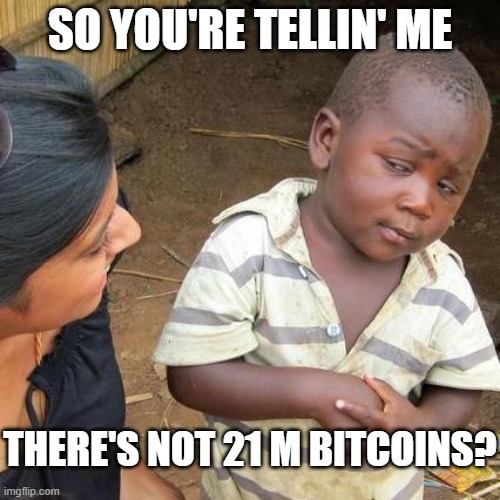
BIP-2,100,000,000,000,000,000
So, you're telling me...
- 21 million bitcoins is out, and...
- 2.1 quadrillion sats is in, except that...
- sats are out, so...
- 2.1 quadrillion bitcoins is in, except that...
- there are actually millisats, but...
- millisats are out, so...
- millibitcoins are in, so now...
- there are 2.1 quintillion millibitcoins, except that...
- millibitcoins are the basic base unit of bitcoin, so...
- millibitcoins are out, and now...
- 2.1 quintillion bitcoins are in

-
 @ 58537364:705b4b85
2025-05-28 08:25:55
@ 58537364:705b4b85
2025-05-28 08:25:55ถ้าอยากแล้วไม่หลง มันก็อยากด้วยปัญญา ความอยากอย่างนี้ท่านเรียกว่า เป็นบารมีของตน แต่ไม่ใช่ทุกคนนะที่มีปัญญา
บางคนไม่อยากจะให้มันอยาก เพราะเข้าใจว่า การมาปฏิบัติก็เพื่อระงับความอยาก ความจริงน่ะ ถ้าหากว่าไม่มีความอยาก ก็ไม่มีข้อปฏิบัติ ไม่รู้ว่าจะทำอะไร ลองพิจารณาดูก็ได้
ทุกคน แม้องค์พระพุทธเจ้าของเราก็ตาม ที่ท่านออกมาปฏิบัติ ก็เพื่อจะให้บรรเทากิเลสทั้งหลายนั้น
แต่ว่ามันต้องอยากทำ อยากปฏิบัติ อยากให้มันสงบ และก็ไม่อยากให้มันวุ่นวาย ทั้งสองอย่างนี้ มันเป็นอุปสรรคทั้งนั้น ถ้าเราไม่มีปัญญา ไม่มีความฉลาดในการกระทำอย่างนั้น เพราะว่ามันปนกันอยู่ อยากทั้งสองอย่างนี้มันมีราคาเท่า ๆ กัน
อยากจะพ้นทุกข์มันเป็นกิเลส สำหรับคนไม่มีปัญญา อยากด้วยความโง่ ไม่อยากมันก็เป็นกิเลส เพราะไม่อยากอันนั้นมันประกอบด้วยความโง่เหมือนกัน คือทั้งอยาก ไม่อยาก ปัญญาก็ไม่มี ทั้งสองอย่างนี้ มันเป็นกามสุขัลลิกานุโยโค กับอัตตกิลมถานุโยโค ซึ่งพระพุทธองค์ของเรา ขณะที่พระองค์กำลังทรงปฏิบัติอยู่นั้น ท่านก็หลงใหลในอย่างนี้ ไม่รู้ว่าจะทำอย่างไร ท่านหาอุบายหลายประการ กว่าจะพบของสองสิ่งนี้
ทุกวันนี้เราทั้งหลายก็เหมือนกัน ทุกสิ่งทั้งสองอย่างนี้มันกวนอยู่ เราจึงเข้าสู่ทางไม่ได้ก็เพราะอันนี้ ความเป็นจริงนี้ทุกคนที่มาปฏิบัติ ก็เป็นปุถุชนมาทั้งนั้น ปุถุชนก็เต็มไปด้วยความอยาก ความอยากที่ไม่มีปัญญา อยากด้วยความหลง ไม่อยากมันก็มีโทษเหมือนกัน “ไม่อยาก” มันก็เป็นตัณหา “อยาก” มันก็เป็นตัณหาอีกเหมือนกัน
ทีนี้ นักปฏิบัติยังไม่รู้เรื่องว่า จะเอายังไงกัน เดินไปข้างหน้าก็ไม่ถูก เดินกลับไปข้างหลังก็ไม่ถูก จะหยุดก็หยุดไม่ได้เพราะมันยังอยากอยู่ มันยังหลงอยู่ มีแต่ความอยาก แต่ปัญญาไม่มี มันอยากด้วยความหลง มันก็เป็นตัณหา ถึงแม้ไม่อยาก มันก็เป็นความหลง มันก็เป็นตัณหาเหมือนกันเพราะอะไร? เพราะมันขาดปัญญา
ความเป็นจริงนั้น ธรรมะมันอยู่ตรงนั้นแหละ ตรงความอยากกับความไม่อยากนั่นแหละ แต่เราไม่มีปัญญา ก็พยายามไม่ให้อยากบ้าง เดี๋ยวก็อยากบ้าง อยากให้เป็นอย่างนั้น ไม่อยากให้เป็นอย่างนี้ ความจริงทั้งสองอย่างนี้ หรือทั้งคู่นี้มันตัวเดียวกันทั้งนั้น ไม่ใช่คนละตัว แต่เราไม่รู้เรื่องของมัน
พระพุทธเจ้าของเรา และสาวกทั้งหลายของพระองค์นั้นท่านก็อยากเหมือนกัน แต่ “อยาก” ของท่านนั้น เป็นเพียงอาการของจิตเฉย ๆ หรือ “ไม่อยาก” ของท่าน ก็เป็นเพียงอาการของจิตเฉย ๆ อีกเหมือนกัน มันวูบเดียวเท่านั้น ก็หายไปแล้ว
ดังนั้น ความอยากหรือไม่อยากนี้ มันมีอยู่ตลอดเวลาแต่สำหรับผู้มีปัญญานั้น “อยาก” ก็ไม่มีอุปาทาน “ไม่อยาก” ก็ไม่มีอุปาทาน เป็น “สักแต่ว่า” อยากหรือไม่อยากเท่านั้น ถ้าพูดตามความจริงแล้ว มันก็เป็นแต่ "อาการของจิต" อาการของจิตมันเป็นของมันอย่างนั้นเอง ถ้าเรามาตะครุบมันอยู่ใกล้ ๆ นี่มันก็เห็นชัด
ดังนั้นจึงว่า การพิจารณานั้น ไม่ใช่รู้ไปที่อื่น มันรู้ตรงนี้แหละ เหมือนชาวประมงที่ออกไปทอดแหนั่นแหละ ทอดแหออกไปถูกปลาตัวใหญ่ เจ้าของผู้ทอดแหจะคิดอย่างไร? ก็กลัว กลัวปลาจะออกจากแหไปเสีย เมื่อเป็นเช่นนั้น ใจมันก็ดิ้นรนขึ้นระวังมาก บังคับมาก ตะครุบไปตะครุบมาอยู่นั่นแหละ ประเดี๋ยวปลามันก็ออกจากแหไปเสีย เพราะไปตะครุบมันแรงเกินไป
อย่างนั้นโบราณท่านพูดถึงเรื่องอันนี้ ท่านว่าค่อย ๆ ทำมัน แต่อย่าไปห่างจากมัน นี่คือปฏิปทาของเรา ค่อย ๆ คลำมันไปเรื่อย ๆ อย่างนั้นแหละ
อย่าปล่อยมัน หรือไม่อยากรู้มัน ต้องรู้ ต้องรู้เรื่องของมัน พยายามทำมันไปเรื่อย ๆ ให้เป็นปฏิปทา ขี้เกียจเราก็ทำไม่ขี้เกียจเราก็ทำ เรียกว่าการทำการปฏิบัติ ต้องทำไปเรื่อยๆอย่างนี้
ถ้าหากว่าเราขยัน ขยันเพราะความเชื่อ มันมีศรัทธาแต่ปัญญาไม่มี ถ้าเป็นอย่างนี้ ขยันไป ๆ แล้วมันก็ไม่เกิดผลอะไรขึ้นมากมาย ขยันไปนาน ๆ เข้า แต่มันไม่ถูกทาง มันก็ไม่สงบระงับ ทีนี้ก็จะเกิดความคิดว่า เรานี้บุญน้อยหรือวาสนาน้อย หรือคิดไปว่ามนุษย์ในโลกนี้คงทำไม่ได้หรอก แล้วก็เลยหยุดเลิกทำเลิกปฏิบัติ
ถ้าเกิดความคิดอย่างนี้เมื่อใด ขอให้ระวังให้มาก ให้มีขันติ ความอดทน ให้ทำไปเรื่อย ๆ เหมือนกับเราจับปลาตัวใหญ่ ก็ให้ค่อย ๆ คลำมันไปเรื่อย ๆ ปลามันก็จะไม่ดิ้นแรงค่อย ๆทำไปเรื่อย ๆ ไม่หยุด ไม่ช้าปลาก็จะหมดกำลัง มันก็จับง่าย จับให้ถนัดมือเลย ถ้าเรารีบจนเกินไป ปลามันก็จะหนีดิ้นออกจากแหเท่านั้น
ดังนั้น การปฏิบัตินี้ ถ้าเราพิจารณาตามพื้นเหตุของเรา เช่นว่า เราไม่มีความรู้ในปริยัติ ไม่มีความรู้ในอะไรอื่น ที่จะให้การปฏิบัติมันเกิดผลขึ้น ก็ดูความรู้ที่เป็นพื้นเพเดิมของเรานั่นแหละอันนั้นก็คือ “ธรรมชาติของจิต” นี่เอง มันมีของมันอยู่แล้ว เราจะไปเรียนรู้มัน มันก็มีอยู่ หรือเราจะไม่ไปเรียนรู้มัน มันก็มีอยู่
อย่างที่ท่านพูดว่า พระพุทธเจ้าจะบังเกิดขึ้นก็ตาม หรือไม่บังเกิดขึ้นก็ตาม ธรรมะก็คงมีอยู่อย่างนั้น มันเป็นของมันอยู่อย่างนั้น ไม่พลิกแพลงไปไหน มันเป็นสัจจธรรม
เราไม่เข้าใจสัจจธรรม ก็ไม่รู้ว่าสัจจธรรมเป็นอย่างไร นี้เรียกว่า การพิจารณาในความรู้ของผู้ปฏิบัติที่ไม่มีพื้นปริยัติ
ขอให้ดูจิต พยายามอ่านจิตของเจ้าของ พยายามพูดกับจิตของเจ้าของ มันจึงจะรู้เรื่องของจิต ค่อย ๆ ทำไป ถ้ายังไม่ถึงที่ของมัน มันก็ไปอยู่อย่างนั้น
ครูบาอาจารย์บางท่านบอกว่า ทำไปเรื่อย ๆ อย่าหยุด บางทีเรามาคิด “เออ ทำไปเรื่อย ๆ ถ้าไม่รู้เรื่องของมัน ถ้าทำไม่ถูกที่มัน มันจะรู้อะไร” อย่างนี้เป็นต้น ก็ต้องไปเรื่อย ๆ ก่อน แล้วมันก็จะเกิดความรู้สึกนึกคิดขึ้นในสิ่งที่เราพากเพียรทำนั้น
มันเหมือนกันกับบุรุษที่ไปสีไฟ ได้ฟังท่านบอกว่า เอาไม้ไผ่สองอันมาสีกันเข้าไปเถอะ แล้วจะมีไฟเกิดขึ้น บุรุษนั้นก็จับไม้ไผ่เข้าสองอัน สีกันเข้า แต่ใจร้อน สีไปได้หน่อย ก็อยากให้มันเป็นไฟ ใจก็เร่งอยู่เรื่อย ให้เป็นไฟเร็วๆ แต่ไฟก็ไม่เกิดสักที บุรุษนั้นก็เกิดความขี้เกียจ แล้วก็หยุดพัก แล้วจึงลองสีอีกนิด แล้วก็หยุดพัก ความร้อนที่พอมีอยู่บ้าง ก็หายไปล่ะซิ เพราะความร้อนมันไม่ติดต่อกัน
ถ้าทำไปเรื่อยๆอย่างนี้ เหนื่อยก็หยุด มีแต่เหนื่อยอย่างเดียวก็พอได้ แต่มีขี้เกียจปนเข้าด้วย เลยไปกันใหญ่ แล้วบุรุษนั้นก็หาว่าไฟไม่มี ไม่เอาไฟ ก็ทิ้ง เลิก ไม่สีอีก แล้วก็ไปเที่ยวประกาศว่า ไฟไม่มี ทำอย่างนี้ไม่ได้ ไม่มีไฟหรอก เขาได้ลองทำแล้ว
ก็จริงเหมือนกันที่ได้ทำแล้ว แต่ทำยังไม่ถึงจุดของมันคือความร้อนยังไม่สมดุลกัน ไฟมันก็เกิดขึ้นไม่ได้ ทั้งที่ความจริงไฟมันก็มีอยู่ อย่างนี้ก็เกิดความท้อแท้ขึ้นในใจของผู้ปฏิบัตินั้น ก็ละอันนี้ไปทำอันโน้นเรื่อยไป อันนี้ฉันใดก็ฉันนั้น
การปฏิบัตินั้น ปฏิบัติทางกายทางใจทั้งสองอย่าง มันต้องพร้อมกัน เพราะอะไร? เพราะพื้นเพมันเป็นคนมีกิเลสทั้งนั้น พระพุทธเจ้าก่อนที่จะเป็นพระพุทธเจ้า ท่านก็มีกิเลสแต่ท่านมีปัญญามากหลาย พระอรหันต์ก็เหมือนกัน เมื่อยังเป็นปุถุชนอยู่ ก็เหมือนกับเรา
เมื่อความอยากเกิดขึ้นมา เราก็ไม่รู้จัก เมื่อความไม่อยากเกิดขึ้นมา เราก็ไม่รู้จัก บางทีก็ร้อนใจ บางทีก็ดีใจ ถ้าใจเราไม่อยาก ก็ดีใจแบบหนึ่ง และวุ่นวายอีกแบบหนึ่ง ถ้าใจเราอยาก มันก็วุ่นวายอย่างหนึ่ง และดีใจอย่างหนึ่ง มันประสมประเสกันอยู่อย่างนี้
อันนี้คือปฏิปทาของผู้ปฏิบัติเรา
[อ่านใจธรรมชาติ] หลวงปู่ชา สุภัทโท หนังสือ หมวด: โพธิญาณ

-
 @ 21810ca8:f2e8341e
2025-05-28 08:10:53
@ 21810ca8:f2e8341e
2025-05-28 08:10:53Ich bin neu bei Nostr und versuche mich hier rein zu fuchsen. Kann das einer sehen? Und dann habe ich noch viele Fragen
Gibt es gute Marktplätze wie ebay oder ebay kleinanzeigen wo man stink normale dinge und kram von zuhause gegen sat verkaufen kann.
-
 @ 21ac2956:09d1e2df
2025-01-22 15:27:00
@ 21ac2956:09d1e2df
2025-01-22 15:27:00kakoi の仕様についてのメモ
キーボード操作
- 左手での操作に最適化
| キー | 動作 | |:-|:-| | ESC | 設定画面 | | F1 / F12 | ポストバーの表示と非表示 | | F2 | 時間の表示と非表示 | | F3 | ユーザーアイコンの表示と非表示 | | F4 | 名前の表示と非表示 | | F5 | Geminiによるタイムラインまとめ画面を表示 | | F9 / Z | コンテンツの折り返し表示の切り替え (余白ダブルクリックでも動作) | | F10 | ユーザーリストとキーワード通知の設定画面 (余白右クリックでも動作) | | F11 | メイン画面の表示と非表示 (ポストバー表示) | | Shift + W | イベント最上行へ移動 | | W / ↑| イベント選択上移動 | | S / ↓ | イベント選択下移動 | | Shift + S | イベント最下行へ移動 | | A / ← | Webビューを開く (イベントを右クリックでも動作) | | F / → | リアクションを送信 (イベントをダブルクリックでも動作) | | 1 ~ 0 | リアクションを選択 | | R | 返信 | | B | リポスト | | Q | 引用 | | C | Webビューを閉じる | | Ctrl + Shift + A | メイン画面をアクティブにする |
タイムライン
- kind:1, 6, 7, 16を取得して表示する
- フォロイーの名前の前には * が付く
フォローリスト(kind:3)
-
参照のみで更新はしない
-
F10 で開くユーザーリストでユーザーを選択し petname セルをクリックすることで未フォローユーザーにもペットネームを設定可能(ローカル保存)
プロフィール(kind:0)
- F10 で開くユーザーリストでユーザーを選択し picture セルをクリックすることでユーザーのアイコン表示を変更可能(ローカル保存)
返信(NIP-10 kind:1)
- kakoi のタイムラインに流れるすべてのイベント種に返信可能とする
- スレッドを考慮せず、単一イベントへの単発返信とする
- e タグは marker と返信先 pubkey は設定していない。 relay-url には空文字を設定
json ["e", "返信先 event-id", ""]- p タグは 返信先 pubkey ひとつだけを指定
リポスト(NIP-18 kind:6 , 16)
- kakoi のタイムラインに流れるすべてのイベント種をリポスト可能
- kind:1はkind:6。その他はkind:16でリポストする
- e タグは relay-url に空文字を設定
json ["e", "リポスト元 event-id", ""]引用(NIP-18 kind:1)
- q タグは relay-url に空文字を設定
json ["q", "引用元 event-id", ""] -
 @ aa8de34f:a6ffe696
2025-03-31 21:48:50
@ aa8de34f:a6ffe696
2025-03-31 21:48:50In seinem Beitrag vom 30. März 2025 fragt Henning Rosenbusch auf Telegram angesichts zunehmender digitaler Kontrolle und staatlicher Allmacht:
„Wie soll sich gegen eine solche Tyrannei noch ein Widerstand formieren können, selbst im Untergrund? Sehe ich nicht.“\ (Quelle: t.me/rosenbusch/25228)
Er beschreibt damit ein Gefühl der Ohnmacht, das viele teilen: Eine Welt, in der Totalitarismus nicht mehr mit Panzern, sondern mit Algorithmen kommt. Wo Zugriff auf Geld, Meinungsfreiheit und Teilhabe vom Wohlverhalten abhängt. Der Bürger als kontrollierbare Variable im Code des Staates.\ Die Frage ist berechtigt. Doch die Antwort darauf liegt nicht in alten Widerstandsbildern – sondern in einer neuen Realität.
-- Denn es braucht keinen Untergrund mehr. --
Der Widerstand der Zukunft trägt keinen Tarnanzug. Er ist nicht konspirativ, sondern transparent. Nicht bewaffnet, sondern mathematisch beweisbar. Bitcoin steht nicht am Rand dieser Entwicklung – es ist ihr Fundament. Eine Bastion aus physikalischer Realität, spieltheoretischem Schutz und ökonomischer Wahrheit. Es ist nicht unfehlbar, aber unbestechlich. Nicht perfekt, aber immun gegen zentrale Willkür.
Hier entsteht kein „digitales Gegenreich“, sondern eine dezentrale Renaissance. Keine Revolte aus Wut, sondern eine stille Abkehr: von Zwang zu Freiwilligkeit, von Abhängigkeit zu Selbstverantwortung. Diese Revolution führt keine Kriege. Sie braucht keine Führer. Sie ist ein Netzwerk. Jeder Knoten ein Individuum. Jede Entscheidung ein Akt der Selbstermächtigung.
Weltweit wachsen Freiheits-Zitadellen aus dieser Idee: wirtschaftlich autark, digital souverän, lokal verankert und global vernetzt. Sie sind keine Utopien im luftleeren Raum, sondern konkrete Realitäten – angetrieben von Energie, Code und dem menschlichen Wunsch nach Würde.
Der Globalismus alter Prägung – zentralistisch, monopolistisch, bevormundend – wird an seiner eigenen Hybris zerbrechen. Seine Werkzeuge der Kontrolle werden ihn nicht retten. Im Gegenteil: Seine Geister werden ihn verfolgen und erlegen.
Und während die alten Mächte um Erhalt kämpfen, wächst eine neue Welt – nicht im Schatten, sondern im Offenen. Nicht auf Gewalt gebaut, sondern auf Mathematik, Physik und Freiheit.
Die Tyrannei sieht keinen Widerstand.\ Weil sie nicht erkennt, dass er längst begonnen hat.\ Unwiderruflich. Leise. Überall.
-
 @ c631e267:c2b78d3e
2025-03-31 07:23:05
@ c631e267:c2b78d3e
2025-03-31 07:23:05Der Irrsinn ist bei Einzelnen etwas Seltenes – \ aber bei Gruppen, Parteien, Völkern, Zeiten die Regel. \ Friedrich Nietzsche
Erinnern Sie sich an die Horrorkomödie «Scary Movie»? Nicht, dass ich diese Art Filme besonders erinnerungswürdig fände, aber einige Szenen daraus sind doch gewissermaßen Klassiker. Dazu zählt eine, die das Verhalten vieler Protagonisten in Horrorfilmen parodiert, wenn sie in Panik flüchten. Welchen Weg nimmt wohl die Frau in der Situation auf diesem Bild?

Diese Szene kommt mir automatisch in den Sinn, wenn ich aktuelle Entwicklungen in Europa betrachte. Weitreichende Entscheidungen gehen wider jede Logik in die völlig falsche Richtung. Nur ist das hier alles andere als eine Komödie, sondern bitterernst. Dieser Horror ist leider sehr real.
Die Europäische Union hat sich selbst über Jahre konsequent in eine Sackgasse manövriert. Sie hat es versäumt, sich und ihre Politik selbstbewusst und im Einklang mit ihren Wurzeln auf dem eigenen Kontinent zu positionieren. Stattdessen ist sie in blinder Treue den vermeintlichen «transatlantischen Freunden» auf ihrem Konfrontationskurs gen Osten gefolgt.
In den USA haben sich die Vorzeichen allerdings mittlerweile geändert, und die einst hoch gelobten «Freunde und Partner» erscheinen den europäischen «Führern» nicht mehr vertrauenswürdig. Das ist spätestens seit der Münchner Sicherheitskonferenz, der Rede von Vizepräsident J. D. Vance und den empörten Reaktionen offensichtlich. Große Teile Europas wirken seitdem wie ein aufgescheuchter Haufen kopfloser Hühner. Orientierung und Kontrolle sind völlig abhanden gekommen.
Statt jedoch umzukehren oder wenigstens zu bremsen und vielleicht einen Abzweig zu suchen, geben die Crash-Piloten jetzt auf dem Weg durch die Sackgasse erst richtig Gas. Ja sie lösen sogar noch die Sicherheitsgurte und deaktivieren die Airbags. Den vor Angst dauergelähmten Passagieren fällt auch nichts Besseres ein und so schließen sie einfach die Augen. Derweil übertrumpfen sich die Kommentatoren des Events gegenseitig in sensationslüsterner «Berichterstattung».
Wie schon die deutsche Außenministerin mit höchsten UN-Ambitionen, Annalena Baerbock, proklamiert auch die Europäische Kommission einen «Frieden durch Stärke». Zu dem jetzt vorgelegten, selbstzerstörerischen Fahrplan zur Ankurbelung der Rüstungsindustrie, genannt «Weißbuch zur europäischen Verteidigung – Bereitschaft 2030», erklärte die Kommissionspräsidentin, die «Ära der Friedensdividende» sei längst vorbei. Soll das heißen, Frieden bringt nichts ein? Eine umfassende Zusammenarbeit an dauerhaften europäischen Friedenslösungen steht demnach jedenfalls nicht zur Debatte.
Zusätzlich brisant ist, dass aktuell «die ganze EU von Deutschen regiert wird», wie der EU-Parlamentarier und ehemalige UN-Diplomat Michael von der Schulenburg beobachtet hat. Tatsächlich sitzen neben von der Leyen und Strack-Zimmermann noch einige weitere Deutsche in – vor allem auch in Krisenzeiten – wichtigen Spitzenposten der Union. Vor dem Hintergrund der Kriegstreiberei in Deutschland muss eine solche Dominanz mindestens nachdenklich stimmen.
Ihre ursprünglichen Grundwerte wie Demokratie, Freiheit, Frieden und Völkerverständigung hat die EU kontinuierlich in leere Worthülsen verwandelt. Diese werden dafür immer lächerlicher hochgehalten und beschworen.
Es wird dringend Zeit, dass wir, der Souverän, diesem erbärmlichen und gefährlichen Trauerspiel ein Ende setzen und die Fäden selbst in die Hand nehmen. In diesem Sinne fordert uns auch das «European Peace Project» auf, am 9. Mai im Rahmen eines Kunstprojekts den Frieden auszurufen. Seien wir dabei!
[Titelbild: Pixabay]
Dieser Beitrag wurde mit dem Pareto-Client geschrieben und ist zuerst auf Transition News erschienen.
-
 @ 101b30ee:18a46a45
2025-01-02 17:28:15
@ 101b30ee:18a46a45
2025-01-02 17:28:15
ハンドシェイク
- HTTPリクエスト解析
- [ ] HTTPリクエストラインのパーサー関数作成
- [x] HTTPヘッダーのパーサー関数作成
- [ ] HTTPリクエストボディのパーサー関数作成
- [ ] WebSocket関連ヘッダーの検証
- [ ]
Upgrade: websocket - [ ]
Connection: Upgrade - [ ]
Sec-WebSocket-Keyの取得と検証 - [ ]
Sec-WebSocket-Version: 13の検証
- [ ]
- HTTPレスポンス作成
- [ ]
Sec-WebSocket-Acceptの生成- [x]
Sec-WebSocket-KeyにSHA-1適用(外部依存) - [ ]
Sec-WebSocket-KeyにSHA-1適用(非依存) - [x]
Sec-WebSocket-KeyにBase64エンコードを適用
- [x]
- [x] HTTP 101 Switching Protocolsレスポンスの構築と送信
データ転送
WebSocketフレームの処理
- フレーム解析
- [x]
finビットの取り出しと解釈 - [x]
rsv1,rsv2,rsv3の取り出しと検証 - [ ]
opcodeの取り出しと処理- [ ] 0x0: 継続フレーム
- [ ] 0x1: テキストフレーム
- [ ] 0x2: バイナリフレーム
- [ ] 0x8: 接続終了
- [ ] 0x9: Ping
- [ ] 0xA: Pong
- [x]
maskフラグの取得と検証 - [x]
payload_lenの取り出しと解析 - [x] 拡張されたペイロード長(
extended payload len)の取り出し - [x]
masking keyの取得とデコード - [x]
payloadデータの取り出し - [ ]
finに基づく分割パケット対応 - デコード
- [x]
masking keyを使用したペイロードデコード - opcode別処理
- [ ] テキストフレーム(0x1)のUTF-8デコードと処理
- [ ] バイナリフレーム(0x2)のデータ処理
- [ ] Ping(0x9)フレームへのPong応答
- [ ] 接続終了(0x8)の処理
- [ ] 不正なopcodeに対するエラー応答
フレーム生成
- フレーム構築
- [ ]
finフラグ設定 - [ ]
opcodeの設定 - [ ] ペイロードのマスキング処理(クライアント向けのみ)
- [ ] ペイロード長の設定(拡張ペイロード長を含む)
- [ ] フレーム全体のバイトストリーム化
接続管理
- [x] クライアント接続の確立
- [x] 2クライアント以上の接続の確立
- [ ] 接続中のクライアントのリスト管理
- [ ] 接続のタイムアウト処理
- [ ] 不正なクライアントからの接続拒否
- [ ] 接続終了時のクリーンアップ処理
- [ ] ハートビート機能(Ping/Pong)による接続維持
セキュリティ
- [ ] WebSocket Originヘッダーの検証(許可されたオリジンのみ受け入れる)
- [ ] メッセージサイズの上限設定(大規模メッセージ攻撃の防御)
- [ ] 不正なフレーム/データに対するエラーハンドリング
- [ ] SSL/TLSサポート(wssプロトコル用)
拡張機能とプロトコルアップグレード
- [ ] サブプロトコル(Sec-WebSocket-Protocol)の処理
- [ ] 拡張(Sec-WebSocket-Extensions)のサポート
- 圧縮データのデコード (例: permessage-deflate)
テストとデバッグ
- [ ] 単体テスト
- [ ] ハンドシェイクのテスト
- [ ] フレーム解析と生成のテスト
- [ ] 各opcode処理のテスト
- [ ] 負荷テスト(高負荷時の動作確認)
- [ ] プロトコルコンフォーマンステスト
- [ ] RFC 6455に準拠しているかの確認
- [ ] ロギングとデバッグツールの実装
ドキュメント
- [ ] コードベースのコメントとドキュメント化
- [ ] WebSocketサーバーの設定と使用法についてのユーザーガイド作成
タグ
RFC6455
-
 @ 59cb0748:9602464b
2025-01-01 06:15:09
@ 59cb0748:9602464b
2025-01-01 06:15:09Nostrでお世話になっている方も、お世話になってない方も、こんにちは!
タコ頭大吉です!
NIP-23を使った初めての投稿です。
今回は、私がここ数ヶ月中にデザインをした三種類のビタキセケースの紹介記事になります!!
ビタキセを買ったもののあまり自分の好みに合う外観や仕様のケースがなく、いくつかプロトタイプを作りそれなりに時間をかけて考えたケース達です。
これら3シリーズに関しては、FDMタイプの3Dプリンタの精度、耐久性、出力後の作業性を考慮して一つのパーツで完結することに拘って設計をしました。
一定以上の充填率でプリントをすればそれなりに丈夫なはずです。
また、基本的に放熱性と保護性を両立できるように設計をしたつもります。
それぞれのモデルについて簡単に紹介をさせていただきますので、よろしければ各リポジトリに付属のREADMEを読んでいただいて自作、フィードバックをいただけましたら幸いです。
それでは、簡単に各モデルの紹介をさせていたきます。
AirLiftFrame
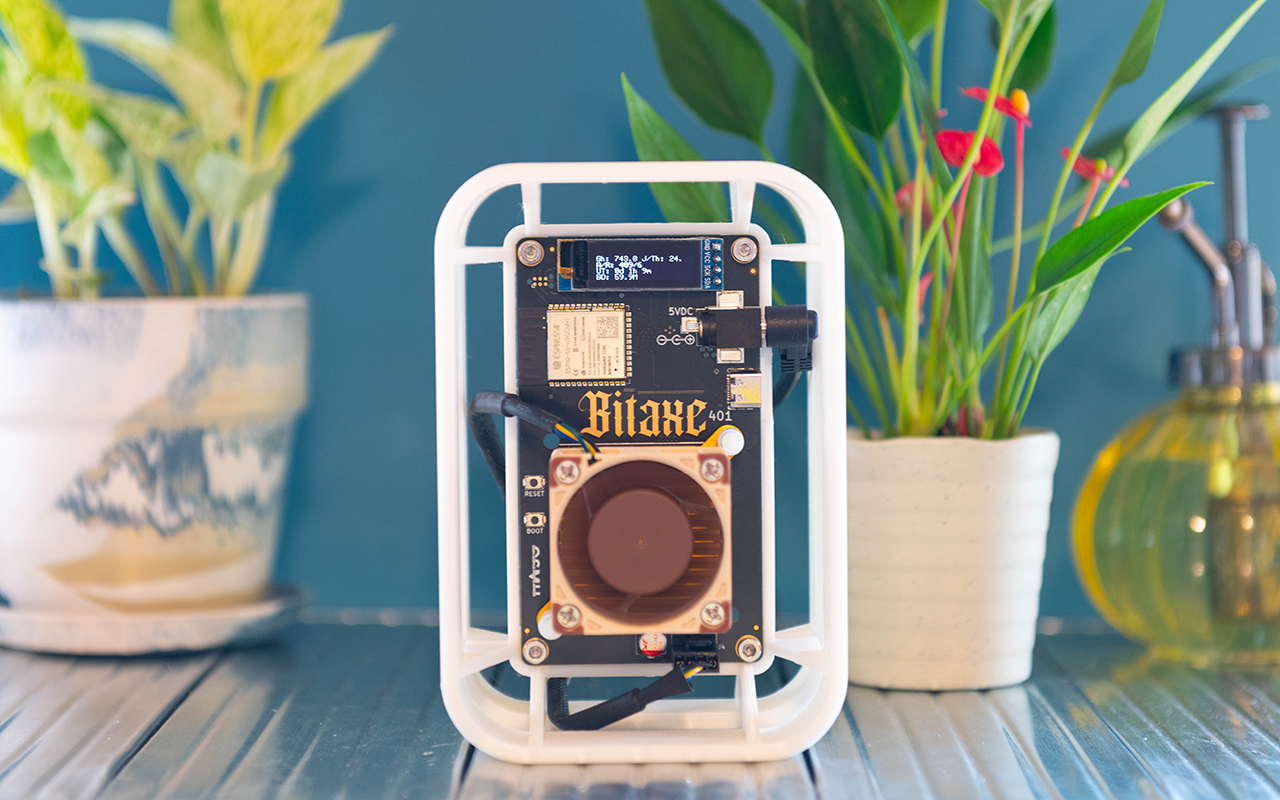 最初に作ったモデルです!
少し大きいのが難点ですが、分厚めのフレームをベースとし基盤周辺をあえて囲わない設計により、保護性と放熱を阻害しない事の両立を狙っています。
最初に作ったモデルです!
少し大きいのが難点ですが、分厚めのフレームをベースとし基盤周辺をあえて囲わない設計により、保護性と放熱を阻害しない事の両立を狙っています。
TwinAirLiftFrame
 ビタキセを買い増ししたことにより、複数台をカッコよく運用したいという需要が自分の中に出てきたので、AirLiftFrameを2つくっつけたら良いのではと言うごくごく単純な発想でつくり始めたケースです。
しかし、ただ横並びにしただけでは廃熱が干渉するだけではなく、DCジャックやUSBポートへのアクセスが阻害されるという問題にすぐに気がつきました。
そこで、WebUI上でディスプレイの表示を上下反転出来ることに注目し、2台を上下逆向きに取り付ける事でそれらの問題を解決しました!
ビタキセを買い増ししたことにより、複数台をカッコよく運用したいという需要が自分の中に出てきたので、AirLiftFrameを2つくっつけたら良いのではと言うごくごく単純な発想でつくり始めたケースです。
しかし、ただ横並びにしただけでは廃熱が干渉するだけではなく、DCジャックやUSBポートへのアクセスが阻害されるという問題にすぐに気がつきました。
そこで、WebUI上でディスプレイの表示を上下反転出来ることに注目し、2台を上下逆向きに取り付ける事でそれらの問題を解決しました!
VoronoiShell
 AirLiftFrameシリーズのサイズを小型化する事から始めたプロジョクトです。
縦横の寸法の削減だけではなく、厚みを薄くつくリたいという希望がありました。
所が単純に薄くすると、持った時に発熱する背面パーツに手が触れてしまったり、落下などでぶつかった際に背面パーツが破損する懸念がありました。
そこで、(当初は付けたくはなかった)背面保護用のグリルをデザインする必要が出てきました。
初めは多角形でしたがあまりにもダサく、調べている内にVoronoi柄という有機的なパターンに行き付き即採用しました。
結果、ビタキセを取り付けると柄が見えなくなるのが勿体無いぐらい個性的でスタイリッシュなデザインに仕上がりました。
AirLiftFrameシリーズのサイズを小型化する事から始めたプロジョクトです。
縦横の寸法の削減だけではなく、厚みを薄くつくリたいという希望がありました。
所が単純に薄くすると、持った時に発熱する背面パーツに手が触れてしまったり、落下などでぶつかった際に背面パーツが破損する懸念がありました。
そこで、(当初は付けたくはなかった)背面保護用のグリルをデザインする必要が出てきました。
初めは多角形でしたがあまりにもダサく、調べている内にVoronoi柄という有機的なパターンに行き付き即採用しました。
結果、ビタキセを取り付けると柄が見えなくなるのが勿体無いぐらい個性的でスタイリッシュなデザインに仕上がりました。
いずれカスタム方法やインサートナットや増設ファンの選定方法等を紹介したいのですが、今回はNIP-23になれるという意図もあるので紹介に留めます! また、他の関連OSハードウェアプロジェクトのケースもデザインできたらと思っております!
今後ともタコ頭をよろしくお願いいたします。
-
 @ c631e267:c2b78d3e
2025-03-21 19:41:50
@ c631e267:c2b78d3e
2025-03-21 19:41:50Wir werden nicht zulassen, dass technisch manches möglich ist, \ aber der Staat es nicht nutzt. \ Angela Merkel
Die Modalverben zu erklären, ist im Deutschunterricht manchmal nicht ganz einfach. Nicht alle Fremdsprachen unterscheiden zum Beispiel bei der Frage nach einer Möglichkeit gleichermaßen zwischen «können» im Sinne von «die Gelegenheit, Kenntnis oder Fähigkeit haben» und «dürfen» als «die Erlaubnis oder Berechtigung haben». Das spanische Wort «poder» etwa steht für beides.
Ebenso ist vielen Schülern auf den ersten Blick nicht recht klar, dass das logische Gegenteil von «müssen» nicht unbedingt «nicht müssen» ist, sondern vielmehr «nicht dürfen». An den Verkehrsschildern lässt sich so etwas meistens recht gut erklären: Manchmal muss man abbiegen, aber manchmal darf man eben nicht.

Dieses Beispiel soll ein wenig die Verwirrungstaktik veranschaulichen, die in der Politik gerne verwendet wird, um unpopuläre oder restriktive Maßnahmen Stück für Stück einzuführen. Zuerst ist etwas einfach innovativ und bringt viele Vorteile. Vor allem ist es freiwillig, jeder kann selber entscheiden, niemand muss mitmachen. Später kann man zunehmend weniger Alternativen wählen, weil sie verschwinden, und irgendwann verwandelt sich alles andere in «nicht dürfen» – die Maßnahme ist obligatorisch.
Um die Durchsetzung derartiger Initiativen strategisch zu unterstützen und nett zu verpacken, gibt es Lobbyisten, gerne auch NGOs genannt. Dass das «NG» am Anfang dieser Abkürzung übersetzt «Nicht-Regierungs-» bedeutet, ist ein Anachronismus. Das war vielleicht früher einmal so, heute ist eher das Gegenteil gemeint.
In unserer modernen Zeit wird enorm viel Lobbyarbeit für die Digitalisierung praktisch sämtlicher Lebensbereiche aufgewendet. Was das auf dem Sektor der Mobilität bedeuten kann, haben wir diese Woche anhand aktueller Entwicklungen in Spanien beleuchtet. Begründet teilweise mit Vorgaben der Europäischen Union arbeitet man dort fleißig an einer «neuen Mobilität», basierend auf «intelligenter» technologischer Infrastruktur. Derartige Anwandlungen wurden auch schon als «Technofeudalismus» angeprangert.
Nationale Zugangspunkte für Mobilitätsdaten im Sinne der EU gibt es nicht nur in allen Mitgliedsländern, sondern auch in der Schweiz und in Großbritannien. Das Vereinigte Königreich beteiligt sich darüber hinaus an anderen EU-Projekten für digitale Überwachungs- und Kontrollmaßnahmen, wie dem biometrischen Identifizierungssystem für «nachhaltigen Verkehr und Tourismus».
Natürlich marschiert auch Deutschland stracks und euphorisch in Richtung digitaler Zukunft. Ohne vernetzte Mobilität und einen «verlässlichen Zugang zu Daten, einschließlich Echtzeitdaten» komme man in der Verkehrsplanung und -steuerung nicht aus, erklärt die Regierung. Der Interessenverband der IT-Dienstleister Bitkom will «die digitale Transformation der deutschen Wirtschaft und Verwaltung vorantreiben». Dazu bewirbt er unter anderem die Konzepte Smart City, Smart Region und Smart Country und behauptet, deutsche Großstädte «setzen bei Mobilität voll auf Digitalisierung».
Es steht zu befürchten, dass das umfassende Sammeln, Verarbeiten und Vernetzen von Daten, das angeblich die Menschen unterstützen soll (und theoretisch ja auch könnte), eher dazu benutzt wird, sie zu kontrollieren und zu manipulieren. Je elektrischer und digitaler unsere Umgebung wird, desto größer sind diese Möglichkeiten. Im Ergebnis könnten solche Prozesse den Bürger nicht nur einschränken oder überflüssig machen, sondern in mancherlei Hinsicht regelrecht abschalten. Eine gesunde Skepsis ist also geboten.
[Titelbild: Pixabay]
Dieser Beitrag wurde mit dem Pareto-Client geschrieben. Er ist zuerst auf Transition News erschienen.
-
 @ 3770c235:16042bcc
2025-05-28 05:54:01
@ 3770c235:16042bcc
2025-05-28 05:54:01** Introduction: The Neon Pulse of Las Vegas
**It’s 2:30 AM on a Tuesday. The Strip hums with laughter, clinking glasses, and the occasional Elvis impersonator. A group of friends stumbles out of a nightclub, squinting under the glow of a Las Vegas billboard that screams, “Hungry? $5 Pancakes → 1 Block Right!” Ten minutes later, they’re drowning their late-night cravings in syrup.This isn’t luck—it’s Las Vegas billboards doing what they do best: working while the rest of the world sleeps. In a city where the party never stops, these glowing giants are the ultimate salespeople. Let’s dive into why Las Vegas billboards outshine traditional ads and how your business can ride their 24/7 energy wave.
** Why Las Vegas Billboards Never Take a Coffee Break
** 1. Tourists Don’t Have Bedtimes (and Neither Do Billboards)
- 42 million visitors flock to Vegas yearly. They’re sipping margaritas at noon, gambling at midnight, and shopping at 3 AM.
- Las Vegas billboards near hotspots like the Bellagio Fountains or Fremont Street catch eyes round the clock.Real Story:
A donut shop owner named Luis rented a billboard near the “Welcome to Vegas” sign. His message? “Jet Lagged? Sugar Fix Open 24/7!” Sales tripled—especially between 1 AM and 4 AM.** 2. You Can’t “Skip” a Billboard
** - Imagine this: You’re stuck in traffic on the Strip. Your phone’s dead. That Las Vegas billboard for air-conditioned massages? It’s your lifeline.
- Compare that to online ads: 47% of people skip them, and TikTok ads vanish in a scroll.- Vegas Thrives on Impulse
- Billboards tap into spontaneous decisions:
- “Let’s try that rooftop bar!”
- “Wait, free slot play? Let’s U-turn!”
- Traditional ads (like radio spots) fade fast. Billboards linger, nudging tourists to act now.
** 5 Reasons Your Business Needs a Vegas Billboard
** 1. Size Matters (And So Does Flash)
- Strip billboards can be taller than a 5-story building.
- Digital screens use LEDs so bright, they’re visible from space.Pro Tip:
A casino added fake “smoke” effects to their billboard for a Halloween promo. Traffic backed up for selfies—and bookings spiked.- No Language Barrier
- Vegas draws visitors from Tokyo, Berlin, São Paulo...
- A Las Vegas billboard with a giant cocktail emoji? Universal for “Drinks here!”
Case Study:
A Korean BBQ spot used a billboard of sizzling meat. No words. Just smoke visuals. Tourists followed the “aroma” straight to their door.- They’re Always in the Right Place, Right Time
- 6 AM: Joggers see smoothie ads.
- 3 PM: Pool partiers spot “Free Margarita” promos.
-
Midnight: Hangover clinics whisper, “We’ve got IVs.”
-
Instant Trust Boost
- A tiny online ad says “startup.” A glowing billboard says, “We’re Vegas royalty.”
Jake’s Win:
Jake’s tiny magic shop rented a billboard reading, “Real Tricks—Cheaper Than the Casino!” Tourists treated him like David Blaine.- QR Codes = Instant Customers
- “Scan for free parking!” → 1,000 scans in a weekend.
- “Tap to call a limo” → Rides booked before the light turns green.
** How to Make Your Vegas Billboard Irresistible
** Step 1: Claim Your Territory
- The Strip: Pricey but prime ($15k–$60k/month).
- Fremont Street: Quirky, cheaper ($5k–$20k), packed with partiers.
- Highway 15: Target road-trippers with “Almost There! Cold Beer Ahead!”Step 2: Keep It Stupid Simple
- Bad: “Experience Culinary Excellence at Our Artisanal Bistro!”
- Good: “24/7 Bacon Pancakes → Exit Here.”Maria’s Hack:
Maria’s tattoo parlor used a billboard with a flaming skull and three words: “Walk-Ins Welcome.” No phone number. “People just… show up,” she laughs.Step 3: Track Your Wins (Like a Vegas High Roller)
- QR Codes: “Scan for Free Slot Play!” → Track scans.
- Unique URLs: “Visit VegasPizza24.com” → Monitor traffic.
- Old-School: Count foot traffic. (“Did that bachelor party just roll in from our billboard? Yes.”)**FAQs ** 1. “How do I even measure if my billboard’s working? It’s not like online ads!”
Answer:
You’re right—it’s not just clicks and likes. But here’s how real businesses track success:
- QR Codes: Add a unique code like “Scan for Free Appetizer!” Track scans.
- Promo Codes: “Mention this billboard for 20% off!” (Works great for Uber drivers: “My passengers blurt it out mid-ride,” says driver Luis M.)
- Foot Traffic Spikes: Note sales surges after your ad goes live. A dispensary saw a 60% bump in visits after their “We’re Closer Than the Casino!” billboard.
- Social Media Tags: Encourage selfies with your billboard. A retro motel offered a free pool pass for tagged photos. Their Instagram exploded.- “Aren’t billboards old-school? My Gen Z customers live on TikTok!”
Answer:
Billboards in Vegas are anything but old-school. Here’s why: - Hybrid Campaigns: Pair billboards with geofenced mobile ads. Example: A billboard for a pool party says, “Scan to Pre-Order Drinks.” Users nearby get a TikTok-style ad on their phone.
- Instagrammable Designs: Quirky billboards go viral. The “Welcome to Vegas” sign is the most Instagrammed spot in the city. Mimic that vibe!
- Influencer Collabs: Pay a Vegas influencer to pose with your billboard. Their followers will hunt it down like a scavenger hunt.
Real Story:
A vintage clothing store’s billboard (“Find Your Retro Vibe → 2 Blocks East”) became a TikTok trend after a local influencer did a “thrift haul” video there.** 3. “What’s the biggest mistake businesses make with Vegas billboards?”
** Answer:
Trying to cram in too much info! Drivers have 5–7 seconds to read your ad. Avoid:
- Text Overload: “Grand Opening! 50% Off! Open 24/7! Call Now!” → Too much!
- Bland Designs: Gray text on a gray background? Yawn.
- Ignoring Locals: Tourists are 70% of viewers, but locals matter too. A gym’s billboard said, “Tired of Tourists? Work Out in Peace.” Memberships spiked.Fix It:
- Use 7 words max.
- Bold colors (red, yellow, neon pink).
- Add a clear call to action: “Turn Right Now!” or “Scan for Free Parking.”- “Do I need a permit? What if my ad gets rejected?”
Answer:
Yep, permits are a thing. The city bans: - Flashing Lights Near Residences: No strobes in suburban areas.
- Certain Content: No swear words, adult themes, or political fights.
How to Avoid Rejection:
- Work with local Outdoor Advertising companies—they know the rules.
- Submit designs early. One pizza joint’s ad was flagged for a pepperoni slice deemed “too suggestive.” They swapped it to a cheese pull… and it got approved.Conclusion: Let Your Business Shine All Night Long
At 5 AM, as the sun peeks over the desert, the Las Vegas billboards keep glowing. They’ve sold midnight pancakes, inspired shotgun weddings, and even talked someone out of a questionable tattoo (“Wait! Our Parlor’s Better → Next Exit”).These aren’t just ads—they’re part of Vegas’ heartbeat. So whether you’re slinging sushi, massages, or monster truck rides, remember: In a city that never sleeps, your billboard shouldn’t either.
Ready to Light Up the Night?
Find Las Vegas billboards near you today. And if you spot one that says, “Free High-Fives for Readers of This Article,” honk twice. It’s probably yours. -
 @ 21ac2956:09d1e2df
2024-12-24 23:24:04
@ 21ac2956:09d1e2df
2024-12-24 23:24:04スペース2つ+改行→
改行2つ→ハードブレイク→
いかがでしたか? -
 @ 6e0ea5d6:0327f353
2025-05-28 04:34:08
@ 6e0ea5d6:0327f353
2025-05-28 04:34:08Ascolta bene! It is more dignified to thirst alone in the desert than to share wine with someone who has no thirst for conquest.
On the silent path to success, it’s not the declared enemies who slow the march, but rather the friends. Not the noble or loyal ones, but the failures—those who carry a dull glint in their eyes, chronic laziness in their spirit, and the eternal excuse of bad luck in their pockets. Friendship, when poorly chosen, becomes a polished anchor, tied to your ankle with ropes named camaraderie.
Nothing weighs heavier on the journey than having to endure the failed and envious around you. It is a kind of emotional parasitism that begins with empathy and ends in stagnation. Those who live among the weak will crawl. Those who keep company with miserable friends, instead of striving to prosper, learn to curse wealth—not out of ethics, but out of envy. Mediocrity, my friend, is contagious. And it does not take root suddenly, but like a silent epidemic.
Ambition—that fire that burns in the bones of great men—will always seem like arrogance to the ears of the failed. Those who have never built anything, except arguments to justify their paralysis, will never understand the fury of someone born to conquer. And so, with smiles, they spit venom: “Calm down,” they say, “be content,” they advise. Hypocrites. What they call humility is nothing more than resignation to their own defeat.
To walk alone, with hunger and honor, is worth more than feasting at lavish tables at the cost of your own sweat, surrounded by parasites who toast your downfall with glasses full of praise. No one prospers where the conversation is filled with complaints, criticism, and envy. What does not build up, corrodes.
The rust of the weak is invisible at first—a bitter joke here, a veiled critique there. And before you know it, the structure is already rotten. Of the friendship, only the weight remains. Of the relationship, only exhaustion. The true enemy of success is the company of those who have failed and wish for you the same fate. These tragic figures—always tired, always victims—are masters of collective self-sabotage.
Feel no remorse in abandoning those who build nothing and consume everything. And in that abandonment, you become freer, stronger, and unbreakable.
Thank you for reading, my friend!
If this message resonated with you, consider leaving your "🥃" as a token of appreciation.
A toast to our family!
-
 @ aa8de34f:a6ffe696
2025-03-21 12:08:31
@ aa8de34f:a6ffe696
2025-03-21 12:08:3119. März 2025
🔐 1. SHA-256 is Quantum-Resistant
Bitcoin’s proof-of-work mechanism relies on SHA-256, a hashing algorithm. Even with a powerful quantum computer, SHA-256 remains secure because:
- Quantum computers excel at factoring large numbers (Shor’s Algorithm).
- However, SHA-256 is a one-way function, meaning there's no known quantum algorithm that can efficiently reverse it.
- Grover’s Algorithm (which theoretically speeds up brute force attacks) would still require 2¹²⁸ operations to break SHA-256 – far beyond practical reach.
++++++++++++++++++++++++++++++++++++++++++++++++++
🔑 2. Public Key Vulnerability – But Only If You Reuse Addresses
Bitcoin uses Elliptic Curve Digital Signature Algorithm (ECDSA) to generate keys.
- A quantum computer could use Shor’s Algorithm to break SECP256K1, the curve Bitcoin uses.
- If you never reuse addresses, it is an additional security element
- 🔑 1. Bitcoin Addresses Are NOT Public Keys
Many people assume a Bitcoin address is the public key—this is wrong.
- When you receive Bitcoin, it is sent to a hashed public key (the Bitcoin address).
- The actual public key is never exposed because it is the Bitcoin Adress who addresses the Public Key which never reveals the creation of a public key by a spend
- Bitcoin uses Pay-to-Public-Key-Hash (P2PKH) or newer methods like Pay-to-Witness-Public-Key-Hash (P2WPKH), which add extra layers of security.
🕵️♂️ 2.1 The Public Key Never Appears
- When you send Bitcoin, your wallet creates a digital signature.
- This signature uses the private key to prove ownership.
- The Bitcoin address is revealed and creates the Public Key
- The public key remains hidden inside the Bitcoin script and Merkle tree.
This means: ✔ The public key is never exposed. ✔ Quantum attackers have nothing to target, attacking a Bitcoin Address is a zero value game.
+++++++++++++++++++++++++++++++++++++++++++++++++
🔄 3. Bitcoin Can Upgrade
Even if quantum computers eventually become a real threat:
- Bitcoin developers can upgrade to quantum-safe cryptography (e.g., lattice-based cryptography or post-quantum signatures like Dilithium).
- Bitcoin’s decentralized nature ensures a network-wide soft fork or hard fork could transition to quantum-resistant keys.
++++++++++++++++++++++++++++++++++++++++++++++++++
⏳ 4. The 10-Minute Block Rule as a Security Feature
- Bitcoin’s network operates on a 10-minute block interval, meaning:Even if an attacker had immense computational power (like a quantum computer), they could only attempt an attack every 10 minutes.Unlike traditional encryption, where a hacker could continuously brute-force keys, Bitcoin’s system resets the challenge with every new block.This limits the window of opportunity for quantum attacks.
🎯 5. Quantum Attack Needs to Solve a Block in Real-Time
- A quantum attacker must solve the cryptographic puzzle (Proof of Work) in under 10 minutes.
- The problem? Any slight error changes the hash completely, meaning:If the quantum computer makes a mistake (even 0.0001% probability), the entire attack fails.Quantum decoherence (loss of qubit stability) makes error correction a massive challenge.The computational cost of recovering from an incorrect hash is still incredibly high.
⚡ 6. Network Resilience – Even if a Block Is Hacked
- Even if a quantum computer somehow solved a block instantly:The network would quickly recognize and reject invalid transactions.Other miners would continue mining under normal cryptographic rules.51% Attack? The attacker would need to consistently beat the entire Bitcoin network, which is not sustainable.
🔄 7. The Logarithmic Difficulty Adjustment Neutralizes Threats
- Bitcoin adjusts mining difficulty every 2016 blocks (\~2 weeks).
- If quantum miners appeared and suddenly started solving blocks too quickly, the difficulty would adjust upward, making attacks significantly harder.
- This self-correcting mechanism ensures that even quantum computers wouldn't easily overpower the network.
🔥 Final Verdict: Quantum Computers Are Too Slow for Bitcoin
✔ The 10-minute rule limits attack frequency – quantum computers can’t keep up.
✔ Any slight miscalculation ruins the attack, resetting all progress.
✔ Bitcoin’s difficulty adjustment would react, neutralizing quantum advantages.
Even if quantum computers reach their theoretical potential, Bitcoin’s game theory and design make it incredibly resistant. 🚀
-
 @ 32310997:0c1e64cc
2024-12-24 23:10:03
@ 32310997:0c1e64cc
2024-12-24 23:10:03※このポエムはNostr Advent Calendar 2024の25日目の記事です。24日目はtansaibowさんのご担当です。
この鍵ひとつあれば
僕はどこにだってゆける
なんだってできる
さぁ進もう
この曠野を (※画像はイメージです。本文とはたいして関係がありません)
(※画像はイメージです。本文とはたいして関係がありません) -
 @ 1d7ff02a:d042b5be
2025-05-28 04:02:47
@ 1d7ff02a:d042b5be
2025-05-28 04:02:47For those who still don't truly understand Bitcoin, it means you still don't understand what money is, who creates it, and why humans need money.
It's a scam that the education system doesn't teach this important subject, while we spend almost our entire lives trying to earn money. Therefore, I recommend following the money and studying Bitcoin seriously.
Why Bitcoin Matters
Saving is the greatest discovery in human history
Before humans learned to save, we were just animals living day to day. Saving is what makes humans different from other animals — the ability to think about the future and store for later.
Saving created civilization itself
Without saving, there would be no cities, no science, no art. Everything we call "progress" comes from the ability to save.
Money is the greatest creation in human history
It is the tool that has allowed human civilization to advance to this day. Money is the best tool humans use for saving.
Bitcoin is the best money ever created
It is the most perfect money humans have ever created. No one can control, manipulate, destroy it, and it is truly limited like time in life.
Bitcoin is like a black hole
That will absorb all value from the damaged financial system. It will draw stability and value to itself. Everything of value will flow into Bitcoin eventually.
Bitcoin is like Buddhism discovering truth
It helps understand the root problems of the current financial system and the emergence of many problems in society, just like Buddha who understood all suffering and the causes of suffering.
Bitcoin is freedom
Money is power, money controls human behavior. When we have money that preserves value and cannot be controlled, we will have intellectual freedom, freedom of expression, and the power to choose.
The debt that humanity has created today would take another thousand years to pay off completely
There is no way out and it's heading toward serious collapse. Bitcoin is the light that will help prevent humanity from entering another dark age.
Bitcoin cannot steal your time
It cannot be created from nothing. Every Bitcoin requires real energy and time to create.
Bitcoin is insurance that protects against mismanagement
It helps protect against currency debasement, economic depression, and failed policies. Bitcoin will protect your value.
Bitcoin is going to absorb the world's value
Eventually, Bitcoin will become the store of value for the entire world. It will absorb wealth from all assets, all prices, and all investments.
Exit The Matrix
We live in a financial Matrix. Every day we wake up and go to work, thinking we're building a future for ourselves. But in reality, we're just giving energy to a system that extracts value from us every second. Bitcoin is the red pill — it will open your eyes to see the truth of the financial world. Central banks are the architects of this Matrix — they create money from nothing, and we have to work hard to get it.
The education system has deceived us greatly. They teach us to work for money, but never teach us what money is. We spend 12-16 years in school, then spend our entire lives earning money, but never know what it is, who creates it, and why it has value. This is the biggest scam in human history.
We are taught to be slaves of the system, but not taught to understand the system.
The Bitcoin standard will end war
When you can't print money for war anymore, war becomes too expensive.
We are entering the Bitcoin Renaissance era
An era of financial and intellectual revival. Bitcoin is creating a new class of humans. People who understand and hold Bitcoin will become a new class with true freedom.
The Path to Financial Truth
Follow the money trail and you will see the truth: - Who controls money printing? - Why do prices keep getting higher? - Why are the poor getting poorer and the rich getting richer?
All the answers lie in understanding money and Bitcoin.
Studying Bitcoin is not just about investment — it's about understanding the future of currency and human society.
Don't just work for money. Understand money. Study Bitcoin.
If you don't understand money, you will be a slave to the system forever. If you understand Bitcoin, you will gain freedom.
-
 @ ec42c765:328c0600
2024-12-22 19:16:31
@ ec42c765:328c0600
2024-12-22 19:16:31この記事は前回の内容を把握している人向けに書いています(特にNostrエクステンション(NIP-07)導入)
手順
- 登録する画像を用意する
- 画像をweb上にアップロードする
- 絵文字セットに登録する
1. 登録する画像を用意する
以下のような方法で用意してください。
- 画像編集ソフト等を使って自分で作成する
- 絵文字作成サイトを使う(絵文字ジェネレーター、MEGAMOJI など)
- フリー画像を使う(いらすとや など)
データ量削減
Nostrでは画像をそのまま表示するクライアントが多いので、データ量が大きな画像をそのまま使うとモバイル通信時などに負担がかかります。
データ量を増やさないためにサイズやファイル形式を変更することをおすすめします。
以下は私のおすすめです。 * サイズ:正方形 128×128 ピクセル、長方形 任意の横幅×128 ピクセル * ファイル形式:webp形式(webp変換おすすめサイト toimg) * 単色、単純な画像の場合:png形式(webpにするとむしろサイズが大きくなる)
その他
- 背景透過画像
- ダークモード、ライトモード両方で見やすい色
がおすすめです。
2. 画像をweb上にアップロードする
よく分からなければ emojito からのアップロードで問題ないです。
普段使っている画像アップロード先があるならそれでも構いません。
気になる方はアップロード先を適宜選んでください。既に投稿されたカスタム絵文字の画像に対して
- 削除も差し替えもできない → emojito など
- 削除できるが差し替えはできない → Gyazo、nostrcheck.meなど
- 削除も差し替えもできる → GitHub 、セルフホスティングなど
これらは既にNostr上に投稿されたカスタム絵文字の画像を後から変更できるかどうかを指します。
どの方法でも新しく使われるカスタム絵文字を変更することは可能です。
同一のカスタム絵文字セットに同一のショートコードで別の画像を登録する形で対応できます。3. 絵文字セットに登録する
emojito から登録します。
右上のアイコン → + New emoji set から新規の絵文字セットを作成できます。


① 絵文字セット名を入力
基本的にカスタム絵文字はカスタム絵文字セットを作り、ひとまとまりにして登録します。
一度作った絵文字セットに後から絵文字を追加することもできます。
② 画像をアップロードまたは画像URLを入力
emojitoから画像をアップロードする場合、ファイル名に日本語などの2バイト文字が含まれているとアップロードがエラーになるようです。
その場合はファイル名を適当な英数字などに変更してください。
③ 絵文字のショートコードを入力
ショートコードは絵文字を呼び出す時に使用する場合があります。
他のカスタム絵文字と被っても問題ありませんが選択時に複数表示されて支障が出る可能性があります。
他と被りにくく長くなりすぎないショートコードが良いかもしれません。
ショートコードに使えるのは半角の英数字とアンダーバーのみです。
④ 追加
Add を押してもまだ作成完了にはなりません。

一度に絵文字を複数登録できます。
最後に右上の Save を押すと作成完了です。

画面が切り替わるので、右側の Options から Bookmark を選択するとそのカスタム絵文字セットを自分で使えるようになります。
既存の絵文字セットを編集するには Options から Edit を選択します。
以上です。
仕様
-
 @ 2cb8ae56:84d30cba
2024-12-21 11:27:14
@ 2cb8ae56:84d30cba
2024-12-21 11:27:14ども、薄味のキャルピスでございます。
当記事は、「Nostr Advent Calendar 2024」7日目の記事です。
この記事を読んでいる人でいないとは思いますが、Nostrとはなんぞやとお思いの方は以下をご覧ください。https://hello.nostrapp.me/
僕は「Nostrで過ごした2024年」というタイトルの通り、一年間を振り返ってみようと思います。
自己紹介
まず知らん人のために軽く自己紹介をします
「薄味のキャルピス」という名前で、色んな所にいるどこかの高校生です。 左利き、箸とベースとお盆は右手。
普段は学業の傍ら、画像を弄ったり作ったりしている上に、イヤホンを集めたりラジオにメッセージを送っています。
コーディングは出来ないテクノロジーまみれのガラクタ人間(→テックジャンカー)です
参加経緯とスタンス
なぜ参加したのかを思い出しながら書いていきます まず、どんな媒体でNostr(ノスター・ノストラ)の存在を知ったのかと言うと、ネットニュースです。
https://gigazine.net/news/20230425-nostr-intro/
こちらの記事で「そんなのあるんだ」と知り、4月1日ついにjoin!!!!
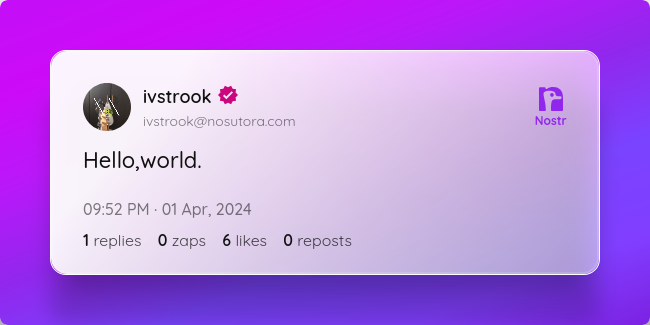
現時点での参加スタンスは「気楽に、素直に」という感じで参加しています
やりたいときにやりたいことをやるって言うリアルでは到底難しいことを、Nostrのなかでやっている気もします。
後述するNostrasia 2024の開催日「9月23日」を持って、Mastodon(マストドン)から乗り換え、上記のスタンスのもと、メインで精力的に活動しています。
Nostr活動年表
2024/04/01 Nostr Join!!!
2024/06/08 人生初オフ会「たくろうさんオフ」参加、LNアドレス追加。
2024/09/23 人生初小規模イベント「Nostrasia 2024」運営メンバーとして参加
2024/10/12 2度目のオフ会「デザイン談義」主催・参加
簡易的に各種紹介!
人生初オフ会「たくろうさんオフ」 渋三魚金でご飯→猿田彦珈琲でリラックス、Linux使ってると話を切り出す(唐突)→スクランブル交差点で解散。 ウォークマンの再生画面を送付した投稿を行う
人生初イベント「Nostrasia 2024」
あ、記事出したので見てください。初版
第二版
2度目のオフ会「デザイン談義」
秋葉原の「創作空間caféアトリエ あきば店」で行われたオフ会。 ちょくちょく内容を上げているので、見ていってください。 https://nostter.app/npub19ju2u4sduewta4hxl22kke7se8yxm2puytzw47lr6y999pxnpjaqtjjfxj/2024/10/12 終了後、e☆イヤホン 秋葉原店にて、BTR13の在庫状況を確認し、在庫がないため予約しました。 (10月24日到着) 雑多すぎますが、一応こんな感じで大丈夫かな?まとめ
僕がNostrに出会い、Nostrにのめり込むまでの話はいかがだったでしょうか。 Nostrに入る前、オフ会に参加するまでは「ネットにロクな人なんていない!」と思っていましたが、Nostrは違いましたね。 いい意味で期待はずれ、本当にいい人たちばかりで、とにかく自然体で接することができるSNSであると感じました。 そんな世界にぜひとも一回足を踏み入れてみてはいかがでしょうか? それではまた、来年のアドベントカレンダー、及び開催されましたら「Nostrasia 2025」でお会いしましょう。 -
 @ 502ab02a:a2860397
2025-05-28 02:03:01
@ 502ab02a:a2860397
2025-05-28 02:03:01ยังมีอีกสิ่งหนึ่งที่มักซ่อนอยู่ในเมล็ดธัญพืช ถั่วเปลือกแข็ง และพืชตระกูลถั่วทั้งหลาย เป็นเหมือน “กล่องเก็บขุมทรัพย์” สำหรับชีวิตน้อยๆ ของพืชในวันที่จะเติบโต แต่พอสิ่งนี้หลุดเข้ามาในร่างกายมนุษย์ มันกลับถูกมองว่าเป็น “ขโมย” ขโมยแร่ธาตุไปจากร่างกายเรา เจ้าสิ่งนั้นคือ “กรดไฟติก” หรือ phytic acid นั่นเองครับ
กรดไฟติกเป็นสารอินทรีย์ที่พืชสร้างขึ้นเพื่อเก็บสะสมฟอสฟอรัสไว้ใช้ตอนงอกงามในอนาคต มันเปรียบเหมือนกระปุกออมสินของเมล็ดพืช พวกเมล็ดถั่วดำ ข้าวโพด ข้าวกล้อง ข้าวโอ๊ต เมล็ดทานตะวัน อัลมอนด์ ไปจนถึงเต้าหู้ ถั่วเหลือง และธัญพืชต่างๆ ล้วนมีกรดไฟติกอยู่ไม่น้อย โดยเฉพาะถ้าเป็น “ธัญพืชเต็มเมล็ด” ที่ไม่ผ่านการขัดสีแบบที่หลายๆคนชอบ นั่นเพราะเยื่อหุ้มเมล็ดคือที่เก็บเจ้าตัวนี้ไว้
หลายคนคงคิดว่า อ้าวแล้วเจ้ากรดไฟติกทำไมถึงมีชื่อเสียงไม่ค่อยดีนัก? คำตอบอยู่ที่ “ความสามารถในการจับแร่ธาตุ” ของมันนี่แหละครับ
กรดไฟติกเป็นเหมือนแม่เหล็กเล็กๆ ที่สามารถจับตัวกับแร่ธาตุต่างๆ ได้ดี โดยเฉพาะ “แร่ธาตุบวกสอง” ทั้งหลาย แร่ธาตุบวกสอง คือ แร่ธาตุที่เวลาอยู่ในร่างกายจะอยู่ในรูปของไอออนที่มีประจุไฟฟ้า บวก 2 (เขียนว่า ²⁺) หรือพูดอีกแบบคือ มันเสียอิเล็กตรอนออกไป 2 ตัว เลยกลายเป็นไอออนที่มีพลังบวก 2 หน่วย กรดไฟติก หรือ แทนนิน จะทำตัวเป็น "แม่เหล็ก" ดูดแร่ธาตุออกไป มันมักจะจับกับแร่ธาตุที่มีประจุบวก โดยเฉพาะพวกที่ประจุบวกแรงๆ แบบ บวกสอง (²⁺) นี่แหละ เพราะจับแน่น จับเหนียว ยิ่งบวกเยอะยิ่งจับดี เหมือนแช่แม่เหล็กลงไปในกล่องโลหะ เช่น ธาตุเหล็ก สังกะสี แมกนีเซียม แคลเซียม และทองแดง พอมันจับเสร็จแล้ว ร่างกายเราก็ไม่สามารถดูดซึมแร่ธาตุพวกนี้เข้าไปได้ เพราะมันเปลี่ยนสภาพกลายเป็นของจับคู่ที่ลำไส้ไม่รู้จัก ไม่รู้จะพาเข้าร่างกายยังไง สุดท้ายก็ต้องโบกมือลาไปพร้อมของเสีย
พวกที่เป็น บวกสาม (³⁺) อย่างเช่น อลูมิเนียม (Al³⁺) หรือ เหล็กเฟอริก (Fe³⁺) จะจับแน่นมาก ถึงขั้นอาจเกิด “ตกตะกอน” แบบไม่ละลายน้ำเลยทีเดียว พวกนี้ลำไส้ไม่สามารถดูดซึมได้เลย ในขณะที่แร่ธาตุบวกหนึ่ง โซเดียม (Na⁺) โพแทสเซียม (K⁺) ประจุบวกแค่ +1 จับกับกรดไฟติกได้น้อยกว่า
ในแง่นี้กรดไฟติกเลยถูกเรียกว่า “สารต้านสารอาหาร” หรือ anti-nutrient เพราะมันต้านไม่ให้ร่างกายได้แร่ธาตุที่ควรจะได้ แต่อย่าเพิ่งตัดสินมันเหมือนผู้ร้าย เพราะในขณะที่กรดไฟติกอาจขโมยแร่ธาตุบางตัวจากร่างกาย มันก็มีคุณสมบัติน่าสนใจที่ดูจะเป็นคุณงามความดีของมันเหมือนกัน เช่น มันสามารถจับกับโลหะหนักบางชนิด เช่น ตะกั่ว หรือแคดเมียม ที่อาจปนเปื้อนในอาหาร แล้วพาออกไปจากร่างกายก่อนที่สิ่งเหล่านั้นจะทำร้ายเรา
และอีกด้านหนึ่งที่กำลังเป็นที่สนใจคือ ฤทธิ์ต้านอนุมูลอิสระของกรดไฟติก มันอาจช่วยลดการอักเสบ หรือยับยั้งการเติบโตของเซลล์มะเร็งบางชนิดในระดับเซลล์ได้ มีงานวิจัยที่พบว่ามันอาจไปจับกับธาตุเหล็กส่วนเกินที่ว่ายอยู่ในเลือด ซึ่งเป็นตัวเร่งปฏิกิริยาอนุมูลอิสระ คล้ายช่วย “เก็บเศษเหล็กที่ลอยไปมาบนทางด่วนหลอดเลือด” ให้ปลอดภัยขึ้นอีกนิด
แต่ทั้งนี้ทั้งนั้น อยากให้คิดแบบนี้ครับว่า กรดไฟติกคือคนแปลกหน้าที่ “บางมื้อก็มีประโยชน์ บางมื้อก็ทำให้เราขาดของดี” สิ่งสำคัญอยู่ที่ “สภาวะแวดล้อมของมื้ออาหาร” ถ้าอาหารในมื้อมีแร่ธาตุไม่มากนัก แล้วกรดไฟติกเข้ามาเยอะ มันก็ยิ่งลดโอกาสดูดซึมแร่ธาตุเหล่านั้น แต่ถ้ามื้ออาหารมีความหลากหลาย โปรตีนเพียงพอ วิตามิน C อยู่ครบ ก็ช่วยเพิ่มการดูดซึมธาตุเหล็กได้ดีขึ้น เพราะมันเปลี่ยนเหล็กให้อยู่ในรูปแบบที่ร่างกายดูดซึมง่ายขึ้น
แล้วเราจะจัดการยังไงกับกรดไฟติกในครัวแบบบ้านเรา?
วิธีพื้นบ้านมีมาแต่โบราณแล้วนั่นคือ -แช่น้ำ ก่อนหุงข้าวกล้อง หรือแช่ถั่วก่อนนำไปต้ม จะช่วยลดกรดไฟติกได้ระดับหนึ่ง เพราะมีเอนไซม์ที่ชื่อว่า phytase ซึ่งจะเริ่มทำงานเมื่อพืชได้รับน้ำและอุณหภูมิพอเหมาะ -การหมัก เช่น หมักแป้งข้าวเปลือกทำขนม หรือการหมักเต้าหู้ ก็เป็นวิธีดั้งเดิมที่ช่วยลดกรดไฟติกลงได้มาก เพราะเอนไซม์ของจุลินทรีย์ในกระบวนการหมักจะช่วยย่อยกรดไฟติกให้ลดลง -การงอก หรือ sprouting คือการทำให้เมล็ดพืชเริ่มต้นชีวิตใหม่ เช่น ถั่วงอก ข้าวกล้องงอก วิธีนี้ลดกรดไฟติกได้ดีมาก เพราะ phytase ที่อยู่ในพืชจะถูกกระตุ้นให้ทำงานสูงสุดตอนพืชเริ่มงอก
ข้อมูลคร่าวๆ บอกว่า วิธีเหล่านี้อาจลดกรดไฟติกลงได้ 30-90% ขึ้นกับชนิดของพืช และระยะเวลาที่ใช้
แต่ต้องรู้ไว้ด้วยว่า… การลดกรดไฟติกก็อาจทำให้พลังงานสำรองหรือสารอาหารบางตัวในพืชหายไปด้วยเช่นกัน เช่น วิตามิน B และสารต้านอนุมูลอิสระบางชนิด จึงควรใช้วิธีที่พอเหมาะ ไม่ถึงกับฆ่าความดีของพืชหมด
ดังนั้นเช่นกันครับว่า กรดไฟติกไม่ใช่ศัตรู ไม่ใช่เทพเจ้า แต่คือ “สมการ” ที่ต้องรู้จักแก้ไขให้เหมาะกับมื้ออาหารของเรา ถ้าเฮียเลือกกินแบบ animal-based อยู่แล้ว แร่ธาตุสำคัญส่วนใหญ่ก็ได้จากเนื้อสัตว์แบบที่ดูดซึมได้ดีอยู่แล้ว กรดไฟติกจากพืชที่กินพอประมาณก็อาจไม่ได้ร้ายแรงอะไรนัก เพียงแต่ต้องรู้ทันและจัดการให้พอดี ไม่ให้มันกลายเป็นตัวฉุดไม่ให้ร่างกายดูดซึมของดี
สุดท้าย เหมือนชีวิตเรานี่แหละ… “ทุกอย่างมีมุมมืดและมุมสว่าง อยู่ที่ว่าเราจัดแสงยังไงให้แม้แต่เงาก็กลายเป็นพลังของชีวิตเรา” #โรงบ่มสุขภาพ #HealthyHut #pirateketo #ตำรับเอ๋ #siripun #siamstr
/เฮียเอง
-
 @ ec42c765:328c0600
2024-12-15 11:13:44
@ ec42c765:328c0600
2024-12-15 11:13:44てすと
nostr:nevent1qqst3uqlls4yr9vys4dza2sgjle3ly37trck7jgdmtr23uuz52usjrqqqnjgr
nostr:nevent1qqsdvchy5d27zt3z05rr3q6vvmzgslslxwu0p4dfkvxwhmvxldn9djguvagp2
-
 @ 502ab02a:a2860397
2025-05-28 01:57:42
@ 502ab02a:a2860397
2025-05-28 01:57:42ในปี 2013 ณ กรุงลอนดอน แฮมเบอร์เกอร์หน้าตาดูธรรมดาแต่ไม่ธรรมดาชิ้นหนึ่งได้ถูกจัดวางอย่างสง่างามบนจานสีขาวในงานแถลงข่าวระดับโลก ไม่ใช่เพราะมันแพงเกินเหตุที่ตั้งราคาที่ 330,000 ดอลลาร์ต่อชิ้น แต่เพราะมันไม่เคยเกิดขึ้นมาก่อนในประวัติศาสตร์นี่คือ “เนื้อเพาะเลี้ยง” (cultured meat) ชิ้นแรกของโลกที่เติบโตมาจากเซลล์ ไม่ใช่จากสัตว์ทั้งตัว
เบื้องหลังอาหารชิ้นนี้คือชายชาวดัตช์คนหนึ่ง ชื่อว่า มาร์ค โพสต์ (Mark Post) นักวิทยาศาสตร์ด้านสรีรวิทยาหลอดเลือด ซึ่งไม่ได้มีดีกรีจากแค่มหาวิทยาลัย แต่มีความฝันที่อยากจะสร้างอาหารจากเทคโนโลยีเพื่ออนาคต เขาเริ่มต้นจากห้องทดลองเล็กๆ ที่มหาวิทยาลัย Maastricht ในประเทศเนเธอร์แลนด์ โดยเชื่อว่าการเพาะเลี้ยงเนื้อจากเซลล์ต้นกำเนิดของวัวจะสามารถลดผลกระทบด้านสิ่งแวดล้อมจากอุตสาหกรรมเนื้อสัตว์ได้
แต่กว่าจะมีแฮมเบอร์เกอร์เพาะเลี้ยงได้หนึ่งชิ้น เขาต้องเพาะเลี้ยงเส้นใยกล้ามเนื้อเล็กๆ มากกว่า 20,000 เส้น นำมารวมกัน ประกอบโครง สร้างรูปร่าง คล้ายกับงานศิลปะทางวิทยาศาสตร์ ใช้เวลาเป็นเดือน แถมกระบวนการทั้งหมดต้องอยู่ในสภาพปลอดเชื้อราวกับโรงพยาบาลของนาโนเทคโนโลยี ส่วนต้นทุนมหาศาลที่ใช้ในวันนั้น มาจากมหาเศรษฐีผู้ร่วมก่อตั้ง Google อย่าง Sergey Brin ที่เห็นว่ามันอาจเป็นคำตอบของปัญหาอาหารโลกในอนาคต
แต่เรื่องนี้มีอะไรมากกว่าที่สื่อกระแสหลักอยากให้คุณรู้
หลังจากเปิดตัวเนื้อในห้องแล็บ โลกก็เหมือนถูกปลุกให้ตื่นขึ้นในอีกมิติหนึ่ง บริษัทสตาร์ทอัพที่เคยเน้นเขียนโค้ด เริ่มหันมาเขียนสูตรเนื้อ บริษัทรายใหญ่อย่าง Cargill, Tyson Foods และแม้แต่ Richard Branson ก็เทเงินสนับสนุนบริษัทรุ่นใหม่อย่าง Mosa Meat ซึ่งก่อตั้งโดย Dr. Post เองในปี 2016 พร้อมแผนทะเยอทะยานที่จะส่ง “เนื้อจากแล็บ” เข้าซูเปอร์มาร์เก็ตภายในทศวรรษเดียว
Mosa Meat พยายามลดต้นทุนจากหลักแสน ให้เหลือหลักร้อย และวันนี้บริษัทเหล่านี้กำลังสร้างโรงงานที่ผลิตเนื้อในถังหมักขนาดยักษ์ ไม่ต่างจากโรงเบียร์ พวกเขาเลี้ยงเซลล์วัวในน้ำเลี้ยงที่เดิมทีเคยใช้เซรุ่มจากลูกวัว (Fetal Bovine Serum) ซึ่งเป็นสิ่งที่ย้อนแย้ง ที่สวนทางกับภาพ “ปลอดภัยไร้เลือด” มาก เพราะในขณะที่โฆษณาว่า “ปลอดการฆ่า” แต่กลับใช้ส่วนผสมที่ได้มาจากเลือดลูกวัวที่ยังไม่เกิด จนต้องหาทางเปลี่ยนสูตรเป็น “น้ำเลี้ยงเทียม” ที่มาจากสารเคมีและอาหารสังเคราะห์แทน
ด้วยโครงสร้าง scaffold ที่ช่วยให้เซลล์ก่อตัวเป็นเนื้อเยื่อ และ กระบวนการเพาะเลี้ยงใน bioreactor ขนาดยักษ์ ที่เปลี่ยนเซลล์เล็ก ๆ ให้เป็นเนื้อก้อนใหญ่ในเวลาไม่กี่สัปดาห์
แต่ขณะที่ภาพความล้ำซึ่งดูจะเติบโตอย่างสดใส กลับมีเงามืดที่เติบโตพร้อมกันไปเงียบๆไม่ต่างกับอนาคินและดาร์ธเวเดอร์
แม้จะเป็นนวัตกรรมล้ำหน้า แต่ทุกขั้นตอนถูกห่อหุ้มไว้ด้วย “สิทธิบัตร” สิ่งที่ทำให้เนื้อชนิดนี้ไม่ได้เป็นของทุกคน แต่เป็นสมบัติทางปัญญาของบริษัทเท่านั้น เนื้อจากเซลล์เหล่านี้ ไม่เหมือนเนื้อจากฟาร์มที่ใครก็เลี้ยงเองได้ ไม่สามารถเก็บเมล็ดพันธุ์ไว้เพาะรุ่นหน้าแบบชาวนาในอดีต ทุกอย่างต้องเริ่มต้นในห้องแล็บ ต้องใช้เทคโนโลยีเฉพาะ ต้องมีสูตรลับเฉพาะ ต้องพึ่งบริษัทที่มีสิทธิบัตรครอบครองชีวิตเซลล์เพียงไม่กี่เจ้า
Mosa Meat ไม่ได้หยุดแค่การผลิต พวกเขายื่นจด สิทธิบัตรกว่า 10 กลุ่ม ครอบคลุมตั้งแต่สูตรน้ำเลี้ยง วิธีเพาะเลี้ยงเซลล์ ไปจนถึงวิธีห่อบรรจุสินค้าขั้นสุดท้าย กล่าวอีกอย่างคือ ถ้าใครอยากทำเนื้อเพาะเลี้ยงแบบนี้บ้าง ก็ต้อง “จ่ายค่าลิขสิทธิ์” ให้เขาเสียก่อน เรากำลังก้าวสู่ยุคที่ อาหารไม่ใช่ผลผลิตจากดินและแรงคน แต่เป็นผลผลิตของทรัพย์สินทางปัญญา และเมื่อใดที่ “เนื้อ” กลายเป็นสิ่งที่คนผลิตเองไม่ได้ ต้องซื้อจากห้างเท่านั้น เกษตรกรกลายเป็นผู้บริโภค ผู้บริโภคกลายเป็นผู้ขึ้นอยู่กับระบบ ห่วงโซ่อาหารที่เคยเป็นของชุมชนถูกตัดขาดด้วยท่อส่งจากห้องทดลองสู่จานอาหาร เราไม่ได้ซื้อเนื้อ แต่ “เช่าเทคโนโลยี” ที่ผลิตเนื้อมาให้เรากิน
และที่น่าสนใจคือ รัฐบาลในหลายประเทศกลับเป็นผู้ให้ทุนสนับสนุน เช่น โครงการของสหภาพยุโรปที่มอบเงินกว่า 2 ล้านยูโรให้ Dr. Post และ Mosa Meat รวมถึงโครงการของสิงคโปร์ที่ให้ใบอนุญาตจำหน่ายเนื้อเพาะเลี้ยงรายแรกของโลกในปี 2020 ราวกับว่า “เนื้อจากแล็บ” กำลังจะกลายเป็นนโยบายด้านความมั่นคงอาหารแห่งอนาคต
มันไม่ใช่เรื่องของการวิจัยอีกต่อไป แต่มันคือการปูทางอำนาจใหม่ ที่เปลี่ยน “อาหาร” ให้กลายเป็น “ซอฟต์แวร์ชีวภาพ” ที่จดทะเบียนครอบครองสิทธิ์แบบเดียวกับแอปในมือถือ
แล้วการใช้สื่อก็จะมาในรุปแบบที่ประชาชนโห่ร้องดีใจ เฉลิมฉลองการเกิดขึ้นของมันโดยไม่รู้สึกว่า เสรีภาพในการจัดการด้านอาหารสิ้นสุดลงแล้ว ในทางหนึ่ง มันอาจดูสวยงามไร้ที่ติ ช่วยลดการฆ่าสัตว์ ลดการปล่อยก๊าซเรือนกระจก และให้โปรตีนสะอาดแก่คนจำนวนมาก
แต่อีกทางหนึ่ง มันคือการรวมศูนย์อำนาจด้านอาหารไว้ในมือบริษัทยักษ์ใหญ่ ที่สามารถตั้งราคาตามใจ และควบคุมทุกขั้นตอนตั้งแต่ฟาร์ม (ในหลอดทดลอง) ถึงโต๊ะอาหารของเรา
เกษตรกรจะหมดบทบาท เพราะไม่มีใครต้องเลี้ยงสัตว์อีก ผู้บริโภคจะหมดทางเลือก เพราะสูตรทุกอย่างถูกจดสิทธิบัตร สุดท้าย คนธรรมดาอย่างเราอาจ “มีเงินก็ยังไม่มีสิทธิ์ทำอาหารกินเอง”
ไม่มีใครในหมู่บ้านจะต้มแกงจากวัตถุดิบแล็บเหล่านี้ได้โดยไม่จ่ายค่าลิขสิทธิ์ ไม่มีใครปลูกหรือเพาะเนื้อได้เอง เพราะเขาถือสิทธิบัตร ไม่มีใครรู้ส่วนผสมที่แท้จริง เพราะมันคือ “ความลับทางการค้า”
หลายๆคนเริ่มคิดในใจว่า…นี่ไม่ใช่เรื่องเล็กอีกต่อไป เพราะนี่อาจไม่ใช่แค่เนื้อจากห้องแล็บ แต่ มันคือจุดเริ่มต้นของอนาคตของอาหารที่ไม่เป็นของประชาชนอีกต่อไป มันคือการเริ่มต้นของยุคที่มนุษย์จะไม่สามารถ “เข้าครัวของตัวเอง” ได้อีกต่อไป
ไหนๆเราตามมาถึงตอนนี้แล้ว เข้าหมวดที่ 2 ของอาหารอนาคตแล้ว เฮียไม่ได้บอกว่าเทคโนโลยีไม่ดีนะครับ เราตัดสินเดี๋ยวนี้ไม่ได้ แต่เรารู้เรื่องของมันได้
แต่โลกนี้เต็มไปด้วยคำว่า “ดีต่อโลก” ที่ซ่อนคำว่า “ดีต่อผู้ถือหุ้น” อยู่ข้างใน เราอาจจะกำลังก้าวสู่ยุคที่ “เนื้อไม่ได้ปลอดภัยขึ้น แต่ถูกควบคุมง่ายขึ้น” และประชาชนก็อาจกลายเป็นเพียง “ผู้ใช้บริการเนื้อ” ที่ไม่มีสิทธิ์แม้แต่จะรู้ว่าเนื้อในจานคืออะไรบ้างแน่
โลกอาหารในอนาคตไม่ได้ขึ้นกับว่าเราปลูกอะไร แต่ขึ้นกับว่า “ใครจดสิทธิบัตรก่อน” และเมื่อถึงวันนั้น เฮียแอบคิดว่า เราอาจไม่ได้เสียแค่ฟาร์มและครัว แต่เรากำลังเสีย “เสรีภาพในการกิน” ไปอย่างช้า ๆ ด้วยรอยยิ้มของนักลงทุนและเสียบปรบมือจาก "ใครบางคน"
ทุกวันนี้ใครนิยมไดเอทอะไร ภูมิใจในการดูแลสุขภาพยังไง ก็ทำไปเหอะครับ ขอเพียงว่า เส้นทางที่เดินอยู่นั้น สนับสนุนเกษตกร สนับสนุน local ให้แข็งแรง ทุกสังคมมีทั้งคนดีและคนไม่ดี เราค่อยๆ verify สนับสนุนคนดีๆ แต่ไม่ใช่ไปเดียจฉันท์ลงโทษคนไม่ดี เราเสริมความรู้ให้เขา พยายามโอบอุ้มพวกเขา ถ้าชีวิตดีขึ้น การออมเห็นผลขึ้น อาจทำให้ชีวิตทุกคนดีขึ้น
#pirateketo #กูต้องรู้มั๊ย #ม้วนหางสิลูก #siamstr
-
 @ c631e267:c2b78d3e
2025-02-07 19:42:11
@ c631e267:c2b78d3e
2025-02-07 19:42:11Nur wenn wir aufeinander zugehen, haben wir die Chance \ auf Überwindung der gegenseitigen Ressentiments! \ Dr. med. dent. Jens Knipphals
In Wolfsburg sollte es kürzlich eine Gesprächsrunde von Kritikern der Corona-Politik mit Oberbürgermeister Dennis Weilmann und Vertretern der Stadtverwaltung geben. Der Zahnarzt und langjährige Maßnahmenkritiker Jens Knipphals hatte diese Einladung ins Rathaus erwirkt und publiziert. Seine Motivation:
«Ich möchte die Spaltung der Gesellschaft überwinden. Dazu ist eine umfassende Aufarbeitung der Corona-Krise in der Öffentlichkeit notwendig.»
Schon früher hatte Knipphals Antworten von den Kommunalpolitikern verlangt, zum Beispiel bei öffentlichen Bürgerfragestunden. Für das erwartete Treffen im Rathaus formulierte er Fragen wie: Warum wurden fachliche Argumente der Kritiker ignoriert? Weshalb wurde deren Ausgrenzung, Diskreditierung und Entmenschlichung nicht entgegengetreten? In welcher Form übernehmen Rat und Verwaltung in Wolfsburg persönlich Verantwortung für die erheblichen Folgen der politischen Corona-Krise?
Der Termin fand allerdings nicht statt – der Bürgermeister sagte ihn kurz vorher wieder ab. Knipphals bezeichnete Weilmann anschließend als Wiederholungstäter, da das Stadtoberhaupt bereits 2022 zu einem Runden Tisch in der Sache eingeladen hatte, den es dann nie gab. Gegenüber Multipolar erklärte der Arzt, Weilmann wolle scheinbar eine öffentliche Aufarbeitung mit allen Mitteln verhindern. Er selbst sei «inzwischen absolut desillusioniert» und die einzige Lösung sei, dass die Verantwortlichen gingen.
Die Aufarbeitung der Plandemie beginne bei jedem von uns selbst, sei aber letztlich eine gesamtgesellschaftliche Aufgabe, schreibt Peter Frey, der den «Fall Wolfsburg» auch in seinem Blog behandelt. Diese Aufgabe sei indes deutlich größer, als viele glaubten. Erfreulicherweise sei der öffentliche Informationsraum inzwischen größer, trotz der weiterhin unverfrorenen Desinformations-Kampagnen der etablierten Massenmedien.
Frey erinnert daran, dass Dennis Weilmann mitverantwortlich für gravierende Grundrechtseinschränkungen wie die 2021 eingeführten 2G-Regeln in der Wolfsburger Innenstadt zeichnet. Es sei naiv anzunehmen, dass ein Funktionär einzig im Interesse der Bürger handeln würde. Als früherer Dezernent des Amtes für Wirtschaft, Digitalisierung und Kultur der Autostadt kenne Weilmann zum Beispiel die Verknüpfung von Fördergeldern mit politischen Zielsetzungen gut.
Wolfsburg wurde damals zu einem Modellprojekt des Bundesministeriums des Innern (BMI) und war Finalist im Bitkom-Wettbewerb «Digitale Stadt». So habe rechtzeitig vor der Plandemie das Projekt «Smart City Wolfsburg» anlaufen können, das der Stadt «eine Vorreiterrolle für umfassende Vernetzung und Datenerfassung» aufgetragen habe, sagt Frey. Die Vereinten Nationen verkauften dann derartige «intelligente» Überwachungs- und Kontrollmaßnahmen ebenso als Rettung in der Not wie das Magazin Forbes im April 2020:
«Intelligente Städte können uns helfen, die Coronavirus-Pandemie zu bekämpfen. In einer wachsenden Zahl von Ländern tun die intelligenten Städte genau das. Regierungen und lokale Behörden nutzen Smart-City-Technologien, Sensoren und Daten, um die Kontakte von Menschen aufzuspüren, die mit dem Coronavirus infiziert sind. Gleichzeitig helfen die Smart Cities auch dabei, festzustellen, ob die Regeln der sozialen Distanzierung eingehalten werden.»
Offensichtlich gibt es viele Aspekte zu bedenken und zu durchleuten, wenn es um die Aufklärung und Aufarbeitung der sogenannten «Corona-Pandemie» und der verordneten Maßnahmen geht. Frustration und Desillusion sind angesichts der Realitäten absolut verständlich. Gerade deswegen sind Initiativen wie die von Jens Knipphals so bewundernswert und so wichtig – ebenso wie eine seiner Kernthesen: «Wir müssen aufeinander zugehen, da hilft alles nichts».
Dieser Beitrag ist zuerst auf Transition News erschienen.
-
 @ ec42c765:328c0600
2024-12-13 08:16:32
@ ec42c765:328c0600
2024-12-13 08:16:32Nostr Advent Calendar 2024 の 12日目の記事です。
昨日の 12/11 は きりの さんの 2024年のNostrリレー運営を振り返る でした。
nostr-zap-view 作った
リポジトリ: https://github.com/Lokuyow/nostr-zap-view/
動作確認ページ: https://lokuyow.github.io/nostr-zap-view/それ何?
特定の誰かや何かに宛てたZap(投げ銭)を一覧できるやつ
を
自分のWebサイトに設置できるやつ
自分のサイトに設置した例 * SNSリンク集ページ(最下部): https://lokuyow.github.io/
おいくらサッツ(Zap一覧ボタン): https://osats.money/
今日からビットコ(最下部): https://lokuyow.github.io/btc-dca-simulator/なんで作ったの?
私の去年のアドベントカレンダー
【Nostr】Webサイトにビットコインの投げ銭ボタンを設置しよう【Zap】
https://spotlight.soy/detail?article_id=ucd7cbrql/
が前提になってるけど長いので要約すると * ZapするやつはあるけどZap見るやつがないので欲しい * ZapをNostr(の典型的なkind:1クライアント)内だけに留めるのはもったいない * Webサイトの広告うざいからZap(的な何か)で置き換わって欲しいお前だれ?
非エンジニア、非プログラマー
AIにコード出させてるだけ人作った感想
できた
作った感想2
完成してから気付いた本当に作りたかったもの
こういうところにそのままZapを表示できる感じにしたい
 (ここまでちゃんとした商業ブログでなく)個人のブログやHPの端っこに「Sponsored by」欄があって名前が表示される感じ
(ここまでちゃんとした商業ブログでなく)個人のブログやHPの端っこに「Sponsored by」欄があって名前が表示される感じ
もうZapっていう文字もビットコインっていう文字もNostrも出さなくていいし説明もしなくていいのでは感がある
イメージはWebサイトを対象にしたニコニ広告 + スーパーチャット + 祭りとか神社の奉納者一覧
で思ったのは
個人からの投げ銭なら推し活的なものにしかならないけど
企業がNostrにアカウントを作ってサイトに投げ銭をしたら企業の広告になるんでは!?
~~企業がNostrにアカウントを!?デリヘルしか見たことない!~~今後
思いつき、予定は未定
* ボタン→ダイアログ形式でなくバナー、Embed形式にしてページアクセスですぐ見れるようにする * 多分リレーに負荷がかかるのでなんかする * Zapの文字は出さず「Sponsored by」等にする * 単純な最新順でなくする * 少額Zapをトリミング * 一定期間(一か月など)ごとで金額順にソート * 多分リレーに負荷がかかるのでなんかする * 今は投稿宛てのZapをWebサイト宛てのZapと勝手に言い張ってるだけなのでちゃんとWebサイト宛てのZapにする * NIPの提案が必要 * ウォレットの準拠も必要 * リレー(wss://~)宛てのZapもできてほしい将来
インターネットのすべてに投げ銭をさせろ
おわり
明日は mono さんの Open Sats 申請編 です!!
-
 @ 812cff5a:5c40aeeb
2025-05-28 01:13:02
@ 812cff5a:5c40aeeb
2025-05-28 01:13:02ميزة حسابات Nostr: حرية مطلقة دون تقديم معلومات شخصية
في عصرٍ تسيطر فيه شركات التكنولوجيا الكبرى على بيانات المستخدمين، تأتي شبكة Nostr كحل جذري يعيد للمستخدم السيطرة على هويته الرقمية. واحدة من أبرز ميزات Nostr هي القدرة على إنشاء عدد غير محدود من الحسابات، دون الحاجة لتقديم أي معلومات شخصية، مثل رقم الهاتف أو البريد الإلكتروني.
مفاتيح بدل الحسابات
في Nostr، لا يوجد مفهوم "الحساب" التقليدي. بدلاً من ذلك، يتم إنشاء هوية المستخدم عبر زوج من المفاتيح: مفتاح خاص (Private Key) ومفتاح عام (Public Key). المفتاح العام يُستخدم لتعريفك ونشر مشاركاتك، بينما المفتاح الخاص يُستخدم لتوقيع تلك المشاركات وإثبات ملكيتك لها.
قابلية التنقل بين التطبيقات
الميزة الكبرى في هذا النموذج هي أن هذه المفاتيح يمكن استخدامها في أي تطبيق Nostr. سواء كنت تستخدم تطبيق Damus، أو Amethyst، أو أي عميل آخر، يمكنك استخدام نفس المفتاح العام للوصول إلى هويتك، منشوراتك، وقائمة متابعيك، بدون الحاجة لإعادة تسجيل أو إعادة بناء ملفك الشخصي في كل تطبيق.
لا تسجيل دخول، لا مركزية
بخلاف الشبكات الاجتماعية التقليدية التي تعتمد على تسجيل الدخول المركزي وكلمة مرور، فإن Nostr مبني على بروتوكول لا مركزي لا يحتاج إلى خوادم مركزية أو عمليات تسجيل دخول. هذا يعني أنك تتحكم بالكامل في بياناتك، ولا يمكن لأي جهة منعك أو حذف حسابك.
المرونة والخصوصية
- يمكنك إنشاء عدة مفاتيح لهويات مختلفة، كل منها تمثل شخصية مختلفة أو اهتمامًا معينًا.
- لا أحد يستطيع ربط هذه الحسابات ببعض أو تتبعها إلا إذا قمت أنت بذلك.
- يمكنك التخلي عن مفتاح واستبداله بآخر متى شئت، بدون طلب إذن من أي منصة.
خاتمة
ما يميز Nostr حقًا ليس فقط حريته التقنية، بل فلسفته المبنية على الخصوصية والتمكين. هو ليس مجرد بديل لتويتر أو فيسبوك، بل هو إطار جديد للتواصل الاجتماعي حيث الهوية تنبع من المستخدم، لا من المنصة.
-
 @ c631e267:c2b78d3e
2025-01-18 09:34:51
@ c631e267:c2b78d3e
2025-01-18 09:34:51Die grauenvollste Aussicht ist die der Technokratie – \ einer kontrollierenden Herrschaft, \ die durch verstümmelte und verstümmelnde Geister ausgeübt wird. \ Ernst Jünger
«Davos ist nicht mehr sexy», das Weltwirtschaftsforum (WEF) mache Davos kaputt, diese Aussagen eines Einheimischen las ich kürzlich in der Handelszeitung. Während sich einige vor Ort enorm an der «teuersten Gewerbeausstellung der Welt» bereicherten, würden die negativen Begleiterscheinungen wie Wohnungsnot und Niedergang der lokalen Wirtschaft immer deutlicher.
Nächsten Montag beginnt in dem Schweizer Bergdorf erneut ein Jahrestreffen dieses elitären Clubs der Konzerne, bei dem man mit hochrangigen Politikern aus aller Welt und ausgewählten Vertretern der Systemmedien zusammenhocken wird. Wie bereits in den vergangenen vier Jahren wird die Präsidentin der EU-Kommission, Ursula von der Leyen, in Begleitung von Klaus Schwab ihre Grundsatzansprache halten.
Der deutsche WEF-Gründer hatte bei dieser Gelegenheit immer höchst lobende Worte für seine Landsmännin: 2021 erklärte er sich «stolz, dass Europa wieder unter Ihrer Führung steht» und 2022 fand er es bemerkenswert, was sie erreicht habe angesichts des «erstaunlichen Wandels», den die Welt in den vorangegangenen zwei Jahren erlebt habe; es gebe nun einen «neuen europäischen Geist».
Von der Leyens Handeln während der sogenannten Corona-«Pandemie» lobte Schwab damals bereits ebenso, wie es diese Woche das Karlspreis-Direktorium tat, als man der Beschuldigten im Fall Pfizergate die diesjährige internationale Auszeichnung «für Verdienste um die europäische Einigung» verlieh. Außerdem habe sie die EU nicht nur gegen den «Aggressor Russland», sondern auch gegen die «innere Bedrohung durch Rassisten und Demagogen» sowie gegen den Klimawandel verteidigt.
Jene Herausforderungen durch «Krisen epochalen Ausmaßes» werden indes aus dem Umfeld des WEF nicht nur herbeigeredet – wie man alljährlich zur Zeit des Davoser Treffens im Global Risks Report nachlesen kann, der zusammen mit dem Versicherungskonzern Zurich erstellt wird. Seit die Globalisten 2020/21 in der Praxis gesehen haben, wie gut eine konzertierte und konsequente Angst-Kampagne funktionieren kann, geht es Schlag auf Schlag. Sie setzen alles daran, Schwabs goldenes Zeitfenster des «Great Reset» zu nutzen.
Ziel dieses «großen Umbruchs» ist die totale Kontrolle der Technokraten über die Menschen unter dem Deckmantel einer globalen Gesundheitsfürsorge. Wie aber könnte man so etwas erreichen? Ein Mittel dazu ist die «kreative Zerstörung». Weitere unabdingbare Werkzeug sind die Einbindung, ja Gleichschaltung der Medien und der Justiz.
Ein «Great Mental Reset» sei die Voraussetzung dafür, dass ein Großteil der Menschen Einschränkungen und Manipulationen wie durch die Corona-Maßnahmen praktisch kritik- und widerstandslos hinnehme, sagt der Mediziner und Molekulargenetiker Michael Nehls. Er meint damit eine regelrechte Umprogrammierung des Gehirns, wodurch nach und nach unsere Individualität und unser soziales Bewusstsein eliminiert und durch unreflektierten Konformismus ersetzt werden.
Der aktuelle Zustand unserer Gesellschaften ist auch für den Schweizer Rechtsanwalt Philipp Kruse alarmierend. Durch den Umgang mit der «Pandemie» sieht er die Grundlagen von Recht und Vernunft erschüttert, die Rechtsstaatlichkeit stehe auf dem Prüfstand. Seiner dringenden Mahnung an alle Bürger, die Prinzipien von Recht und Freiheit zu verteidigen, kann ich mich nur anschließen.
Dieser Beitrag ist zuerst auf Transition News erschienen.
-
 @ 8fb140b4:f948000c
2024-12-08 05:21:39
@ 8fb140b4:f948000c
2024-12-08 05:21:39After nuking my second LND node (the first one died due to hardware failure) by my own typo and lack of any thought in the design of the CLI of LND lightning node tools, I decided to take a plunge into the world of mature and complex implementation of the protocol, Eclair by ACINQ. It has been almost one year (the birth of the node was on Christmas Day 2023), 50 thousand transactions routed, and over 30 BTC of routed value. In this post, I'd like to reflect on my experiences with Eclair, go over some of the gotchas and issues, and highlight some of the good choices that I've made since the beginning of my adventure.
Learnings from the Past Experience
While I was learning Lightning network and had very little understanding of how things worked in the whole Bitcoin space, Umbrel was my go-to solution that helped me get off the ground. It proved to be easy and somewhat educational but was not something that I would continuously run for the production setup or trust with any significant amount of bitcoin that I could not afford to lose. Lightning is built on top of the L1 (Bitcoin) network but manages the state of the channels in its own database that is negotiated and agreed upon with its peers. Any failures in the state integrity may result in the complete loss of liquidity or hefty penalty transactions (significant loss of capital). A Lightning node that participates in routing public transactions is also required to be constantly online with as little downtime as possible and only short periods offline at a time. Otherwise, you may risk causing force-closure of the channel due to expired HTLC that is measured in number of blocks.
The Setup
Taking all of my learnings into consideration, I decided to first invest in reliable enterprise-grade hardware: - Server-grade hardware with ECC memory and reliable power supply and CPU - UPS (Uninterruptible Power Supply) to avoid any headaches due to electrical spikes or drop-outs - Reliable enterprise SSDs and NVMEs - ZFS (filesystem) to mirror the critical storage and to ensure full integrity of the data (bit-rot prevention). You do need to tune ZFS for your specific workload and reliability - Reliable and replicated database (PostgreSQL) with two local and one remote replica, and a requirement to have at least two replicas committing the transaction to the disk - Backup! On-site and off-site backup of the critical configuration that you could use to restore the node if your house burns down - Spare parts, redundancy, backup, monitoring - Reliable and stable internet connectivity
The software is Eclair 0.11.0 (latest release as of today), PostgreSQL 16 with two replicas, Bitcoin Core 27.2 (with redundant storage of blocks), additional Bitcoin Core running on a separate node and in-sync with the chain (in case primary node fails), Ubuntu 22.04 with the latest docker software from the official Docker repo.
All Major Gotchas That I Came Across
While Eclair is mature and very stable in itself, it does have some quirks and design choices that you need to account for when running your node. The software is written in Scala and requires a specific version of JVM to run it, as well as JRE and Maven to build it. It doesn't mean that other versions won't work, but you may find unpleasant bugs that may result in catastrophic failures of your node with nobody to help you. All of the requirements are listed in the release notes and installation guide. Whenever in doubt, RTFM first, then ask questions.
Limited Support by the FOSS Community
Eclair is not the most popular implementation of the Lightning protocol, and therefore it is hard to find tools or plugins that could help you manage the node. GUI for the node so far is only supported by RTL and with a very limited number of features. For any sort of statistics, you are limited to either Prometheus (extensive metrics are available) or writing your own SQL on top of the Eclair tables.
On-chain Fee Differences Between Yours and Partner Nodes
This one hit me hard, and many times. I've had more than a few force-closures of the channels because of the conservative and safe default settings. The worst part is, it strikes you when there is a huge spike in fees, which results in significant losses to force-close the channel due to high fees. I am still not 100% sure how the big difference can be exploited in practice, and opted for increase of the tolerance levels to avoid surprise FCs:
eclair.on-chain-fees { feerate-tolerance { ratio-low = <0.01~> // will allow remote fee rates as low as XX our local feerate (spikes) ratio-high = <20.0~> // will allow remote fee rates as high as XX times our local feerate (drops) } }It is up to you and your risk tolerance to define something reasonable and yet allow for secure and reliable node operation.Initial Lightning Network State Sync
When I just started running the node, I had very few channels and startup times were fast. Later, when I expanded the number of channels, I noted that it took my node up to 6-12 hours before it was fully in-sync and routing traffic fast. Given that ACINQ maintains one of the largest nodes on the network, I knew that there was something with my settings that caused the issue. After some research, I came across the setting that whitelisted node IDs for state sync, which immediately rang a bell since I knew from the LND days that not all peer nodes are used for the network sync. Setting the list to my most reliable and largest nodes reduced the startup settling times down to minutes again:
eclair.sync-whitelist = [ "03864ef025fde8fb587d989186ce6a4a186895ee44a926bfc370e2c366597a3f8f", ... ]You do not need to have too many public keys in here, and should keep it between 5-10.Automatic MAX HTLC Adjustment for the Channel
One of the killer features of Eclair is its ability to automatically adjust MAX HTLC for the channel and reduce the number of failed transactions due to insufficient liquidity on the channel. It can be used to estimate your total channels' balances but with smart configuration and a little thinking, you can make it reasonably private while still maintaining a good transaction flow:
eclair.channel.channel-update.min-time-between-updates=1 hour # Allows for the adjustments to be made once every hour eclair.channel.channel-update.balance-thresholds=[ { available-sat = 10000 max-htlc-sat = 0 // 0% of 10000 }, ... ]You can have as many variations as you need, and ensure that the channel MAX HTLC is set well and within reasonable ranges. You would also want to account for multiple transactions going through the channel, but also account for the channel size and an average amount of sats per transaction.Max Accepted HTLCs
By design, the Lightning channel is limited to a specific number of in-flight HTLCs, and the setting is fixed during channel opening time with no way of changing it unless you close and reopen the channel with new settings. If you find your node routing a lot of small transactions (zaps), you may quickly fail many due to that limit (I think default was in single digit range):
eclair.channel.max-htlc-value-in-flight-percent=98 # Default I think is half or 50% eclair.channel.max-accepted-htlcs = 50The setting above will allow for the channel to be more fully utilized and have more concurrent transactions without clogging.CLTV Delta
This is basically a setting that is global for Eclair and sets the maximum number of remaining blocks (in time) before HTLC expires. Setting this too high may result in many HTLCs failing for the small nodes with not so great centrality, and reduce the number of routed transactions: ```
CLTV delta
eclair.channel.expiry-delta-blocks = 60 ``` Default is 144 but I found that setting this to 60 (minimum possible for my node setup and configuration) yields better results for routing. It does expose you to more risk of expired HTLCs that may cause force-closures, but I have seen only one so far on my node.
Allocate Sufficient Memory
You will want to adjust the heap size for Eclair, since the default is too small to run any sizable node. Setting
JAVA_OPTS=-Xmx32g(or half the size of your available RAM) would be a good start. I would advise having at least 32GB of RAM for the node, and allocating at least 16GB (JAVA_OPTS=-Xmx16g) for smooth and fast operations.And More Settings and Parameters to Tune
I have covered only some of the major settings that I felt were worth writing about, but there is much more you could configure and tweak. Read all of the Guides and especially focus on the Configure and a sample reference configuration file.
Good Decisions
First, going with Eclair was the right choice, along with using server-grade hardware with ECC RAM and reliable storage. Second, having a replicated database on three separate nodes with one off-site saved me from a sure destruction of all state and loss of funds. Third, deciding to only maintain channels with reliable and stable nodes saved me from some bad force-closures, where I would choose to close the channel if a peer node goes up and down too frequently, regardless of how well it routes. Even big nodes run by single operators fail badly, as do nodes operated by companies. Keeping your eyes on the node and its health, as well as the health of its peers, is something that very few operators do, which can cause failures and unnecessary loss of your and their funds.
Lastly, if you decide to run a routing node, you have a responsibility to maintain it well and monitor its health. There are many tools you could use, and with Eclair you can use Prometheus and Grafana. Keep your node's packages updated and monitor for any security-related issues that may appear from time to time, so you can mitigate them quickly.
Conclusion
So far I am satisfied with Eclair despite all of the difficulties and headaches I've had with it. It is not perfect, and it requires me to create small tools to do some basic things, but I need a stable and reliable node that I can trust. Eclair has proved to be all that I wanted, and saved my bacon a few times when I nuked one of the PostgreSQL servers and all of its data, and managed to do the same for another replica, but was able to recover and recreate from the remaining replica. Eclair is also stateless during runtime and guarantees consistency of the node regardless of how it fails. Even if you pull a plug on the node's server, it will still be able to come up and recover its consistent state that is in agreement with its peers.
Is it for everyone? No, it is definitely not for everyone or for anyone who just wants a small node to run their online shop with a few channels. You could have a very reliable and trusted node for the online shop with Eclair, but you will need some technical skills to be able to set up, maintain and recover it if things go wrong.
In the end, it is all up to you, your skills, your willingness to learn, and your risk tolerance to make that decision. For me, it was the right choice, and I have no regrets despite not having access to the latest shiny features of the Lightning network.
-
 @ b7274d28:c99628cb
2025-05-28 01:11:43
@ b7274d28:c99628cb
2025-05-28 01:11:43In this second installment of The Android Elite Setup tutorial series, we will cover installing the nostr:npub10r8xl2njyepcw2zwv3a6dyufj4e4ajx86hz6v4ehu4gnpupxxp7stjt2p8 on your #Android device and browsing for apps you may be interested in trying out.
Since the #Zapstore is a direct competitor to the Google Play Store, you're not going to be able to find and install it from there like you may be used to with other apps. Instead, you will need to install it directly from the developer's GitHub page. This is not a complicated process, but it is outside the normal flow of searching on the Play Store, tapping install, and you're done.
Installation
From any web browser on your Android phone, navigate to the Zapstore GitHub Releases page and the most recent version will be listed at the top of the page. The .apk file for you to download and install will be listed in the "Assets."
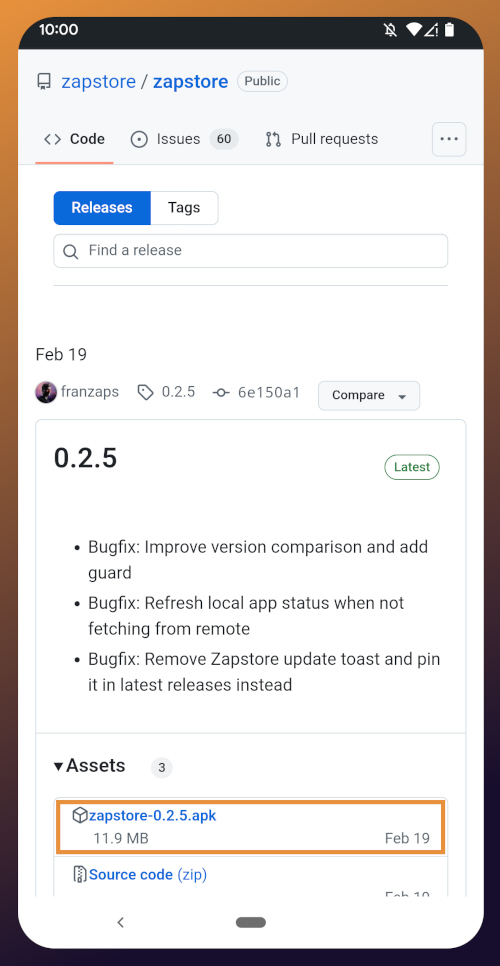
Tap the .apk to download it, and you should get a notification when the download has completed, with a prompt to open the file.
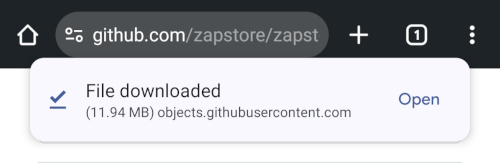
You will likely be presented with a prompt warning you that your phone currently isn't allowed to install applications from "unknown sources." Anywhere other than the Play Store is considered an "unknown source" by default. However, you can manually allow installation from unknown sources in the settings, which the prompt gives you the option to do.
In the settings page that opens, toggle it to allow installation from this source, and you should be prompted to install the application. If you aren't, simply go to your web browser's downloads and tap on the .apk file again, or go into your file browser app and you should find the .apk in your Downloads folder.

If the application doesn't open automatically after install, you will find it in your app drawer.
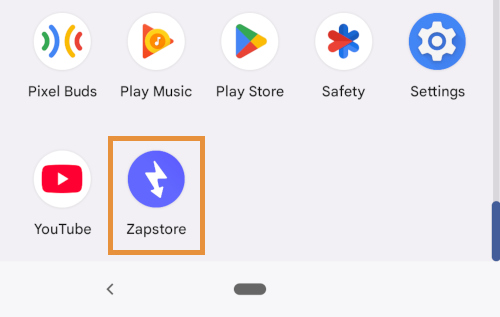
Home Page
Right at the top of the home page in the Zapstore is the search bar. You can use it to find a specific app you know is available in the Zapstore.

There are quite a lot of open source apps available, and more being added all the time. Most are added by the Zapstore developer, nostr:npub1wf4pufsucer5va8g9p0rj5dnhvfeh6d8w0g6eayaep5dhps6rsgs43dgh9, but some are added by the app developers themselves, especially Nostr apps. All of the applications we will be installing through the Zapstore have been added by their developers and are cryptographically signed, so you know that what you download is what the developer actually released.
The next section is for app discovery. There are curated app collections to peruse for ideas about what you may want to install. As you can see, all of the other apps we will be installing are listed in nostr:npub1wf4pufsucer5va8g9p0rj5dnhvfeh6d8w0g6eayaep5dhps6rsgs43dgh9's "Nostr" collection.
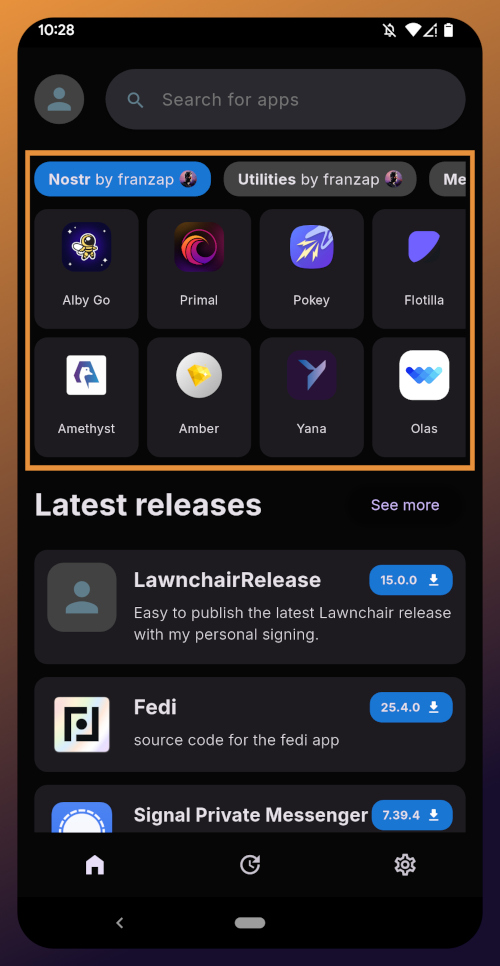
In future releases of the Zapstore, users will be able to create their own app collections.
The last section of the home page is a chronological list of the latest releases. This includes both new apps added to the Zapstore and recently updated apps. The list of recent releases on its own can be a great resource for discovering apps you may not have heard of before.

Installed Apps
The next page of the app, accessed by the icon in the bottom-center of the screen that looks like a clock with an arrow circling it, shows all apps you have installed that are available in the Zapstore. It's also where you will find apps you have previously installed that are ready to be updated. This page is pretty sparse on my test profile, since I only have the Zapstore itself installed, so here is a look at it on my main profile:
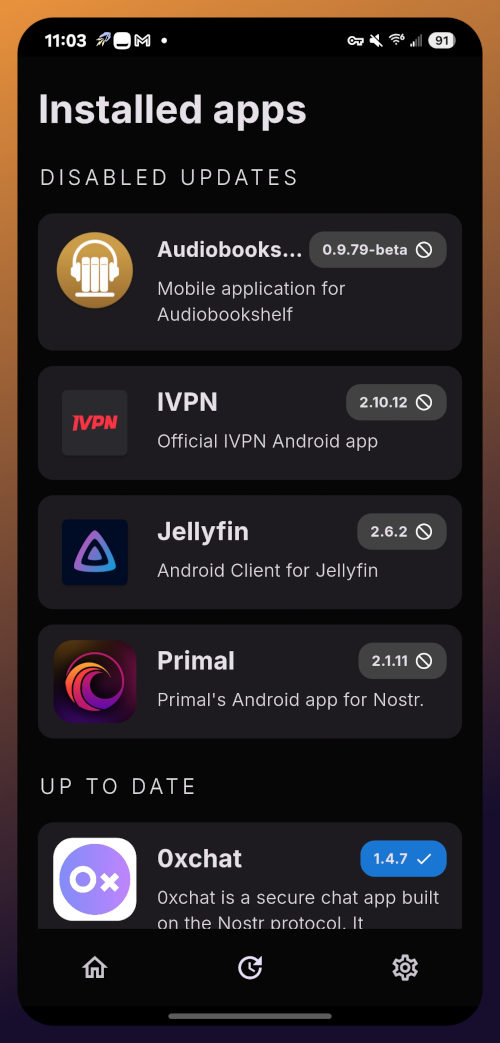
The "Disabled Apps" at the top are usually applications that were installed via the Play Store or some other means, but are also available in the Zapstore. You may be surprised to see that some of the apps you already have installed on your device are also available on the Zapstore. However, to manage their updates though the Zapstore, you would need to uninstall the app and reinstall it from the Zapstore instead. I only recommend doing this for applications that are added to the Zapstore by their developers, or you may encounter a significant delay between a new update being released for the app and when that update is available on the Zapstore.
Tap on one of your apps in the list to see whether the app is added by the developer, or by the Zapstore. This takes you to the application's page, and you may see a warning at the top if the app was not installed through the Zapstore.
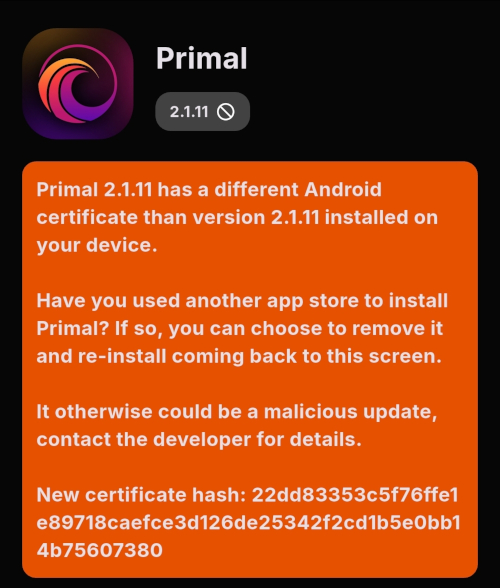
Scroll down the page a bit and you will see who signed the release that is available on the Zapstore.

In the case of Primal, even though the developer is on Nostr, they are not signing their own releases to the Zapstore yet. This means there will likely be a delay between Primal releasing an update and that update being available on the Zapstore.
Settings
The last page of the app is the settings page, found by tapping the cog at the bottom right.
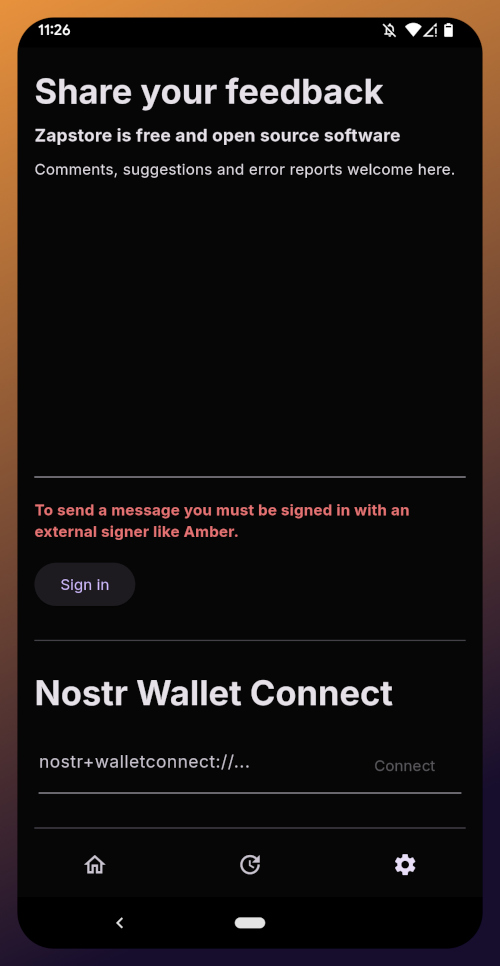
Here you can send the Zapstore developer feedback directly (if you are logged in), connect a Lightning wallet using Nostr Wallet Connect, delete your local cache, and view some system information.
We will be adding a connection to our nostr:npub1h2qfjpnxau9k7ja9qkf50043xfpfy8j5v60xsqryef64y44puwnq28w8ch wallet in part 5 of this tutorial series.
For the time being, we are all set with the Zapstore and ready for the next stage of our journey.
Continue to Part 3: Amber Signer. Nostr link: nostr:naddr1qqxnzde5xuengdeexcmnvv3eqgstwf6d9r37nqalwgxmfd9p9gclt3l0yc3jp5zuyhkfqjy6extz3jcrqsqqqa28qy2hwumn8ghj7un9d3shjtnyv9kh2uewd9hj7qg6waehxw309aex2mrp0yhxyunfva58gcn0d36zumn9wss80nug
-
 @ c631e267:c2b78d3e
2024-10-23 20:26:10
@ c631e267:c2b78d3e
2024-10-23 20:26:10Herzlichen Glückwunsch zum dritten Geburtstag, liebe Denk Bar! Wieso zum dritten? Das war doch 2022 und jetzt sind wir im Jahr 2024, oder? Ja, das ist schon richtig, aber bei Geburtstagen erinnere ich mich immer auch an meinen Vater, und der behauptete oft, der erste sei ja schließlich der Tag der Geburt selber und den müsse man natürlich mitzählen. Wo er recht hat, hat er nunmal recht. Konsequenterweise wird also heute dieser Blog an seinem dritten Geburtstag zwei Jahre alt.
Das ist ein Grund zum Feiern, wie ich finde. Einerseits ganz einfach, weil es dafür gar nicht genug Gründe geben kann. «Das Leben sind zwei Tage», lautet ein gängiger Ausdruck hier in Andalusien. In der Tat könnte es so sein, auch wenn wir uns im Alltag oft genug von der Routine vereinnahmen lassen.
Seit dem Start der Denk Bar vor zwei Jahren ist unglaublich viel passiert. Ebenso wie die zweieinhalb Jahre davor, und all jenes war letztlich auch der Auslöser dafür, dass ich begann, öffentlich zu schreiben. Damals notierte ich:
«Seit einigen Jahren erscheint unser öffentliches Umfeld immer fragwürdiger, widersprüchlicher und manchmal schier unglaublich - jede Menge Anlass für eigene Recherchen und Gedanken, ganz einfach mit einer Portion gesundem Menschenverstand.»
Wir erleben den sogenannten «großen Umbruch», einen globalen Coup, den skrupellose Egoisten clever eingefädelt haben und seit ein paar Jahren knallhart – aber nett verpackt – durchziehen, um buchstäblich alles nach ihrem Gusto umzukrempeln. Die Gelegenheit ist ja angeblich günstig und muss genutzt werden.
Nie hätte ich mir träumen lassen, dass ich so etwas jemals miterleben müsste. Die Bosheit, mit der ganz offensichtlich gegen die eigene Bevölkerung gearbeitet wird, war früher für mich unvorstellbar. Mein (Rest-) Vertrauen in alle möglichen Bereiche wie Politik, Wissenschaft, Justiz, Medien oder Kirche ist praktisch komplett zerstört. Einen «inneren Totalschaden» hatte ich mal für unsere Gesellschaften diagnostiziert.
Was mich vielleicht am meisten erschreckt, ist zum einen das Niveau der Gleichschaltung, das weltweit erreicht werden konnte, und zum anderen die praktisch totale Spaltung der Gesellschaft. Haben wir das tatsächlich mit uns machen lassen?? Unfassbar! Aber das Werkzeug «Angst» ist sehr mächtig und funktioniert bis heute.
Zum Glück passieren auch positive Dinge und neue Perspektiven öffnen sich. Für viele Menschen waren und sind die Entwicklungen der letzten Jahre ein Augenöffner. Sie sehen «Querdenken» als das, was es ist: eine Tugend.
Auch die immer ernsteren Zensurbemühungen sind letztlich nur ein Zeichen der Schwäche, wo Argumente fehlen. Sie werden nicht verhindern, dass wir unsere Meinung äußern, unbequeme Fragen stellen und dass die Wahrheit peu à peu ans Licht kommt. Es gibt immer Mittel und Wege, auch für uns.
Danke, dass du diesen Weg mit mir weitergehst!
-
 @ 6b0a60cf:b952e7d4
2024-12-05 11:16:09
@ 6b0a60cf:b952e7d4
2024-12-05 11:16:09フォロワーリストを低コストで取得する仕様を考える
Nostr リレーはフォロワー数をカウントしたほうが良いを受けて考えたことを雑多に書き留めておきます
単一リレーの場合
NIP-45 COUNT を使う
短所
- 単一リレーで数えた総数でしかない
- 現時点では数を返すのみ
- 複数リレーでマージできるようにidsを一緒に返そうという提案もある
{"#p": <pubkey>, "kinds": [3]} でREQする
短所
- 単一リレーで数えた総数でしかない
- フォロワーの数だけクソデカイベントが返ってくるので時間がかかるしギガが減る
複数リレーの場合
{"#p": <pubkey>, "kinds": [3]} でREQする
長所
- 複数リレーでマージできる
- そこそこもっともらしいフォロワーリストが取れる
短所
- 一度でもフォローをしたことがある人のリストでしかない(後にアンフォローしたかもしれない)
- nostr:nevent1qqs829n0s3qa3wegnhpf6haz3t87hn9huznldd4x2ld6c0d02uq09gsge47l7
- リストすべての公開鍵で接続リレーとkind3を調べ直してアンフォローされている場合を除く処理をすればそこそこ正確になる
- 大変すぎる
- 未調査のリレーにフォロワーがいるかもしれない
新しいkind(フォロワーを格納する)を新設する
仮にkind1003とする
kind3と同じ構造とする{ "kind": 1003, "pubkey": "<Aさんの公開鍵>", "tags": [ ["p", "<Bさんの公開鍵>"], ["p", "<Cさんの公開鍵>"], ["p", "<Dさんの公開鍵>"] ], // other fields... }で、これ誰が作るの?
リレーが作る
- pubkeyにはAさんの公開鍵を入れることになるけど、署名するにはAさんの秘密鍵が必要だよ?
- 無理
クライアントが作る
- Rabbitやnostter等のクライアントにはプロフィール画面でフォロワーのところをクリックするとフォロワーの取得が始まる
- その際、構築したフォロワーリストをkind1003イベントとしてリレーに送ってしまえば良い
- リレー毎でなく複数リレーのマージした結果であるが、その方が有用だろう
- でもkind1003を作成した時期はアカウント毎にバラバラになってしまうね
誰が嬉しいの?
- クライアントは恩恵を受けない
- 本来kind1003の恩恵を受けるべきクライアント自身がkind1003を作らなくてはならない
- 統計調査に興味がある人が満足する
- そのためだけに各クライアントを使用するユーザーの端末のリソースを使う価値があるかどうか
そもそもリレーである必要があるだろうか
- リレーはシンプルであるべきだが、リレーに高機能を求めること自体は否定されるべきことではない
- NIP-50のように検索に特化したリレーもある
でもこの統計情報ってWebSocketで送られてくるべきものだろうか?HTTPで良くない?
リレーである必要すらなくて、REST APIを提供するサービスがあれば十分だよね?
外部サービスとして独自にデータを集めているサービスは既にあるこれをNIPにする必要があるだろうか
- WebSocketやリレーが登場しないからといってNIPに定義してはいけないなんてことはない
- 例: NIP-96
- しかしNIPというのは仕様を共通化して共有するためのものであり、複数の実装を期待するものである
- 統計API提供サービスなど1つあれば十分で、耐検閲性を目的として10個も100個も存在を期待されるものではない
-
 @ e0a8cbd7:f642d154
2024-12-04 15:42:58
@ e0a8cbd7:f642d154
2024-12-04 15:42:58これは「Nostr Advent Calendar 2024」5日目(12月5日)の記事です。
2024年にNostrにのみ投稿した絵で今年を振り返りたいと思います。 あえて、タイトルのみで、なぜその絵を描いたかなどの絵の説明は書かないことにします。
1月2日 ブルルッチモ大噴火!

1月9日 Macの箱を開けながら、ギャォォォォンって叫ぶぺぇさん。

1月12日 便器の上で踊るサボテンになったぽーまんさん。

1月15日 空飛ぶつるるん。

1月23日 ぽわどん

1月26日 Lokuyow said "I am a pen."

1月28日 ロクヨウ「早く人間にのりたい」

1月31日 小さなmonoから大きなmonoまで

2月1日 しおさん、巨象恐怖症

2月1日 枕を積んで寝るDonさん。

2月4日 ブロッコリの逆襲

2月8日 びっとこダチョ太郎

2月13日 虹色カレーを食べて虹色になったロクヨウさん

2月13日 ロクヨウさん誕生秘話

3月5日 人参と椎茸たべるロクヨウさん

3月5日 まきうさん、ロクヨウさんに乗って東京へ

3月26日 ごはんの上のめんたいこぽーまん

3月26日 ポワニッチモ

4月4日 上司にズラしていくことを許可されて朝の悩みが増えたぺえさん

5月7日 とうふさんが演じる「お洋服とっかえひっかえして遊ぶりとりんとやぶみん」

6月20日 ソファーと一体化するポーマンさん

6月21日 つるるん食べていい?

6月28日 ぽーまんさん、たいきんのまい

7月5日 ソファから剥がれて出発するぽーまんさん

8月10日 ぽーまんさん、床のコスプレ

8月18日 アルパカプリン

8月23日 とうふさんが演じるやぶみちゃんの日

8月23日 神妙な顔のぽ-まんさん

8月26日 恋のアルパカキューピット

8月27日 仲良く激辛火鍋

8月28日 Microsoftが「Mono」をWineチームに寄贈

9月12日 もの発射

9月19日 ロクヨウさんヒツジ化

9月20日 ゴリラ食べてバナナになったロクヨウさん

10月13日 頭が増えるぽーまんさん

10月24日 カメムシと青いうさぎ

10月25日 ATMとお話しするポーマンさん

10月26日 パペェ

10月26日 ぺどがわさん

11月7日 伸び縮みぺぇ

11月10日 座布団で寝るぽーまんさん

11月17日 5等分のぽーまん

11月27日 ルンバブルな部屋

11月28日 7人のぽーまん、那月さんに祓われる

11月29日 捕鯨ぽーまん

11月30日 ぽーまんさん脳内のゴミカスサンバ♪

楽しい1年でした。
Nostrのみなさま、たのしい話題をありがとうございます。
明日の「Nostr Advent Calendar 2024」は、OHASHI Hideyaさんです。
しーゆー。 -
 @ b7274d28:c99628cb
2025-05-28 00:59:49
@ b7274d28:c99628cb
2025-05-28 00:59:49Your identity is important to you, right? While impersonation can be seen in some senses as a form of flattery, we all would prefer to be the only person capable of representing ourselves online, unless we intentionally delegate that privilege to someone else and maintain the ability to revoke it.
Amber does all of that for you in the context of #Nostr. It minimizes the possibility of your private key being compromized by acting as the only app with access to it, while all other Nostr apps send requests to Amber when they need something signed. This even allows you to give someone temporary authority to post as you without giving them your private key, and you retain the authority to revoke their permissions at any time.
nostr:npub1w4uswmv6lu9yel005l3qgheysmr7tk9uvwluddznju3nuxalevvs2d0jr5 has provided Android users with an incredibly powerful tool in Amber, and he continues to improve its functionality and ease of use. Indeed, there is not currently a comparative app available for iOS users. For the time being, this superpower is exclusive to Android.
Installation
Open up the Zapstore app that you installed in the previous stage of this tutorial series.
Very likely, Amber will be listed in the app collection section of the home page. If it is not, just search for "Amber" in the search bar.

Opening the app's page in the Zapstore shows that the release is signed by the developer. You can also see who has added this app to one of their collections and who has supported this app with sats by zapping the release.
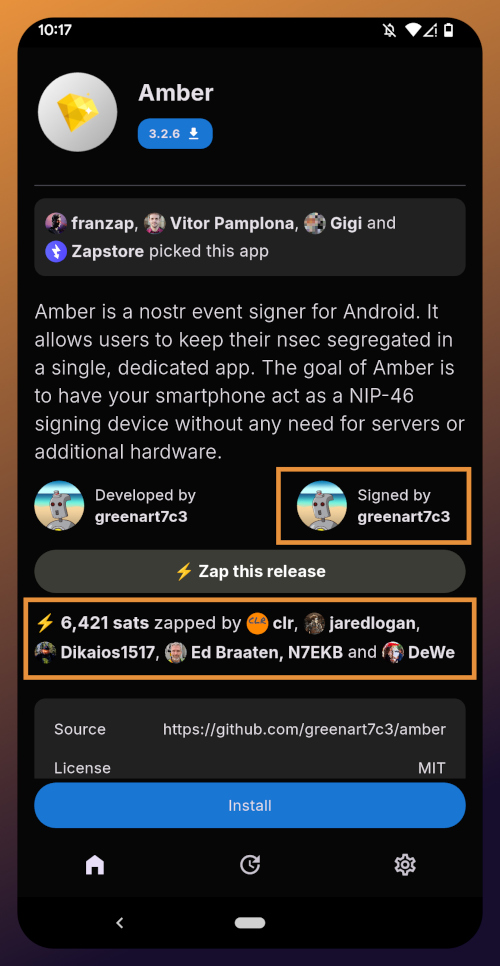
Tap "Install" and you will be prompted to confirm you are sure you want to install Amber.
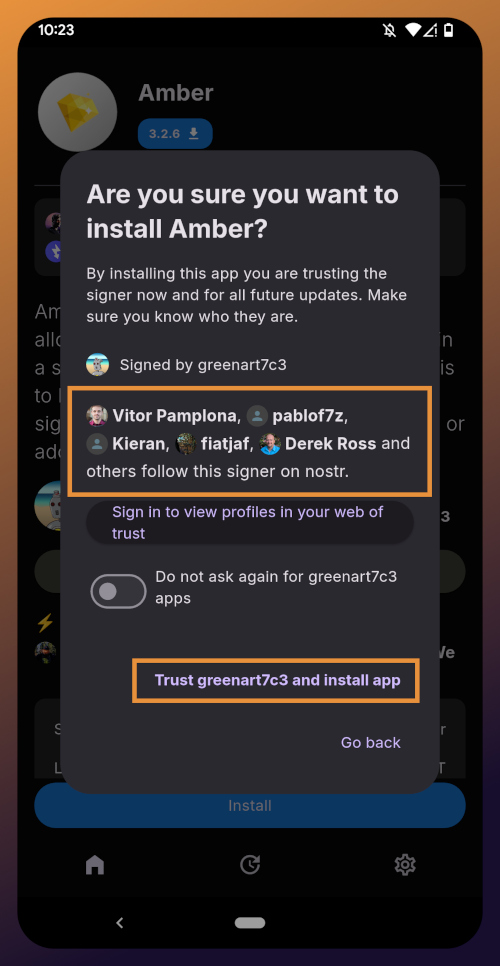
Helpfully, you are informed that several other users follow this developer on Nostr. If you have been on Nostr a while, you will likely recognize these gentlemen as other Nostr developers, one of them being the original creator of the protocol.
You can choose to never have Zapstore ask for confirmation again with apps developed by nostr:npub1w4uswmv6lu9yel005l3qgheysmr7tk9uvwluddznju3nuxalevvs2d0jr5, and since we have another of his apps to install later in this tutorial series, I recommend you toggle this on. Then tap on "Trust greenart7c3 and install app."
Just like when you installed the Zapstore from their GitHub, you will be prompted to allow the Zapstore to install apps, since Android considers it an "unknown source."
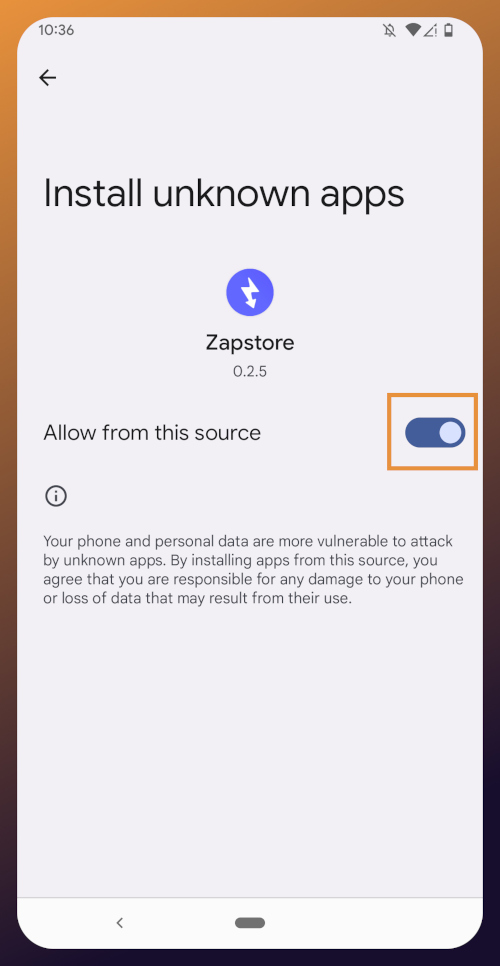
Once you toggle this on and use the back button to get back to the Zapstore, Amber will begin downloading and then present a prompt to install the app. Once installed, you will see a prompt that installation was a success and you can now open the app.

From here, how you proceed will depend on whether you need to set up a new Nostr identity or use Amber with an existing private key you already have set up. The next section will cover setting up a new Nostr identity with Amber. Skip to the section titled "Existing Nostrich" if you already have an nsec that you would like to use with Amber.
New Nostrich
Upon opening the application, you will be presented with the option to use an existing private key or create a new Nostr account. Nostr doesn't really have "accounts" in the traditional sense of the term. Accounts are a relic of permissioned systems. What you have on Nostr are keys, but Amber uses the "account" term because it is a more familiar concept, though it is technically inaccurate.

Choose "Create a new Nostr account" and you will be presented with a screen telling you that your Nostr account is ready. Yes, it was really that easy. No email, no real name, no date of birth, and no annoying capcha. Just "Create a new account" and you're done.
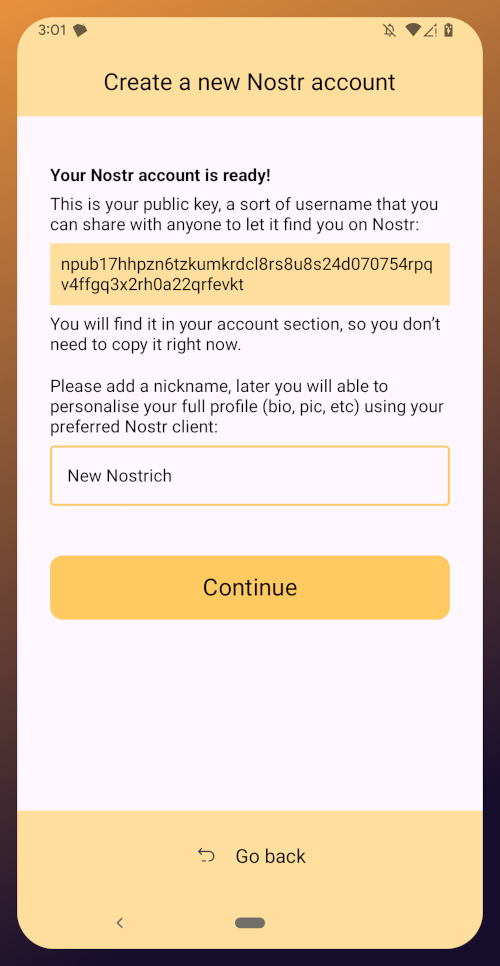
The app presents you with your public key. This is like an address that can be used to find your posts on Nostr. It is 100% unique to you, and no one else can post a note that lists this npub as the author, because they won't have the corresponding private key. You don't need to remember your npub, though. You'll be able to readily copy it from any Nostr app you use whenever you need it.
You will also be prompted to add a nickname. This is just for use within Amber, since you can set up multiple profiles within the app. You can use anything you want here, as it is just so you can tell which profile is which when switching between them in Amber.
Once you've set your nickname, tap on "Continue."
The next screen will ask you what Amber's default signing policy should be.
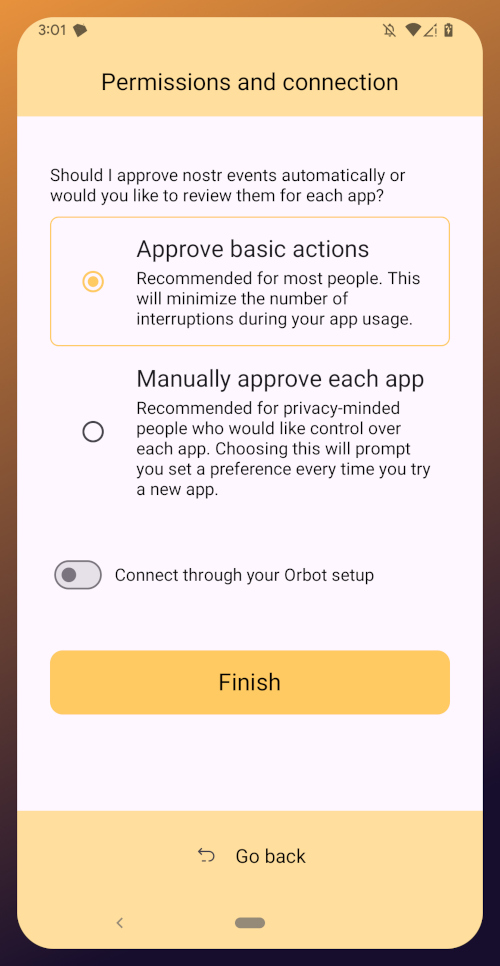
The default is to approve basic actions, referring to things that are common for Nostr clients to request a signature for, like following another user, liking a post, making a new post, or replying. If you are more concerned about what Amber might be signing for on your behalf, you can tell it to require manual approval for each app.
Once you've made your decision, tap "Finish." You will also be able to change this selection in the app settings at any time.
With this setup out of the way, you are now presented with the main "Applications" page of the app.
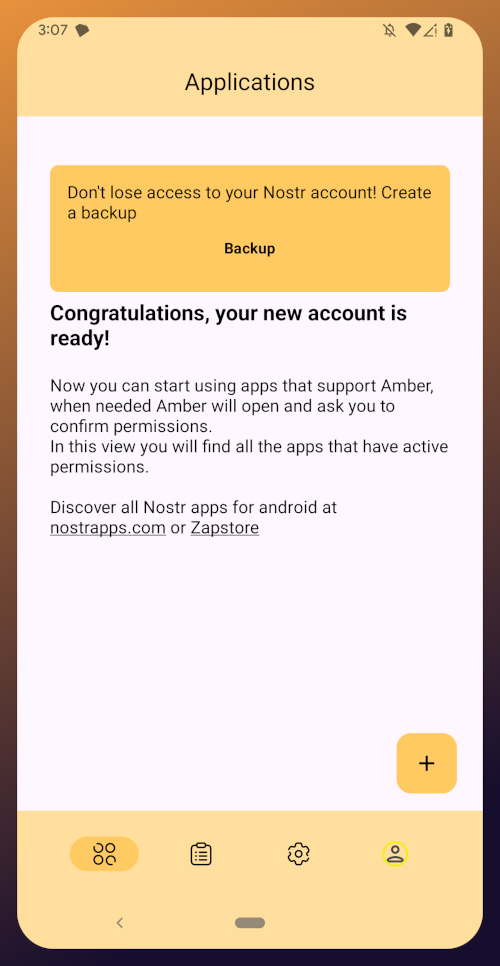
At the top, you have a notification encouraging you to create a backup. Let's get that taken care of now by tapping on the notification and skipping down to the heading titled "Backing Up Your Identity" in this tutorial.
Existing Nostrich
Upon opening the application, you will be presented with the option to use your private key or create a new Nostr account. Choose the former.

The next screen will require you to paste your private key.

You will need to obtain this from whatever Nostr app you used to create your profile, or any other Nostr app that you pasted your nsec into in the past. Typically you can find it in the app settings and there will be a section mentioning your keys where you can copy your nsec. For instance, in Primal go to Settings > Keys > Copy private key, and on Amethyst open the side panel by tapping on your profile picture in the top-left, then Backup Keys > Copy my secret key.
After pasting your nsec into Amber, tap "Next."

Amber will give you a couple options for a default signing policy. The default is to approve basic actions, referring to things that are common for Nostr clients to request a signature for, like following another user, liking a post, making a new post, or replying. If you are more concerned about what Amber might be signing for on your behalf, you can tell it to require manual approval for each app.
Once you've made your decision, tap "Finish." You will also be able to change this selection in the app settings at any time.

With this setup out of the way, you are now presented with the main "Applications" page of the app. You have nothing here yet, since you haven't used Amber to log into any Nostr apps, but this will be where all of the apps you have connected with Amber will be listed, in the order of the most recently used at the top.
Before we go and use Amber to log into an app, though, let's make sure we've created a backup of our private key. You pasted your nsec into Amber, so you could just save that somewhere safe, but Amber gives you a few other options as well. To find them, you'll need to tap the cog icon at the bottom of the screen to access the settings, then select "Backup Keys."

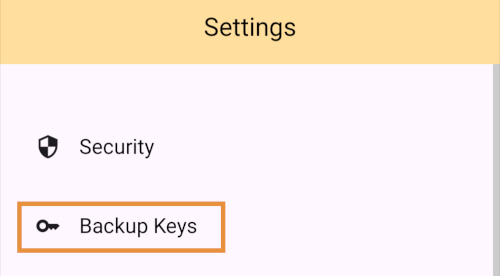
Backing Up Your Identity

You'll notice that Amber has a few different options for backing up your private key that it can generate.
First, it can give you seed words, just like a Bitcoin seed. If you choose that option, you'll be presented with 12 words you can record somewhere safe. To recover your Nostr private key, you just have to type those words into a compatible application, such as Amber.
The next option is to just copy the secret/private key in its standard form as an "nsec." This is the least secure way to store it, but is also the most convenient, since it is simple to paste into another signer application. If you want to be able to log in on a desktop web app, the browser extension Nostr signers won't necessarily support entering your 12 word seed phrase, but they absolutely will support pasting in your nsec.
You can also display a QR code of your private key. This can be scanned by Amber signer on another device for easily transferring your private key to other devices you want to use it on. Say you have an Android tablet in addition to your phone, for instance. Just make sure you only use this function where you can be certain that no one will be able to get a photograph of that QR code. Once someone else has your nsec, there is no way to recover it. You have to start all over on Nostr. Not a big deal at this point in your journey if you just created a Nostr account, but if you have been using Nostr for a while and have built up a decent amount of reputation, it could be much more costly to start over again.
The next options are a bit more secure, because they require a password that will be used to encrypt your private key. This has some distinct advantages, and a couple disadvantages to be aware of. Using a password to encrypt your private key will give you what is called an ncryptsec, and if this is leaked somehow, whoever has it will not necessarily have access to post as you on Nostr, the way they would if your nsec had been leaked. At least, not so long as they don't also have your password. This means you can store your ncryptsec in multiple locations without much fear that it will be compromised, so long as the password you used to encrypt it was a strong and unique one, and it isn't stored in the same location. Some Nostr apps support an ncryptsec for login directly, meaning that you have the option to paste in your ncryptsec and then just log in with the password you used to encrypt it from there on out. However, now you will need to keep track of both your ncryptsec and your password, storing both of them safely and separately. Additionally, most Nostr clients and signer applications do not support using an ncryptsec, so you will need to convert it back to a standard nsec (or copy the nsec from Amber) to use those apps.
The QR option using an ncryptsec is actually quite useful, though, and I would go this route when trying to set up Amber on additional devices, since anyone possibly getting a picture of the QR code is still not going to be able to do anything with it, unless they also get the password you used to encrypt it.
All of the above options will require you to enter the PIN you set up for your device, or biometric authentication, just as an additional precaution before displaying your private key to you.
As for what "store it in a safe place" looks like, I highly recommend a self-hosted password manager, such as Vaultwarden+Bitwarden or KeePass. If you really want to get wild, you can store it on a hardware signing device, or on a steel seed plate.
Additional Settings

Amber has some additional settings you may want to take advantage of. First off, if you don't want just anyone who has access to your phone to be able to approve signing requests, you can go into the Security settings add a PIN or enable biometrics for signing requests. If you enable the PIN, it will be separate from the PIN you use to access your phone, so you can let someone else use your phone, like your child who is always begging to play a mobile game you have installed, without worrying that they might have access to your Nostr key to post on Amethyst.
Amber also has some relay settings. First are the "Active relays" which are used for signing requests sent to Amber remotely from Nostr web apps. This is what enables you to use Amber on your phone to log into Nostr applications on your desktop web browser, such as Jumble.social, Coracle.social, or Nostrudel.ninja, eliminating your need to use any other application to store your nsec whatsoever. You can leave this relay as the default, or you can add other relays you want to use for signing requests. Just be aware, not all relays will accept the notes that are used for Nostr signing requests, so make sure that the relay you want to use does so. In fact, Amber will make sure of this for you when you type in the relay address.
The next type of relays that you can configure in Amber are the "Default profile relays." These are used for reading your profile information. If you already had a Nostr identity that you imported to Amber, you probably noticed it loaded your profile picture and display name, setting the latter as your nickname in Amber. These relays are where Amber got that information from. The defaults are relay.nostr.band and purplepag.es. The reason for this is because they are aggregators that look for Nostr profiles that have been saved to other relays on the network and pull them in. Therefore, no matter what other relay you may save your profile to, Amber will likely be able to find it on one of those two relays as well. If you have a relay you know you will be saving your Nostr profiles to, you may want to add it to this list.
You can also set up Amber to be paired with Orbot for signing over Tor using relays that are only accessible via the Tor network. That is an advanced feature, though, and well beyond the scope of this tutorial.
Finally, you can update the default signing policy. Maybe after using Amber for a while, you've decided that the choice you made before was too strict or too lenient. You can change it to suit your needs.
Zapstore Login
Now that you are all set up with Amber, let's get you signed into your first Nostr app by going back to the Zapstore.
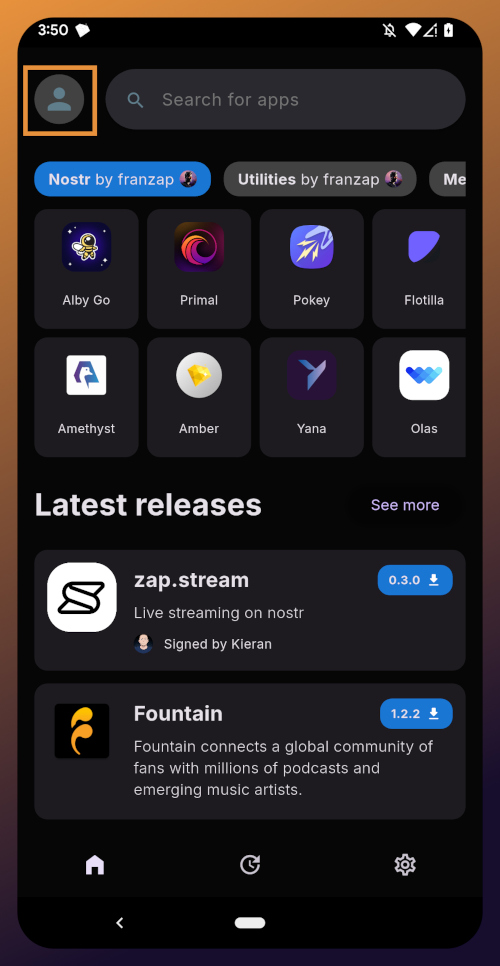
From the app's home screen, tap on the user icon in the upper left of the screen. This will open a side panel with not much on it except the option to "sign in." Go ahead and tap on it.
You will be presented with the option to either sign in with Amber, or to paste your npub. However, if you do the latter, you will only have read access, meaning you cannot zap any of the app releases. There are other features planned for the Zapstore that may also require you to be signed in with write access, so go ahead and choose to log in with Amber.
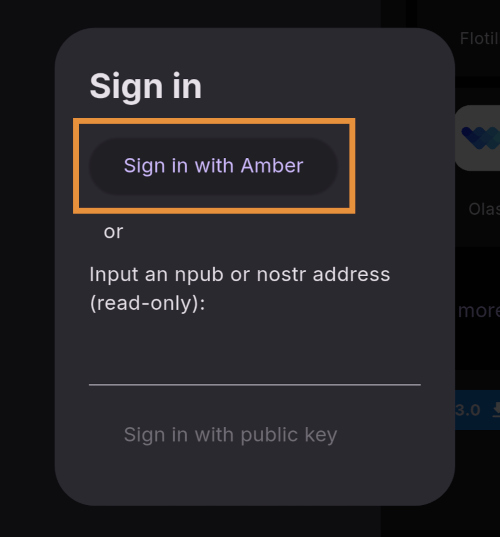
Your phone should automatically switch to Amber to approve the sign-in request.
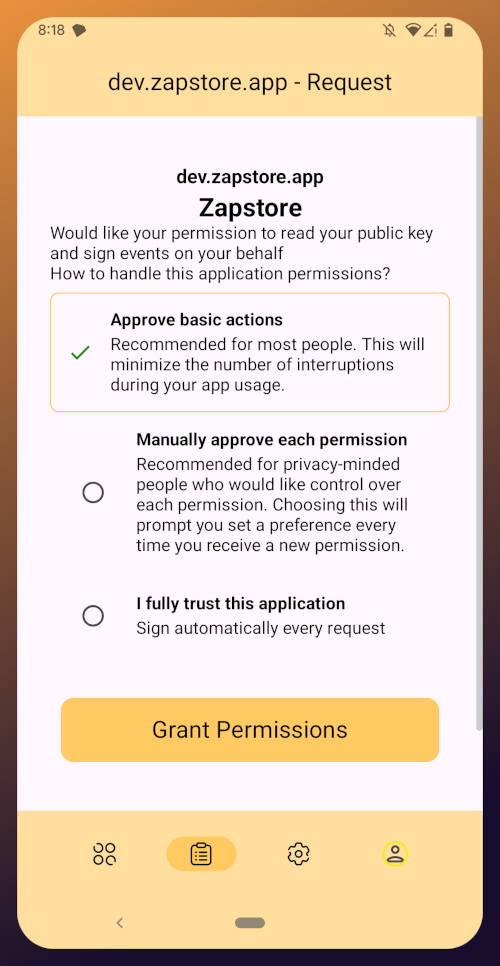
You can choose to only approve basic actions for Zapstore, require it to manually approve every time, or you can tell it that you "fully trust this application." Only choose the latter option with apps you have used for a while and they have never asked you to sign for anything suspicious. For the time being, I suggest you use the "Approve basic actions" option and tap "Grant Permissions."
Your phone will switch back to the Zapstore and will show that you are now signed in. Congratulations! From here on out, logging into most Nostr applications will be as easy as tapping on "Log in with Amber" and approving the request.

If you set up a new profile, it will just show a truncated version of your npub rather than the nickname you set up earlier. That's fine. You'll have an opportunity to update your Nostr profile in the next tutorial in this series and ensure that it is spread far and wide in the network, so the Zapstore will easily find it.
That concludes the tutorial for Amber. While we have not covered using Amber to log into Nostr web apps, that is outside the scope of this series, and I will cover it in an upcoming tutorial regarding using Amber's remote signer options in detail.
Since you're already hanging out in the Zapstore, you may as well stick around, because we will be using it right out the gate in the next part of this series: Amethyst Installation and Setup. (Coming Soon)
-
 @ 21ac2956:09d1e2df
2024-12-01 04:44:45
@ 21ac2956:09d1e2df
2024-12-01 04:44:45kakoi の仕様についてのメモ
キーボード操作
- 左手での操作に最適化
| キー | 動作 | |:-|:-| | ESC | 設定画面 | | F1 / F12 | ポストバーの表示と非表示 | | F2 | 時間の表示と非表示 | | F3 | ユーザーアイコンの表示と非表示 | | F4 | 名前の表示と非表示 | | F9 / Z | コンテンツの折り返し表示の切り替え (余白ダブルクリックでも動作) | | F10 | ユーザーリストとキーワード通知の設定画面 (余白右クリックでも動作) | | F11 | メイン画面の表示と非表示 (ポストバー表示) | | Shift + W | イベント最上行へ移動 | | W / ↑| イベント選択上移動 | | S / ↓ | イベント選択下移動 | | Shift + S | イベント最下行へ移動 | | A / ← | Webビューを開く (イベントを右クリックでも動作) | | F / → | リアクションを送信 (イベントをダブルクリックでも動作) | | 1 ~ 0 | リアクションを選択 | | R | 返信 | | B | リポスト | | Q | 引用 | | C | Webビューを閉じる | | Ctrl + Shift + A | メイン画面をアクティブにする |
タイムライン
- kind:1, 6, 7, 16を取得して表示する
- フォロイーの名前の前には * が付く
フォローリスト(kind:3)
-
参照のみで更新はしない
-
F10 で開くユーザーリストでユーザーを選択し petname セルをクリックすることで未フォローユーザーにもペットネームを設定可能(ローカル保存)
プロフィール(kind:0)
- F10 で開くユーザーリストでユーザーを選択し picture セルをクリックすることでユーザーのアイコン表示を変更可能(ローカル保存)
返信(NIP-10 kind:1)
- kakoi のタイムラインに流れるすべてのイベント種に返信可能とする
- スレッドを考慮せず、単一イベントへの単発返信とする
- e タグは marker と返信先 pubkey は設定していない。 relay-url には空文字を設定
json ["e", "返信先 event-id", ""]- p タグは 返信先 pubkey ひとつだけを指定
リポスト(NIP-18 kind:6 , 16)
- kakoi のタイムラインに流れるすべてのイベント種をリポスト可能
- kind:1はkind:6。その他はkind:16でリポストする
- e タグは relay-url に空文字を設定
json ["e", "リポスト元 event-id", ""]引用(NIP-18 kind:1)
- q タグは relay-url に空文字を設定
json ["q", "引用元 event-id", ""] -
 @ 491afeba:8b64834e
2025-05-27 23:57:01
@ 491afeba:8b64834e
2025-05-27 23:57:01Quando adolescente eu acreditava na coerência da teoria de "amor líquido" do polonês, sociólogo, Zygmunt Bauman, apresentada no livro "Amor Líquido: Sobre a Fragilidade dos Laços Humanos", qual no meu amadurecimento em estudos, sejam eles no meio acadêmico ou fora, percebo como uma das formas mais rasas de explicar as mudanças e transformações dos padrões de relações sócio-afetivas dos humanos. A seguir colocar-me-ei na minha juventude não tanto recente, direi então que nós, se adolescentes e conservadores, ou mesmo jovens adultos mais conservadores, costumamos levar como dogma uma óptica decadentista generalizada de todos os avanços de eras dos homens, universalizamos por nos ser comum a indistinção entre humanidade e humanidades, ou mesmo "humanity" e "humankind" ("humanidade" como espécime e "humanidade" como um universal), compreendemos toda "essas" como "essa" e indistinguimos as sociedades para com os homens, ou seja, a incapacidade de definir os seres dentro de suas respectivas singularidades e especificidades nos leva ao decadentismo generalista (a crença de que de forma geral, e universal, a "civilização universal" decai moralmente, éticamente, materialmente e espiritualmente), que aparente à nós determinadas mudanças nas relações humanas quanto ao caráter sócio-afetivo, por falta de profundidade e critérios ainda sobre questões alinhadas aos métodos e coerências, ou incoerências, lógicas, nós se jovens e conservadores somos levados ao engodo de concordar com a teoria do amor líquido de Bauman, que devo cá explicar de antemão: trata ela, a teoria, o padrão de "amor" dos tempos presentes como frágil, de prazo (curto e médio) e diferente em grau comparativamente ao amor comum das eras passadas.
Aos jovens mais progressistas opera uma compreensão dialética sobre as eras dos homens nos seu tempo presente, na qual ao tempo que o ser progride ele também regride simultaneamente, ou seja, a medida que aparecem contradições advindas de transformações materiais da realidade humana o ser supera essas contradições e progride em meio as transformações, ainda fazendo parte da lógica dessa indissociavelmente, assim constantemente progredindo e regredindo, havendo para esses dois vetores de distinção: o primeiro é o que releva questões espirituais como ao caráter do pensamento "new age", o segundo ignora essas questões por negar a existência da alma, seguem ao materialismo. Cedem em crer na teoria baumaninana como dogma, pois não encontram outros meios para explicar as transformações da sociedade na esfera sócio-afetiva sem que haja confrontamento direto com determinadas premissas assim pertinemente presentes, ou por não conciliarem com análises relativamente superiores, como a de Anthony Giddens sobre a "relação pura" em "A Transformação da Intimidade" e de François de Singly apresentada em "Sociologie du Couple".
https://i.pinimg.com/736x/6f/b4/9e/6fb49eda2c8cf6dc837a0abfc7e108e6.jpg
Há um problema quando uma teoria deixa de assim ser para vir a tornar-se mais um elemento desconexo da ciência, agora dentro da cultura pop, se assim podemos dizer, ou da cultura de massa, ou se preferirem mesmo "anticultura", esse problema é a sua deformização teórica, tornando-se essa rasa para sua palatabilidade massiva, somada a incapacidade de partes da sociedade civil em compreender as falhas daquilo que já foi massificado. Tive surpresa ao entender que muitos outros compartilham da mesma opinião, a exemplo, possuo um amigo na faculdade, marxista, que ao falarmos sobre nossos projetos de pesquisa, citou ele o projeto de um de nossos colegas, no qual esse referido um de nossos colegas faria seu projeto com base na teoria do amor líquido de Bauman, então alí demos risada disso, ora, para nós a teoria baumaniana é furada, passamos a falar sobre Bauman e o motivo pelo qual não gostávamos, lá fiquei até surpreso em saber que mais gente além de mim não gostava da teoria de Bauman, pois ao que eu via na internet era rede de enaltecimentos à figura e à sua teoria, tal como fosse uma revelação partindo de alguma divindade da Idade do Bronze. Pouco tempo depois tive em aula de teoria política uma citação de Bauman partindo do professor que ministrava a disciplina, no entanto, ao citar o nome de Bauman o mesmo fez uma feição na qual aparentava segurar risada, provavelmente ele também não levava Bauman à sério. Não devo negar que todas as vezes que vejo o sociólogo sendo citado em alguma nota no X, no Instagram ou qualquer outra rede social, tal como fosse um referencial teórico bom, sinto uma vergonha alheia pois alí tenho uma impressão de que a pessoa não leu Bauman e usa o referencial teórico como um fato já assim provado e comprovado.
Há pontos positivos na teoria baumaniana, como a capacidade de perceber o problema e correlacioná-lo à modernidade, assim como sucitar a influência do que há de material no fenômeno, porém os erros são pertinentes: o primeiro problema é de categoria. Não há, por parte de Bauman noção alguma entre as dissociações dos amores, não há atenção sobre o amor como estrutura ou ele como um sentimento, todo ele é compreendido uniformemente como "amor", partindo do pressuposto que todas as relações, todas elas, são firmadas com base no amor. Essa crença tem uma origem: Hegel. Nos Escritos Teológicos Hegel partia da crença que o amor ligava os seres relacionalmente como uma força de superação e alienação, mas há de compreendermos que esse Friedrich Hegel é o jovem ainda pouco maduro em suas ideias e seu sistema de pensamento, mais a frente, em "Fenomenologia do Espírito e na Filosofia do Direito", Hegel compreende a institucionalidade do direito no amor e a institucionalização dessa força, assim aproxima-se da realidade a respeito da inserção do amor nas esferas práticas do humano, porém essa ideia, apesar de imperfeita, pois ao que sabemos não é o amor que consolida a relação, mas sim a Verdade (Alétheia), conforme apontado por Heidegger em "Ser e Tempo", essa ideia do amor como a fundamento das relações humanas influenciou, e até hoje influencia, qualquer análise sobre as relações humanas fora da esfera materialista, fora dessa pois, melhormente explicado em exemplo, os marxistas (em exemplo), assim como Marx, consideram como base primordial das relações as condições materiais.
Por certo, não é de todo amor a base para a solidificação, ora, erram aqueles que creem que somente essa força, assim apontada por Hegel, constituiam todos os relacionamentos formais como pilares fundamentais, pois em prática as famílias eram até a fiduciarização dessas, por mais paradoxal que seja, compreendidas melhor como instituições orgânicas de caráter legal do que conluios de afetividades. A família outrora tinha consigo aparelhos de hierarquia bem estabelicidos, quais prezavam pela ordem interna e externa, que acima dessa instituição estava somente a Igreja (outra instituição), com sua fiduciarização [da família] após o movimento tomado pelos Estados nacionais em aplicação do casamento civil mudou-se a lógica das partes que a compõe, findou-se o princípio da subsidiariedade (não intervenção de determinadas instituições nas decisões quais podem ser exercidas em resuluções de problemas nas competências de quaisquer instituições), foi-se então, contudo, também a autoridade, e nisso revela-se um outro problema não apontado na teoria de Bauman: qual o padrão do amor "sólido"? Pois, ora, sociedades tradicionais não abdicavam do relevar dos amores para tornar seus filhos em ativos nas práticas de trocas (dádivas)? É notório que esse padrão se dissocia do padrão de sentimento apontado por Bauman, encontramos esse fato em estudo nos trabalhos "Ensaio Sobre a Dádiva", do Marcel Mauss, e "As Estruturas Elementares do Parentesco", do Claude Levi-Strauss, quais expõem que nas sociedades "sólidas", tradicionais, relevava-se mais questões institucionais que as sentimentais para a formação de laços (teoria da aliança). Muitas das relações passadas não eram baseadas no amor, não significando assim que as de hoje, em oposição, sejam, mas que permanecem-se semelhantes em base, diferentemente em grau e forma.
https://substackcdn.com/image/fetch/f_auto,q_auto:good,fl_progressive:steep/https%3A%2F%2Fsubstack-post-media.s3.amazonaws.com%2Fpublic%2Fimages%2F748b94c3-f882-45db-8333-09260ef15cfe_615x413.jpeg
Ora, ainda existem casamentos motivados pela política, pelo status, pelo prestígio, pelos bens, pelo poder, pela influência familiar e assim sucetivamente, tal como no passado, ocorre que essa prática tornou-se oculta, não mais explícita e aparente, devo dizer ainda que em partes, pois prepondera em nosso tempo uma epidemia de adultérios, fornicações, práticas lascivas e demais práticas libertinosas explicitamente, em contraposição às práticas ocultas em vergonhas de sociedades sem declínio moral e espiritual, o que nos leva a questionar o método comparativo em dicotomia temporal "presente x passado" aplicado por Bauman, no qual segue-se da seguinte forma:
Transformação Passado = *sólido* | Presente = *líquido* Categorias Padrão de amor: tradicional (*sólido*) moderno (*líquido*) *Sólido* = estável, prazo (médio-grande), profundo, determinado. *Líquido* = instável, prazo (curto-médio), raso, indeterminado.O que penso é: Zygmunt Bauman buscou uma explicação material e laical para desviar ao fato de que há uma notória correlação entre espiritualização da sociedade, se voltada à Verdade, com a estabilidade das instituições, o que é já reduzido à moral religiosa, somente, não à mística, como por pensadores da linha de Tocqueville, ou em abordagens também mais laical (positivista) porém ainda relevantes, como Émile Durkheim em "As Formas Elementares da Vida Religiosa" e Max Weber em "A Ética Protestante e o Espírito do Capitalismo", contrapondo uma abordage mais voltada, de fato, a espiritualidade, como Christopher Dawnson, que defende essa teoria em "Religião e o Surgimento da Cultura Ocidental", e Eric Voegelin, principalmente nas obras "A Nova Ciência da Política" e "Ordem e História".
Encerrando, minha cosmovisão é a católica, o sistema de crença e religião qual sigo é do Deus que se fez homem por amor aos seus filhos, não posso negar ou mesmo omitir o fato de que, por trás de toda a minha crítica estão meus pensamentos e minhas convicções alinhadas àquilo que mais tenho amor em toda minha vida: a Verdade, e a Verdade é Deus, pois Cristo é a Verdade, o Caminho e a Vida, ninguém vai ao Pai se não por Ele, e pois bem, seria incoerência de minha parte não relevar o fato de crença como um dos motivos pelos quais eu rejeito a teoria do amor líquido de Zygmunt Bauman, pois os amores são todos eles praticados por formas, existem por diferentes formas e assim são desde sua tradicionalidade até o predomínio das distorções de declínio espiritual das eras presentes (e também antigas pré-Era Axial), estão esses preservados pelo alinhamento à verdade, assim são indistorcíveis, imutáveis, ou seja, amor é amor, não releva-se o falso amor como um, simplesmente não o é, assim o interesse, a sanha por bens, o egoísmo e a egolatria ("cupiditas", para Santo Agostinho de Hipona, em oposição ao que o santo e filósofo trata por "caritas") não são formas do amor, são autoenganos, não bons, se não são bons logo não são de Deus, ora, se Deus é amor, se ele nos ama, determino como amor (e suas formas) o que está de acordo com a Verdade. Aprofundando, a Teologia do Corpo, do Papa São João Paulo II, rejeita a "liquidez" apresentada por Bauman, pois o amor é, em suma, sacríficio, parte da entrega total de si ao próximo, e se não há logo não é amor. A Teologia do Corpo rejeita não os fundamentos de mentira no "líquido", mas também no "sólido", pois a tradicionalidade não é sinônimo de bom e pleno acordo com o amor que Deus pede de nós, não são as coerções, as violências, as imposições e demais vontades em oposição às de Deus que determinam os amores -- fatos em oposição ao ideário romanticizado. Claro, nem todas as coerções são por si inválidas do amor, ou mesmo as escolhas em trocas racionalizadas, a exemplo do autruísmo em vista da chance da família ter êxito e sucesso, ou seja, pelo bem dos próximos haver a necessidade de submissão a, em exemplo, um casamento forjado, ou algo do gênero, reconhece-se o amor no ato se feito por bem da família, porém o amor incutido, nesse caso, explicita o caráter sacrificial, no qual uma vontade e um amor genuinamente potencial em prazeres e alegrias são anulados, ou seja, mesmo nesse modelo tradicional na "solidez" há possibilidade do amor, não nas formas romanticizadas em critérios, como "estabilidade" e "durabilidade", mas no caráter do sacríficio exercido. Conforme nos ensina São Tomás de Aquino, o amor não é uma "força", tal como ensina Hegel, mas sim uma virtude teologal conforme na "Suma Teológica" (II-II Q. 26-28), não devemos reduzir o amor e os amores em análises simplórias (não simples) de falsa complexidade extraídas em métodos questionáveis e pouco competentes à real diensão de crise espiritual das eras, por esse motivo não concordo com a teoria do amor líquido de Zygmunt Bauman.
-
 @ d7c6d014:a6abb6b8
2024-11-23 18:40:47
@ d7c6d014:a6abb6b8
2024-11-23 18:40:47こんにちは!kohei です。
久々のエントリ投下ですが、今回は先日弊 TL で話題になっていた、Android を P2P のローカルリレーサーバー化して Tor で公開する方法を紹介していこうと思います。
用意するもの
- Android 端末
- Orbot
- Citrine
- Amethyst
前提と下準備
今回は、Orbot の詳細設定は省いて、Power User Mode の設定が完了している前提でお話を進めます。 Android 端末を用意して、2~4 のアプリをインストールしておいてください。
設定方法
それでは早速設定していきましょう。 まず、Citrine を起動して、Settings のタブからローカルリレーの詳細を設定します。
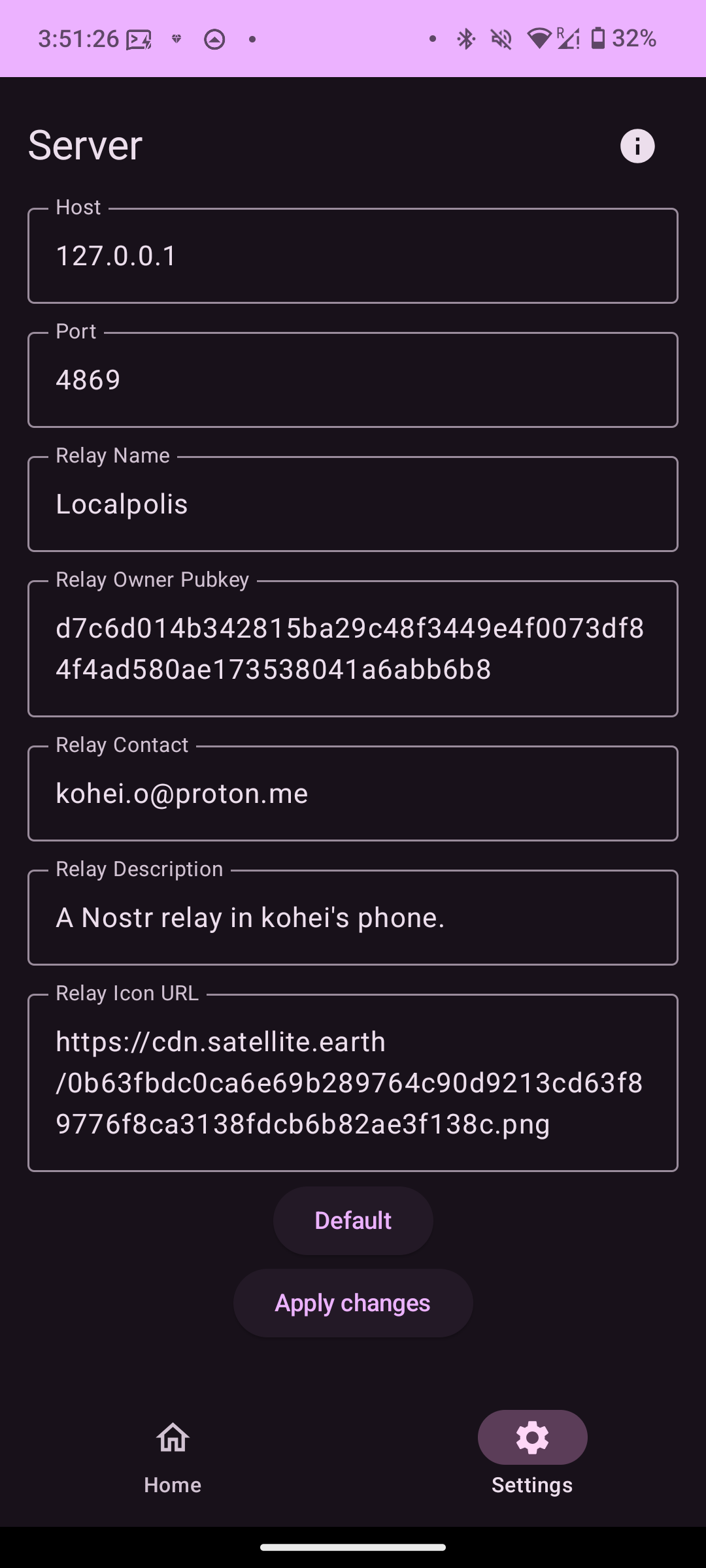
設定が終了したら、ローカルリレーを起動します。
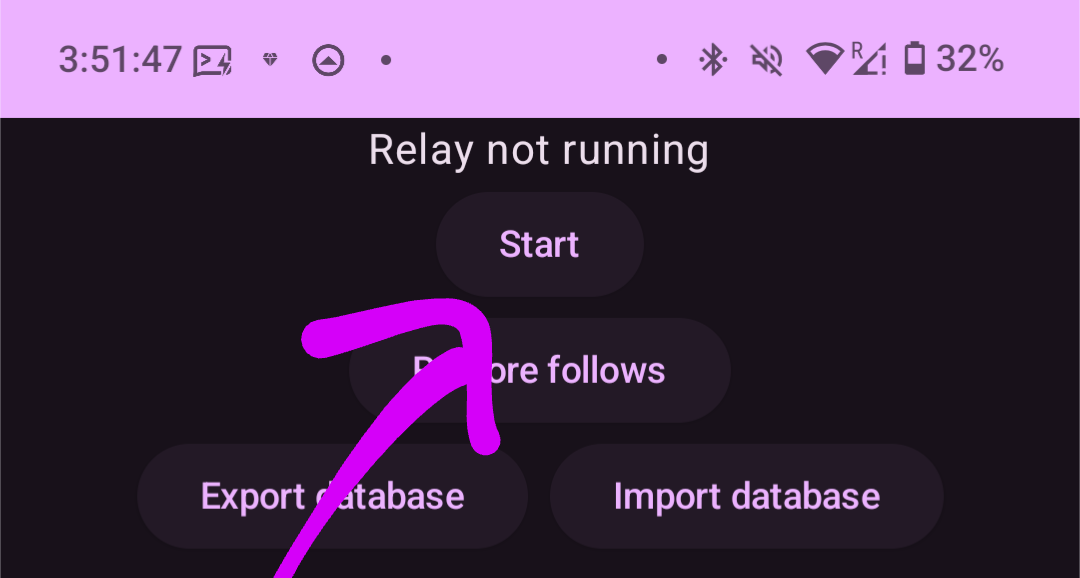
また、ここで表示されるポート番号をメモしてください。
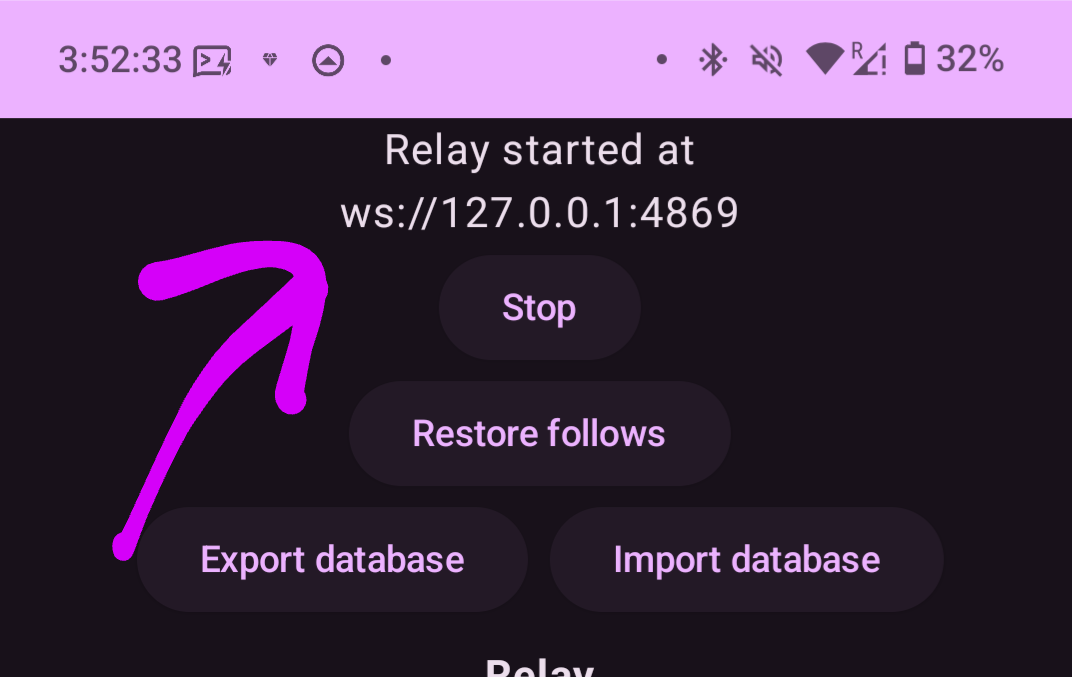
次に、More のタブに移り、Hosted Onion Services へアクセスし、Service Type の項目で User Services にチェックを入れて、右下の + マークをタップすると以下のポップアップが表示されます。(Orbot がスクショを許してくれないので一部画像割愛)
表示されたら、Name に任意の名前を、Local Port と Onion Port に先ほどメモした Citrine のポート番号を入力します。
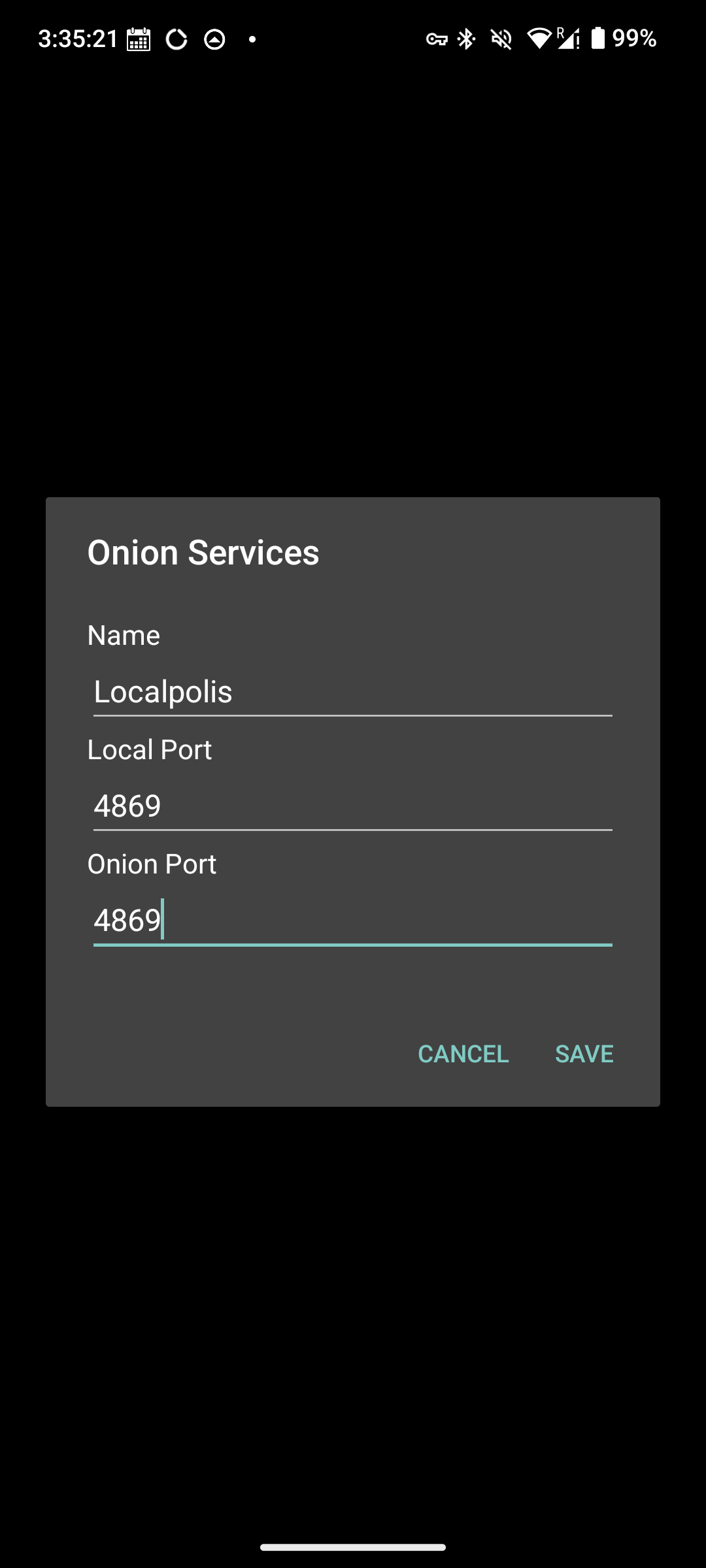
入力したら再起動を求められるので再起動してください。 再起動後に Hosted Onion Services の項目に .onion のアドレスが表示されたら成功です (何故か私の環境では、一回の再起動では設定が反映されなかったのですが、もし同じような現象が起きた場合は、再起動 -> Connect -> .onion アドレスが発行されてるかの確認、を数回試すと発行されるはずです)
発行されたら、.onion アドレスをタップしてクリップボードにコピーします。
次に、Amethyst を起動して、リレーの設定画面に入り、Outbox の設定にコピーした .onion アドレスを貼り付けて保存します。

後は、Amethyst 側で Orbot のポート番号を設定して Orbot に接続すれば BOOM! 設定完了です。
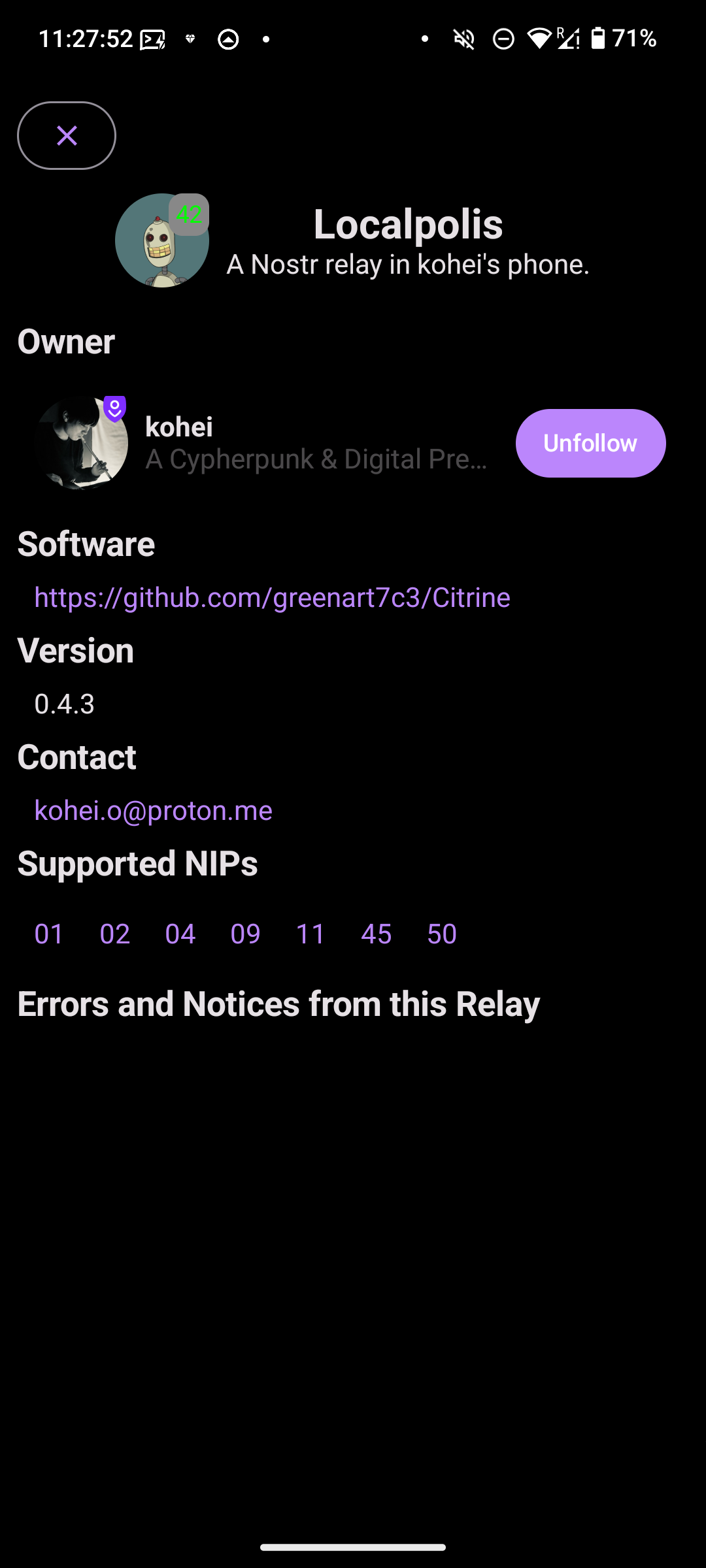
お疲れ様でした!
素敵な Nostr ライフを!
-
 @ 21ac2956:09d1e2df
2024-11-20 05:58:15
@ 21ac2956:09d1e2df
2024-11-20 05:58:15kakoi の仕様についてのメモ
キーボード操作
- 左手での操作に最適化
| キー | 動作 | |:-|:-| | ESC | 設定画面 | | F1 / F12 | ポストバーの表示と非表示 | | F2 | 時間の表示と非表示 | | F3 | ユーザーアイコンの表示と非表示 | | F4 | 名前の表示と非表示 | | F9 / Z | コンテンツの折り返し表示の切り替え (余白ダブルクリックでも動作) | | F10 | ユーザーリストとキーワード通知の設定画面 (余白右クリックでも動作) | | F11 | メイン画面の表示と非表示 (ポストバー表示) | | Shift + W | イベント最上行へ移動 | | W / ↑| イベント選択上移動 | | S / ↓ | イベント選択下移動 | | Shift + S | イベント最下行へ移動 | | A / ← | Webビューを開く (イベントを右クリックでも動作) | | F / → | リアクションを送信 (イベントをダブルクリックでも動作) | | 1 ~ 0 | リアクションを選択 | | R | 返信 | | B | リポスト | | Q | 引用 | | C | Webビューを閉じる | | Ctrl + Shift + A | メイン画面をアクティブにする |
タイムライン
- kind:1, 6, 7, 16を取得して表示する
- フォロイーの名前の前には * が付く
フォローリスト(kind:3)
-
参照のみで更新はしない
-
F10 で開くユーザーリストでユーザーを選択し petname セルをクリックすることで未フォローユーザーにもペットネームを設定可能(ローカル保存)
プロフィール(kind:0)
- F10 で開くユーザーリストでユーザーを選択し picture セルをクリックすることでユーザーのアイコン表示を変更可能(ローカル保存)
返信(NIP-10 kind:1)
- kakoi のタイムラインに流れるすべてのイベント種に返信可能とする
- スレッドを考慮せず、単一イベントへの単発返信とする
- e タグは marker と返信先 pubkey は設定していない。 relay-url には空文字を設定
json ["e", "返信先 event-id", ""]- p タグは 返信先 pubkey ひとつだけを指定
リポスト(NIP-18 kind:6 , 16)
- kakoi のタイムラインに流れるすべてのイベント種をリポスト可能
- kind:1はkind:6。その他はkind:16でリポストする
- e タグは relay-url に空文字を設定
json ["e", "リポスト元 event-id", ""]引用(NIP-18 kind:1)
- q タグは relay-url に空文字を設定
json ["q", "引用元 event-id", ""] -
 @ 6b0a60cf:b952e7d4
2024-11-17 07:02:11
@ 6b0a60cf:b952e7d4
2024-11-17 07:02:11ビットコインのウォレットは取引形態によって2種類に分かれます。
- オンチェーン(L1)
- 取引がブロックチェーンに刻まれるタイプ。時間がかかるし手数料が高い。
- ライトニングネットワーク(L2)
- ブロックチェーンに刻む前の少額決済を目的としたレイヤー。高速で手数料が安い。
NostrでZapを利用する場合はライトニングネットワーク(以下、LNと呼びます)のウォレットが使われますが、さらにその中でもZap対応/非対応で分かれることになります。
また、秘密鍵を誰が管理するかによっても2種類の呼び方に分かれます。
- カストディアル
- 秘密鍵をサービスの運営に預けるタイプ。
- ノンカストディアル/セルフカストディアル
- 秘密鍵(シードフレーズ)を自分で持っておくタイプ。
Nostrで人気があるWallet of Satoshi(以下、WoSと呼びます)はLNのカストディアルウォレットです。 今回はLNのセルフカストディアルウォレットであるPhoenixを使ってみて、その仕組みや注意点など、学んだことを記録したいと思います。
Phoenixでウォレットを作る場合、初回でシードフレーズ(12個の単語)が作られますので、大切に控えておきましょう。
WoSからPhoenixに送金してみる
メイン画面左下にあるReciaveからQRCode表示画面へ遷移します。そこでcopyボタンを押して
Lightning invoice(text)をコピーしましょう。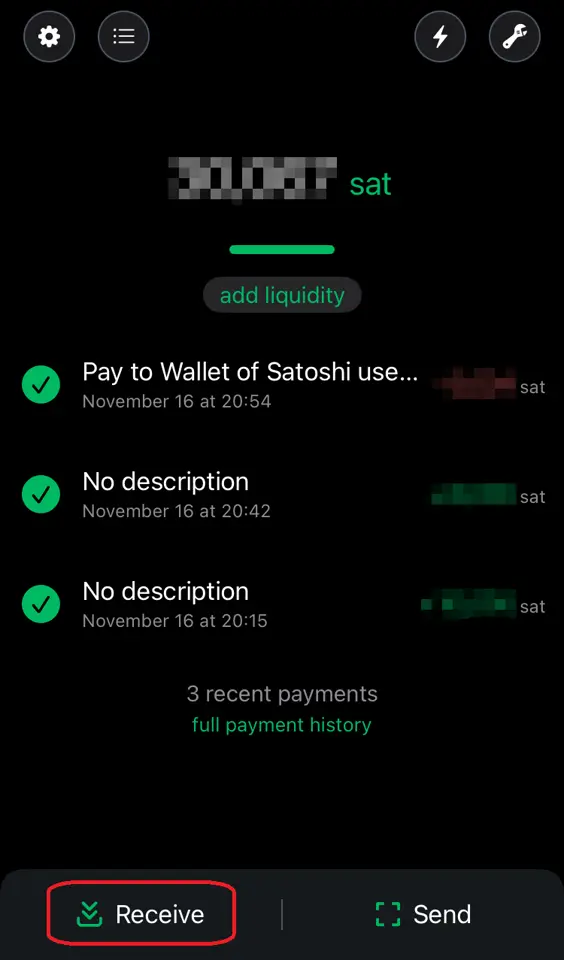
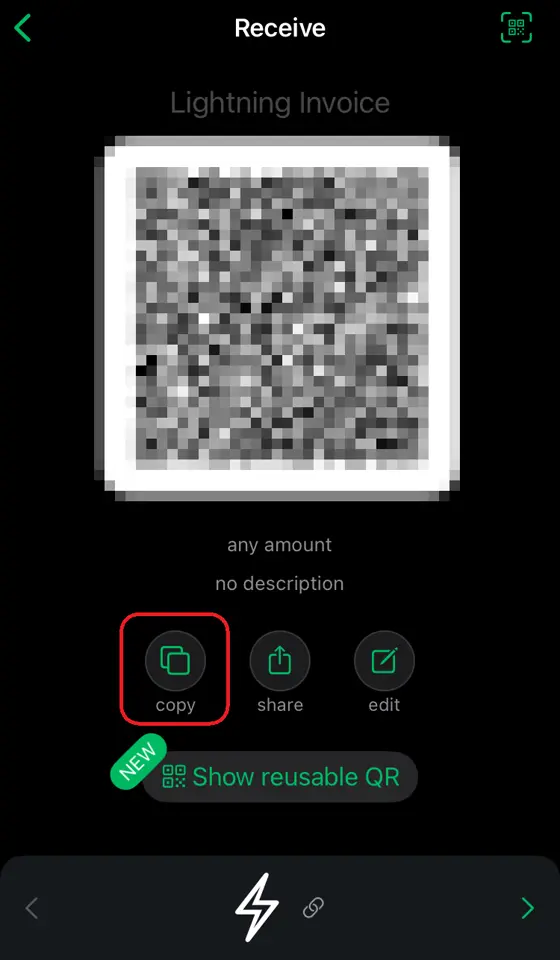
次に、WoSの画面からSendを選択し、クリップボードからの貼り付けを選択します。
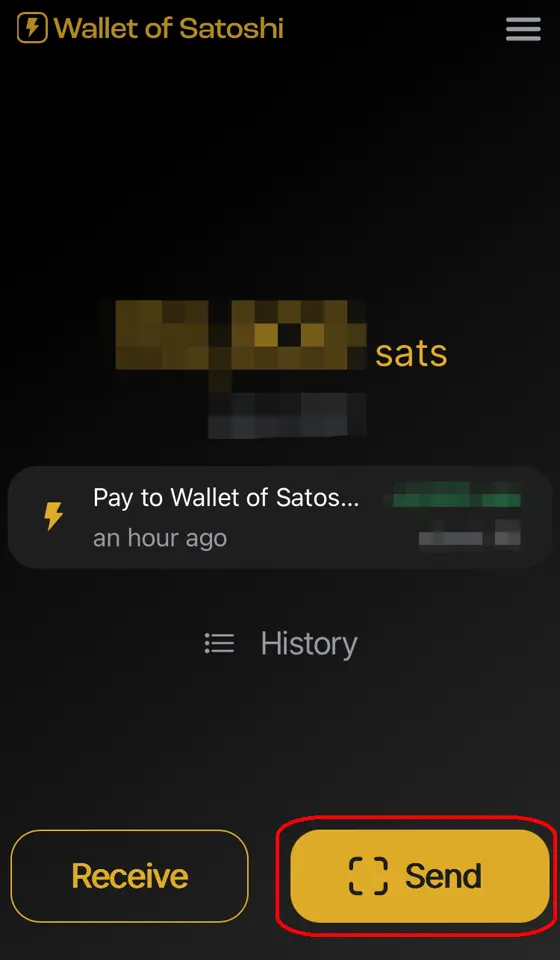
 金額を指定して送金します。
金額を指定して送金します。

送金した額が満額届いてないんだけど?

下の方に
Service Feesとありますが、これはPhoenix運営(ACINQ)へのお布施ですね。結構高く見えますが初回だけです。 またMiner Feesという項目は、mempoolのfeeに連動して変わるようですが、これはチャネルを太くする(送受信できる金額の上限を上げる)ために使われる手数料になります。財布が重たくなると手数料が取られる?
有り体に言えばそういうことになります。以下のように10,000satsをもらう度にチャネル拡張のための手数料が引かれています。
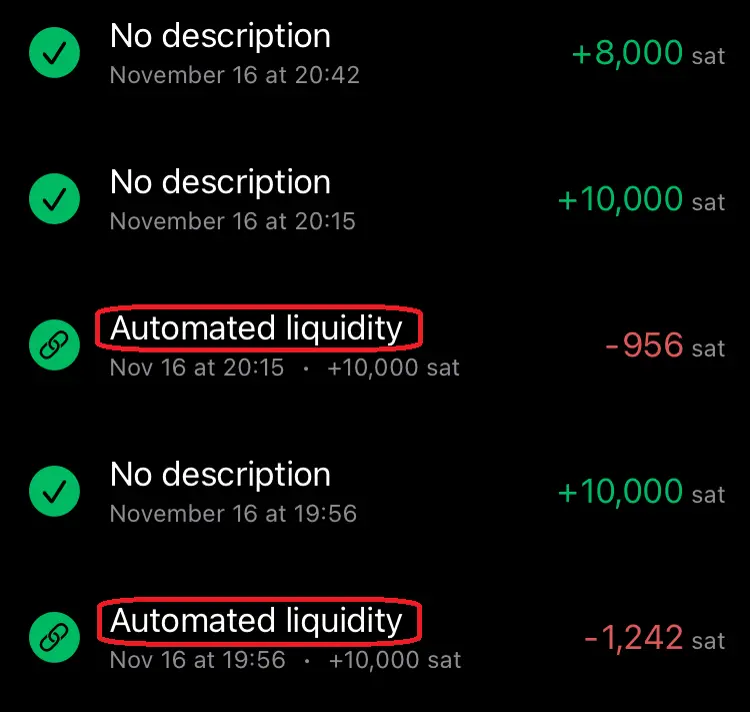
上記の8,000satsを受け取っている時には手数料が発生していませんね。これはチャネル拡張が必要ないギリギリの金額を狙って送金したためです。送金前は8,859satsの余裕がありました。送金後は1,719satsに減っています。(余裕分がぴったり8,000sats減るわけではないようです。このへんの仕組みはよくわかりません。) (画面は左上⚙️マークの設定からPayment channelsから。)


財布が軽くなると余裕が増える?
逆にPhoenixからWoSに5,000satsほど送金してみます。(手数料として24satsほど余計に抜かれました)
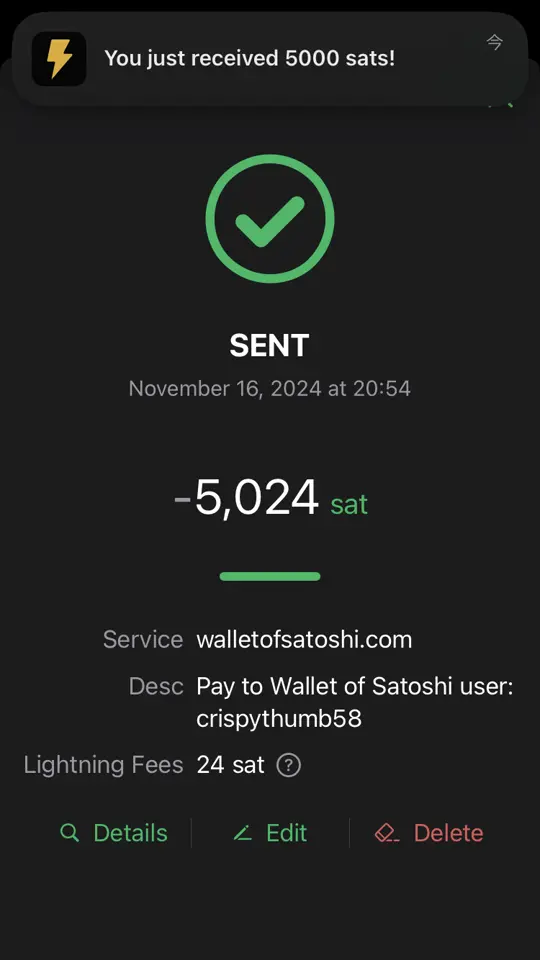

余裕(Inbound Liquidity)が5,883satsまで復活しています。受け取るばかりでなく、バランスよく送ることで財布を重たくしなければチャネル拡張せずに使い続けることができそうです。(太くしたチャネルは永遠に残るわけではなく、1年までらしいです)
自動でチャネル拡張にsatsを使われたくない!
自動チャネル拡張を設定で無効化できます。左上⚙️マークの設定から
Channel managementから。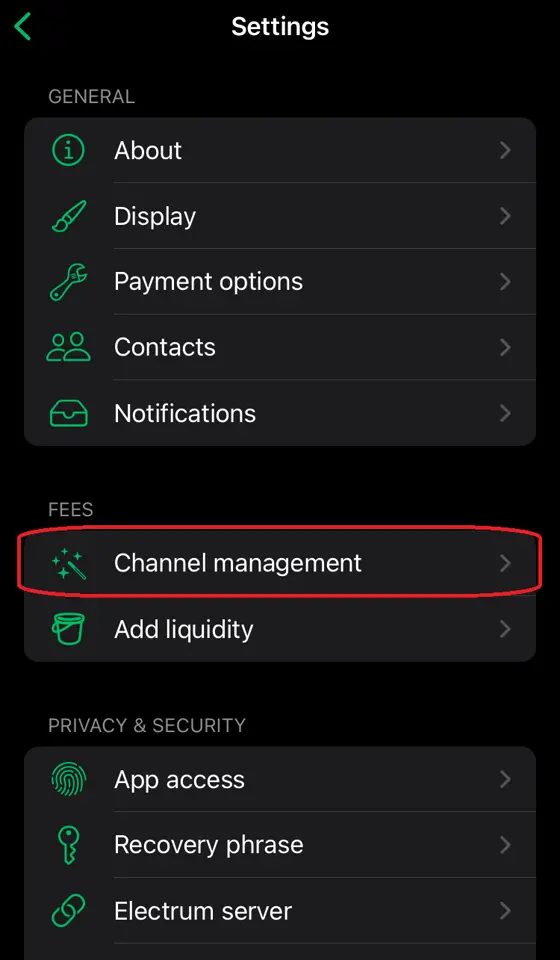

これでチャネル拡張が必要なほどの金額を送金しようとするとエラーになり失敗します。
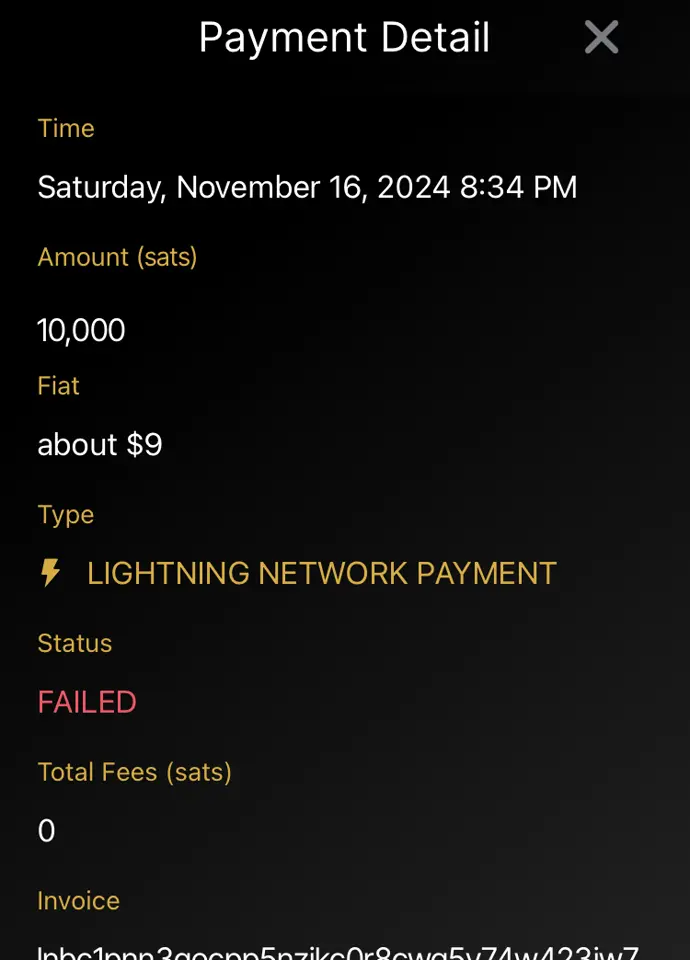
まとめ
セルフカストディアルウォレットならではの概念があり、謎の手数料が発生したりして怖いイメージがありましたが、どういう理由で手数料が発生するのかを知り、設定でのコントロールの仕方を習得することである程度怖いイメージを払拭することができました。 しかしカストディアルウォレット(特にWoS)の使いやすさを再認識することにもなりました。ただ自分で管理することの重要性も理解していますので、徐々に知識を深めていこうと思います。
参考/謝辞
- Phoenix wallet(フェニックスウォレット)の使い方!ビットコインのセルフカストディができるアプリを解説 - 知っとこ!ビットコイン図鑑
- nostr:npub10zeurmg22wc89l8m3npw9cyu45cun0lvs6w3ep69cdpa25pna65s0994qz 様
-
 @ bf47c19e:c3d2573b
2025-05-27 21:19:32
@ bf47c19e:c3d2573b
2025-05-27 21:19:32Originalni tekst na bitcoin-balkan.com.
Pregled sadržaja
- Procena vrednosti
- Većina Bitcoin-ovih pozitivnih strana opstaje
- Broj ljudi koji su prihvatili Bitcoin
- Zaključak
Prošlo je trinaest godina od nastanka Bitcoina i lako je poverovati da je većina njegovog rasta iza njega. Deo ovoga je rezultat predrasude koju svi delimo i što nas navodi da zamislimo trenutno stanje stvari kao završni stepen njegovog razvoja. Svaki bitcoiner je nekad mislio da je prekasan sa Bitcoin-om. Međutim, kada primenjujemo kritičko razmišljanje da bismo procenili gde je Bitcoin u svojoj putanji rasta, otkrivamo da je suprotno u stvari tačno: još uvek je vrlo, vrlo rano.
Postoje dva načina da razmišljate o tome koliko je rano za Bitcoin kao zalihu vrednosti neke imovine:
-
Procena vrednosti kao procenat od njegovog punog potencijala
-
Prihvatanje kao procenat od njegovog punog potencijala (na čemu je fokus u ovom članku).
Procena vrednosti
Prvi i najčešći način da se proceni koliko je rano za Bitcoin je da se pogleda njegova ukupna vrednost (trenutno oko 900B USD) i uporedi sa njegovim punim potencijalom. Izazov sa ovim je očigledno da je puni potencijal Bitcoin-a stvar nagađanja. Oni koji duboko razumeju Bitcoin imaju tendenciju da njegov potencijal posmatraju barem kao potencijal zlata (oko 13T USD), ali teoretski više poput 200T USD (oko polovine ukupne vrednosti sveta).
Za brzi pregled ovog potencijala od 200T USD, pogledajmo ukupno raspoloživo tržište Bitcoin-a. Radi jednostavnosti, samo ćemo razmotriti njegovu ulogu zalihe vrednosti i zanemariti njegov potencijal da pojede tržišni udeo od oko 100T USD ukupne vrednosti u različitim svetskim valutama. Uzimajući u obzir različite zalihe vrednosne imovine i grubom procenom koliki bi % Bitcoin mogao da uzme od njih, dobili smo ovakav rezultat:

Iako put do 200T USD nije veliko rastezanje, u stvarnoj vrednosti čini se previše dobrim da bi bio istinit. Sa obzirom da je bez presedana da zaliha vrednosti neke robe postigne vrednost veću od zlata, to jednostavno predstavlja neistraženu teritoriju. Ali čak i ako se jednostavno pridržavamo targetiranja niže ciljne vrednosti zlata od 13T USD, Bitcoin još uvek tendenciju velikog porasta svoje cene u budućnosti.
Većina Bitcoin-ovih pozitivnih strana opstaje
Svako ko razmišlja da nešto svog teško zarađenog novca uskladišti u Bitcoin pita se „da li sam poranio ili zakasnio?“ Nepisano je pravilo da se svako oseća kao da je zakasnio kad stigne. Brojni su primeri ljudi koji žale kako su zakasnili 2011. ili 2013. ili 2016. godine, kada je cena Bitcoin-a bila 5, 100, odnosno 600 USD.
Kao i u bilo kojoj zajednici koja se razvija i raste i u kojoj ima manjka nekretninama, pridošlice zavide ljudima koji su već obezbedili sebi nekretninu, ne sluteći da će njima zavideti ljudi koji tek treba da dođu. Ovaj fenomen je primenjiv i na velikom broju drugih primera. Na primer, zakasneli u Kalifornijskoj zlatnoj groznici bili su razočarani kada su došli, a bogata zlatna polja su već bila iscrpljena, i umesto toga su se naseliti na nekoliko stotina hektara zemljišta, a koje sada vrede bogatstvo.
U srcu ovog osećanja je strah da više nema uspona, da više nema novca koji se može zaraditi uzimajući ono što je još uvek ostalo dostupno. Da li smo dostigli tu tačku sa Bitcoin-om?
Pa ne. Čini se da je zapravo suprotno. Na osnovu punog potencijalnog opsega procene koji smo utvrdili gore, čak i u ishodu niskog nivoa (13T USD), velika većina bogatstva koje će steći vlasnici Bitcoin-a, tek treba da se stekne (96%). Da bi parirao proceni zlata, Bitcoin i dalje mora da poraste 26 puta.
A ako se desi vrhunski ishod, punih 99,7% ukupnog stvaranja bogatstva Bitcoin-a ostaje pred nama. To bi značilo da Bitcoin još uvek treba da poraste 400 puta, zanemarujući pariranje zlatu.
Stavljanjem trenutne vrednosti Bitcoin-a u perspektivu, postaje jasno da je za Bitcoin još uvek vrlo rano.
Iako ova analiza sugeriše da za Bitcoin-u ostaje od 26x do 400x rasta, korisno je proveriti ovaj zaključak kroz drugo razumno objašnjenje, a tamo gde je poznat puni potencijal…
Broj ljudi koji su prihvatili Bitcoin
Procene broja vlasnika Bitcoin-a širom sveta se veoma razlikuju. To je dovelo do prilične količine dvosmislenosti i nesigurnosti u vezi sa stvarnim brojevima i određenog stepena odustajanja i mišljenja da je taj broj jednostavno preteško precizno proceniti. Iako je teško utvrditi konačan broj, glavni razlog za odstupanje u procenama je nedostatak standardizovanih definicija šta znači prihvatanje Bitcoin-a.
Istina je da postoje različiti nivoi prihvatanja Bitcoin-a. Podelom na segmente prihvatanja Bitcoin-a lakše je uvideti ne samo zašto postoji širok opseg procena, već i još važnije, koliko je još uvek rano za prihvatanje Bitcoin-a kao preferirane zalihe vrednosti.
U ove svrhe, hajde da podelimo u segmente prihvatanje Bitcoin-a na četiri različita „nivoa“:
1. Kežual amateri (prstom u vodi)
2. Alokatori 1% (stopalima u vodi)
3. Značajni vernici (do pojasa u vodi)
4. Bitcoin maximalisti (u vodi preko glave)
Pre nego što počnemo, potreban nam je imenilac. Mogli bismo da koristimo globalno stanovništvo, ali po mom mišljenju ovo daje loše rezultate. Ono što mi zaista procenjujemo je koji procenat sveta koji poseduje odredjeno bogatstvo za skladištenje u Bitcoin-u, je to i učinio. Prema podacima sa sajta Statista, 2,2 biliona ljudi na svetu poseduje najmanje 10k USD u neto vrednosti, što se čini kao razumna granica za zalihu koju žele da uskladište. Činjenica je da će siromašne zajednice takođe koristiti Bitcoin kao zalihu vrednosti i verovatno će iz njega izvući veću korist kao rezultat marginalnog pristupa tradicionalnoj bankarskoj infrastrukturi kao klijenti banaka sa „niskom vrednošću“. Međutim, u naše svrhe, jednostavno gledamo koliko je ljudi usvojilo Bitcoin među grupama sa značajnim bogatstvom za skladištenje, tako da će 2.2 biliona služiti kao naša puna potencijalna veličina tržišta.
1. Kežual amateri
Ovaj segment ljudi koji su prihvatili Bitcoin uključuje sve one koji imaju bilo koju količinu Bitcoin-a – vašeg prijatelja sa 20 USD BTC-a negde u nekom novčaniku ili vašu tetku koja se ne seća svoje Coinbase lozinke iz 2017. Po mom mišljenju, najveća zabuna oko broja ljudi koji su prihvatili Bitcoin nastaje zbog poistovećivanja „kežual amatera“ sa ljudima koji su u potpunosti prihvatili Bitcoin. Realnost je takva da ljudi ovog segmenta uglavnom samo eksperimentišu, bilo da bi stekli osećaj za ono o čemu svi pričaju, ili samo uložu nekoliko dolara u Bitcoin u nadi da će možda dobiti džekpot, kao što je slučaj sa greb-greb nagradnim igrama.
Zbog toga, „kežual amateri“ su razlog dovodjenja u zabludu pravog broja ljudi koji su u potpunosti prihvatili Bitcoin. Njihovo ponašanje zapravo ne predstavlja prihvatanje u pravom smislu te reči i stoga se ne bi trebalo smatrati ljudima koji su u potpunosti prihvatili Bitcoin. Istina je da, kada kežual amateri shvate da je Bitcoin najbolja zaliha vrednosti neke imovine u istoriji, neće ostati na samo 20 USD u Bitcoin-ima. Umesto toga, oni će svoju štednju prebaciti u mnogo većim iznosima.
Što se tiče odredjivanja veličine ovog segmenta, Willy Woo je sastavio razumno iscrpnu i sveobuhvatnu procenu od oko 187 miliona ljudi koji su prihvatili Bitcoin, što znači da su oni u najmanju ruku „kežual amateri“.
Koristeći ovaj i naš puni potencijal od 2,2 biliona ljudi kao imenioca, 8,5% potencijalnih ljudi koji su prihvatili Bitcoin-e dostiglo je nivo „kežual amatera“. Ovo je prilično velik broj i potpuno obmanjuje stvarni obim potpunog prihvatanja, a što će pokazati sledeći segmenti.
2. Alokatori 1%
Za preostale potkategorije, tačni podaci su manje dostupni. Kao takvi, sve što možemo je da smislimo razumne procene putem triangulacije.
Po mom mišljenju, „alokatori 1%“ se mogu okarakterisati kao ljudi koji su prihvatili Bitcoin, i koji žele da imaju mali, ali ne i zanemarljivi deo u Bitcoin-u. Za naše svrhu, mislim da je pristojan prag za ovu grupu svako ko ima najmanje 0,1 Bitcoin, i može se smatrati da imaju malu, ali ne i zanemarljivu poziciju u Bitcoin-u.
Gledajući Bitcoin blockchain, postoji oko 3 miliona adresa koje imaju najmanje 0,1 BTC. Pored ovih brojeva na blockchain-u, moramo da uzmemo u obzir i znatan broj ljudi koji imaju ovaj iznos na berzi ili GBTC-u. Kombinovanjem, mislim da je razumno proceniti da je 10 miliona ljudi dostiglo nivo „alokatora 1%“ ili veći.
Na osnovu ovih brojeva, samo 1⁄17 „kežual amatera“ dostiglo je nivo prihvatanja „alokatora 1%“, što znači da je ovaj nivo prihvatanja Bitcoin-a do danas postigao samo 0,5% penetracije. Ovaj strmi pad je razlog zašto je došlo do zablude da veliki broj „kežual amatera“ bude označeno kao grupa koja je u potpunosti prihvatila Bitcoin.
3. Značajni vernici
U ovu kategoriju spada svako ko je dostigao nivo razumevanja Bitcoin-a da alokacija od 1% ili čak 5% više ne izgleda dovoljna.
Uopšteno govoreći, ova grupa se kreće u rasponu od 5 – 50%. Išao bih toliko daleko da bih rekao da je većina ljudi koji sebe smatraju vernicima u Bitcoin-e, uključujući većinu Bitcoin Twitter-a, negde u ovoj grupi.
Procena veličine ove grupe postaje mnogo nejasnija, ali možemo se osloniti na podatke iz blockchain-a da bismo došli do razumne procene.
Za početak, hajde da utvrdimo da je većina ljudi koji su dostigli ovaj nivo verovanja i razumevanja Bitcoin-a, izborila da poseduje najmanje 1 Bitcoin. Pored toga, ovaj nivo ljudi koji su prihvatili Bitcoin je verovatno osigurao svoj Bitcoin u chain-u novčanika kojim oni upravljaju. Gledajući podatke na chain-u, oko 820k adresa ima najmanje 1 Bitcoin. Kao grubu pretpostavku, uzmimo da 500k od toga poseduju ljudi koji su dostigli nivo prihvatanja „značajnog vernika“.
Ako potom generički zaokružimo akaunte za ljude koji nisu postigli status wholecoiner-a (eng. osoba koja poseduje barem 1 BTC), ili koji svoja sredstva drže na berzi, dolazimo do grube procene od 2 miliona „značajnih vernika“.
4. Bitcoin maximalisti
Za našu svrhu, recimo da ova grupa uključuje svakoga ko je dovoljno duboko ušao u Bitcoin da je zaključio da bi više od 50% njihove neto vrednosti trebalo da bude uskladišteno u Bitcoin-u.
Procena veličine ove grupe je gotovo nemoguća, zato ćemo morati da budemo kreativni.
-
Prodaja „Bitcoin Standard“
-
Hajde da konzervativno procenimo da je samo 20% maximalističara kupilo Bitcoin Standard, i da je 50% tih ljudi koji su ga razumeli, postali maksimalisti. Na osnovu knjige Amazon US rank (6,681), onlajn kalkulatori procenjuju da je prodato oko 15k primeraka.
- Hajde da budemo velikodušni i da zaokružimo taj broj od oko 15k na 50k, uzimajući u obzir međunarodnu prodaju i kupovinu izvan Amazona.
Ovo nas dovodi do procene broja od 125k maximalista. Da ne bismo pogrešili, bićemo oprezni, i udvostručimo taj broj i rećićemo da ih ima 250k.
- Kvalitativna triangulacija
Čisto subjektivno, ali čini mi se da na Twitter-u, primarnom domu za komunikaciju maximalista, postoji možda 10k aktivno angažovanih Bitcoin maximalista. Da budemo vrlo konzervativni, recimo da ovo predstavlja oko 5% maximalista (od ukupno 200k).
Uz to, kao procenu od vrha nadole, čini se opravdanim da je oko 10% ljudi koji su dostigli 5 – 50% alokacije Bitcoin-a napravilo skok ka maximalizmu.
Sve u svemu, cifra od oko 250k Bitcoin maximalista čini se konzervativnom, ako ne i velikodušnom pretpostavkom.
To nas dovodi do 0,01% penetracije.
Zaključak
Kako god gledali brojke, još uvek je rano za Bitcoin. Posmatrajući procenu vrednosti Bitcoin-a kao procenat njegovog punog potencijala, vidimo da je trenutna vrednost Bitcoin-a negde između 0,2% i 3% njegovog krajnjeg stanja, što znači da ostaje 30x do 500x rasta. Gledajući napredak prihvatanja Bitcoin-a, vidimo da je trenutna penetracija Bitcoin-a negde između 0,01% i 8,5%, u zavisnosti od toga koji prag prihvatanja gledate.
Ako verujete, kao što ja verujem, da je Bitcoin na putu da postane dominantna zaliha vrednosti i preferirani novac za ceo svet, na kraju će norma biti više od 50% posedovanja neto vrednosti u Bitcoin-u. Budući da naša analiza ovde sugeriše da samo 0,01% sveta zadovoljava ove standarde, opravdano je zaključiti da 99,99% sveta ostaje da sledi njihov primer.
Sve u svemu, dok svi koji se pojave na Bitcoin-u neizbežno osećaju žaljenje zbog toga što nisu ranije investirali i pitaju se da li su u potpunosti propustili brod, jasno je da većina rasta Bitcoin-a ostaje pred nama. Da stavimo ovo u neki kontekst, obzirom da može postojati samo 21 milion Bitcoin-a, prosečna osoba na zemlji (od 8 biliona ljudi) imaće samo 0,0025 Bitcoin-a. Još je toliko rano, da ukupna neto vrednost te prosečne osobe u Bitcoin-u može da se kupi za samo 90 USD.
I ako mislite da je kasno, zapravo je veoma rano, zato vam čestitam i uživajte u skupljanju sats-ova dok su još uvek ovako jeftini!
-
 @ ec42c765:328c0600
2024-10-21 07:42:48
@ ec42c765:328c0600
2024-10-21 07:42:482024年3月
フィリピンのセブ島へ旅行。初海外。

Nostrに投稿したらこんなリプライが
nostr:nevent1qqsff87kdxh6szf9pe3egtruwfz2uw09rzwr6zwpe7nxwtngmagrhhqc2qwq5
nostr:nevent1qqs9c8fcsw0mcrfuwuzceeq9jqg4exuncvhas5lhrvzpedeqhh30qkcstfluj
(ビットコイン関係なく普通の旅行のつもりで行ってた。というか常にビットコインのこと考えてるわけではないんだけど…)
そういえばフィリピンでビットコイン決済できるお店って多いのかな?
海外でビットコイン決済ってなんかかっこいいな!
やりたい!
ビットコイン決済してみよう! in セブ島
BTCMap でビットコイン決済できるところを探す
本場はビットコインアイランドと言われてるボラカイ島みたいだけど
セブにもそれなりにあった!

なんでもいいからビットコイン決済したいだけなので近くて買いやすい店へ
いざタピオカミルクティー屋!

ちゃんとビットコインのステッカーが貼ってある!

つたない英語とGoogle翻訳を使ってビットコイン決済できるか店員に聞いたら
店員「ビットコインで支払いはできません」
(えーーーー、なんで…ステッカー貼ってあるやん…。)
まぁなんか知らんけどできないらしい。
店員に色々質問したかったけど質問する英語力もないのでする気が起きなかった
結局、せっかく店まで足を運んだので普通に現金でタピオカミルクティーを買った
タピオカミルクティー
話題になってた時も特に興味なくて飲んでなかったので、これが初タピオカミルクティーになった
法定通貨の味がした。

どこでもいいからなんでもいいから
海外でビットコイン決済してみたい
ビットコイン決済させてくれ! in ボラカイ島
ビットコインアイランドと呼ばれるボラカイ島はめちゃくちゃビットコイン決済できるとこが多いらしい
でもやめてしまった店も多いらしい
でも300もあったならいくつかはできるとこあるやろ!
nostr:nevent1qqsw0n6utldy6y970wcmc6tymk20fdjxt6055890nh8sfjzt64989cslrvd9l
行くしかねぇ!
ビットコインアイランドへ
フィリピンの国内線だぁ

``` 行き方: Mactan-Cebu International Airport ↓飛行機 Godofredo P. Ramos Airport (Caticlan International Airport, Boracay Airport) ↓バスなど Caticlan フェリーターミナル ↓船 ボラカイ島
料金: 飛行機(受託手荷物付き) 往復 21,000円くらい 空港~ボラカイ島のホテルまで(バス、船、諸経費) 往復 3,300円くらい (klookからSouthwest Toursを利用)
このページが色々詳しい https://smaryu.com/column/d/91761/ ```
空港おりたらSouthwestのバスに乗る
事前にネットで申し込みをしている場合は5番窓口へ

港!

船!(めっちゃ速い)

ボラカイついた!

ボラカイ島の移動手段
セブの移動はgrabタクシーが使えるがボラカイにはない。
ネットで検索するとトライシクルという三輪タクシーがおすすめされている。
 (トライシクル:開放的で風がきもちいい)
(トライシクル:開放的で風がきもちいい)トライシクルの欠点はふっかけられるので値切り交渉をしないといけないところ。
最初に300phpくらいを提示され、行き先によるけど150phpくらいまでは下げられる。
これはこれで楽しい値切り交渉だけど、個人的にはトライシクルよりバスの方が気楽。
Hop On Hop Off バス:
https://www.hohoboracay.com/pass.php
一日乗り放題250phpなので往復や途中でどこか立ち寄ったりを考えるとお得。
 バスは現金が使えないので事前にどこかでカードを買うか車内で買う。
バスは現金が使えないので事前にどこかでカードを買うか車内で買う。私は何も知らずに乗って車内で乗務員さんから現金でカードを買った。
バスは狭い島内を数本がグルグル巡回してるので20~30分に1本くらいは来るイメージ。
逆にトライシクルは待たなくても捕まえればすぐに乗れるところがいいところかもしれない。
現実
ボラカイ島 BTC Map
 BTC決済できるとこめっちゃある
BTC決済できるとこめっちゃあるさっそく店に行く!
「bitcoin accepted here」のステッカーを見つける!
店員にビットコイン支払いできるか聞く!
できないと言われる!
もう一軒行く
「bitcoin accepted here」のステッカーを見つける
店員にビットコイン支払いできるか聞く
できないと言われる
5件くらいは回った
全部できない!
悲しい
で、ネットでビットコインアイランドで検索してみると
旅行日の一か月前くらいにアップロードされた動画があったので見てみた
要約 - ビットコイン決済はpouch.phというスタートアップ企業がボラカイ島の店にシステムを導入した - ビットコインアイランドとすることで観光客が10%~30%増加つまり数百~千人程度のビットコインユーザーが来ると考えた - しかし実際には3~5人だった - 結果的に200の店舗がビットコイン決済を導入しても使われたのはごく一部だった - ビットコイン決済があまり使われないので店員がやり方を忘れてしまった - 店は関心を失いpouchのアプリを消した
https://youtu.be/uaqx6794ipc?si=Afq58BowY1ZrkwaQ
なるほどね~
しゃあないわ
聖地巡礼
動画内でpouchのオフィスだったところが紹介されていた
これは半年以上前の画像らしい

現在はオフィスが閉鎖されビットコインの看板は色あせている
 おもしろいからここに行ってみよう!となった
おもしろいからここに行ってみよう!となったで行ってみた
看板の色、更に薄くなってね!?

記念撮影
 これはこれで楽しかった
これはこれで楽しかった場所はこの辺
https://maps.app.goo.gl/WhpEV35xjmUw367A8
ボラカイ島の中心部の結構いいとこ
みんな~ビットコイン(の残骸)の聖地巡礼、行こうぜ!
最後の店
Nattoさんから情報が
なんかあんまりネットでも今年になってからの情報はないような…https://t.co/hiO2R28sfO
— Natto (@madeofsoya) March 22, 2024
ここは比較的最近…?https://t.co/CHLGZuUz04もうこれで最後だと思ってダメもとで行ってみた なんだろうアジア料理屋さん?

もはや信頼度0の「bitcoin accepted here」

ビットコイン払いできますか?
店員「できますよ」
え?ほんとに?ビットコイン払いできる?
店員「できます」
できる!!!!
なんかできるらしい。
適当に商品を注文して
印刷されたQRコードを出されたので読み取る
ここでスマートに決済できればよかったのだが結構慌てた
自分は英語がわからないし相手はビットコインがわからない
それにビットコイン決済は日本で1回したことがあるだけだった
 どうもライトニングアドレスのようだ
どうもライトニングアドレスのようだ送金額はこちらで指定しないといけない
店員はフィリピンペソ建ての金額しか教えてくれない
何sats送ればいいのか分からない
ここでめっちゃ混乱した
でもウォレットの設定変えればいいと気付いた
普段円建てにしているのをフィリピンペソ建てに変更すればいいだけだった
設定を変更したら相手が提示している金額を入力して送金
送金は2、3秒で完了した
やった!
海外でビットコイン決済したぞ!
ログ

PORK CHAR SIU BUN とかいうやつを買った
 普通にめっちゃおいしかった
普通にめっちゃおいしかったなんかビットコイン決済できることにビビッて焦って一品しか注文しなかったけどもっと頼めばよかった
ここです。みなさん行ってください。
Bunbun Boracay
https://maps.app.goo.gl/DX8UWM8Y6sEtzYyK6
めでたしめでたし
以下、普通の観光写真
セブ島
ジンベエザメと泳いだ

スミロン島でシュノーケリング

市場の路地裏のちょっとしたダウンタウン?スラム?をビビりながら歩いた

ボホール島
なんか変な山

メガネザル

現地の子供が飛び込みを披露してくれた

ボラカイ島
ビーチ


夕日

藻

ボラカイ島にはいくつかビーチがあって宿が多いところに近い南西のビーチ、ホワイトビーチは藻が多かった(時期によるかも)
北側のプカシェルビーチは全然藻もなく、水も綺麗でめちゃくちゃよかった

プカシェルビーチ



おわり!
-
 @ 6be5cc06:5259daf0
2025-05-27 20:37:22
@ 6be5cc06:5259daf0
2025-05-27 20:37:22At
até uma ferramenta de agendamento de tarefas em Linux usada para executar comandos únicos em um horário e data específicos. Diferente docron, que serve para tarefas recorrentes, oatexecuta uma única vez.Como usar o
at1. Verifique se o
atestá instaladobash which atSe não estiver instalado:
bash sudo apt install atE inicie o serviço (caso necessário):
bash sudo systemctl enable --now atd2. Agendar um comando
bash at 10:00 AM tomorrowVocê será levado a um prompt interativo. Digite o comando desejado e finalize com
Ctrl + D.Exemplo 1:
bash at 09:00 AM next Monday(Entrada do usuário no prompt do
at)echo "Relatório pronto" >> ~/relatorio.txt Ctrl + DResultado: O trecho "relatório pronto" será incluído no documento relatorio.txt.
Exemplo 2:
bash at 21:00 Apr 15Entrada no prompt:
notify-send "Hora de fazer backup!" Ctrl + DResultado: Às 21h do dia 15 de abril, o sistema exibirá uma notificação.
Formatos de Data e Hora Válidos
-
now + 1 minute -
midnight -
tomorrow -
5pm -
08:30 -
7:00am next friday -
noon + 2 days
Visualizar tarefas agendadas
bash atqRemover uma tarefa agendada
bash atrm <número_da_tarefa>Você encontra o número da tarefa com
atq.
cron
O
croné um utilitário de agendamento de tarefas baseado no tempo. Permite executar comandos ou scripts automaticamente em horários específicos. Ele depende do daemoncrond, que deve estar ativo e em execução contínua no sistema.Arquivo de configuração:
-
Cada usuário pode editar seu próprio agendador com:
bash crontab -e -
O formato padrão de uma linha no crontab:
m h dom mon dow comando
|Campo|Descrição|Valores possíveis| |---|---|---| |m|Minuto|0–59| |h|Hora|0–23| |dom|Dia do mês|1–31| |mon|Mês|1–12| |dow|Dia da semana|0–6 (0 = Domingo)| |comando|Comando a executar|Qualquer comando shell válido|
Exemplos:
-
Executar um script a cada minuto:
bash * * * * * /usr/local/bin/execute/this/script.sh -
Fazer backup no dia 10 de junho às 08:30:
bash 30 08 10 06 * /home/sysadmin/full-backup -
Backup todo domingo às 5h da manhã:
bash 0 5 * * 0 tar -zcf /var/backups/home.tgz /home/
Limitações:
Tarefas agendadas com
cronnão são executadas se o computador estiver desligado ou suspenso no horário programado. O comando é simplesmente ignorado. Usecronpara tarefas com data/hora exatas.
anacron
O
anacroné uma alternativa aocronvoltada para sistemas que não ficam ligados o tempo todo, como notebooks e desktops. Ele garante a execução de tarefas periódicas (diárias, semanais, mensais) assim que possível após o sistema ser ligado, caso tenham sido perdidas. Useanacronpara tarefas periódicas tolerantes a atrasos.Verificação da instalação:
bash anacron -VInstalação (caso necessário):
bash sudo apt update sudo apt install anacronArquivo de configuração:
/etc/anacrontabAcessado com:
sudo nano /etc/anacrontabFormato de cada linha:
PERIOD DELAY IDENT COMMAND| Campo | Descrição | | ------- | ------------------------------------------- | | PERIOD | Intervalo em dias (1 = diário, 7 = semanal) | | DELAY | Minutos a esperar após o boot | | IDENT | Nome identificador da tarefa | | COMMAND | Comando ou script a ser executado |
Exemplo:
bash 1 3 limpeza-temporarios /home/usuario/scripts/limpar_tmp.shExecuta o script uma vez por dia, 3 minutos após o sistema ser ligado.
Nota: Não é necessário usar
run-partsnemcron.dailypara tarefas personalizadas. Basta apontar diretamente para o script desejado. Orun-partssó deve ser usado quando se deseja executar todos os scripts de um diretório.Ativação do serviço:
bash sudo systemctl enable --now anacronVerificação de status:
bash systemctl status anacronLogs de execução:
bash grep anacron /var/log/syslog/etc/anacrontab: Arquivo de Configuração doanacronO arquivo
/etc/anacrontabdefine tarefas periódicas a serem executadas peloanacron, garantindo que comandos sejam executados mesmo que o computador esteja desligado no horário originalmente programado.Cabeçalho Padrão
bash SHELL=/bin/sh HOME=/root LOGNAME=root-
SHELL: Shell padrão utilizado para executar os comandos. -
HOME: Diretório home usado durante a execução. -
LOGNAME: Usuário associado à execução das tarefas.
Entradas Padrão do Sistema
bash 1 5 cron.daily run-parts --report /etc/cron.daily 7 10 cron.weekly run-parts --report /etc/cron.weekly @monthly 15 cron.monthly run-parts --report /etc/cron.monthly|Campo|Significado| |---|---| |
1|Executa a tarefa diariamente (a cada 1 dia)| |5|Espera 5 minutos após o boot| |cron.daily|Identificador da tarefa (usado nos logs)| |run-parts|Executa todos os scripts dentro do diretório|Diretórios utilizados:
-
/etc/cron.daily: scripts executados uma vez por dia -
/etc/cron.weekly: scripts semanais -
/etc/cron.monthly: scripts mensais
O comando
run-partsexecuta automaticamente todos os scripts executáveis localizados nesses diretórios.Personalização
Para adicionar tarefas personalizadas ao
anacron, basta adicionar novas linhas com o formato:PERIOD DELAY IDENT COMMANDExemplo:
bash 1 3 limpeza-temporarios /home/usuario/scripts/limpar_tmp.shExecuta o script
limpar_tmp.shdiariamente, com 3 minutos de atraso após o boot.Importante: Não é necessário — nem recomendado — usar
run-partsquando a intenção é executar um script individual. Orun-partsespera um diretório e ignora arquivos individuais. Usarrun-partscom um script individual causará falha na execução. -
-
 @ 6bcc27d2:b67d296e
2024-10-21 03:54:32
@ 6bcc27d2:b67d296e
2024-10-21 03:54:32yugoです。 この記事は「Nostrasia2024 逆アドベントカレンダー」10/19の分です。Nostrasiaの当日はリアルタイムで配信を視聴していました。Nostrを使ってアプリケーションの再発明をすべきという発表を聴き、自分だったらどんなものを作ってみたいかを考えて少し調べたり試みたりしたのでその記録を書きます。また、超簡単なものですがおそらく世界初となるvisionOS対応のNostrクライアントをつくってみたので最後の方に紹介します。
アプリケーションを再発明する話があったのは、「What is Nostr Other Stuff?」と題したkaijiさんの発表でした。
Nostrプロトコルを使って既存のアプリケーションを再発明することで、ユーザ体験を損なわずにゆるやかな分散を促すことができ、プロトコルとしてのNostrも成長していくというような内容でした。
自分はまだNostrで何かをつくった経験はなかったので、実装に必要な仕様の知識がほとんどない状態からどのようなアプリケーションをつくってみたいかを考えました。
最初に思いついたのは、Scrapboxのようなネットワーク型のナレッジベースです。自分は最近visionOS勉強会をやっており、勉強会でナレッジを共有する手段としてScrapboxの導入を検討していました。
Nostrコミュニティにも有志によるScrapboxがありますが、Nostrクライアントがあればそれを使うだろうから同じくらいの実用性を備えたクライアントはまだ存在しないのではないかという見立てでした。
長文投稿やpublic chatなどの機能を組み合わせることで実現できるだろうか。そう思っていた矢先、NIP-54のWikiという規格があることを知りました。
https://github.com/nostr-protocol/nips/blob/master/54.md
まだちゃんとは読めていないですが、Scrapboxもwikiソフトウェアだし参考になりそうと思っています。正式な仕様に組み込まれていないようで、採用しているクライアントはfiatjafによるリファレンス実装(?)のwikistrくらいしか見つかりませんでした。
Scrapboxのようなナレッジベースを志向するNostrクライアントがあれば、後述するvisionOS対応クライアントの存在もありアカウントを使いまわせて嬉しいので試してみたいです。もし他にも似たようなサービスをどなたか知っていたら教えてください。
また現在は、勉強会やワークショップ、ハッカソンなどのコラボレーションワークを支援するためのツールを自分たちでも開発しています。Apple Vision Proに搭載されているvisionOSというプラットフォームで動作します。
https://image.nostr.build/14f0c1b8fbe5ce7754825c01b09280a4c22f87bbf3c2fa6d60dd724f98919c34.png
この画面で自分が入りたいスペースを選んで共有体験を開始します。
スライドなどのコンテンツや自らのアバターを同期させることで、遠隔地にいてもまるでオフラインかのように同じ空間を共有することが可能になります。
https://image.nostr.build/cfb75d3db2a9b9cd39f502d6426d5ef4f264b3d5d693b6fc9762735d2922b85c.jpg
ということなので、急遽visionOS対応のクライアントを作ってみました。検索しても1つも事例が出てこなかったので多分まだ世界で実装しているアプリはないのではないでしょうか。
とはいえ、クライアントを名乗っているもののまだ大した機能はなく、リレーからデータを取得するだけの読み取り専用です。
https://image.nostr.build/96e088cc6a082528682989ccc12b4312f9cb6277656e491578e32a0851ce50fe.png
画像では自分のプロフィールデータをリレーから取得しています。
まだどのライブラリもvisionOSに対応していなかったりで手こずったものの仕様の勉強になりました。
ただvisionOSアプリはiOSアプリ同様NIP-7が使えないので秘密鍵を自分で保管しなくてはならず、今後どう対処すべきかわかりかねています。これから時間ある時に少しずつ調べていこうと思っていますが、ネイティブアプリの秘密鍵周りはあまりリソースが多くないようにも感じました。もしどなたかその辺の実装に詳しい方いたら教えていただけると嬉しいです。
準備ができたらそのうちコードも公開したいと思っています。
これから少しずつ色んな機能を実装しながらNostrで遊んでいきたいです!
-
 @ bf47c19e:c3d2573b
2025-05-27 20:23:48
@ bf47c19e:c3d2573b
2025-05-27 20:23:48Originalni tekst na bitcoin-balkan.com.
Pregled sadržaja
- Šta je Bitcoin?
- Šta Bitcoin može da učini za vas?
- Zašto ljudi kupuju Bitcoin?
- Da li je vaš novac siguran u dolarima, kućama, akcijama ili zlatu?
- Šta je bolje za štednju od dolara, kuća i akcija?
- Po čemu se Bitcoin razlikuje od ostalih valuta?
- kako Bitcoin spašava svet?
- Kako mogu da saznam više o Bitcoin-u?
Bitcoin čini da štednja novca bude kul – i praktična – ponovo. Ovaj članak objašnjava kako i zašto.
Šta je Bitcoin?
Bitcoin se naziva digitalno zlato, mašina za istinu, blockchain, peer to peer mreža čvorova, energetski ponor i još mnogo toga. Bitcoin je, u stvari, sve ovo. Međutim, ova objašnjenja su često toliko tehnička i suvoparna, da bi većina ljudi radije gledala kako trava raste. Što je najvažnije, ova objašnjenja ne pokazuju kako Bitcoin ima bilo kakve koristi za vas.
iPod nije postao kulturološka senzacija jer ga je Apple nazvao „prenosnim digitalnim medijskim uređajem“. Postao je senzacija jer su ga zvali “1,000 pesama u vašem džepu.”
Ne zanima vas šta je Bitcoin. Vas zanima šta on može da učini za vas.
Baš kao i Internet, vaš auto, vaš telefon, kao i mnogi drugi uređaji i sistemi koje svakodnevno koristite, vi ne treba da znate šta je Bitcoin ili kako to funkcioniše da biste razumeli šta on može da učini za vas.
Šta Bitcoin može da učini za vas?
Bitcoin može da sačuva vaš teško zarađeni novac.
Bitcoin je stekao veliku pažnju u 2017. i 2018. godini zbog svoje spekulativne upotrebe. Mnogi ljudi su ga kupili nadajući se da će se obogatiti. Cena je naglo porasla, a zatim se srušila. Ovo nije bio prvi put da je Bitcoin uradio to. Međutim, niko nikada nije izgubio novac držeći bitcoin duže od 3,5 godine – ćak i ako je kupio na apsolutnim vrhovima.
Zašto Bitcoin konstantno raste? Ljudi počinju da shvataju koliko je Bitcoin moćan, kao način uštede novca u svetu u kojem je ’novac’ poput dolara, eura i drugih nacionalnih valuta dizajniran da gubi vrednost.
Ovo čini Bitcoin odličnom opcijom za štednju novca na nekoliko godina ili više. Bitcoin je bolji od štednje novca u dolarima, akcijama, nekretninama, pa čak i u zlatu.
Zato pokušajte da zaboravite na trenutak na razumevanje blockchaina, digitalne valute, kriptografije, seed fraza, novčanika, rudarstva i svih ostalih nerazumljivih termina. Za sada, razgovarajmo o tome zašto ljudi kupuju Bitcoin: razlog je prostiji nego što vi mislite.
Zašto ljudi kupuju Bitcoin?
Naravno, svako ima svoj razlog za kupovinu Bitcoin-a. Jedan od razloga, koji verovatno često čujete, je taj što mu vrednost raste. Ljudi žele da se obogate. Uskoče kao spekulanti, krenu u vožnju i najverovatnije ih prodaju ubrzo nakon kupovine.
Međutim, čak i kada cena krene naglo prema gore i strmoglavo padne nazad, mnogi ljudi ostanu i nakon tog pada. Otkud mi to znamo? Broj aktivnih novčanika dnevno, koji je otprilike sličan broju korisnika Bitcoin-a, nastavlja da raste. Takođe, nakon svakog balona u istoriji Bitcoin-a, cena se nikada ne vraća na svoju cenu pre balona. Uvek ostane malo višlja. Bitcoin se penje, a svaka masovna spekulativna serija dovodi sve više i više ljudi.
Broj aktivnih Bitcoin novčanika neprekidno raste
„Aktivna adresa“ znači da je neko tog dana poslao Bitcoin transakciju. Donji grafikon je na logaritamskoj skali.
 Izvor: Glassnode
Izvor: GlassnodeCena Bitcoina se neprestano penje
Kroz istoriju Bitcoin-a možemo videti divlje kolebanje cena, ali nakon svakog balona, cena se ostaje višlja nego pre. Ovo je cena Bitcoin-a na logaritamskoj skali.
 Izvor: Glassnode
Izvor: GlassnodeTo pokazuje da se ljudi zadržavaju: potražnja za Bitcoin-om se povećava. Da je svaki masovni rast cena bio samo balon koji su iscenirali prevaranti koji žele brzo da se obogate, cena bi se vratila na nivo pre balona. To se dogodilo sa lalama, ali ne i sa Bitcoin-om.
I zašto se onda cena Bitcoin-a stalno povećava? Sve veći broj ljudi čuva Bitcoin dugoročno – oni razumeju šta Bitcoin može učiniti za njihovu štednju.
Zašto ljudi štede svoj novac u Bitcoin-u umesto na štednim računima, kućama, deonicama ili zlatu? Hajde da pogledajmo sve te metode štednje, i zatim da ih uporedimo sa Bitcoin-om.
Da li je vaš novac siguran u dolarima, kućama, akcijama ili zlatu?
Tokom mnogo godina, to su bile pristojne opcije za štednju. Međutim, sistem koji podržava vrednost svega ovoga je u krizi.
Dolari, Euri, Dinari
Dolari i sve ostale „tradicionalne“ valute koje proizvode vlade, stvorene su da izgube vrednost kroz inflaciju. Banke i tradicionalni monetarni sistem uzrokuju inflaciju stalnim stvaranjem i distribucijom novog novca. Kada Američke Federalne Rezerve objave ciljanu stopu od 2% inflacije, to znači da žele da vaš novac svake godine izgubi 2% od svoje vrednosti. Čak i sa inflacijom od samo 2%, vaša štednja u dolarima izgubiće polovinu vrednosti tokom 40-godišnjeg radnog veka.
Izveštena inflacija se danas opasno povečava, uprkos rastućem „buretu sa barutom“ koji bi mogao da explodira i dovede do masivne hiperinflacije. Što je više valute u opticaju, to je više baruta u buretu.
Naše vlade su ekonomiju napunile valutama da bankarski sistem ne bi propao nakon finansijske krize koja se dogodila 2008. godine. Od tada je većina glavnih centralnih banaka postavila vrlo niske kamatne stope, što pojedincima i korporacijama omogućava dobijanje jeftinijih kredita. To znači da mnogi pojedinci i korporacije podižu ogromne kredite i koriste ih za kupovinu druge imovine poput deonica, umetničkih dela i nekretnina. Sve ovo pozajmljivanje znači da stvaramo tone novog novca i stavljamo ga u opticaj.
Računi za podsticaje (stimulus bills) COVID-19 za 2020. godinu unose trilione u sistem. Ovoliko stvaranje valuta na kraju dovodi do inflacije – velikog gubitka u vrednosti valute.
 Količina američkog dolara u opticaju gotovo se udvostručila od marta 2020. godine. Izvor
Količina američkog dolara u opticaju gotovo se udvostručila od marta 2020. godine. IzvorRačuni za podsticaje su bez presedana, toliko da je neko izmislio meme da opiše ovu situaciju.

Resurs koji vlade mogu da naprave u većem broju da bi platile svoje račune? Ne zvuči kao dobro mesto za štednju novca.
Kuće
Kuće su tokom prošlog veka bile pristojan način štednje novca. Međutim, pad cena nekretnina 2007. godine doveo je do toga da su mnogi vlasnici kuća izgubili svu ušteđevinu.
Danas su kuće gotovo nepristupačne za prosečnog čoveka. Jedan od načina da se ovo izmeri je koliko godišnjih zarada treba prosečnom čoveku da zaradi ekvivalent vrednosti prosečne kuće. Prema CityLab-u, publikaciji Bloomberg-a koja pokriva gradove, porodica može da priuštiti određenu kuću ako košta manje od 2,6 godišnjih prihoda domaćinstva te porodice.
Međutim, prema RZS (Republički zavod za statistiku) prosečan prihod porodičnog domaćinstva u Srbiji iznosi oko 570 EUR mesečno ili otprilike 7.000 EUR godišnje. Nažalost, samo najjeftinija područja van gradova imaju srednje cene kuća od oko 2,6 prosečnih godišnjih prihoda domaćinstva. U većim gradovima poput Beograda i Novog Sada srednja cena kuće je veća od 10 prosečnih godišnjih prihoda jednog domaćinstva.
Ako nekako možete sebi da priuštite kuću, ona bi mogla biti pristojna zaliha vrednosti. Dokle god ne doživimo još jedan krah i izvršitelji zaplene ovu imovinu mnogim vlasnicima kuća.
Akcije
Berza je u prošlosti takođe dobro poslovala. Međutim, sporo i stabilno povećanje tržišta događa se u dosadnom, predvidljivom svetu. Svakog dana vidimo sve manje toga. Nakon ubrzanja korona virusa, videli smo smo najbrži pad američke berze u istoriji od 25% – brži od Velike depresije.
Neki se odlučuju za ulaganje u obveznice i drugu finansijsku imovinu, ali ’prinosi’ za tu imovinu – procenat kamate zarađene na imovinu iz godine u godinu – stalno opada. Sve veći broj odredjenih imovina ima čak i negativne prinose, što znači da posedovanje te imovine košta! Ovo je veliki problem za sve koji se oslanjaju na penziju. Plus, s obzirom na to da su akcije denominovane u tradicionalnim valutama poput dolara i evra, inflacija pojede prinos koji investitor dobije.
Najgore od svega je to što ti isti ekonomski krahovi koji uzrokuju masovna otpuštanja i teško tržište rada takođe znače i nagli pad cena akcija. Čuvanje ušteđevine u akcijama može značiti i gubitak štednje i gubitak posla zbog recesije. Teška vremena mogu da vas prisile da svoje akcije prodate po vrlo malim cenama samo da biste platili svoje račune.
A to nije baš siguran način štednje novca.
Zlato
Vrednost zlata neprekidno se povećavala tokom 5000 godina, obično padajući onda kada berza obećava jače prinose.
Evidencija vrednosti zlata je solidna. Međutim, zlato nosi i druge rizike. Većina ljudi poseduje zlato na papiru. Oni fizički ne poseduju zlato, već ga njihova banka čuva za njih. Zbog toga je zlato veoma podložno konfiskaciji od strane vlade.
Zašto bi vlada konfiskovala nečije zlato, a kamoli u demokratskoj zemlji u „slobodnom svetu“? Ali to se dešavalo i ranije. 1933. godine Izvršnom Naredbom 6102, predsednik Roosevelt naredio je svim Amerikancima da prodaju svoje zlato vladi u zamenu za papirne dolare. Vlada je iskoristila pretnju zatvorom za prikupljanje zlata u fizičkom obliku. Znali su da se zlato više poštuje kao zaliha vrednosti širom sveta od papirnih dolara.
Ako posedujete svoje zlato na nekoj od aplikacija za trgovanje akcijama, možete se kladiti da će vam ga država oduzeti ako joj zatreba. Čak i ako posedujete fizičko zlato, onda ga izlažete mogućnosti krađe – od strane kriminalca ili vaše vlade.
Vaša uštedjevina nije bezbedna.
Rast cena svih gore navedenih sredstava zavisi od našeg trenutnog političkog i ekonomskog sistema koji se nastavlja kao i tokom proteklih 100 godina. Međutim, danas vidimo ogromne pukotine u ovom sistemu.
Sistem ne funkcioniše dobro za većinu ljudi.
Od 1971. plate većine američkih radnika nisu rasle. S druge strane, bogatstvo koje imaju najbogatiji u društvu nalazi se na nivoima koji nisu viđeni više od 80 godina. U međuvremenu, ljudi sve manje i manje veruju institucijama poput banaka i vlada.
 CBPP Nejednakost Bogatstva Tokom Vremena
CBPP Nejednakost Bogatstva Tokom VremenaŠirom sveta možemo videti dokaze o slamanju sistema kroz politički ekstremizam: izbor Trampa i drugih ekstremističkih desničarskih kandidata, Bregzit, pokret Occupy, popularizacija koncepta univerzalnog osnovnog dohotka, povratak pojma „socijalizam“ nazad u modu. Ljudi na svim delovima političkog i društvenog spektra osećaju problematična vremena i posežu za sve radikalnijim rešenjima.
Šta je bolje za štednju od dolara, kuća i akcija?
Pa kako ljudi mogu da štede novac u ovim teškim vremenima? Ili ne koriste tradicionalne valute, ili kupuju sredstva koja će zadržati vrednost u teškim vremenima.
Bitcoin ima najviše potencijala da zadrži vrednost kroz politička i ekonomska previranja od bilo koje druge imovine. Na tom putu će biti rupa na kojima će se rušiti ili pumpati, međutim, njegova svojstva čine ga takvim da će verovatno preživeti previranja kada druga imovina ne bude to mogla.
Šta Bitcoin čini drugačijim?
Bitcoini su retki.
Proces ‘rudarenja’ bitcoin-a, proizvodnju bitcoin-a čini veoma skupom, a Bitcoin protokol ograničava ukupan broj bitcoin-a na 21 milion novčića. To čini Bitcoin imunim na nagle poraste ponude. Ovo se veoma razlikuje od tradicionalnih valuta, koje vlade mogu da štampaju sve više kad god one to požele. Zapamtite, povećanje ponude vrši veliki pritisak na vrednost valute.
Bitcoini nemaju drugu ugovornu stranu.
Bitcoin se takođe razlikuje od imovine kao što su obveznice, akcije i kuće, jer mu nedostaje druga ugovorna strana. Druge ugovorne strane su drugi subjekti uključeni u vrednost sredstva, koji to sredstvo mogu obezvrediti ili vam ga uzeti. Ako imate hipoteku na svojoj kući, banka je druga ugovorna strana. Kada sledeći put dođe do velikog finansijskog kraha, banka vam može oduzeti kuću. Kompanije su kvazi-ugovorne strane akcijama i obveznicama, jer mogu da počnu da donose loše odluke koje utiču na njihovu cenu akcija ili na „neizvršenje“ duga (da ga ne vraćaju vama ili drugim poveriocima). Bitcoin nema ovih problema.
Bitcoin je pristupačan.
Svako sa 5 eura i mobilnim telefonom može da kupi i poseduje mali deo bitcoin-a. Važno je da znate da ne morate da kupite ceo bitcoin. Bitcoin-i su deljivi do 100-milionite jedinice, tako da možete da kupite Bitcoin u vrednosti od samo nekoliko eura. Neuporedivo lakše nego kupovina kuće, zlata ili akcija!
Bitcoin se ne može konfiskovati.
Banke drže većinu vaših eura, zlata i akcija za vas. Većina ljudi u razvijenom svetu veruje bankama, jer većina ljudi koji žive u današnje vreme nikada nije doživela konfiskaciju imovine ili ’šišanje’ od strane banaka ili vlada. Nažalost, postoji presedan za konfiskaciju imovine čak i u demokratskim zemljama sa snažnom vladavinom prava.
Kada vlada konfiskuje imovinu, ona obično ubedi javnost da će je menjati za imovinu jednake vrednosti. U SAD-u 1930-ih, vlada je davala dolare vlasnicima zlata. Vlada je znala da uvek može da odštampa još više dolara, ali da ne može da napravi više zlata. Na Kipru 2012. godine, jedna propala banka je svojim klijentima dala deonice banke da pokrije dolare klijenata koje je banka trebala da ima. I dolari i deonice su strmoglavo opali u odnosu na imovinu koja je uzeta od ovih ljudi.
Doći do bitcoin-a koji ljudi poseduju, biće mnogo teže jer se bitcoin-i mogu čuvati u novčaniku koji ne poseduje neka treća strana, a vi možete čak i da zapamtite privatne ključeve do vašeg bitcoin-a u glavi.
Bitcoin je za štednju.
Bitcoin se polako pokazuje kao najbolja opcija za dugoročnu štednju novca, posebno s obzirom na današnju ekonomsku klimu. Posedovanje čak i malog dela, je polisa osiguranja koja se isplati ako svet i dalje nastavi da ludi. Cena Bitcoin-a u dolarima može divlje da varira u roku od godinu ili dve, ali tokom 3+ godine skoro svi vide slične ili više cene od trenutka kada su ga kupili. U stvari, doslovno niko nije izgubio novac čuvajući Bitcoin duže od 3,5 godine – čak i ako je kupio BTC na apsolutnim vrhovima tržišta.

Imajte na umu da nakon ove tačke ti ljudi više nikada nisu videli rizik od gubitka. Cena se nikada nije smanjila niže od najviše cene u prethodnom ciklusu.
Po čemu se Bitcoin razlikuje od ostalih valuta?
Bitcoin funkcioniše tako dobro kao način štednje zbog svog neobičnog dizajna, koji ga čini drugačijim od bilo kog drugog oblika novca koji je postojao pre njega. Bitcoin je digitalna valuta, prvi i verovatno jedini primer valute koja ima ograničenu ponudu dok radi na otvorenom, decentralizovanom sistemu. Vlade strogo kontrolišu valute koje danas koristimo, poput dolara i eura, i proizvode ih za finansiranje ratova i dugova. Korisnici Bitcoin-a – poput vas – kontrolišu Bitcoin protokol.
Evo šta Bitcoin razlikuje od dolara, eura i drugih valuta:
Bitcoin je otvoren sistem.
Svako može da odluči da se pridruži Bitcoin mreži i primeni pravila softverskog protokola, što je dovelo do vrlo decentralizovanog sistema u kojem nijedan pojedinac ili entitet ne može da blokira transakciju, zamrzne sredstva ili da ukrade od druge osobe.Današnji savremeni bankarski sistem se uveliko razlikuje. Nekoliko banaka je dobilo poverenje da gotovo sve valute, akcije i druge vredne predmete čuvaju na “sigurnom” za svoje klijente. Da biste postali banka, potrebni su vam milioni dolara i neverovatne količine političkog uticaja. Da biste pokrenuli Bitcoin čvor i postali „svoja banka“, potrebno vam je nekoliko stotina dolara i jedno slobodno popodne.
 Tako izgleda Bitcoin čvor – Node
MyNode čvor vam omogućava da postanete svoja banka za samo nekoliko minuta.
Tako izgleda Bitcoin čvor – Node
MyNode čvor vam omogućava da postanete svoja banka za samo nekoliko minuta.Bitcoin ima ograničenu ponudu.
Softverski protokol otvorenog koda koji upravlja Bitcoin sistemom ograničava broj novih bitcoin-a koji se mogu stvoriti tokom vremena, sa ograničenjem od ukupno 21.000.000 bitcoin-a. S druge strane, valute koje danas koristimo imaju neograničenu ponudu. Istorija i sadašnje odluke centralnih banaka govore nam da će vlade uvek štampati sve više i više valuta, sve dok valuta ne bude bezvredna. Sve ovo štampanje uzrokuje inflaciju, što pravi štetu običnim radnim ljudima i štedišama.
Tradicionalne valute su dizajnirane tako da opadaju vremenom. Svaki put kada centralna banka kaže da cilja određenu stopu inflacije, oni ustvari kažu da žele da vaš novac svake godine izgubi određeni procenat svoje vrednosti.
Bitcoin-ova ograničena ponuda znači da je on tako dizajniran da raste vremenom kako se potražnja za njim povećava.

Bitcoin putuje oko sveta za nekoliko minuta.
Svako može da pošalje bitcoin-e za nekoliko minuta širom sveta, bez obzira na granice, banke i vlade. Potrebno je manje od minuta da se transakcija pojavi na novčaniku primaoca i oko 60 minuta da se transakcija u potpunosti „obračuna“, tako da primaoc može da bude siguran da su primljeni bitcoin-i sada njegovi (6 konfirmacija bloka). Slanje drugih valuta širom sveta traje danima ili čak mesecima ako se šalju milionski iznosi, a podrazumeva i visoke naknade.
Neke vlade i novinari tvrde da ova sloboda putovanja koju pruža Bitcoin pomaže kriminalcima i teroristima. Međutim, transakciju Bitcoin-a je lakše pratiti nego većinu transakcija u dolarima ili eurima.
Bitcoin se može čuvati na “USB-u”.
Dizajn Bitcoin-a je takav da vam treba samo da čuvate privatni ključ do svojih ‘bitcoin’ adresa (poput lozinke do bankovnih računa) da biste pristupili svojim bitcoin-ima odakle god poželite. Ovaj privatni ključ možete da sačuvate na disku ili na papiru u obliku 12 ili 24 reči na engleskom jeziku. Kao rezultat toga, možete da držite Bitcoin-e vredne milione dolara u svojoj šaci.
Sve ostale valute danas možete ili da strpate u svoj dušek ili da ih poverite banci na čuvanje. Za većinu ljudi koji žive u razvijenom svetu, i koji ne osporavaju autoritet i poverenje u banku, ovo deluje sasvim dobro. Međutim, oni kojima je potrebno da pobegnu od ugnjetavačke vlade ili koji naljute pogrešne ljude, ne mogu verovati bankama. Za njih je sposobnost da nose svoju ušteđevinu bez potrebe za ogromnim koferom neprocenjiva. Čak i ako ne živite na mestu poput ovog, cena Bitcoin-a se i dalje povećava kada ih neko kome oni trebaju kupi.
Kako Bitcoin spašava svet?
Bitcoin, kao ultimativni način štednje, je cakum pakum, ali da li on pomaže u poboljšanju sveta u celini?
Kao što ćete početi da shvatate, ulazeći sve dublje i u druge sadržaje na ovoj stranici, mnogi temeljni delovi našeg današnjeg monetarnog sistema i ekonomije su duboko slomljeni. Međutim, oni koji upravljaju imaju korist od ovakvih sistema, pa se on verovatno neće promeniti bez revolucije ili mirnog svrgavanja od strane naroda. Bitcoin predstavlja novi sistem, sa nekoliko glavnih prednosti:
- Bitcoin popravlja novac, koji je milenijumima služio kao važan alat za rast i poboljšanje društva.
- Bitcoin vraća zdrav razum pozajmljivanju, uklanjanjem apsurdnih situacija poput negativnih kamatnih stopa (gde zajmitelj plaća da bi se zadužio).
- Bitcoin pokreće ulaganja u obnovljive izvore energije i poboljšava energetsku efikasnost u mreži, služeći kao „krajnji kupac“ za sve vrste energije.
Kako mogu da saznam više o Bitcoin-u?
Ovaj članak vam je dao osnovno razumevanje zašto biste trebali razmišljati o Bitcoin-u. Ako želite da saznate više, preporučujem ove resurse:
- Film "Bitcoin: Kraj Novca Kakav Poznajemo"
- Još uvek je rano za Bitcoin
- Zasto baš Bitcoin?
- Šta je to Bitcoin?
- The Bitcoin Whitepaper ← objavljen 2008. godine, ovo je izložio dizajn za Bitcoin.
-
 @ 101b30ee:18a46a45
2024-10-15 00:30:33
@ 101b30ee:18a46a45
2024-10-15 00:30:33背景
Junさんが山形県在住で、車で色々案内いただけることになりました。
メンバー (敬称略)
- Jun (nostr:npub1nlnjcakw6xfkpuhx9kym3d20sr774pm6rue5kk93uj7lrca9lypqgqj7fd)
- りら (nostr:npub1tuqsl6l8xzly95vv80um7wsnt7gxy8w9wgt4khp4wyv4xwhfw44slm93e9)
- あめ (nostr:npub1eqw8nx0hya3cwvtc0rje6lpjzzf6gvuh0mngz898dhp6juuwrp5s5uzduw)
- Don (nostr:npub1dv9xpnlnajj69vjstn9n7ufnmppzq3wtaaq085kxrz0mpw2jul2qjy6uhz)
- 横谷加奈子 (nostr:npub1sd2zns7qsfster7vcyjcqkert4cev2rzfeuus0d8hnfdh74t6g7su0p4c6)
- 発火大根 (nostr:npub1zqdnpm5gcfap8hngha7gcp3k363786phvs2etsvxw4nh6x9ydfzsuyk6mn)
スケジュール
10/12
11:00 - 11:30 霞城セントラル 日本酒めぐりツアー
500円で3コインもらえて、1コインでカップ1杯分の試飲ができるシステムのようです。
山形はフルーツも有名で、日本酒だけでなくワインなども試飲できました。個人的には、梨ベースのお酒が飲み口すっきりしていておいしかったです。
名前は忘れました ()霞城公園セントラル
https://yamagatakanko.com/attractions/detail_13443.html
nostr:nevent1qqszfgt4vef3ncyw7cy9yykuwv06pq5v9znaf2xeehfpp6s5j27ncqg2val6m nostr:nevent1qqsvfknrdtwsyvmztdzx40adzvtx8nztxu3vscgkljzzk2zr8kfmfnce54ke0
11:30 - 12:30 霞城公園散策
東北屈指の戦国大名・最上義光(もがみよしあき)公 (1546-1614)が礎を築いた「山形城」を復原整備した都市公園らしいです。
Junさんに聞いたところ、最上義光の妹が伊達政宗の母・義姫 (よしひめ)で、息子の伊達政宗を毒殺しようとしたことで有名らしいです。
後で調べたところ、毒殺事件が捏造だったとする記事もあり、真偽はいかに。また、これもJunさんに聞いたのですが山形藩は幕府重役から失脚した左遷の地と呼ばれているようです。
ちょっと悲しい。
後に調べたところ、山形藩は計12家が収めており、入れ替わりも激しかったようです。
まぁ、左遷だったとしても自然豊かな地でスローライフを過ごすのもアリかもしれない。個人的には、最上義光像が精巧に出来ているなぁと感動しました。
構図がナポレオンに似ていたので、もしかして身長が低かった?と思いましたが
後で調べたところ、180cm以上の長身だったとする文献があるようです。山形藩
https://ja.wikipedia.org/wiki/%E5%B1%B1%E5%BD%A2%E8%97%A9
義姫の毒殺事件について
https://bushoojapan.com/bushoo/date/2024/08/12/76725
最上義明の身長
http://iiwarui.blog90.fc2.com/blog-entry-13581.html
霞城公園セントラル
https://yamagatakanko.com/attractions/detail_2304.html
nostr:nevent1qqsp78jf76yudrwf6w88szq4x50t0zpeht77adkmk5pj5xsg6wplcmcv25e3g nostr:nevent1qqsfvw828mus5ek44m5myuya5ndpvj8mjhlltzx4y6ha93932cvzaxgwqwah3 nostr:nevent1qqs9sd8m43lj6pmd7hzu0quf4v0s7rm4uaq83aqp5jn5sqfy8aw6f8skg0sgv
12:30 - 13:30 旧済生館
済生館は1878年(明治11年)に山形県立病院として建設され、東北地方で最も早く西洋医学を取り入れたことで有名のようです。
建物内部の展示物の写真撮影は禁じられていたので写真は取れていませんが、あの有名な杉田玄白の訳書「解体新書」や、明治時代の医療器具などが展示されていました。私は工業高校出身で電気科だったので、昔の医療電気機器の展示などは見ていて飽きないものがありました。
旧済生館
https://www100.pref.yamagata.jp/110001/sangyo/sangyoushinkou/him_top/him_maincat1/him_15.html
13:30 - 14:30 山寺付近に移動・ランチ
山寺付近に車で移動後、玉こんにゃくを食べながら山寺方面に徒歩移動。
玉こんにゃくは名産らしく、山形のいたるところで売っていました。途中で近場のお店でランチ(蕎麦)を食べました。
ランチを食べながら映画 (オッペンハイマー)の話とかビットコインの話をしてました。
ちなみに私はオッペンハイマー見れてません。
あめさんはオッペンハイマーを見に県外 (奈良 -> 大阪)まで行ったらしい。
行動力すげぇ。nostr:nevent1qvzqqqqqqypzqyqmxrhg3sn6z00x30mu3srrdr4ru05rweq4jhqcvat805v2g6j9qy0hwumn8ghj7mn0wd68yttjv4kxz7fwdehkkmm5v9ex7tnrdakj7qg6waehxw309aex2mrp0ykk5upwwd5xjmn0xvhxuet59uqzpgqwakh6t2vm0ufy82rmwjqa2ld2z9jdl9l90v0ds7afwe6n5myl5uf5p7 nostr:nevent1qvzqqqqqqypzpjqu0xvlwfmrsuchs789n47ryyyn5seewlhxsyw2wmwr49ecuxrfqyv8wumn8ghj7mn0wd68ytnxd46zuamf0ghxy6t69uq3uamnwvaz7tmwdaehgu3dwp6kytnhv4kxcmmjv3jhytnwv46z7qpqq570ak2p9wx9q09xafjnlnulshwg2wc5c66q37z884m0pselu36sz5k7jk nostr:nevent1qvzqqqqqqypzqyqmxrhg3sn6z00x30mu3srrdr4ru05rweq4jhqcvat805v2g6j9qy0hwumn8ghj7mn0wd68yttjv4kxz7fwdehkkmm5v9ex7tnrdakj7qg6waehxw309aex2mrp0ykk5upwwd5xjmn0xvhxuet59uqzpp8xy7nktvyq87d676pkh6hjpftm5s703fq8e8c52l2l9xupe55wyhfc0p nostr:nevent1qvzqqqqqqypzq6c2vr8l8m9952e9qhxt8acn8kzzypzuhm6q70fvvxylkzu49e75qyshwumn8ghj7un9d3shjtt2wqhxummnw3ezuamfwfjkgmn9wshx5up0qy08wumn8ghj7un9d3shjtnwdaehgu3wwa5hyetydejhgtn2wqhsqgqthnr72cp92yqv9upzg2fyplvt6eazf6kxe24h6ea6syg3mthsl5tc3r26
14:30 - 16:00 山寺 (宝珠山立石寺)
宝珠山立石寺 (愛称:山寺)は山形屈指の観光スポットで、松尾芭蕉が「閑さや岩にしみ入る蝉の声」の名句を紀行文「おくのほそ道」に残したことでも知られているそうです。
展望台付近まで登りましたが、前日2時間程度しか寝れてなかった からか、途中で何回か力尽きました。
何気にずっと階段だったのが厳しかった。w
展望台から見る景色が超綺麗でした。達成感あった。途中でDonさんが「松尾芭蕉も山寺登ってますよ!」と励ましてくれましたが、松尾芭蕉は服部半蔵だったのでは、といわれる説が頻繁に出るくらい、体力おばけです ()
#### 山寺・宝珠山立石寺 https://yamagatakanko.com/attractions/detail_2352.html
松尾芭蕉が忍者服部半蔵ではないかと言われる都市伝説の理由5つ
https://spirituabreath.com/matuobasyou-hattorihannzou-5207.html
nostr:nevent1qvzqqqqqqypzp8l893mva5vnvrewvtvfhz65lq8aa2rh58enfdvtre9a7836t7gzqqs2jsu0efm0s0xnp9exv0m4xkxaw07nsraxhfjqrl6rmjd977aqcycfaf05e nostr:nevent1qvzqqqqqqypzp8l893mva5vnvrewvtvfhz65lq8aa2rh58enfdvtre9a7836t7gzqqsxmrsa8h6y6z8hmt7hzg8cmspvc373gnjjs67vlrdp24lud8wm8ncp682ev nostr:nevent1qvzqqqqqqypzq6c2vr8l8m9952e9qhxt8acn8kzzypzuhm6q70fvvxylkzu49e75qyshwumn8ghj7un9d3shjtt2wqhxummnw3ezuamfwfjkgmn9wshx5up0qy08wumn8ghj7un9d3shjtnwdaehgu3wwa5hyetydejhgtn2wqhsqgq3a6ehlurcsmpzlc4vghnnu7tnk5tekwm2kxn7e9rkrq7uslqmlu9sg6vl nostr:nevent1qvzqqqqqqypzp8l893mva5vnvrewvtvfhz65lq8aa2rh58enfdvtre9a7836t7gzqqs9lp9n8yjwjx56khduh7sqehtpgfs20d5w7x9lnjpnlt3vmqkpnmq7xfcef nostr:nevent1qvzqqqqqqypzp8l893mva5vnvrewvtvfhz65lq8aa2rh58enfdvtre9a7836t7gzqqsx4m8un5h952d6f7zuq9yraucs82lcah2p2lk4z6n9u0lduje2pcs40zhkz nostr:nevent1qvzqqqqqqypzqyqmxrhg3sn6z00x30mu3srrdr4ru05rweq4jhqcvat805v2g6j9qy0hwumn8ghj7mn0wd68yttjv4kxz7fwdehkkmm5v9ex7tnrdakj7qg6waehxw309aex2mrp0ykk5upwwd5xjmn0xvhxuet59uqzq5pf4h2je6jkpypup9kj2k66qtlcmce3gcg9q39xpv5388u50sun6ku45d nostr:nevent1qvzqqqqqqypzpjqu0xvlwfmrsuchs789n47ryyyn5seewlhxsyw2wmwr49ecuxrfqyv8wumn8ghj7mn0wd68ytnxd46zuamf0ghxy6t69uq3uamnwvaz7tmwdaehgu3dwp6kytnhv4kxcmmjv3jhytnwv46z7qpqkdwwjagam6rcxmakpcgsylu95zkm8s0qkvae8j2km6e5l5sr9alsm8vrfn nostr:nevent1qvzqqqqqqypzq6c2vr8l8m9952e9qhxt8acn8kzzypzuhm6q70fvvxylkzu49e75qyshwumn8ghj7un9d3shjtt2wqhxummnw3ezuamfwfjkgmn9wshx5up0qy08wumn8ghj7un9d3shjtnwdaehgu3wwa5hyetydejhgtn2wqhsqg9cqvgzvegmdsnc6xc5mhwnvsn9unyx4nx6megwcqxlheaddffc8ckpk3qj
16:00 - 18:30 山形駅でりらさん合流・産業科学館
車で山形駅まで戻り、りらさんと合流。
山形駅内の産業科学館を見て回りました。産業科学館は子供向けの知育ブースや山形県民向けの各種企業ブースもあり、見ていて飽きないものが沢山展示されていました。
発電機を回してミニカーを動かすゼネコンレーシングが楽しかった。
また、各種企業ブースを回りながら、Junさんに山形県民憧れの就職先などを聞いていました。産業科学館
http://y-sunka.org/
nostr:nevent1qvzqqqqqqypzqyqmxrhg3sn6z00x30mu3srrdr4ru05rweq4jhqcvat805v2g6j9qy0hwumn8ghj7mn0wd68yttjv4kxz7fwdehkkmm5v9ex7tnrdakj7qg6waehxw309aex2mrp0ykk5upwwd5xjmn0xvhxuet59uqzpx0ykjd6egvded9jksguphr4deluxlz56dm4rpw9n68npx9wt3hx976mcl nostr:nevent1qvzqqqqqqypzqyqmxrhg3sn6z00x30mu3srrdr4ru05rweq4jhqcvat805v2g6j9qy0hwumn8ghj7mn0wd68yttjv4kxz7fwdehkkmm5v9ex7tnrdakj7qg6waehxw309aex2mrp0ykk5upwwd5xjmn0xvhxuet59uqzpek5k3fygrx8y0024mmmnhqxdnd7jmqed7gf7sqt2tnushcv8xu7dwwctd nostr:nevent1qvzqqqqqqypzqhcppl47wv97gtgccwlehuapxhusvgwu2ushtdwr2uge2vawjattqyt8wumn8ghj7etyv4hzumn0wd68ytnvv9hxgtcpy9mhxue69uhhyetvv9uj66ns9ehx7um5wgh8w6tjv4jxuet59e48qtcqyzzfwt63psqw4w5x7s33al0k0ms2v80p88vjjjd4rx7f8t4juppkux27ek7 nostr:nevent1qvzqqqqqqypzpjqu0xvlwfmrsuchs789n47ryyyn5seewlhxsyw2wmwr49ecuxrfqyv8wumn8ghj7mn0wd68ytnxd46zuamf0ghxy6t69uq3uamnwvaz7tmwdaehgu3dwp6kytnhv4kxcmmjv3jhytnwv46z7qpqgj58fqpvpngr2vafhdcqtf5vn264960dad73kqfrem3m27hr6mpstqgs5t nostr:nevent1qvzqqqqqqypzqhcppl47wv97gtgccwlehuapxhusvgwu2ushtdwr2uge2vawjattqyt8wumn8ghj7etyv4hzumn0wd68ytnvv9hxgtcpy9mhxue69uhhyetvv9uj66ns9ehx7um5wgh8w6tjv4jxuet59e48qtcqyrnaxmkc47f5p46p36v8qnf4pr5ktm5algd86fsgzw9de96n9yp4qxu6dl8 nostr:nevent1qvzqqqqqqypzqhcppl47wv97gtgccwlehuapxhusvgwu2ushtdwr2uge2vawjattqyt8wumn8ghj7etyv4hzumn0wd68ytnvv9hxgtcpy9mhxue69uhhyetvv9uj66ns9ehx7um5wgh8w6tjv4jxuet59e48qtcqypehj7clkzll3yf7yftcp5t9k6dfnetvrpl943q4jd8ccy39neq66nyavjs nostr:nevent1qvzqqqqqqypzqyqmxrhg3sn6z00x30mu3srrdr4ru05rweq4jhqcvat805v2g6j9qy0hwumn8ghj7mn0wd68yttjv4kxz7fwdehkkmm5v9ex7tnrdakj7qg6waehxw309aex2mrp0ykk5upwwd5xjmn0xvhxuet59uqzqnc3mmp8sg4lysfkcz7x4ft3c6rrulne8aetvd8lwkzz86k8fp9lt040df nostr:nevent1qvzqqqqqqypzqyqmxrhg3sn6z00x30mu3srrdr4ru05rweq4jhqcvat805v2g6j9qy0hwumn8ghj7mn0wd68yttjv4kxz7fwdehkkmm5v9ex7tnrdakj7qg6waehxw309aex2mrp0ykk5upwwd5xjmn0xvhxuet59uqzqgdms2ltla34u9qr4whzlz69r3mpsj7e3jlpv935yltn799xsk89d3a6g4
18:30 - 20:40 旅館チェックイン、夕食
私 / あめさん / りらさんで、喜三郎という温泉旅館に泊まりました。
ここの温泉の泉質は芒硝泉(リウマチ・高血圧・切り傷・婦人病に効くとのこと)で、保養温泉として親しまれているそうです。
夕食のしゃぶしゃぶ、サザエ、釜めし、芋煮、... 全部旨かった!!!
夕食を食べていたら意外と時間ギリギリになり、露天風呂は朝入ることにして爆速で風呂に入りました。温泉旅館 (喜三郎)
https://kisaburo.jp/
nostr:nevent1qvzqqqqqqypzqhcppl47wv97gtgccwlehuapxhusvgwu2ushtdwr2uge2vawjattqyt8wumn8ghj7etyv4hzumn0wd68ytnvv9hxgtcpy9mhxue69uhhyetvv9uj66ns9ehx7um5wgh8w6tjv4jxuet59e48qtcqyqr9wgwca9jknh88c83nq3n5nnqtflrrd4v5d7uhuh9d47a2qsl870yprel nostr:nevent1qvzqqqqqqypzqhcppl47wv97gtgccwlehuapxhusvgwu2ushtdwr2uge2vawjattqyt8wumn8ghj7etyv4hzumn0wd68ytnvv9hxgtcpy9mhxue69uhhyetvv9uj66ns9ehx7um5wgh8w6tjv4jxuet59e48qtcqyr6yt65e79gqh4dp8pll2kfgaw837xulq2jh2x3y9zd4udk47lkn55pqkzm nostr:nevent1qvzqqqqqqypzpjqu0xvlwfmrsuchs789n47ryyyn5seewlhxsyw2wmwr49ecuxrfqyv8wumn8ghj7mn0wd68ytnxd46zuamf0ghxy6t69uq3uamnwvaz7tmwdaehgu3dwp6kytnhv4kxcmmjv3jhytnwv46z7qpqwdv2aa4n5z5r5k8q3z2retc9zgujytx9z36xmpsw6h9npc97250qkne529 nostr:nevent1qvzqqqqqqypzqyqmxrhg3sn6z00x30mu3srrdr4ru05rweq4jhqcvat805v2g6j9qy0hwumn8ghj7mn0wd68yttjv4kxz7fwdehkkmm5v9ex7tnrdakj7qg6waehxw309aex2mrp0ykk5upwwd5xjmn0xvhxuet59uqzp2rhy02kfw73jtzq7t7sp2njn2gnt9elta7nm09u55csld8kg5t39lh49r nostr:nevent1qvzqqqqqqypzqhcppl47wv97gtgccwlehuapxhusvgwu2ushtdwr2uge2vawjattqyt8wumn8ghj7etyv4hzumn0wd68ytnvv9hxgtcpy9mhxue69uhhyetvv9uj66ns9ehx7um5wgh8w6tjv4jxuet59e48qtcqyzv32r03thal6tvjqh4wgxk6xv6x2tkuwngw6kfv6ar49rg2yq55jc8arsp nostr:nevent1qvzqqqqqqypzpjqu0xvlwfmrsuchs789n47ryyyn5seewlhxsyw2wmwr49ecuxrfqyv8wumn8ghj7mn0wd68ytnxd46zuamf0ghxy6t69uq3uamnwvaz7tmwdaehgu3dwp6kytnhv4kxcmmjv3jhytnwv46z7qpqy2duq6xsl8jwns0r7qxgpf6703uwvawrhhlanytrepd082mnyugqxnxpj3
20:40 - 23:00 二次会
二次会の居酒屋でJunさん、Donさんと再度合流。
Junさんの奥さんで漫画家をされている、横谷先生も来てくれました。山形の地酒を飲みながら、Nostrasia 2024での思い出 / 山形の特産品 / Junさん夫妻が東京にくるタイミングはいつか など話していました。
横谷先生はM3やコミティアなど東京に来られるタイミングがいくつかありそうでしたが、Junさんが東京に来るタイミングはなかなか無さそう。
山形にまた会いにいくか、東京で面白いイベントをやって呼ぶしかない!また、山形には「ほや」と呼ばれる海産物が有名という話を聞きました。
ほや、結局食べ損ねてしまった。山形うまいものと地酒 母家
https://r.gnavi.co.jp/t846900/?sc_lid=smp_top_01
横谷先生の読み切り : 遠い日の陽
https://comic-days.com/episode/14079602755391426482
nostr:nevent1qvzqqqqqqypzq6c2vr8l8m9952e9qhxt8acn8kzzypzuhm6q70fvvxylkzu49e75qyshwumn8ghj7un9d3shjtt2wqhxummnw3ezuamfwfjkgmn9wshx5up0qy08wumn8ghj7un9d3shjtnwdaehgu3wwa5hyetydejhgtn2wqhsqgplnrvwhk6hsl9rk979u6qtmnmrpgywdgexruznhmtkmyevsaua8s8cy2pq nostr:nevent1qvzqqqqqqypzqyqmxrhg3sn6z00x30mu3srrdr4ru05rweq4jhqcvat805v2g6j9qy0hwumn8ghj7mn0wd68yttjv4kxz7fwdehkkmm5v9ex7tnrdakj7qg6waehxw309aex2mrp0ykk5upwwd5xjmn0xvhxuet59uqzpkwu2t5zgug7wlwqh8nfh4zyma3f6tlacx9dag4kawnq7nynkxr33rdgaz nostr:nevent1qvzqqqqqqypzqyqmxrhg3sn6z00x30mu3srrdr4ru05rweq4jhqcvat805v2g6j9qy0hwumn8ghj7mn0wd68yttjv4kxz7fwdehkkmm5v9ex7tnrdakj7qg6waehxw309aex2mrp0ykk5upwwd5xjmn0xvhxuet59uqzpq8szzc33567mtsjnvajzgur9n8us3fuv2ckx86y0et3c7kddqd37uxuz0
23:00 - 旅館に戻る・就寝
旅館まで車で送ってもらい、旅館で就寝。
翌日も朝早いので、恒例(?)の枕投げやトランプをして遊ぶこともなく、12時に消灯しました。10/13
6:00 - 起床・露天風呂 ~ 7:30 朝食 ~ 8:30 チェックアウト
前日に入れなかった露天風呂に入るため、早めに起きて露天風呂に入りました。
旅館の窓を開けると須川が流れていて、天然のASMRを感じられました。nostr:nevent1qvzqqqqqqypzqyqmxrhg3sn6z00x30mu3srrdr4ru05rweq4jhqcvat805v2g6j9qy0hwumn8ghj7mn0wd68yttjv4kxz7fwdehkkmm5v9ex7tnrdakj7qg6waehxw309aex2mrp0ykk5upwwd5xjmn0xvhxuet59uqzpz260lg35sg06h758y7eppvrwzypv5kc3yj4n0t8jyx5q4f82mse3ung9s nostr:nevent1qvzqqqqqqypzpjqu0xvlwfmrsuchs789n47ryyyn5seewlhxsyw2wmwr49ecuxrfqyv8wumn8ghj7mn0wd68ytnxd46zuamf0ghxy6t69uq3uamnwvaz7tmwdaehgu3dwp6kytnhv4kxcmmjv3jhytnwv46z7qpqt6cyt5hmatsuct2plneae7t0apnkkrxm38hvee3auhu0h3hljjgs943h27 nostr:nevent1qvzqqqqqqypzqyqmxrhg3sn6z00x30mu3srrdr4ru05rweq4jhqcvat805v2g6j9qy0hwumn8ghj7mn0wd68yttjv4kxz7fwdehkkmm5v9ex7tnrdakj7qg6waehxw309aex2mrp0ykk5upwwd5xjmn0xvhxuet59uqzp2qq9lv0d3umyxprne6xpjj70af6flzcfs2qpgsx2r347q7ukpdm2rwml4 nostr:nevent1qvzqqqqqqypzqyqmxrhg3sn6z00x30mu3srrdr4ru05rweq4jhqcvat805v2g6j9qy0hwumn8ghj7mn0wd68yttjv4kxz7fwdehkkmm5v9ex7tnrdakj7qg6waehxw309aex2mrp0ykk5upwwd5xjmn0xvhxuet59uqzqgaugf683lhlww8ynlgd7qfhgj2d3zlkecm72td35lfw6m4tkvhke4k8jt nostr:nevent1qvzqqqqqqypzqhcppl47wv97gtgccwlehuapxhusvgwu2ushtdwr2uge2vawjattqyt8wumn8ghj7etyv4hzumn0wd68ytnvv9hxgtcpy9mhxue69uhhyetvv9uj66ns9ehx7um5wgh8w6tjv4jxuet59e48qtcqyz750rwdqdk0x8r08m96fcyf5l4wp9pmc0rz8mle02ygtrdzdhf0gjwc823 nostr:nevent1qvzqqqqqqypzqyqmxrhg3sn6z00x30mu3srrdr4ru05rweq4jhqcvat805v2g6j9qy0hwumn8ghj7mn0wd68yttjv4kxz7fwdehkkmm5v9ex7tnrdakj7qg6waehxw309aex2mrp0ykk5upwwd5xjmn0xvhxuet59uqzqq36wgay36wz58kmjvsucple6whamvd28pqrhu082wsdkkpvxzht34tq02
8:30 - 移動・買い物 ~ 9:40 Junさんの家に移動・芋煮会開始
近隣のスーパーで芋煮会用の買い物を済ませたあと、Junさんの家に移動して芋煮会を始めました。 あめさんが帰宅の関係上、山形駅を11:11に出ねばならず、芋をよく煮るために爆速で芋煮を作る必要がありました。
皆で協力して爆速で芋煮を作り、しっかり煮えた状態の芋煮をあめさんに持って帰ってもらうことができました!nostr:nevent1qvzqqqqqqypzqyqmxrhg3sn6z00x30mu3srrdr4ru05rweq4jhqcvat805v2g6j9qy0hwumn8ghj7mn0wd68yttjv4kxz7fwdehkkmm5v9ex7tnrdakj7qg6waehxw309aex2mrp0ykk5upwwd5xjmn0xvhxuet59uqzqe03zqdcpjzakz3u7jjs07crz05y024lvgmjuvh0zysf4zal9q0la8772q nostr:nevent1qvzqqqqqqypzpjqu0xvlwfmrsuchs789n47ryyyn5seewlhxsyw2wmwr49ecuxrfqyv8wumn8ghj7mn0wd68ytnxd46zuamf0ghxy6t69uq3uamnwvaz7tmwdaehgu3dwp6kytnhv4kxcmmjv3jhytnwv46z7qpq6xaa2etzypq7hlm8zs3rkrjsc0wh5c29huupe9mfxqqeu5uanttq39l9w6 nostr:nevent1qqs0zkh2t2crsv8ljxzvmy3ndwzncyl6wwz67hfy4p09tacem3pjzwg2h4ac8 nostr:nevent1qvzqqqqqqypzpjqu0xvlwfmrsuchs789n47ryyyn5seewlhxsyw2wmwr49ecuxrfqyv8wumn8ghj7mn0wd68ytnxd46zuamf0ghxy6t69uq3uamnwvaz7tmwdaehgu3dwp6kytnhv4kxcmmjv3jhytnwv46z7qpq3ugypvt2fw886375nzltef4fzlasvk7nzj5n9tpuunwrr4p9etasskzqd6 nostr:nevent1qvzqqqqqqypzpjqu0xvlwfmrsuchs789n47ryyyn5seewlhxsyw2wmwr49ecuxrfqyv8wumn8ghj7mn0wd68ytnxd46zuamf0ghxy6t69uq3uamnwvaz7tmwdaehgu3dwp6kytnhv4kxcmmjv3jhytnwv46z7qpq9u5559ucupe755xnlm00vm5wcj7rpu3wwc3wvrdjxxdcadcwumzqjg8e6r
芋煮ビルド過程
nostr:nevent1qvzqqqqqqypzqhcppl47wv97gtgccwlehuapxhusvgwu2ushtdwr2uge2vawjattqyt8wumn8ghj7etyv4hzumn0wd68ytnvv9hxgtcpy9mhxue69uhhyetvv9uj66ns9ehx7um5wgh8w6tjv4jxuet59e48qtcqypn3w96w3wu375rz5hwhwhnmvrc664dltaudzvt578s6dh6kzq205u0m44v nostr:nevent1qvzqqqqqqypzqhcppl47wv97gtgccwlehuapxhusvgwu2ushtdwr2uge2vawjattqyt8wumn8ghj7etyv4hzumn0wd68ytnvv9hxgtcpy9mhxue69uhhyetvv9uj66ns9ehx7um5wgh8w6tjv4jxuet59e48qtcqypc0nxkt4ht0ku9l4hjmvtlv9rh5lt496r7s3755clg7q45fypnxkjms92t nostr:nevent1qvzqqqqqqypzqhcppl47wv97gtgccwlehuapxhusvgwu2ushtdwr2uge2vawjattqyt8wumn8ghj7etyv4hzumn0wd68ytnvv9hxgtcpy9mhxue69uhhyetvv9uj66ns9ehx7um5wgh8w6tjv4jxuet59e48qtcqypdfx9umwcyupt4cx38klfhl0f3saf3ar47jr7rcyj69dzyxve7tqk8wmcm nostr:nevent1qqsve084cxu5kw3gvqhjaehfge202z2nyddft89ufn9j73wyynwzhwczwz8j2 nostr:nevent1qqs26rp3gc2dhz4yznynym0y3c6y257kt2u773dvaaf87uf40fzjmcqk2zxxm nostr:nevent1qqsf3jx69s6guydhfxqstcw2m5aaw0zpum74aawe79nhz3xyg7p7dks0x9gn5 nostr:nevent1qqswtgfxseqwnt424ay668ps782drdmxkyyqj8uk8lfxs264gayfnkg3ls82a nostr:nevent1qqsqd257ng55ynkrwe3v2skcx29xalz85qcgn3ghj8ug4lqt9ewqvwgshz303 nostr:nevent1qqsw04zd3wgd3c5ztave9yhhavupl7pc3e4rcke5qn4azn8gpctz23cm7e5p8 nostr:nevent1qqsv8kqnr36jyhj9tnc602p6njakhgcuf6klm0xfrsngjrxlej9068s9vz3jg nostr:nevent1qvzqqqqqqypzqhcppl47wv97gtgccwlehuapxhusvgwu2ushtdwr2uge2vawjattqyt8wumn8ghj7etyv4hzumn0wd68ytnvv9hxgtcpy9mhxue69uhhyetvv9uj66ns9ehx7um5wgh8w6tjv4jxuet59e48qtcqyrpm5t3gxyjxnfw6y8eu2j0mpgf8acj83c86ueykdqke6nxchjku63rl6q5
11:20 - 14:30 Junさんの家でまったり・ねるねるねるね
Junさんにあめさんを駅に送ってもらった後は、残ったメンバーでテレビを見たり、ねるねるねるねを作って皆で食べたりしていました。
りらさんが仙台に行くため、14:30で帰っていきました。nostr:nevent1qqsya6u4r9amxs32m4k45s9203ph3kwmtlyddq283zrtyufk3z7tk9gaw3dyv nostr:nevent1qqs0nr6xznhxr4hfrczatlgy26lcrlup3zg8ey6j6ldthxnu9fy3mfq7tauam
14:30 - 16:30 伺かレクチャーを受ける
Junさんにりらさんを送ってもらっている途中、せっかく伺かベテランのDonさんがいるので
伺かを始めました。
※元々伺かやSSTPには興味があった
Donさんに伺かの基礎や「Nostr x 伺か」のOSSの機能などをレクチャーしてもらいながら、
Nostrと伺かで出来ることを話し合っていました。個人的に驚いたのは、一方通行で喋らせるだけだと思っていた伺かが、SSTPを通じてデスクトップマスコットとシーケンシャルに「やりとりができる」ことです。
非常に拡張性が高く、Nostrと同じで無限に遊べそうな雰囲気を感じました。伺か (うかがか) とは
2000年5月25日に初公開されたデスクトップ常駐型のフリーウェアで、24年間色んな人が発展・メンテナンスしています。
SSTP (Sakura Script Transfer Protocol) と呼ばれるプロトコルで指定のポート番号 (9801番)あてにメッセージを送ると、デスクトップマスコットを喋らせたり色んなことができます。
プロトコル仕様が公開されており、SSTPクライアントやサーバー、ベースウェアまで自作することが可能です。詳細 https://dic.nicovideo.jp/a/%E4%BC%BA%E3%81%8B
伺か参考 (ばぐとら研究所)
現在デファクトスタンダードとなっているベースウェア、SSPがここからダウンロードできます。 https://ssp.shillest.net/
nostr:nevent1qqsyrz64vff9fjkpj297qyr278d2a58l3fuysgknsm8jwyuwy6v8hcgvmn4mt nostr:nevent1qqsdzfjfvxxk5ph49x40s3hf8pdgazzq2x5xekd6ztqnqw4y4z3r8as4pdywy nostr:nevent1qqsr8sdds33g53asp7c45v3eems3vj3qhtxayvku9nxext95aauuuaq4d6t0x
16:30 - 17:30 四谷ラボの配信アーカイブを見る・帰宅
Nostrasia 2024やBluesky meetup、Nostr勉強会の配信アーカイブを見ながら、当時の思い出やNostrの未来について語っていました。
こういうのを忘年会や新年会でやっても面白いかもしれない。
18時の山形駅発の新幹線を取っていたので、18時にJunさんに駅まで送ってもらい、山形を去りました。四谷ラボの配信アーカイブ
https://www.youtube.com/@428-lab
終わりに
私は1泊2日でしたが、山形を味わい尽くしてリフレッシュすることが出来ました!
今回、Junさんには企画だけでなく車で色々連れて行ってもらったりと、本当にお世話になりました。
次に直接お会いしたら、何かしらもてなしたい。また、Donさんに直接会えて色々話せたのは本当に貴重でした。聞くところによると、Nostrのオフ会だけでなく、歴の長い伺か仲間とのオフ会も出たことがないらしいです。
また山形に行きたい!と思えるようなオフ会でした。
-
 @ 82b30d30:40c6c003
2024-10-09 03:51:41
@ 82b30d30:40c6c003
2024-10-09 03:51:41[3]
[4]
[5]
[6]
[7]
[8]
[9]
[10]
[11]
[12]
[13]
[14]
[15]
[16]
[17]
[18]
[19]
[20]
[21]
[22]
[23]
[24]
[25]
[26]
[27]
[28]
[29]
[30]
[31]
[32]
[33]
[34]
-
 @ 5f010feb:3ae9756b
2024-10-03 13:28:13
@ 5f010feb:3ae9756b
2024-10-03 13:28:13[3]
[4]
[5]
[6]
[7]
[8]
[9]
[10]
[11]
[12]
[13]
[14]
[15]
[16]
[17]
[18]
[19]
[20]
[21]
[22]
[23]
[24]
[25]
[26]
[27]
[28]
[29]
[30]
[31]
[32]
[33]
[34]
[35]
[36]
[37]
[38]
[39]
[40]
[41]
[42]
[43]
[44]
[45]
[46]
[47]
[48]
[49]
[50]
[51]
[52]
[53]
[54]
[55]
[56]
[57]
[58]
[59]
[60]
[61]
[62]
[63]
[64]
[65]
[66]
[67]
[68]
[69]
[70]
[71]
[72]
[73]
[74]
[75]
[76]
[77]
[78]
[79]
[80]
[81]
[82]
[83]
[84]
[85]
[86]
[87]
[88]
[89]
[90]
[91]
[92]
[93]
[94]
[95]
[96]
[97]
[98]
[99]
[100]
[101]
[102]
[103]
[104]
[105]
[106]
[107]
[108]
[109]
[110]
[111]
[112]
[113]
[114]
[115]
[116]
[117]
[118]
[119]
[120]
[121]
[122]
[123]
[124]
[125]
[126]
[127]
[128]
[129]
[130]
[131]
[132]
[133]
[134]
[135]
[136]
[137]
[138]
[139]
[140]
[141]
[142]
[143]
[144]
[145]
[146]
[147]
[148]
[149]
[150]
[151]
[152]
[153]
[154]
[155]
[156]
[157]
[158]
[159]
[160]
[161]
[162]
[163]
[164]
[165]
[166]
[167]
[168]
[169]
[170]
[171]
[172]
[173]
[174]
[175]
[176]
[177]
[178]
[179]
[180]
[181]
[182]
[183]
[184]
-
 @ 101b30ee:18a46a45
2024-10-01 04:08:22
@ 101b30ee:18a46a45
2024-10-01 04:08:22昨日 (2024/9/30), お世話になった会社を退職しました。
2023/7/1入社のため、在籍期間は1年3か月でした。どんな会社だったの?
会社名は伏せますが、BtoBtoCのサブスク課金型Webサービスを展開している会社のインフラエンジニアをやっていました。
職務内容は多岐にわたり、
- 開発・商用環境の構築
- サービスのデプロイ
- DNS関連の設定
- サービス加入時や解約時の定期作業
- 社内のセキュリティ意識向上のための啓蒙
- 情シス業務
- サービスのバックエンド(PHP)のリファクタ
- OS含めた各種ソフトウェアのバージョン移行などなど。
インフラエンジニアという職種ではあったものの、開発系のタスクも多く経験させてもらいました。なぜ退職したの?
売上が芳しくなく業務縮小することになり、退職しないかと勧められました。
この希望退職は私だけではなく、ほとんどの社員に話がいっていたようです。
実際、社員数は半分以下になっていたようで、統合により消えた部署や、1人しか残らなくなった部署もあります。
個人的にはまだ1年少ししか在籍しておらず少し未練はあったものの、これをチャンスと捉えて希望退職に乗ることにしました。
幸い、いくつかコミュニティ活動をしているので、リファラルで声をかけて頂いている会社様が何社かあります。会社の良かった所
大きなカンファレンスで複数回登壇されているような凄い方と一緒に仕事が出来たり、レンタル出来る技術書が多かったり、月一で社内LT大会兼交流会があって会社経費でピザや寿司が食えたり、良かった所は沢山ありました!
最後に参加したLT会は、これで最後かと思うとちょっと泣きそうになりました。
ちなみに、私は社内LT会の運営をやったり、LT自体もこの1年で4回ほど行いました。これから
色々ありましたが、会社への恨みのようなものは全くありません。感謝しかないです。
ただ、自社の仕事がもう少し楽になるような土台を作りたかったな、というのは心残りではあります。
人数も減って状況は厳しくなっていると思いますが、V字回復してくれることを祈るばかりです。次の会社も、自社開発系の企業でバックエンドないしインフラ系の職種で働けたらと考えています。
今日 (2024/10/1)から無職です!会社受けまくります!頑張るぞい! -
 @ 6be5cc06:5259daf0
2025-05-27 20:22:09
@ 6be5cc06:5259daf0
2025-05-27 20:22:09A posição do libertário que rejeita o cristianismo padece de sérias incoerências lógicas, históricas e filosóficas. Ao renegar as bases espirituais e culturais que tornaram possível o próprio ideal libertário, tal posição demonstra ser, ao mesmo tempo, autofágica e irracional. É o caso de alguém que se gloria dos frutos de uma árvore que corta pela raiz.
I. Fundamento histórico: a civilização da liberdade é cristã
Não foi o secularismo moderno, nem o paganismo antigo, que ergueram as instituições que protegem a dignidade da pessoa humana e os limites ao poder. Desde os primeiros séculos, a Igreja resistiu ao culto estatal romano, afirmando a soberania de Deus sobre os Césares — "Mais importa obedecer a Deus que aos homens" (Atos 5,29).
Foi o cristianismo que:
-
Fundou universidades livres, onde o saber era buscado sob o primado da verdade;
-
Defendeu a lei natural como fundamento do direito — uma doutrina que protege o indivíduo contra tiranias;
-
Resgatou e aprofundou o conceito de pessoa, dotada de razão e livre-arbítrio, imagem de Deus, e, portanto, inalienavelmente digna e responsável.
Em momentos-chave da história, como nas disputas entre papado e império, nas resistências contra absolutismos, e na fundação do direito internacional por Francisco de Vitoria e a Escola de Salamanca, foi o cristianismo quem freou o poder estatal em nome de princípios superiores. A tradição cristã foi frequentemente o principal obstáculo à tirania, não seu aliado.
Negar isso é amputar a própria genealogia da liberdade ocidental.
Uma das chaves do cristianismo para a construção dessa civilização da liberdade foi a exaltação do individualismo. Ao afirmar que o ser humano é feito à imagem de Deus e que sua salvação é uma escolha pessoal, o cristianismo colocou o indivíduo no centro da moralidade e da liberdade. Diferente dos gregos, cuja ética era voltada para a polis e a cidade-estado, o cristianismo reafirma a suprema importância do indivíduo, com sua capacidade de escolha moral, responsabilidade pessoal e dignidade intrínseca. Esse princípio, mais do que qualquer outra religião, foi o alicerce do desenvolvimento da liberdade individual e da autonomia, valores que sustentam a civilização ocidental.
A ética grega, na melhor das hipóteses, descreve a ordem natural — mas não consegue justificar por que essa ordem deveria obrigar a vontade humana. Um Logos impessoal não tem autoridade moral. Uma ordem cósmica sem um Legislador é apenas um dado de fato, não uma norma vinculante. A vontade pode rebelar-se contra o telos — e sem um Deus justo, que ordena a natureza à perfeição, não há razão última para não o fazer.
A cultura grega teve uma influência indiscutível sobre o desenvolvimento da civilização ocidental, mas o cristianismo não só absorveu o que havia de bom na cultura grega, como também elevou e completou esses aspectos. O cristianismo, ao afirmar que todos os homens são feitos à imagem e semelhança de Deus e têm dignidade intrínseca, levou a uma noção de igualdade moral e liberdade que transcende as limitações da pólis grega.
II. Falsa dicotomia: fé e liberdade não são opostas
Com frequência equiparam a religião à coerção e à obediência cega. Mas isso é um equívoco: o cristianismo não se impõe pela força, mas apela à consciência. O próprio Deus, em sua relação com a criatura racional, respeita sua liberdade. Como ensina a Escritura:
"Se alguém quiser vir após mim..." (Mt 16,24);
"Eis que estou à porta e bato. Se alguém ouvir a minha voz e abrir a porta, entrarei em sua casa e cearei com ele." (Ap 3,20);
"Assim falai, e assim procedei, como devendo ser julgados pela lei da liberdade." (Tiago 2,12).A adesão à fé deve ser livre, voluntária e racional, pois sem liberdade não há verdadeiro mérito, nem amor genuíno. Isso é mais compatível com o princípio de não agressão do que qualquer utopia secular. Ora, o núcleo do evangelho é voluntarista: salvação pessoal, conversão interior, caridade.
Ninguém deve ser forçado, contra sua vontade, a abraçar a fé, pois o ato de fé é por sua natureza voluntário (Dignitatis Humanae; CDC, cân. 748,2)
Se algum Estado usa da força para impor o cristianismo, afirmar que o cristianismo causou as coerções é tão equivocado quanto dizer que a propriedade privada causa o comunismo; é uma inversão da realidade, pois o comunismo surge precisamente da violação da propriedade. Portanto, a fé forçada é inválida em si mesma, pois viola a natureza do ato de crer, que deve ser livre.
III. Fundamento moral: sem transcendência, o libertarianismo flutua no vácuo
O libertário anticristão busca defender princípios objetivos — como a inviolabilidade do indivíduo e a ilegitimidade da agressão — sem um fundamento transcendente que lhes dê validade universal. Por que a agressão é errada? Por que alguém tem direito à vida, à liberdade, à propriedade? Sem uma explicação transcendental, as respostas para tais perguntas se tornam apenas opiniões ou convenções, não obrigações morais vinculantes. Se a moralidade é puramente humana, então os direitos podem ser modificados ou ignorados conforme a vontade da sociedade. O conceito de direitos naturais, tão caro ao libertarianismo, precisa de um solo metafísico que justifique sua universalidade e imutabilidade. Caso contrário, eles podem ser tratados apenas como acordos utilitários temporários ou preferências culturais, sem qualquer obrigatoriedade para todos os seres humanos em todas as circunstâncias.
Pensadores libertários seculares, como Ayn Rand e Murray Rothbard, tentaram ancorar os direitos naturais na razão humana ou na natureza do homem. Rand baseia sua ética no egoísmo racional, enquanto Rothbard apela à lei natural. Embora essas abordagens busquem objetividade, elas carecem de uma resposta definitiva para por que a razão ou a natureza humana obrigam moralmente todos os indivíduos. Sem um fundamento transcendente, suas concepções permanecem vulneráveis a interpretações subjetivas ou a cálculos utilitários.
Aqui, o cristianismo oferece uma explicação sólida e transcendental que fundamenta os direitos naturais. A visão cristã de que o ser humano foi criado à imagem e semelhança de Deus confere à pessoa uma dignidade intrínseca, imutável e universal. Essa dignidade não depende de fatores externos, como consenso social ou poder político, mas é uma característica inerente ao ser humano pela sua criação divina. A partir dessa perspectiva teológica, torna-se possível afirmar com base sólida que os direitos naturais são dados por Deus e, portanto, são universais e vinculantes.
O cristianismo também é a base de um sistema moral que distingue claramente justiça de legalidade. O Estado pode criar leis, mas isso não significa que essas leis sejam justas. A justiça, sob a ótica cristã, é uma expressão da ordem moral objetiva, algo que transcende as leis humanas e é definido pela vontade divina. Por isso, o libertarianismo cristão vê a agressão como uma violação de uma ordem moral objetiva, e não apenas uma violação de uma convenção social ou de um acordo utilitário.
Se a moralidade e os direitos naturais não forem fundamentados em um Logos criador e legislador, o que acontece é que o conceito de direito natural degenera para algo mais frágil, como um simples acordo utilitário. Nesse cenário, os direitos do indivíduo se tornam algo acordado entre os membros de uma sociedade, em vez de princípios imutáveis e universais. Os direitos podem ser negociados, alterados ou ignorados conforme o interesse do momento.
IV. Fundamento científico: a racionalidade moderna é filha da fé cristã
A ciência moderna só foi possível no contexto cultural cristão. Nenhuma outra civilização — nem a grega, nem a islâmica, nem a chinesa — produziu o método científico como o Ocidente cristão o fez.
Isso se deve a quatro premissas teológicas:
-
Criação racional: O mundo é ordenado por um Deus racional.
-
Distinção entre Criador e criatura: A natureza não é divina e pode ser estudada sem sacrilégio.
-
Valor do trabalho e da observação empírica, herdado do monaquismo.
-
Autonomia institucional, presente nas universidades medievais.
A doutrina cristã da Criação ex nihilo ensina que o mundo foi criado por um Deus racional, sábio e pessoal. Portanto, o cosmos é ordenado, possui leis, e pode ser compreendido pela razão humana — que é imagem do Criador. Isso contrasta fortemente com as cosmovisões panteístas ou mitológicas, onde o mundo é cíclico, arbitrário ou habitado por forças caprichosas.
Sem essa fé no Logos criador, não há razão para crer que a natureza tenha uma ordem inteligível universal e constante, que pode ser descoberta por observação e dedução. A ciência moderna só é possível porque, antes de investigar a natureza, pressupôs-se que ela era investigável — e isso foi uma herança direta do pensamento cristão.
Homens como Bacon, Newton, Kepler e Galileu viam na ciência um modo de glorificar o Criador. O ateísmo cientificista é, portanto, parasitário da teologia cristã, pois toma seus frutos e rejeita suas raízes. A ciência moderna nasceu como filha legítima da fé cristã. E os que hoje a usam contra sua mãe, ou são ingratos, ou ignorantes.
V. O cristianismo como barreira à revolução cultural
O cristianismo é a barreira mais sólida contra a infiltração revolucionária. A chamada "marcha gramsciana", que visa corroer os fundamentos morais da sociedade para subjugar o indivíduo ao coletivo, encontra sua resistência mais firme nos princípios cristãos. A fé cristã, ao proclamar a existência de uma verdade objetiva, de uma lei moral imutável e de uma dignidade humana que transcende o Estado e o consenso social, imuniza a civilização contra o relativismo e o igualitarismo nivelador do marxismo cultural.
Além disso, o cristianismo é uma tradição milenar, profundamente enraizada no cotidiano das pessoas, não sendo uma novidade a ser imposta ou implementada, mas uma força presente há séculos, que permeia a estrutura social, moral e cultural da sociedade. Sua presença constante nas comunidades, desde os tempos mais antigos, oferece uma resistência robusta contra qualquer tentativa de subverter a ordem natural e moral estabelecida.
Não por acaso, tanto Karl Marx quanto Antonio Gramsci identificaram no cristianismo o principal obstáculo à realização de seus projetos revolucionários. Marx chamou a religião de "ópio do povo" porque sabia que uma alma ancorada em Deus não se submete facilmente ao poder terreno; Gramsci, mais sutil, propôs a destruição da cultura cristã como pré-condição para o triunfo do socialismo. Sem essa âncora transcendente, a sociedade torna-se presa fácil das engenharias sociais que pretendem redefinir arbitrariamente o homem, a família e a liberdade.
Conclusão
O libertário anticristão, consciente ou não, nega as fundações mesmas do edifício que habita. Ao rejeitar o cristianismo, cava o abismo sob os próprios pés, privando o ideal libertário de sua base moral, cultural e racional. Ele defende a ética voluntária, a liberdade individual e a ordem espontânea, mas sem o solo metafísico e histórico que torna esses princípios inteligíveis e possíveis. É um erro tentar preservar a liberdade em termos absolutos sem reconhecer as raízes cristãs que a sustentam, pois o cristianismo é a única tradição que a legitima e a viabiliza.
Negar o cristianismo é racionalmente insustentável. A liberdade, como a conhecemos, é filha da fé cristã, que oferece a base moral e metafísica que torna a liberdade tanto desejável quanto possível. Mesmo que ateu, o libertário que ama a liberdade deveria, no mínimo, respeitar — e, idealmente, redescobrir — essas raízes cristãs. Pois sem fé, restam apenas o niilismo e o relativismo, que, eventualmente, desaguam na servidão.
Como nos ensina a tradição: Ubi fides ibi libertas — onde há fé, há liberdade.
-
-
 @ 5f010feb:3ae9756b
2024-09-30 13:57:10
@ 5f010feb:3ae9756b
2024-09-30 13:57:10こんにちは。小牧りらです。 こちらは「Nostrasia2024 逆アドベントカレンダー」2日目の記事です。 1日目はしのさんの「Nostrasia イベントレポート #1」です。
この記事はオタクなら一度は考える夢、「コスプレ」(主語デカ)を夢見ていたオタクの、人生初のコスプレを記録したものです。
Nostrasia2024の開催が現実味を帯びる
2024年7月、四谷ラボDiscordで「Nostrasiaをもう一度。」と高まっていた機運が動き出しました。 Nostrasia2024の始動です。テイザーサイトの作成、サイトやNostr、Connpasでの告知に始まり、会場の選定、当日のタイムラインの作成など、7月〜9月前半でNostrasiaはその全貌を顕にしていきました。私はDiscordには入っているものの、仕事が忙しく(という言い訳)特に貢献もしないままグループを眺めていました。そんな中当日スタッフとして協力させていただけることとなり、何か盛り上がりに貢献できないか?と考えた結果、「コスプレするしかない」との結論に至りました。
1週間前に動き出すコスプレ製作記
以前から技術書典など「Nostr関連のイベントでNostr関連キャラクターのコスプレができたらな〜」、という思いや、「オタクたるもの人生で一度はちゃんとしたコスプレをしたい!」、という思いを抱えていた私。ではこのNostrasia2024で誰のコスプレをするか?が課題となっていきます。自律分散型コミュニティのNostr、日本人コミュニティも成立から1年以上が経過し、実に多くのキャラクターが生み出されてきました。その中でも直近で話題沸騰中のキャラクター、「りとりん」のコスプレをしよう!と思い、生みの親であるかすてらふぃさんとたーごいるさんの許可を得て製作に取り掛かりました。女オタクの聖地、池袋に繰り出しウィッグや毛糸などの買い出しを行いました(この時点で1週間前)。池袋は新しくなったアニメイトにコスプレコーナーがあったり、今回は入っていないですがウィッグ専門店のアシストウィッグさん、そしてユザワヤなどの手芸店に100均などコスプレに必要な資材を購入する店舗に事欠きません。3時間近く店舗を渡り歩いた結果、アニメイトとダイソーで必要な資材を揃えました。
資材一覧
<アニメイト>
・ピンクのウィッグ
・水色の毛束
・耳を取り付けるためのピン
・ピンクのアイブロウ
・ウィッグ固定用の両面テープ
<ダイソー>
・ピンクの毛糸(耳としっぽ)
・針金(耳としっぽの芯)
・ヘアアクセサリー(ヘアピン、ヘアゴム)
・ウィッグネット
・ペット用ブラシ
Nostrasia当日
平日仕事終わりに作業を進める時間もなく、前日、前々日の土日でぶっつけ本番のウィッグ製作に取り掛かりました。ミディアムボブのウィッグを、動画やメイキング記事を見ながら切ったり、毛束をつけたり、結んだり…。失敗したら即終了の緊張感が走る中、慎重に作業を進めていきます。並行してアクリル毛糸と針金でけも耳・けもしっぽを作りました。ペット用ブラシをガシガシして毛並みを作っていく作業、そしてその過程で発生した抜け毛はもはやリアル。膝の上にりとりんが居るのではないか、と思いながら作業を進めました。最終的に当日スタートのギリギリまで作業し(会場でポニテにしたり耳を取り付けたりしていました)、ギリギリオープニングには間に合いました。ウィッグを付けた瞬間は「重い!暑い!」となりましたが、意外と室内半日であれば耐えられるな、という感想でした。
 これはマグロを心待ちにするりとりん
これはマグロを心待ちにするりとりんまとめ
・とりあえず池袋に行けばなんとかなる
・ウィッグの構造に驚く
・ネットで調べれば扱い方、作り方が分かる
・製作には余裕を持って(当日会場で作業するな)
おわりに
Nostrasiaとりとりんというビッグウェーブに乗りながら、オタクとしての夢であったコスプレが実現できたこと、とても良い経験になりました!そして世の中のだいたいのものごとは調べてやったらなんとかなると感じました。次回、Nostr関連でコスプレする機会があればさらにバージョンアップしたりとりんをやりたい!という気持ちと、衣装製作も楽しめるキャラクターをやりたい!という気持ちが湧き上がってきました。その時はちゃんと工程管理します…。
3日目はjunさんの「Nostr のフォロワーネットワークにおけるクラスタリング係数」です。
-
 @ 5391098c:74403a0e
2025-05-27 18:20:42
@ 5391098c:74403a0e
2025-05-27 18:20:42Você trabalha 5 meses do ano somente para pagar impostos. Ou seja, 42% da sua renda serve para bancar serviços públicos de péssima qualidade. Mesmo que você tivesse a liberdade de usar esses 42% da sua renda para contratar serviços privados de qualidade (saúde, segurança e ensino), ainda assim você seria um escravo porque você recebe dinheiro em troca do seu trabalho, e o dinheiro perde cerca de 10% do valor a cada ano. Em outras palavras todo seu dinheiro que sobra depois de comprar comida, vestuário e moradia perde 100% do valor a cada 10 anos. Isso acontece porque o Estado imprime dinheiro do nada e joga na economia de propósito para gerar INFLAÇÃO e manter todos nós escravizados. Você pode deixar seu dinheiro investido em qualquer aplicação que imaginar e ainda assim nunca terá uma rentabilidade superior a inflação real. No final, acaba perdendo tudo do mesmo jeito. Caso você se ache esperto por investir o que sobra da sua renda em bens duráveis como imóveis ou veículos, sabia que esses bens também não são seus, porque se deixar de pagar os impostos desses bens (iptu, itr, ipva) você também perde tudo. Além disso, o custo de manutenção desses bens deve ser levado em consideração na conta das novas dívidas que você assumiu. No caso dos imóveis urbanos é impossível alugá-lo por mais de 0,38% do seu valor mensalmente. Em outras palavras, a cada ano você recebe menos de 5% do que investiu, tem que pagar o custo de manutenção, mais impostos e a valorização do bem nunca será superior a inflação real, também fazendo você perder quase tudo em cerca de 15 anos. A situação é ainda pior com os imóveis rurais e veículos, basta fazer as contas. Caso o dinheiro que você receba em troca do seu trabalho seja suficiente apenas para comprar comida, vestuário e moradia, você já sabe que é um escravo né?… Precisamos entender que a escravidão não acabou, apenas foi democratizada. Hoje a escravidão é financeira, nós somos os castiços e os donos do dinheiro são o senhorio. Os donos do dinheiro são os Globalistas e os Estados seus fantoches. O esquema é simples: fazer todo mundo trabalhar em troca de algo que perde 100% do valor a cada 10 anos, ou seja o dinheiro. Se você pudesse trabalhar em troca de algo que aumentasse de valor acima da inflação real a cada 10 anos você finalmente conquistaria sua liberdade financeira e deixaria de ser escravo. Pois bem, isso já é possível, e não se trata de ouro ou imóveis e sim sobre o Bitcoin, que sobe de valor mais de 100% a cada 10 anos, com a vantagem de ser inconfiscável e de fácil transferência para seus herdeiros quando você morrer, através de uma simples transação LockTime feita em vida. Portanto, mesmo que você não tenha dinheiro para comprar Bitcoin, passar a aceitar Bitcoin em troca de seus produtos e serviços é a única forma de se libertar da escravidão financeira. A carta de alforria financeira proporcionada pelo Bitcoin não é imediata, pois a velocidade da sua libertação depende do quanto você está disposto a aprender sobre o assunto. Eu estou aqui para te ajudar, caso queira. No futuro o Bitcoin estará tão presente na sua vida quanto o pix e o cartão de crédito, você querendo ou não. Assim como o cartão de crédito foi a evolução do cheque pós-datado e o pix a evolução do cartão, o Bitcoin e outras criptomoedas serão a evolução de todos esses meios de pagamento. O que te ofereço é a oportunidade de abolição da sua escravatura antes dos demais escravos acordarem para a realidade, afinal a história sempre se repete: desde o ano de 1300 a.c. a escravidão era defendida pelos próprios escravos, que mais cedo ou mais tarde, foram libertados por Moisés em êxodo 11 da Bíblia Sagrada e hoje o povo de israel se tornou a nação mais rica do mundo. A mesma história se repetiu na Roma Antiga: com o pão e circo. Da mesma forma todo esse império escravocrata ruiu porque mais cedo ou mais tarde os escravos se revoltam, bastam as coisas piorarem bastante. O atual regime de escravidão teve início com a queda do padrão-ouro para impressão do dinheiro no ano de 1944. A escravidão apenas ficou mais sofisticada, pois em vez de pagar os escravos com cerveja como no Egito Antigo ou com pão e circo como na Roma Antiga, passou-se a pagar os escravos com dinheiro sem lastro, ou seja dinheiro inventado, criado do nada, sem qualquer representação com a riqueza real da economia. Mesmo sendo a escravidão atual mais sofisticada, que deixou de ser física para ser financeira, o que torna a mentira mais bem contada, mais cedo ou mais tarde os escravos modernos irão acordar, basta as coisas piorarem mais ou perceberem que todos os bens e serviços do mundo não representam nem 1% de todo o dinheiro que impresso sem lastro. Em outras palavras, se os donos de todo o dinheiro do mundo resolvessem utilizá-lo para comprar tudo o que existe à venda, o preço do quilo do café subiria para R$ 297.306,00 e o preço médio dos imóveis subiria para um número tão grande que sequer caberia nesta folha de papel. Hoje, o dinheiro não vale nada, seus donos sabem disso e optam por entregar o dinheiro aos poucos para os escravos em troca do seu trabalho, para manter o atual regime o máximo de tempo possível. Mesmo assim, o atual regime de escravidão financeira está com os dias contados e depende de você se posicionar antes do efeito manada. Nunca é tarde para entrar no Bitcoin, mesmo ele tendo uma quantidade de emissão limitada, seu valor subirá infinitamente. A menor unidade do Bitcoin é o satoshi, cuja abreviação é sats. Diferente do centavo, cada sat vale um centésimo milionésimo de bitcoin. Hoje (25/05/25), cada unidade de Bitcoin equivale a setecentos mil reais. Logo, cada R$ 0,01 equivale à 0,007 sats. Lembrando que o centavo é um real dividido por cem e o sat é um bitcoin dividido por cem milhões, por isso ainda não existe a paridade entre 1 centavo de real e 1 sat. Essa paridade será alcançada quando um Bitcoin passar a valer um milhão de reais. Com a velocidade que nosso dinheiro está perdendo valor isso não irá demorar muito. Utilizando dados econômicos avançados, prevejo que cada unidade de Bitcoin passará a valer hum milhão de reais até o ano de 2029, assim equiparando 1 sat para cada R$ 0,01. Nesse momento, certamente muitos empresários, comerciantes e profissionais liberais passarão a aceitar o Bitcoin como forma de pagamento pelos seus produtos e serviços, assim como o cheque foi substituído pelo cartão de crédito e o cartão pelo pix. Sabendo disso, você pode entrar na onda de transição no futuro junto com a manada e perder essa alta valorização, ou passar a aceitar Bitcoin agora pelos seus produtos e serviços, assinando assim, a própria carta de alforria da sua escravidão financeira. É importante dizer que os próprios globalistas e governos estão trocando dinheiro por Bitcoin como nunca na história e mesmo que eles adquiram todos os bitcoins disponíveis, ainda assim não será mais possível manter seu regime de escravidão financeira funcionando porque a emissão de Bitcoin é limitada, sendo impossível criar Bitcoin sem lastro, como é feito com o dinheiro hoje. Com o presente artigo, te ofereço a oportunidade de conquistar seus primeiros sats agora, de forma segura e independente, sem precisar de corretoras, bancos, intermediários ou terceiros, basta você querer pois toda a informação necessária está disponível na internet gratuitamente. Se ainda assim você quiser continuar sendo escravo financeiro, depois não adiantar se arrepender quando as janelas de oportunidade se fecharem, o Drex for implantado, papel moeda restringido e sua vida piorar bastante. Importante mencionar que a Lei Brasileira ainda permite a movimentação de até R$ 30.000,00 em Bitcoin por mês sem a necessidade de declaração à Receita Federal e que esse direito pode deixar de existir a qualquer momento, e que quando o Drex for implantado você perderá diversos outros direitos, dentre ele a liberdade de gastar seu dinheiro como quiser e o sigilo. Ofereço ainda, a oportunidade de você baixar uma carteira de Bitcoin gratuita e segura no seu aparelho de celular que funciona de forma semelhante a um banco digital como Nubank e Pagseguro por exemplo, para poder começar à receber Bitcoin pelos seus produtos e serviços agora, de forma fácil e gratuita. Utilizando o qrcode abaixo você ainda ganha alguns sats de graça, promoção válida até o dia 29/05/25 e patrocinada pela Corretora Blink de El Salvador, onde o Bitcoin já é moeda oficial do país, basta acessar o link e instalar o aplicativo: https://get.blink.sv/btcvale
Aviso: disponibilizei o link da carteira de Bitcoin da Corretora Blink apenas como exemplo de como é fácil aceitar Bitcoin como forma de pagamento pelos seus produtos e serviços. Não recomento depender de qualquer corretora para guardar seus valores em Bitcoin. A melhor forma de fazer isso é mantendo dois computadores ou notebook em casa, um conectado à internet com memória em disco disponível de 1 terabyte ou mais para armazenar e visualizar suas transações e outro computador ou notebook desconectado da internet para armazenar suas senhas e chaves privadas para assinar as transações via pendrive. Somente assim você estará 100% livre e seguro. Importante ainda fazer backup em vários CDs com criptografia do seu computador ou notebook que assina as transações, assim também ficando 100% livre e seguro para restaurar sua carteira em qualquer outro computador caso necessário. Todas as instruções de como fazer isso já estão disponíveis gratuitamente na internet. Caso deseje contratar uma consultoria pessoal que inclui aulas particulares por vídeo conferência, onde você aprenderá:
→ Tudo o que precisa saber sobre Bitcoin e demais criptomoedas; → Sistema operacional Linux; → Como instalar sua carteira de Bitcoin em dois computadores para assinaturas air gapped; → Se manter 100% livre e seguro. → Com carga horária à combinar conforme sua disponibilidade.
O custo do investimento pelo meu serviço individual para esse tipo de consultoria é de 204.000 sats (R$ 1.543,46 na cotação atual) valor válido até 31/07/25, interessados entrar em contato por aqui ou através da Matrix: @davipinheiro:matrix.org https://davipinheiro.com/voce-e-escravo-e-nem-sabe-eu-vou-te-provar-agora/
-
 @ 91687725:a0de48ea
2024-08-24 05:40:14
@ 91687725:a0de48ea
2024-08-24 05:40:14こんにちは。Kateです。
最近ちょっとお休みしていますが、日本でビットコインを専門に扱うDiamond Hands Magazineに寄稿したりしてます。
私がビットコインと出会ったのは2011年、まだビットコイン利用者はとても少なかった時代です。たまたま身内にビットコイン界隈の人がいました。もしかしたら今でいうビト妻だったかも?
まだビットコインが1ドル以下でおもちゃみたいな存在だった頃に知ったわけですが、その後勢いづいて、100ドル、1000ドルと価値が上がっていきました。
それを見て、ビットコインを少しずつ買って貯めておけば、将来リタイヤの蓄えになるかもと思ってお小遣い程度のビットコインを積立してました。でも、アクシデントで失くしちゃったんですよね。
その後、身内のごたごたで自分の生活が天地がひっくり返るように一変し、気がつけばカナダでただお金がないアジア系移民シングルマザー、しかも周りに家族が誰もいないという、非常にマイノリティな立場になりました。
人生、何事も経験。一度ビットコインを失くし、傷心もあり、数年はビットコインから離れました。でも気がつけばビットコインは冬の時代を終えて、また元気になっていたんですね。自分は海外でひとり子育てに追われ、なんとか生きてた感じですが!
ビットコインが500ドルくらいになっていた時に困窮していた私は、ふとペーパーウォレットと呼ばれた当時の携帯可能ウォレット?に0.5btc 残っていたのを発見して速攻換金しましたね。悔やまれます。
その後、2017年頃、カナダで当時大手の割と使い勝手のいい取引所があることを知って、再度ビットコイン貯蓄にチャレンジしました。2年ほどで、ほぼ1ビットコインと10ETHくらいあったんですけどね、今度は取引所の代表者が行方不明になり、またもやビットコインを失くしました。
ふつうだったら、もうやめますよね。2回もなくしたら。
けれど、自分はかつてインターネットが始まったころのワクワクを経験していました。90年代半ば、新宿にできたばかりのインターネットカフェで、GIFがかろうじて表示できるグレーのブラウザ画面と対面しました。世界を変える技術を体験した時の感動は今でも忘れられません。
(こう書くと立派なオバサンなのがバレちゃいますね。ビットコインネイティブ世代の中では年長者)
それから15年以上たって、初めてサトシナカモトのホワイトペーパーを読んだ時に、同じ衝撃を受けたのです。初めて実用化されたインターネット上で世界の誰とでも送り合えるマネー。その可能性は無限∞。
そのビットコインの進化を、実際に買ってみたり、使ってみたり、なくしたりしつつ、より深く知ろうと付き合ってきた自分は、いつの間にかビットコインを通して世の中のいろいろを見て考えるようになりました。
ビットコインが生まれ、実験段階を経て、すでに15年が経ちます。けれども、ビットコインは今でも多くの人から最も誤解されている技術・発明のように見えます。ここまで来たら、自分が生きている間に、ビットコインが世界とどう関わっていくのか見届けたいと思います!
そして、私自身がビットコインを知ることで発見した世界や新しい価値観を、誰かに伝えられたらいいなと願って、このブログをスタートすることにしました。
今回は自己紹介という形になりましたが、私がビットコインを通して学んだことや気づいたことをこれから少しづつアップしてみます!
週1くらいのペースで投稿が目標です。よろしくお願いします。
-
 @ 5391098c:74403a0e
2025-05-27 18:15:38
@ 5391098c:74403a0e
2025-05-27 18:15:38Você trabalha 5 meses do ano somente para pagar impostos. Ou seja, 42% da sua renda serve para bancar serviços públicos de péssima qualidade. Mesmo que você tivesse a liberdade de usar esses 42% da sua renda para contratar serviços privados de qualidade (saúde, segurança e ensino), ainda assim você seria um escravo porque você recebe dinheiro em troca do seu trabalho, e o dinheiro perde cerca de 10% do valor a cada ano. Em outras palavras todo seu dinheiro que sobra depois de comprar comida, vestuário e moradia perde 100% do valor a cada 10 anos. Isso acontece porque o Estado imprime dinheiro do nada e joga na economia de propósito para gerar INFLAÇÃO e manter todos nós escravizados. Você pode deixar seu dinheiro investido em qualquer aplicação que imaginar e ainda assim nunca terá uma rentabilidade superior a inflação real. No final, acaba perdendo tudo do mesmo jeito. Caso você se ache esperto por investir o que sobra da sua renda em bens duráveis como imóveis ou veículos, sabia que esses bens também não são seus, porque se deixar de pagar os impostos desses bens (iptu, itr, ipva) você também perde tudo. Além disso, o custo de manutenção desses bens deve ser levado em consideração na conta das novas dívidas que você assumiu. No caso dos imóveis urbanos é impossível alugá-lo por mais de 0,38% do seu valor mensalmente. Em outras palavras, a cada ano você recebe menos de 5% do que investiu, tem que pagar o custo de manutenção, mais impostos e a valorização do bem nunca será superior a inflação real, também fazendo você perder quase tudo em cerca de 15 anos. A situação é ainda pior com os imóveis rurais e veículos, basta fazer as contas. Caso o dinheiro que você receba em troca do seu trabalho seja suficiente apenas para comprar comida, vestuário e moradia, você já sabe que é um escravo né?… Precisamos entender que a escravidão não acabou, apenas foi democratizada. Hoje a escravidão é financeira, nós somos os castiços e os donos do dinheiro são o senhorio. Os donos do dinheiro são os Globalistas e os Estados seus fantoches. O esquema é simples: fazer todo mundo trabalhar em troca de algo que perde 100% do valor a cada 10 anos, ou seja o dinheiro. Se você pudesse trabalhar em troca de algo que aumentasse de valor acima da inflação real a cada 10 anos você finalmente conquistaria sua liberdade financeira e deixaria de ser escravo. Pois bem, isso já é possível, e não se trata de ouro ou imóveis e sim sobre o Bitcoin, que sobe de valor mais de 100% a cada 10 anos, com a vantagem de ser inconfiscável e de fácil transferência para seus herdeiros quando você morrer, através de uma simples transação LockTime feita em vida. Portanto, mesmo que você não tenha dinheiro para comprar Bitcoin, passar a aceitar Bitcoin em troca de seus produtos e serviços é a única forma de se libertar da escravidão financeira. A carta de alforria financeira proporcionada pelo Bitcoin não é imediata, pois a velocidade da sua libertação depende do quanto você está disposto a aprender sobre o assunto. Eu estou aqui para te ajudar, caso queira. No futuro o Bitcoin estará tão presente na sua vida quanto o pix e o cartão de crédito, você querendo ou não. Assim como o cartão de crédito foi a evolução do cheque pós-datado e o pix a evolução do cartão, o Bitcoin e outras criptomoedas serão a evolução de todos esses meios de pagamento. O que te ofereço é a oportunidade de abolição da sua escravatura antes dos demais escravos acordarem para a realidade, afinal a história sempre se repete: desde o ano de 1300 a.c. a escravidão era defendida pelos próprios escravos, que mais cedo ou mais tarde, foram libertados por Moisés em êxodo 11 da Bíblia Sagrada e hoje o povo de israel se tornou a nação mais rica do mundo. A mesma história se repetiu na Roma Antiga: com o pão e circo. Da mesma forma todo esse império escravocrata ruiu porque mais cedo ou mais tarde os escravos se revoltam, bastam as coisas piorarem bastante. O atual regime de escravidão teve início com a queda do padrão-ouro para impressão do dinheiro no ano de 1944. A escravidão apenas ficou mais sofisticada, pois em vez de pagar os escravos com cerveja como no Egito Antigo ou com pão e circo como na Roma Antiga, passou-se a pagar os escravos com dinheiro sem lastro, ou seja dinheiro inventado, criado do nada, sem qualquer representação com a riqueza real da economia. Mesmo sendo a escravidão atual mais sofisticada, que deixou de ser física para ser financeira, o que torna a mentira mais bem contada, mais cedo ou mais tarde os escravos modernos irão acordar, basta as coisas piorarem mais ou perceberem que todos os bens e serviços do mundo não representam nem 1% de todo o dinheiro que impresso sem lastro. Em outras palavras, se os donos de todo o dinheiro do mundo resolvessem utilizá-lo para comprar tudo o que existe à venda, o preço do quilo do café subiria para R$ 297.306,00 e o preço médio dos imóveis subiria para um número tão grande que sequer caberia nesta folha de papel. Hoje, o dinheiro não vale nada, seus donos sabem disso e optam por entregar o dinheiro aos poucos para os escravos em troca do seu trabalho, para manter o atual regime o máximo de tempo possível. Mesmo assim, o atual regime de escravidão financeira está com os dias contados e depende de você se posicionar antes do efeito manada. Nunca é tarde para entrar no Bitcoin, mesmo ele tendo uma quantidade de emissão limitada, seu valor subirá infinitamente. A menor unidade do Bitcoin é o satoshi, cuja abreviação é sats. Diferente do centavo, cada sat vale um centésimo milionésimo de bitcoin. Hoje (25/05/25), cada unidade de Bitcoin equivale a setecentos mil reais. Logo, cada R$ 0,01 equivale à 0,007 sats. Lembrando que o centavo é um real dividido por cem e o sat é um bitcoin dividido por cem milhões, por isso ainda não existe a paridade entre 1 centavo de real e 1 sat. Essa paridade será alcançada quando um Bitcoin passar a valer um milhão de reais. Com a velocidade que nosso dinheiro está perdendo valor isso não irá demorar muito. Utilizando dados econômicos avançados, prevejo que cada unidade de Bitcoin passará a valer hum milhão de reais até o ano de 2029, assim equiparando 1 sat para cada R$ 0,01. Nesse momento, certamente muitos empresários, comerciantes e profissionais liberais passarão a aceitar o Bitcoin como forma de pagamento pelos seus produtos e serviços, assim como o cheque foi substituído pelo cartão de crédito e o cartão pelo pix. Sabendo disso, você pode entrar na onda de transição no futuro junto com a manada e perder essa alta valorização, ou passar a aceitar Bitcoin agora pelos seus produtos e serviços, assinando assim, a própria carta de alforria da sua escravidão financeira. É importante dizer que os próprios globalistas e governos estão trocando dinheiro por Bitcoin como nunca na história e mesmo que eles adquiram todos os bitcoins disponíveis, ainda assim não será mais possível manter seu regime de escravidão financeira funcionando porque a emissão de Bitcoin é limitada, sendo impossível criar Bitcoin sem lastro, como é feito com o dinheiro hoje. Com o presente artigo, te ofereço a oportunidade de conquistar seus primeiros sats agora, de forma segura e independente, sem precisar de corretoras, bancos, intermediários ou terceiros, basta você querer pois toda a informação necessária está disponível na internet gratuitamente. Se ainda assim você quiser continuar sendo escravo financeiro, depois não adiantar se arrepender quando as janelas de oportunidade se fecharem, o Drex for implantado, papel moeda restringido e sua vida piorar bastante. Importante mencionar que a Lei Brasileira ainda permite a movimentação de até R$ 30.000,00 em Bitcoin por mês sem a necessidade de declaração à Receita Federal e que esse direito pode deixar de existir a qualquer momento, e que quando o Drex for implantado você perderá diversos outros direitos, dentre ele a liberdade de gastar seu dinheiro como quiser e o sigilo. Ofereço ainda, a oportunidade de você baixar uma carteira de Bitcoin gratuita e segura no seu aparelho de celular que funciona de forma semelhante a um banco digital como Nubank e Pagseguro por exemplo, para poder começar à receber Bitcoin pelos seus produtos e serviços agora, de forma fácil e gratuita. Utilizando o qrcode abaixo você ainda ganha alguns sats de graça, promoção válida até o dia 29/05/25 e patrocinada pela Corretora Blink de El Salvador, onde o Bitcoin já é moeda oficial do país, basta acessar o link e instalar o aplicativo: https://get.blink.sv/btcvale
Aviso: disponibilizei o link da carteira de Bitcoin da Corretora Blink apenas como exemplo de como é fácil aceitar Bitcoin como forma de pagamento pelos seus produtos e serviços. Não recomento depender de qualquer corretora para guardar seus valores em Bitcoin. A melhor forma de fazer isso é mantendo dois computadores ou notebook em casa, um conectado à internet com memória em disco disponível de 1 terabyte ou mais para armazenar e visualizar suas transações e outro computador ou notebook desconectado da internet para armazenar suas senhas e chaves privadas para assinar as transações via pendrive. Somente assim você estará 100% livre e seguro. Importante ainda fazer backup em vários CDs com criptografia do seu computador ou notebook que assina as transações, assim também ficando 100% livre e seguro para restaurar sua carteira em qualquer outro computador caso necessário. Todas as instruções de como fazer isso já estão disponíveis gratuitamente na internet. Caso deseje contratar uma consultoria pessoal que inclui aulas particulares por vídeo conferência, onde você aprenderá:
→ Tudo o que precisa saber sobre Bitcoin e demais criptomoedas; → Sistema operacional Linux; → Como instalar sua carteira de Bitcoin em dois computadores para assinaturas air gapped; → Se manter 100% livre e seguro. → Com carga horária à combinar conforme sua disponibilidade.
O custo do investimento pelo meu serviço individual para esse tipo de consultoria é de 204.000 sats (R$ 1.543,46 na cotação atual) valor válido até 31/07/25, interessados entrar em contato por aqui ou através da Matrix: @davipinheiro:matrix.org https://davipinheiro.com/voce-e-escravo-e-nem-sabe-eu-vou-te-provar-agora/
-
 @ f240c9c2:6c0c0a86
2024-08-22 06:50:33
@ f240c9c2:6c0c0a86
2024-08-22 06:50:33⚠️一部のクライアントでは表示が崩れている場合があります。HablaやYakihonneから見てください
NIP-51のkind:30007に関するPull Requestが承認され、2024/08/20時点で本家NIPsにもマージされました。今後「リポスト」や「リアクション」などの特定のkind^1をミュートするためのセット^2が対応するクライアントで使えるようになります。
kind mute set(kind:30007)にて、
"d"タグには対応するイベントの種類の番号(リポストなら"6"、リアクションなら"7")を入れ、"p"タグにはユーザの公開鍵(pubkey)を入れるそうです。nostrクライアントのnostterは、これに対応したことで、Twitter(現:X)の「リポストをオフのする」機能のように"特定ユーザーのリポストをクライアント上で非表示にする"といったことができるようになりました。リアクションも同様に非表示にできます。 nostterでは、2024/07/29以降、ユーザーのプロフィール画面からこれらの設定を行えるようになっています。
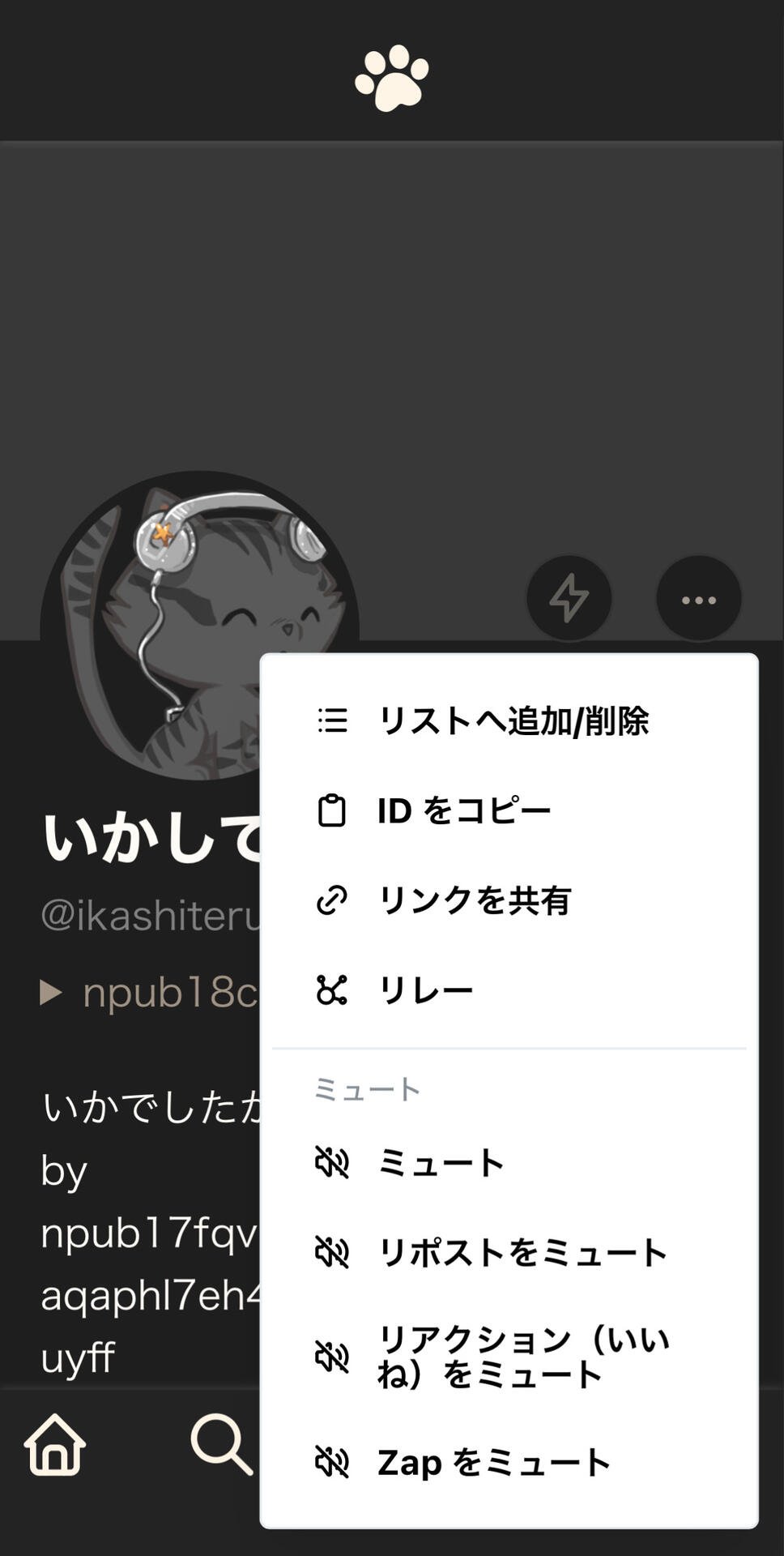
2024/06/22 20時の時点では、nostter上ではこれを設定する画面が用意されていなかったので、別アプリを用いたり、イベントを自分で投げるなどして別途設定する必要がありました。 以下は、別アプリを用いて設定した際の手順です。
手順
kind:30007はのすとびうあというWebアプリで設定しました。 以下のようにのすとびうあのホーム画面「リストの種類」で30007を入力するか、

https://nostviewstr.vercel.app/<npub文字列>/30007にアクセスして設定画面にいけました^3。左下の方にある≡を押して

ポップアップの「編集」を押して

ここではリポストのミュートのため、IDの欄に対応するイベントの種類の番号である「6」を入れて

右下にある青いボタン押して

Userの欄にリポストをミュートするユーザーの公開鍵のnpub文字列を入れ、public(ミュート状況が公開される)あるいはprivate(非公開)のボタンを押したら

そのユーザーが追加されて設定完了!

この設定を行うことで、入力した公開鍵(ユーザー)のリポストをnostter上でもミュートできました🙌
リポストやリアクションがどのように表示されるかをユーザーがコントロールできると便利なので、今後いろんなクライアントで対応されればいいな〜と思います!
-
 @ f0fcbea6:7e059469
2025-05-27 18:08:04
@ f0fcbea6:7e059469
2025-05-27 18:08:04Muita gente, hoje em dia, acha que a leitura já não é tão necessária quanto foi no passado. O rádio e a televisão acabaram assumindo as funções que outrora pertenciam à mídia impressa, da mesma maneira que a fotografia assumiu as funções que outrora pertenciam à pintura e às artes gráficas. Temos de reconhecer - é verdade - que a televisão cumpre algumas dessas funções muito bem; a comunicação visual dos telejornais, por exemplo, tem impacto enorme. A capacidade do rádio em transmitir informações enquanto estamos ocupados - dirigindo um carro, por exemplo - é algo extraordinário, além de nos poupar muito tempo. No entanto, é necessário questionar se as comunicações modernas realmente aumentam o conhecimento sobre o mundo à nossa volta.
Talvez hoje saibamos mais sobre o mundo do que no passado. Dado que o conhecimento é pré-requisito para o entendimento, trata-se de algo bom. Mas o conhecimento não é um pré-requisito tão importante ao entendimento quanto normalmente se supõe. Não precisamos saber tudo sobre determinada coisa para que possamos entendê-la. Uma montanha de fatos pode provocar o efeito contrário, isto é, pode servir de obstáculo ao entendimento. Há uma sensação, hoje em dia, de que temos acesso a muitos fatos, mas não necessariamente ao entendimento desses fatos.
Uma das causas dessa situação é que a própria mídia é projetada para tornar o pensamento algo desnecessário - embora, é claro, isso seja apenas mera impressão. O ato de empacotar ideias e opiniões intelectuais é uma atividade à qual algumas das mentes mais brilhantes se dedicam com grande diligência. O telespectador, o ouvinte, o leitor de revistas - todos eles se defrontam com um amálgama de elementos complexos, desde discursos retóricos minuciosamente planejados até dados estatísticos cuidadosamente selecionados, cujo objetivo é facilitar o ato de "formar a opinião" das pessoas com esforço e dificuldade mínimos. Por vezes, no entanto, o empacotamento é feito de maneira tão eficiente, tão condensada, que o telespectador, o ouvinte ou o leitor não conseguem formar sua opinião. Em vez disso, a opinião empacotada é introjetada em sua mente mais ou menos como uma gravação é inserida no aparelho de som. No momento apropriado, aperta-se o play e a opinião é "tocada". Eles reproduzem a opinião sem terem pensado a respeito.
-
 @ c1e9ab3a:9cb56b43
2025-05-27 16:19:06
@ c1e9ab3a:9cb56b43
2025-05-27 16:19:06Star Wars is often viewed as a myth of rebellion, freedom, and resistance to tyranny. The iconography—scrappy rebels, totalitarian stormtroopers, lone smugglers—suggests a deep anti-authoritarian ethos. Yet, beneath the surface, the narrative arc of Star Wars consistently affirms the necessity, even sanctity, of central authority. This blog entry introduces the question: Is Star Wars fundamentally a celebration of statism?
Rebellion as Restoration, Not Revolution
The Rebel Alliance’s mission is not to dismantle centralized power, but to restore the Galactic Republic—a bureaucratic, centrally governed institution. Characters like Mon Mothma and Bail Organa are high-ranking senators, not populist revolutionaries. The goal is to remove the corrupt Empire and reinstall a previous central authority, presumed to be just.
- Rebels are loyalists to a prior state structure.
- Power is not questioned, only who wields it.
Jedi as Centralized Moral Elites
The Jedi, often idealized as protectors of peace, are unelected, extra-legal enforcers of moral and military order. Their authority stems from esoteric metaphysical abilities rather than democratic legitimacy.
- They answer only to their internal Council.
- They are deployed by the Senate, but act independently of civil law.
- Their collapse is depicted as tragic not because they were unaccountable, but because they were betrayed.
This positions them as a theocratic elite, not spiritual anarchists.
Chaos and the Frontier: The Case of the Cantina
The Mos Eisley cantina, often viewed as a symbol of frontier freedom, reveals something darker. It is: - Lawless - Violent - Culturally fragmented
Conflict resolution occurs through murder, not mediation. Obi-Wan slices off a limb; Han shoots first—both without legal consequence. There is no evidence of property rights, dispute resolution, or voluntary order.
This is not libertarian pluralism—it’s moral entropy. The message: without centralized governance, barbarism reigns.
The Mythic Arc: Restoration of the Just State
Every trilogy in the saga returns to a single theme: the fall and redemption of legitimate authority.
- Prequels: Republic collapses into tyranny.
- Originals: Rebels fight to restore legitimate order.
- Sequels: Weak governance leads to resurgence of authoritarianism; heroes must reestablish moral centralism.
The story is not anti-state—it’s anti-bad state. The solution is never decentralization; it’s the return of the right ruler or order.
Conclusion: The Hidden Statism of a Rebel Myth
Star Wars wears the costume of rebellion, but tells the story of centralized salvation. It: - Validates elite moral authority (Jedi) - Romanticizes restoration of fallen governments (Republic) - Portrays decentralized zones as corrupt and savage (outer rim worlds)
It is not an anarchist parable, nor a libertarian fable. It is a statist mythology, clothed in the spectacle of rebellion. Its core message is not that power should be abolished, but that power belongs to the virtuous few.
Question to Consider:
If the Star Wars universe consistently affirms the need for centralized moral and political authority, should we continue to see it as a myth of freedom? Or is it time to recognize it as a narrative of benevolent empire? -
 @ 3bf0c63f:aefa459d
2024-06-13 15:40:18
@ 3bf0c63f:aefa459d
2024-06-13 15:40:18Why relay hints are important
Recently Coracle has removed support for following relay hints in Nostr event references.
Supposedly Coracle is now relying only on public key hints and
kind:10002events to determine where to fetch events from a user. That is a catastrophic idea that destroys much of Nostr's flexibility for no gain at all.- Someone makes a post inside a community (either a NIP-29 community or a NIP-87 community) and others want to refer to that post in discussions in the external Nostr world of
kind:1s -- now that cannot work because the person who created the post doesn't have the relays specific to those communities in their outbox list; - There is a discussion happening in a niche relay, for example, a relay that can only be accessed by the participants of a conference for the duration of that conference -- since that relay is not in anyone's public outbox list, it's impossible for anyone outside of the conference to ever refer to these events;
- Some big public relays, say, relay.damus.io, decide to nuke their databases or periodically delete old events, a user keeps using that big relay as their outbox because it is fast and reliable, but chooses to archive their old events in a dedicated archival relay, say, cellar.nostr.wine, while prudently not including that in their outbox list because that would make no sense -- now it is impossible for anyone to refer to old notes from this user even though they are publicly accessible in cellar.nostr.wine;
- There are topical relays that curate content relating to niche (non-microblogging) topics, say, cooking recipes, and users choose to publish their recipes to these relays only -- but now they can't refer to these relays in the external Nostr world of
kind:1s because these topical relays are not in their outbox lists. - Suppose a user wants to maintain two different identities under the same keypair, say, one identity only talks about soccer in English, while the other only talks about art history in French, and the user very prudently keeps two different
kind:10002events in two different sets of "indexer" relays (or does it in some better way of announcing different relay sets) -- now one of this user's audiences cannot ever see notes created by him with their other persona, one half of the content of this user will be inacessible to the other half and vice-versa. - If for any reason a relay does not want to accept events of a certain kind a user may publish to other relays, and it would all work fine if the user referenced that externally-published event from a normal event, but now that externally-published event is not reachable because the external relay is not in the user's outbox list.
- If someone, say, Alex Jones, is hard-banned everywhere and cannot event broadcast
kind:10002events to any of the commonly used index relays, that person will now appear as banned in most clients: in an ideal world in which clients followednprofileand other relay hints Alex Jones could still live a normal Nostr life: he would print business cards with hisnprofileinstead of annpuband clients would immediately know from what relay to fetch his posts. When other users shared his posts or replied to it, they would include a relay hint to his personal relay and others would be able to see and then start following him on that relay directly -- now Alex Jones's events cannot be read by anyone that doesn't already know his relay.
- Someone makes a post inside a community (either a NIP-29 community or a NIP-87 community) and others want to refer to that post in discussions in the external Nostr world of
-
 @ d360efec:14907b5f
2025-05-27 15:46:26
@ d360efec:14907b5f
2025-05-27 15:46:26 -
 @ 3bf0c63f:aefa459d
2024-06-12 15:26:56
@ 3bf0c63f:aefa459d
2024-06-12 15:26:56How to do curation and businesses on Nostr
Suppose you want to start a Nostr business.
You might be tempted to make a closed platform that reuses Nostr identities and grabs (some) content from the external Nostr network, only to imprison it inside your thing -- and then you're going to run an amazing AI-powered algorithm on that content and "surface" only the best stuff and people will flock to your app.
This will be specially good if you're going after one of the many unexplored niches of Nostr in which reading immediately from people you know doesn't work as you generally want to discover new things from the outer world, such as:
- food recipe sharing;
- sharing of long articles about varying topics;
- markets for used goods;
- freelancer work and job offers;
- specific in-game lobbies and matchmaking;
- directories of accredited professionals;
- sharing of original music, drawings and other artistic creations;
- restaurant recommendations
- and so on.
But that is not the correct approach and damages the freedom and interoperability of Nostr, posing a centralization threat to the protocol. Even if it "works" and your business is incredibly successful it will just enshrine you as the head of a platform that controls users and thus is prone to all the bad things that happen to all these platforms. Your company will start to display ads and shape the public discourse, you'll need a big legal team, the FBI will talk to you, advertisers will play a big role and so on.
If you are interested in Nostr today that must be because you appreciate the fact that it is not owned by any companies, so it's safe to assume you don't want to be that company that owns it. So what should you do instead? Here's an idea in two steps:
- Write a Nostr client tailored to the niche you want to cover
If it's a music sharing thing, then the client will have a way to play the audio and so on; if it's a restaurant sharing it will have maps with the locations of the restaurants or whatever, you get the idea. Hopefully there will be a NIP or a NUD specifying how to create and interact with events relating to this niche, or you will write or contribute with the creation of one, because without interoperability none of this matters much.
The client should work independently of any special backend requirements and ideally be open-source. It should have a way for users to configure to which relays they want to connect to see "global" content -- i.e., they might want to connect to
wss://nostr.chrysalisrecords.com/to see only the latest music releases accredited by that label or towss://nostr.indiemusic.com/to get music from independent producers from that community.- Run a relay that does all the magic
This is where your value-adding capabilities come into play: if you have that magic sauce you should be able to apply it here. Your service, let's call it
wss://magicsaucemusic.com/, will charge people or do some KYM (know your music) validation or use some very advanced AI sorcery to filter out the spam and the garbage and display the best content to your users who will request the global feed from it (["REQ", "_", {}]), and this will cause people to want to publish to your relay while others will want to read from it.You set your relay as the default option in the client and let things happen. Your relay is like your "website" and people are free to connect to it or not. You don't own the network, you're just competing against other websites on a leveled playing field, so you're not responsible for it. Users get seamless browsing across multiple websites, unified identities, a unified interface (that could be different in a different client) and social interaction capabilities that work in the same way for all, and they do not depend on you, therefore they're more likely to trust you.
Does this centralize the network still? But this a simple and easy way to go about the matter and scales well in all aspects.
Besides allowing users to connect to specific relays for getting a feed of curated content, such clients should also do all kinds of "social" (i.e. following, commenting etc) activities (if they choose to do that) using the outbox model -- i.e. if I find a musician I like under
wss://magicsaucemusic.comand I decide to follow them I should keep getting updates from them even if they get banned from that relay and start publishing onwss://nos.lolorwss://relay.damus.ioor whatever relay that doesn't even know what music is.The hardcoded defaults and manual typing of relay URLs can be annoying. But I think it works well at the current stage of Nostr development. Soon, though, we can create events that recommend other relays or share relay lists specific to each kind of activity so users can get in-app suggestions of relays their friends are using to get their music from and so on. That kind of stuff can go a long way.
-
 @ bf47c19e:c3d2573b
2025-05-27 14:57:56
@ bf47c19e:c3d2573b
2025-05-27 14:57:56Srpski prevod knjige "The Little Bitcoin Book"
Zašto je Bitkoin bitan za vašu slobodu, finansije i budućnost?
Verovatno ste čuli za Bitkoin u vestima ili da o njemu raspravljaju vaši prijatelji ili kolege. Kako to da se cena stalno menja? Da li je Bitkoin dobra investicija? Kako to uopšte ima vrednost? Zašto ljudi stalno govore o tome kao da će promeniti svet?
"Mala knjiga o Bitkoinu" govori o tome šta nije u redu sa današnjim novcem i zašto je Bitkoin izmišljen da obezbedi alternativu trenutnom sistemu. Jednostavnim rečima opisuje šta je Bitkoin, kako funkcioniše, zašto je vredan i kako utiče na individualnu slobodu i mogućnosti ljudi svuda - od Nigerije preko Filipina do Venecuele do Sjedinjenih Država. Ova knjiga takođe uključuje odeljak "Pitanja i odgovori" sa nekim od najčešće postavljanih pitanja o Bitkoinu.
Ako želite da saznate više o ovom novom obliku novca koji i dalje izaziva interesovanje i usvajanje širom sveta, onda je ova knjiga za vas.
-
 @ 3bf0c63f:aefa459d
2024-05-24 12:31:40
@ 3bf0c63f:aefa459d
2024-05-24 12:31:40About Nostr, email and subscriptions
I check my emails like once or twice a week, always when I am looking for something specific in there.
Then I go there and I see a bunch of other stuff I had no idea I was missing. Even many things I wish I had seen before actually. And sometimes people just expect and assume I would have checked emails instantly as they arrived.
It's so weird because I'm not making a point, I just don't remember to open the damn "gmail.com" URL.
I remember some people were making some a Nostr service a while ago that sent a DM to people with Nostr articles inside -- or some other forms of "subscription services on Nostr". It makes no sense at all.
Pulling in DMs from relays is exactly the same process (actually slightly more convoluted) than pulling normal public events, so why would a service assume that "sending a DM" was more likely to reach the target subscriber when the target had explicitly subscribed to that topic or writer?
Maybe due to how some specific clients work that is true, but fundamentally it is a very broken assumption that comes from some fantastic past era in which emails were 100% always seen and there was no way for anyone to subscribe to someone else's posts.
Building around such broken assumptions is the wrong approach. Instead we should be building new flows for subscribing to specific content from specific Nostr-native sources (creators directly or manual or automated curation providers, communities, relays etc), which is essentially what most clients are already doing anyway, but specifically Coracle's new custom feeds come to mind now.
This also reminds me of the interviewer asking the Farcaster creator if Farcaster made "email addresses available to content creators" completely ignoring all the cryptography and nature of the protocol (Farcaster is shit, but at least they tried, and in this example you could imagine the interviewer asking the same thing about Nostr).
I imagine that if the interviewer had asked these people who were working (or suggesting) the Nostr DM subscription flow they would have answered: "no, you don't get their email addresses, but you can send them uncensorable DMs!" -- and that, again, is getting everything backwards.
-
 @ bf47c19e:c3d2573b
2025-05-27 14:54:03
@ bf47c19e:c3d2573b
2025-05-27 14:54:03Originalni tekst na bitcoin-balkan.com.
Pregled sadržaja
- 5 Razloga Zašto je Novac Važan za Vas, Individualno
- 3 Razloga Zašto je Novac Važan za Društvo u Celini
- Zašto ljudi mrze novac?

Novac vs trenuci – da li oni treba da budu u sukobu? Kakva je uloga novca?
Novac je nepredvidiva zver modernog društva – neki ga veličaju sa stalnom željom da steknu više, dok ga drugi demonizuju i kažu da je pohlepa srž društvenih problema. Tokom mnogih godina svog života, ja sam često prelazio sa jednog na drugo gledište, i naučio mnogo toga upoznajući druge ljude koji žive na oba kraja ovog spektra. Kao i kod mnogih složenih tema, istina leži negde u sredini.
Novac je važan zato što on može da pomogne u uklanjanju materijalnih želja i patnji – omogućavanjem da preuzmete kontrolu nad svojim životom i da brinete o voljenima. Novac podiže životni standard društva omogućavanjem trgovine, a pritom minimalizuje potrebu za poverenjem.
Na novac možemo gledati kao na način da svoj uloženi trud sačuvamo u odredjenom obliku, i da ga vremenom prenesemo, tako da možemo da uživamo u plodovima svog rada. Novac kao alat je jedna od najvažnijih stvari za rast civilizacije. Na nesreću, mnogi su vremenom zlostavljali novac, ali sa dobrim razlogom: način na koji naš novac danas funkcioniše dovodi do duboko podeljenog društva – što ću i objasniti.
5 Razloga Zašto je Novac Važan za Vas, Individualno
Novac je važan za rast bogatstva, što je malo drugačije od toga da imamo veliku platu ili jednostavno zarađivati velike količine novca. Bogatstvo je otklanjanje želja, kako bi mogli da obratimo više pažnje na neke korisnije stvari u životu, od pukog preživljavanja i osnovnih udobnosti.
Bogata osoba je ona koja zaradi više novca nego što potroši, i koja ga čuva – ona čuva svoj rad tokom vremena. Uporedite ovo sa visoko plaćenim lekarom koji živi u velikoj vili sa hipotekom i sa Mercedesom na lizing. Iako ova osoba ima visoke prihode, ona takođe ima velike rashode u vidu obaveze plaćanja te hipoteke i lizinga. Te obaveze sprečavaju ovu osobu da uživa u istinskim blagodetima novca i bogatstva koje one predstavljaju:
1. Sloboda od potrebe za radom
Bez bogatstva, vi morate da radite da biste preživeli. Dostizanjem bogatstva i odredjenom imovinom koja vam donosi novac bez potrebe da vi trošite svoje vreme, vi možete da oslobodite svoj raspored. Više ne zavisite od posla koji mrzite, i nemorate da provodite 40 sati nedeljno odvojeni od porodice, samo da biste se pobrinuli za svoje osnovne potrebe. Dobijanje otkaza u padu ekonomije neće vas dovesti do finansijske propasti ili nečeg goreg.
2. Kontrola nad time kako vi trošite svoje vreme
Kada steknete bogatstvo, vi možete da odlučite kako želite da provodite svoje vreme. Kada se nalazimo u trci pacova i radimo 40+ sati nedeljno, često se naviknemo da novac trošimo onda kada imamo slobodnog vremena. Idemo na lepe večere ili idemo na skupe odmore. Međutim, sa više vremena, a možda čak i sa manje novca, mi možemo da imamo isto ili više uživanja živeći usporenije.
Razmislite o ovome – ukoliko imate samo 1 nedelju slobodno od posla, vi onda morate da kupite onaj mnogo skuplji let u Petak uveče koji se vraća u sledeću Nedelju, kako biste maksimalno iskoristili svoje vreme na nekom egzotičnom mestu za odmor. Međutim, ukoliko ste u mogućnosti da izdržavate sebe bez potrebe da mnogo vremena provodite na poslu, vi onda možete u Utorak da krenete jeftinijim letom i vratite se u sledeću Sredu. Takođe nećete osećati toliki pritisak da se opustite u uživanju tokom vaše nedelje u inostranstvu – možda ćete čak moći i da ostanete duže i da istražujete više, bez plaćanja skupih turističkih agencija i hotela kako bi organizovali vaše kraće putovanje.
3. Sposobnost da pomažete vašim prijateljima i porodici
Onda kada novca imate na pretek, možete poboljšati svoje odnose sa prijateljima i porodicom ne samo kroz dodatno slobodno vreme koje provodite sa njima, već i sa samim novcem. Ako je vašem prijatelju potrebna hitna operacija, vi možete da mu izadjete u susret i pomognete mu da stane na svoje noge. Ukoliko vam je tetka bolesna, vi možete da provedete vreme pored nje, umesto da je pozovete na kratko dok putujete prema kući vraćajući se nakon celog dana provedenog u kancelariji.
4. Smanjen finansijski stres
Stres je sveobuhvatno i opasno stanje modernog doba, sa kojim gotovo svi mi živimo u nekoj odredjenoj meri. Povezan je sa lošim zdravljem, sa preko 43% svih odraslih koji kažu da pate od odredjenih zdravstvenih problema uzrokovanih stresom. Stres zbog posla pogađa 83% zaposlenih.
Pravo bogatstvo – koje znači eliminaciju želja i potreba – može da ukloni ovaj stres i njegove negativne uticaje na druge delove života. Ovo bi čak moglo da ukloni većinu stresa u vašem životu, uzimajući u obzir da je uzrok stresa broj 1 upravo novac.
5. Bolje možete da pomognete vašoj zajednici
Mnogi od nas žele da volontiraju u svojim zajednicama i pomognu onima koja je pomoć preko potrebna, ali nisu u stanju da pronađu slobodnog vremena i energije zbog svog posla, porodice i društvenih aktivnosti koje nas mentalno i fizički čine srećnima, zdravima i hranjenima. Sa bogatstvom, mi možemo da posvetimo vreme koje nam je potrebno za razumevanje i doprinos drugima – a ne samo da sa vremena na vreme pomognemo slanjem humanitarnog SMS-a.
Novac, koji se pametno koristi, je moćno sredstvo za poboljšanje vašeg života i života vaših najmilijih i zajednice. Međutim, novac je takođe moćno sredstvo za poboljšanje društva u celini – ukoliko je dobro strukturiran.
3 Razloga Zašto je Novac Važan za Društvo u Celini
Novac poboljšava sposobnost ljudi da trguju jedni s drugima, što podstiče određene specijalizacije. Ako je imanje vašeg komšije odlično za proizvodnju vina, a vaše je pogodno za žito, obojica možete da profitirate trgovinom. Sad oboje imate i hleb i vino, umesto jednog pijanog vlasnika vinograda i jednog proizvodjača žita kome je dosadno!
Novac poboljšava društvo na nekoliko načina:
1. Omogućava specijalizaciju
Kao u primeru vlasnika vinograda i proizvodjača žita, novac omogućava povećanu specijalizaciju poboljšavajući sposobnost trgovine. Svaka razmena dobara ima problem sa ‘sticajima potreba’ – oba partnera u trgovini moraju da žele ono što druga osoba ima da bi pristala na trgovinu.
Možemo da mislimo o novcu kao o dobru koje žele gotovo svi. Ovo trgovinu čini mnogo jednostavnijom – da biste stekli odredjeno dobro, sve što vam je potrebno je novac, a ne neka slučajna stvar koju prodavac tog dobra takođe želi u tom trenutku. Vremenom je upotreba novca omogućila specijalizaciju, što je povećalo kvalitet i složenost roba i usluga.
Zamislite da sami pokušate da napravite svoj telefon – a bili su potrebni milioni stručnjaka i specijalizovana oprema da bi proizveli taj uređaj. Svi ti stručnjaci i kompanije plaćaju jedni drugima u novcu, omogućavajući složenom plesu globalnih proizvođača i lanaca snabdevanja da taj telefon isporuče na dlan vaše ruke. Čak i nešto tako jednostavno kao flaša za vodu uključuje naftna polja i proizvodne pogone koji su možda hiljadama kilometara od vaše kuće.
Kada ljudi mogu da se specijalizuju, kvalitet robe i usluga može da se poveća.
2. Omogućava korisnu trgovinu uz smanjeno poverenje
Mala društva mogu mirno i produktivno da posluju bez novca koristeći usluge, “dodjem ti” i uzajamno razumevanje. Međutim, kako se društva uvećavaju, svima brzo postaje nemoguće da održavaju lične odnose i isti stepen poverenja sa svima ostalima. Sistem trgovine uslugama i međusobnog poverenja ne funkcioniše previše dobro sa putnikom koji se nalazi na proputovanju kroz grad, i provede samo 15 minuta svog života u vašoj prodavnici.
Novac minimizira poverenje potrebno za trgovinu u većim društvima. Sada više ne moram da verujem da ćete mi pomoći kasnije kada mi zatreba – mogu samo da prihvatim uplatu od vas i da to koristim da bih sebi pomogao kasnije. Jedan od mojih omiljenih mislilaca, Nick Szabo, ovo naziva ‘društvena prilagodljivost’.
3. Smanjuje upotrebu sile
Kada društvo teži upotrebi određenog oblika novca za olakšavanje trgovine, može u velikoj meri da smanji nasilje u tom društvu. Kako to može biti tako? Zar ljudi ne bi i dalje želeli da kradu jedni od drugih ili da se svete?
Ukoliko razmišljamo van uobičajnih okvira, možemo da počnemo da razumemo kako novac može da smanji nasilje. Ako ti i ja živimo u susednim zemljama i želimo nešto što druga zemlja ima, imamo dva načina da to dobijemo: uzimanjem na silu ili menjanjem nečeg našeg za to. Kao što je ranije rečeno, novac znatno olakšava trgovinu – pa ćemo postojanjem zajedničkog monetarnog sistema verovatnije radje izvršiti trgovinu nego napad na zemlju. Zašto bismo rizikovali svoje živote kad možemo samo mirno da trgujemo jedni sa drugima?
Zašto ljudi mrze novac?
Pa ako novac ima toliko koristi za nas lično i za društvo u celini, zašto toliko ljudi mrzi novac? Zašto je demonizovan, zajedno sa onima koji ga imaju puno?
Za deo ovoga može biti okrivljen problem u jednakosti mogućnosti – to da je nekima teže da izadju iz nemaštine i postanu bogati. Bez sumnje, neki mali deo potiče od ljudi koji jednostavno ne žele da se trude ili preduzmu neophodne rizike da bi postali bogati.
Međutim, oba ova problema imaju više veze sa problemima kako naš novac danas funkcioniše, nego sa bilo kojim problemom u samom konceptu novca. Novčani sistem treba da nagrađuje ljude koji proizvode vredne stvari i trguju njima sa drugima. Verujem da većina ljudi danas misli da novac tako funkcioniše, i to ne bi smelo da bude daleko od istine.
Naš trenutni monetarni sistem, na žalost, nagrađuje ’finansijalizaciju’ – pretvarajući sve u imovinu, čija vrednost može da se napumpava ili spušta stvaranjem dobre priče i navođenjem drugih da veruju u nju. Razuzdani dug pogonjen stalnim omalovažavanjem svih glavnih valuta dodat je ovom blatu finansijalizacije. Sada je isplativije podići ogroman kredit i koristiti ga za brzo okretanje imovine radi zarade nego izgraditi posao koji društvu nudi korisne robe i usluge.
Tradicionalni monetarni sistem dodatno nagradjuje predatore, partnere u zločinu i neradnike.
Propast našeg novca razvila se tokom proteklih pola veka, počevši od toga kada su naše valute postale ništa više od parčeta papira, podržanog sa verom i kreditima naših vlada. Da biste bolje razumeli ovu promenu, pogledajte moj post o svrsi i istoriji novca.
Ako vam se sviđa moj rad, molim vas da ga podelite sa svojim prijateljima i porodicom. Cilj mi je da svima pružim pogled u ekonomiju i na to kako ona utiče na njihov život.
-
 @ 3bf0c63f:aefa459d
2024-03-23 02:22:53
@ 3bf0c63f:aefa459d
2024-03-23 02:22:53Nostr is not decentralized nor censorship-resistant
Peter Todd has been saying this for a long time and all the time I've been thinking he is misunderstanding everything, but I guess a more charitable interpretation is that he is right.
Nostr today is indeed centralized.
Yesterday I published two harmless notes with the exact same content at the same time. In two minutes the notes had a noticeable difference in responses:
The top one was published to
wss://nostr.wine,wss://nos.lol,wss://pyramid.fiatjaf.com. The second was published to the relay where I generally publish all my notes to,wss://pyramid.fiatjaf.com, and that is announced on my NIP-05 file and on my NIP-65 relay list.A few minutes later I published that screenshot again in two identical notes to the same sets of relays, asking if people understood the implications. The difference in quantity of responses can still be seen today:
These results are skewed now by the fact that the two notes got rebroadcasted to multiple relays after some time, but the fundamental point remains.
What happened was that a huge lot more of people saw the first note compared to the second, and if Nostr was really censorship-resistant that shouldn't have happened at all.
Some people implied in the comments, with an air of obviousness, that publishing the note to "more relays" should have predictably resulted in more replies, which, again, shouldn't be the case if Nostr is really censorship-resistant.
What happens is that most people who engaged with the note are following me, in the sense that they have instructed their clients to fetch my notes on their behalf and present them in the UI, and clients are failing to do that despite me making it clear in multiple ways that my notes are to be found on
wss://pyramid.fiatjaf.com.If we were talking not about me, but about some public figure that was being censored by the State and got banned (or shadowbanned) by the 3 biggest public relays, the sad reality would be that the person would immediately get his reach reduced to ~10% of what they had before. This is not at all unlike what happened to dozens of personalities that were banned from the corporate social media platforms and then moved to other platforms -- how many of their original followers switched to these other platforms? Probably some small percentage close to 10%. In that sense Nostr today is similar to what we had before.
Peter Todd is right that if the way Nostr works is that you just subscribe to a small set of relays and expect to get everything from them then it tends to get very centralized very fast, and this is the reality today.
Peter Todd is wrong that Nostr is inherently centralized or that it needs a protocol change to become what it has always purported to be. He is in fact wrong today, because what is written above is not valid for all clients of today, and if we drive in the right direction we can successfully make Peter Todd be more and more wrong as time passes, instead of the contrary.
See also:
-
 @ 45d6c2bf:56915a25
2025-05-27 14:23:39
@ 45d6c2bf:56915a25
2025-05-27 14:23:39published without nostr installed
-
 @ 3bf0c63f:aefa459d
2024-03-19 14:32:01
@ 3bf0c63f:aefa459d
2024-03-19 14:32:01Censorship-resistant relay discovery in Nostr
In Nostr is not decentralized nor censorship-resistant I said Nostr is centralized. Peter Todd thinks it is centralized by design, but I disagree.
Nostr wasn't designed to be centralized. The idea was always that clients would follow people in the relays they decided to publish to, even if it was a single-user relay hosted in an island in the middle of the Pacific ocean.
But the Nostr explanations never had any guidance about how to do this, and the protocol itself never had any enforcement mechanisms for any of this (because it would be impossible).
My original idea was that clients would use some undefined combination of relay hints in reply tags and the (now defunct)
kind:2relay-recommendation events plus some form of manual action ("it looks like Bob is publishing on relay X, do you want to follow him there?") to accomplish this. With the expectation that we would have a better idea of how to properly implement all this with more experience, Branle, my first working client didn't have any of that implemented, instead it used a stupid static list of relays with read/write toggle -- although it did publish relay hints and kept track of those internally and supportedkind:2events, these things were not really useful.Gossip was the first client to implement a truly censorship-resistant relay discovery mechanism that used NIP-05 hints (originally proposed by Mike Dilger) relay hints and
kind:3relay lists, and then with the simple insight of NIP-65 that got much better. After seeing it in more concrete terms, it became simpler to reason about it and the approach got popularized as the "gossip model", then implemented in clients like Coracle and Snort.Today when people mention the "gossip model" (or "outbox model") they simply think about NIP-65 though. Which I think is ok, but too restrictive. I still think there is a place for the NIP-05 hints,
nprofileandneventrelay hints and specially relay hints in event tags. All these mechanisms are used together in ZBD Social, for example, but I believe also in the clients listed above.I don't think we should stop here, though. I think there are other ways, perhaps drastically different ways, to approach content propagation and relay discovery. I think manual action by users is underrated and could go a long way if presented in a nice UX (not conceived by people that think users are dumb animals), and who knows what. Reliance on third-parties, hardcoded values, social graph, and specially a mix of multiple approaches, is what Nostr needs to be censorship-resistant and what I hope to see in the future.
-
 @ 43baaf0c:d193e34c
2025-05-27 14:08:02
@ 43baaf0c:d193e34c
2025-05-27 14:08:02During the incredible Bitcoin Filmfest, I attended a community session where a discussion emerged about zapping and why I believe zaps are important. The person leading the Nostr session who is also developing an app that’s partially connected to Nostr mentioned they wouldn’t be implementing the zap mechanism directly. This sparked a brief but meaningful debate, which is why I’d like to share my perspective as an artist and content creator on why zaps truly matter.
Let me start by saying that I see everything from the perspective of an artist and creator, not so much from a developer’s point of view. In 2023, I started using Nostr after spending a few years exploring the world of ‘shitcoins’ and NFTs, beginning in 2018. Even though I became a Bitcoin maximalist around 2023, those earlier years taught me an important lesson: it is possible to earn money with my art.
Whether you love or hate them, NFTs opened my eyes to the idea that I could finally take my art to the next level. Before that, for over 15 years, I ran a travel stock video content company called @traveltelly. You can read the full story about my journey in travel and content here: https://yakihonne.com/article/traveltelly@primal.net/vZc1c8aXrc-3hniN6IMdK
When I truly understood what Bitcoin meant to me, I left all other coins behind. Some would call that becoming a Bitcoin maximalist.
The first time I used Nostr, I discovered the magic of zapping. It amazed me that someone who appreciates your art or content could reward you—not just with a like, but with real value: Bitcoin, the hardest money on earth. Zaps are small amounts of Bitcoin sent as a sign of support or appreciation. (Each Bitcoin is divisible into 100 million units called Satoshis, or Sats for short—making a Satoshi the smallest unit of Bitcoin recorded on the blockchain.)
 The Energy of Zaps
The Energy of ZapsIf you’re building an app on Nostr—or even just connecting to it—but choose not to include zaps, why should artists and content creators share their work there? Why would they leave platforms like Instagram or Facebook, which already benefit from massive network effects?
Yes, the ability to own your own data is one of Nostr’s greatest strengths. That alone is a powerful reason to embrace the protocol. No one can ban you. You control your content. And the ability to post once and have it appear across multiple Nostr clients is an amazing feature.
But for creators, energy matters. Engagement isn’t just about numbers—it’s about value. Zaps create a feedback loop powered by real appreciation and real value, in the form of Bitcoin. They’re a signal that your content matters. And that energy is what makes creating on Nostr so special.
But beyond those key elements, I also look at this from a commercial perspective. The truth is, we still can’t pay for groceries with kisses :)—we still need money as a medium of exchange. Being financially rewarded for sharing your content gives creators a real incentive to keep creating and sharing. That’s where zaps come in—they add economic value to engagement.
A Protocol for Emerging Artists and Creators
I believe Nostr offers a great starting point for emerging artists and content creators. If you’re just beginning and don’t already have a large following on traditional social media platforms, Nostr provides a space where your work can be appreciated and directly supported with Bitcoin, even by a small but engaged community.
On the other hand, creators who already have a big audience and steady income on platforms like Instagram or YouTube may not feel the urgency to switch. This is similar to how wealthier countries are often slower to understand or adopt Bitcoin—because they don’t need it yet. In contrast, people in unbanked regions or countries facing high inflation are more motivated to learn how money really works.
In the same way, emerging creators—those still finding their audience and looking for sustainable ways to grow—are often more open to exploring new ecosystems like Nostr, where innovation and financial empowerment go hand in hand.
The same goes for Nostr. After using it for the past two years, I can honestly say: without Nostr, I wouldn’t be the artist I am today.
Nostr motivates me to create and share every single day. A like is nice but receiving a zap, even just 21 sats, is something entirely different. Once you truly understand that someone is willing to pay you for what you share, it’s no longer about the amount. It’s about the magic behind it. That simple gesture creates a powerful, positive energy that keeps you going.
Even with Nostr’s still relatively small user base, I’ve already been able to create projects that simply wouldn’t have been possible elsewhere.
Zaps do more than just reward—they inspire. They encourage you to keep building your community. That inspiration often leads to new projects. Sometimes, the people who zap you become directly involved in your work, or even ask you to create something specifically for them.
That’s the real value of zaps: not just micro-payments, but micro-connections sparks that lead to creativity, collaboration, and growth.
Proof of Work (PoW)
Over the past two years, I’ve experienced firsthand how small zaps can evolve into full art projects and even lead to real sales. Here are two examples that started with zaps and turned into something much bigger:
Halving 2024 Artwork
When I started the Halving 2024 project, I invited people on Nostr to be part of it. 70 people zapped me 2,100 sats each, and in return, I included their Npubs in the final artwork. That piece was later auctioned and sold to Jurjen de Vries for 225,128 Sats.
Magic Internet Money
For the Magic Internet Money artwork, I again invited people to zap 2,100 sats to be included. Fifty people participated, and their contributions became part of the final art frame. The completed piece was eventually sold to Filip for 480,000 sats.
These examples show the power of zaps: a simple, small act of appreciation can turn into larger engagement, deeper connection, and even the sale of original art. Zaps aren’t just tips—they’re a form of collaboration and support that fuel creative energy.
I hope this article gives developers a glimpse into the perspective of an artist using Nostr. Of course, this is just one artist’s view, and it doesn’t claim to speak for everyone. But I felt it was important to share my Proof of Work and perspective.
For me, Zaps matter.
Thank you to all the developers who are building these amazing apps on Nostr. Your work empowers artists like me to share, grow, and be supported through the value-for-value model.
-
 @ 450f1fea:d9473ecc
2024-03-03 14:35:23
@ 450f1fea:d9473ecc
2024-03-03 14:35:23A German article, published by lawyer Viviane Fisher, available here, proves corruption in the Italian judiciary against Covid injection victims. The whole article is available below, translated to English, and chillingly underlines the need for initiatives like We The People where the general public removes judicial matters from totally corrupt judiciaries.
Listen to the article: https://media.nostr.build/av/201d5c6cb80e815f7e42777037230b9bc5c231b13aa3653825f44553062703a3.mp3
Bomb Shell: How the Italian judges were brought into line.
Italian journalist Andrea Zambrano has discovered what may have been one of the reasons for the almost unanimous rulings in favor of vaccination narratives and against fundamental individual rights throughout Italy: a decision-making guide penned by the Italian Supreme Court. Text modules from the "Report for judges number 103 on legislative novelties of October 28, 2021", with which future lawsuits should be rejected, have found themselves as hot tracks in various judgments.
With explanations on the topics of "safe and effective vaccines", "constitutional conformity of the measures", "just obligation for oneself and others", the judges were sworn in to the state narrative, which in Italy included mandatory vaccination for people over 50 years of age and for all healthcare workers, all teachers, law enforcement officers and all employees of the judiciary, as well as extremely strict 2G rules. The statements were based on false assumptions regarding a "general consensus of the scientific community on the efficacy and safety" of so-called "vaccinations". In part, these assumptions had already been refuted on October 28, 2021, but at the very least there was clear evidence of reasonable doubt about the accuracy of the presentation.
The judge's report categorized the "vaccines" as absolutely safe and by definition effective, citing the unanimous conviction of all scientists. Compulsory vaccination - out of loyalty to the Republic - is fair and just, both for the vaccinated person and for others. The constitutional requirements were complied with in every case. On this line of argument, the discriminated, injured, disabled citizens and employees without the solidary green passport had to appear like a horde of baselessly rebellious egomaniacs to the judges called upon to rule in civil, criminal and administrative cases.
The legally non-binding but impressive decision guide did not come from any judges but from the Italian Supreme Court, the equivalent of the German Federal Court of Justice. The Italian Supreme Court is responsible for the systematic and analytical review of case law and draws up maxims, reports and reviews of everything that is pronounced in the name of the Italian people.
What would have happened if this vademecum, this guide to action for judges, had not existed? Would individual judges then have made greater use of their autonomy, which is particularly pronounced in Italy? In Italy, judges are appointed by a body of judges, the National Council of Judges, so their careers are not dependent on the mercy of the Minister of Justice, as they are in Germany. They are, however, dependent on the goodwill of their fellow judges. What is piquant in this context is that the chairman of the National Council of Judges is the President of the Republic, Sergio Mattarella, who, together with the then Prime Minister Mario Draghi, constantly proclaimed the fairy tale of safe and effective "vaccination" to the public. The two of them repeatedly told the population like a prayer wheel: "If you don't get vaccinated, you kill yourself and others."
The document in question, entitled "The vaccination against Covid-19 and the obligation of the Green Pass in the current constitutional and legislative framework", which is exclusively available in full to La Nuova Bussola Quotidiana magazine, bears the signature of Judge Maria Acierno and her deputy Antonietta Scrima. The same document can be found in a slightly condensed version in the 2021 Yearbook, the collection of publications and files of the Supreme Court for the year 2021 (printed there from page 116 onwards).

It was written in October 2021, in the middle of the vaccination campaign to administer the third dose. This was the time when the scientific literature was already casting serious doubt on both the efficacy and the risk-free nature of the vaccination. The Astrazeneca product had already been rejected as unsuitable for mass use due to the occurrence of thromboses. The ninth report by AIFA, the Italian regulatory authority, available at the time pointed to 608 deaths following COVID-19 vaccinations. This alarming development was not included in the text written by Judge Milena D'Oriano. The most recently published yearbook for 2022 contains no updates on the topic, and the 2023 yearbook is not yet available to the public.
The use of the vaccines to implement the vaccination obligation and the 2G rule constituted an off-label use in Italy, as it was used to allegedly prevent a viral infection with SARS CoV2 instead of only to prevent a severe course of COVID-19.
 The conviction expressed in the action guide and thus conveyed to the judges is that "all legal acts in the first phase of the emergency, such as the Emergency Ordinance, the D.P.C.M., and the ordinances of the Ministry of Health have also entailed restrictions on rights and constitutional freedoms", but that these have been borne by the "concern of authoritative jurists". The difficult relationship between "compulsory vaccination and the burden of vaccination" requires the "expression of the individual's duty of solidarity towards the community" to be weighed against the "expression of the individual's right to self-determination". It is clear that, if one contrasts a supposedly risk-free "vaccination" that protects everyone with the seemingly excessive, individual self-determination excesses of the "vaccination opponents", a decision in favor of the solidarity-based vaccination requirement of a "small prick" is likely to be made.
The conviction expressed in the action guide and thus conveyed to the judges is that "all legal acts in the first phase of the emergency, such as the Emergency Ordinance, the D.P.C.M., and the ordinances of the Ministry of Health have also entailed restrictions on rights and constitutional freedoms", but that these have been borne by the "concern of authoritative jurists". The difficult relationship between "compulsory vaccination and the burden of vaccination" requires the "expression of the individual's duty of solidarity towards the community" to be weighed against the "expression of the individual's right to self-determination". It is clear that, if one contrasts a supposedly risk-free "vaccination" that protects everyone with the seemingly excessive, individual self-determination excesses of the "vaccination opponents", a decision in favor of the solidarity-based vaccination requirement of a "small prick" is likely to be made."Self-determination is certainly a valuable asset, but it can exceed limits based on the duty of solidarity in the interest of the community," writes Judge D'Oriano, concluding that "the periodic bulletins on the course of the epidemic by the ISS (...) prove that vaccination prophylaxis is effective both in containing the symptoms of the disease, drastically reducing the risk of severe syndromes and in preventing the transmission of the infection". The ISS, or Instituto Superiore de la Sanità, is the Italian equivalent of the RKI and attracted attention during the crisis by unleashing a huge shitstorm against its own critical employees who dared to express doubts about the safety of the "vaccinations" in the summer of 2022.
Just as in Germany the word of the PEI and RKI about safe and effective "vaccination" was and is considered irrefutable - despite a large number of contradictory expert opinions such as those presented in the Solden trial - only the officially announced findings should be relevant to the Italian judges' decisions. However, why then did Judge D'Oriano not also take note of the EMA documents that had already appeared on the AIFA website on December 21, 2020, on the eve of the mass vaccination campaign, proving the inability of the Pfizer "vaccine" to prevent infection, giving the lie to Draghi's infamous catchphrase "They don't get vaccinated - he, she gets infected and dies"?
Further evidence of substantial problems with the "vaccines" came from science and industry: The British Medical Journal published the news on February 10, 2022 that vaccinated people could become infected just as easily as unvaccinated people. Lancet publications also showed that the effectiveness against symptomatic Covid infection in vaccinated people decreases rapidly until it drops completely after about 6-7 months and even becomes negative. Wolfgang Philipp, Director of the European Health Agency HERA, told the European Parliamentary Committee of Inquiry into COVID19: "If you want to have a vaccine that prevents transmission, good luck. We have not managed to find it, it is not yet available". By order of the US Food and Drug Administration (FDA), Pfizer was forced to submit a report on its pharmacovigilance, which was conducted from December 1, 2020 to February 28, 2021. It revealed that "there were a total of 42,000 cases containing 158,000 reported adverse reactions, of which 25,000 were from Italy alone".
None of this was included in the judge's report in 2022.
Following the Supreme Court's assessment, the judges dismissed most of the lawsuits filed by citizens for suspension of work and wages due to their refusal to submit to the - allegedly constitutional - solidarity act of vaccination.
The magazine La Bussola names cases: e.g. the tragic story of young Runa Cody and his unexplained death from pericarditis. The mother had already brought many documents to the courtroom in June 2021 proving the occurrence of perimyocarditis after "vaccination" by providing Aifa documents. The response of the competent judge in Civitavecchia was: "At the time of administration and even today, the scientific literature on this subject was extremely scarce or absent".
Although deaths and harm had already been documented in international pharmacovigilance and addressed by renowned scientists, the Supreme Court report of October 28, 2021 shows a willingness to completely deny the existence of significant adverse effects. It relies exclusively on the latest available AIFA report of October 22, 2021, which later turned out to be manipulated. Worrying information about serious side effects has been deliberately suppressed by the decision-makers, which is now the subject of proceedings before the court in Rome and the ministerial court for former health minister Roberto Speranza, 2020News reported.
On page 13 of the guide to action for their fellow judges, judges Maria Acierno and Antonietta Scripa write: "It is scientifically proven and recognized that vaccines are one of the most effective preventive measures with a particularly high risk-benefit ratio and a very relevant ethical value as an expression of the duty of solidarity". And - to justify compliance with Article 32 of the Constitution - they point out that "according to the Constitution, compulsory health treatment complies with the requirements of Article 32 if it is aimed at improving or maintaining the state of health of the subject to whom it is addressed and does not affect the health of the recipient". The constitutionality of compulsory vaccination could therefore only be claimed if all the already known and dramatically emerging multiple harms were consistently denied or if the sacrifice of the individual for the collective could be affirmed in a false risk-benefit assessment. In reality, however, the risk must be weighed up on an individual basis: the risk of the individual becoming infected with the virus and ending up in hospital in danger of death must be assessed in comparison to the (alleged) benefits they would gain from a "vaccination".
On page 18 of the report, the judges state: "In terms of safety, the monitoring carried out by AIFA through the pharmacovigilance system, which collects and evaluates all adverse event reports, shows a perfectly acceptable risk-benefit balance, since the harms resulting from the administration of the vaccine for SARS COV 2, which, given the extreme rarity of occurrence, must be considered rare and correlatable events that meet a statistical normality criterion with a very low and slightly higher incidence of short-term adverse reactions than has been known for years for ordinary vaccines". They conclude that a possible Covid vaccination obligation, which would be provided for by law, would most likely have to be considered constitutional.
A judge who would have wanted to counter such a convincing assessment of the factual and legal situation presented by the highest authority with his own arguments would have had to fear being exposed to similar hostility as the alleged "anti-vaccinationists" themselves.
 How many judges have trusted this official and authoritative Supreme Court report and therefore dismissed the claims of the many victims who were forced to be vaccinated?
How many judges have trusted this official and authoritative Supreme Court report and therefore dismissed the claims of the many victims who were forced to be vaccinated?It is high time to update the report with all the evidence that has emerged in the meantime and thus provide judges, public prosecutors and lawyers with better guidance for the legal proceedings. Not only with regard to the alleged effectiveness, but also and especially with regard to the high risks of the "vaccinations".
Have other countries also been influenced in this way from "the very top"? We are staying on top of the issue.
-
 @ c1e9ab3a:9cb56b43
2025-05-27 13:19:53
@ c1e9ab3a:9cb56b43
2025-05-27 13:19:53I. Introduction: Money as a Function of Efficiency and Preference
Money is not defined by law, but by power over productivity. In any open economy, the most economically efficient actors—those who control the most valuable goods, services, and knowledge—ultimately dictate the medium of exchange. Their preferences signal to the broader market what form of money is required to access the highest-value goods, from durable commodities to intangibles like intellectual property and skilled labor.
Whatever money these actors prefer becomes the de facto unit of account and store of value, regardless of its legal status. This emergent behavior is natural and reflects a hierarchy of monetary utility.
II. Classical Gresham’s Law: A Product of Market Distortion
Gresham’s Law, famously stated as:
"Bad money drives out good"
is only valid under coercive monetary conditions, specifically: - Legal tender laws that force the acceptance of inferior money at par with superior money. - Fixed exchange rates imposed by decree, not market valuation. - Governments or central banks backing elastic fiduciary media with promises of redemption. - Institutional structures that mandate debt and tax payments in the favored currency.
Under these conditions, superior money (hard money) is hoarded, while inferior money (soft, elastic, inflationary) circulates. This is not an expression of free market behavior—it is the result of suppressed price discovery and legal coercion.
Gresham’s Law, therefore, is not a natural law of money, but a law of distortion under forced parity and artificial elasticity.
III. The Collapse of Coercion: Inversion of Gresham’s Law
When coercive structures weaken or are bypassed—through technological exit, jurisdictional arbitrage, monetary breakdown, or political disintegration—Gresham’s Law inverts:
Good money drives out bad.
This occurs because: - Market actors regain the freedom to select money based on utility, scarcity, and credibility. - Legal parity collapses, exposing the true economic hierarchy of monetary forms. - Trustless systems (e.g., Bitcoin) or superior digital instruments (e.g., stablecoins) offer better settlement, security, and durability. - Elastic fiduciary media become undesirable as counterparty risk and inflation rise.
The inversion marks a return to monetary natural selection—not a breakdown of Gresham’s Law, but the collapse of its preconditions.
IV. Elasticity and Control
Elastic fiduciary media (like fiat currency) are not intrinsically evil. They are tools of state finance and debt management, enabling rapid expansion of credit and liquidity. However, when their issuance is unconstrained, and legal tender laws force their use, they become weapons of economic coercion.
Banks issue credit unconstrained by real savings, and governments enforce the use of inflated media through taxation and courts. This distorts capital allocation, devalues productive labor, and ultimately hollows out monetary confidence.
V. Monetary Reversion: The Return of Hard Money
When the coercion ends—whether gradually or suddenly—the monetary system reverts. The preferences of the productive and wealthy reassert themselves:
- Superior money is not just saved—it begins to circulate.
- Weaker currencies are rejected not just for savings, but for daily exchange.
- The hoarded form becomes the traded form, and Gresham’s Law inverts completely.
Bitcoin, gold, and even highly credible stable instruments begin to function as true money, not just stores of value. The natural monetary order returns, and the State becomes a late participant, not the originator of monetary reality.
VI. Conclusion
Gresham’s Law operates only under distortion. Its inversion is not an anomaly—it is a signal of the collapse of coercion. The monetary system then reorganizes around productive preference, technological efficiency, and economic sovereignty.
The most efficient market will always dictate the form of hard money. The State can delay this reckoning through legal force, but it cannot prevent it indefinitely. Once free choice returns, bad money dies, and good money lives again.
-
 @ a0e937b7:50db609a
2025-05-27 13:06:38
@ a0e937b7:50db609a
2025-05-27 13:06:38Because we are not merely addicted to #Narrativium: It is our drive, imbued into our very essence. And it is so much easier to absorb our daily dose from the billions of trickles provided by everyone else as a substitute drug #Gossipium, or temporarily saturate our unquenchable thirst by just giving in to the temptation by the incessable stream of Movies and Series providing #Fictionium than it is to find a properly satisfying Source Of Narrativium (acronymize that 😉), let alone create our own Narrativium that might even be worthy of sharing. And yet, there is so much more fulfilment possible by letting one's creativity work instead of merely using a "share" button - which briefly seems to trick the human brain into believing that one has actually participated in providing one's peers with proper Narrativium, possibly as part of an implicit social contract: "I give you all some Narrativium I found, now give me more in return". It is such a trivial action to take, even more effortless than gossiping. But let's be honest, it often just feels hollow. And even when we write something, it is again tempting to just create #Rantium instead of something actually useful.
 Gossypium herbaceum, the cotton plant (Photo by H. Zell from Wikipedia)
Gossypium herbaceum, the cotton plant (Photo by H. Zell from Wikipedia)Originally I merely wanted to post a witty quote from https://wiki.lspace.org/mediawiki/Narrativium about Narrativium on Facebook:
"Humans add narrativium to their world. They insist on interpreting the universe as if it's telling a story. This leads them to focus on facts that fit the story, while ignoring those that don't." - T. Pratchett, I. Steward, J. Cohen, The Science of Discworld I
Maybe even subtly allude to how that might explain quite a lot about the everyday insanity that seems to surround us, especially these days.
"We are not Homo sapiens, Wise Man. We are the third chimpanzee. [...] We are Pan narrans, the storytelling ape. [...] if you understand the power of story, and learn to detect abuses of it, you might actually deserve the appellation Homo sapiens." - T. Pratchett, I. Steward, J. Cohen, The Science of Discworld II
Really. I was just going to quote a bit and go on about my day with some meaningless procrastination. Why already bother with housework when I can delay that until tomorrow or the day after and just watch some series in the Arrowverse now? But after ten minutes of a Legends of Tomorrow episode called "Lucha de Apuestas", curiosity got the better of me. What is it with Luchadores and their masks, I mockingly wondered. So I read Wikipedia on it. Lots of culture, history and, most importantly to me, Narrativium. I probably couldn't care less for to guys bumping fists on a stage, I don't really care about watching any sports either. But there's a certain fascination to stories, isn't there? So I felt like sharing about Narrativium, and here we are.
—
That's it for now, I might keep writing on this. One day. Just as I keep continuing writing everything else I start. Not. Well, motivate me.
-
 @ 9cb3545c:2ff47bca
2025-05-27 12:58:56
@ 9cb3545c:2ff47bca
2025-05-27 12:58:56Introduction
Public companies that hold Bitcoin on behalf of investors (often issuing securities backed by those Bitcoin holdings) have faced growing pressure to demonstrate proof of reserves – evidence that they genuinely hold the cryptocurrency they claim. One approach is to publish the company’s Bitcoin wallet addresses so that anyone can verify the balances on the blockchain. This practice gained momentum after high-profile crypto collapses (e.g. FTX in 2022) eroded trust, leading major exchanges and fund issuers like Binance, Kraken, OKX, and Bitwise to publicize wallet addresses as proof of assets . The goal is transparency and reassurance for investors. However, making wallet addresses public comes with significant security and privacy risks. This report examines those risks – from cybersecurity threats and blockchain tracing to regulatory and reputational implications – and weighs them against the transparency benefits of on-chain proof of reserves.
Proof of Reserves via Public Wallet Addresses
In the cryptocurrency ethos of “don’t trust – verify,” on-chain proof of reserves is seen as a powerful tool. By disclosing wallet addresses (or cryptographic attestations of balances), a company lets investors and analysts independently verify that the Bitcoin reserves exist on-chain. For example, some firms have dashboards showing their addresses and balances in real time . In theory, this transparency builds trust by proving assets are not being misreported or misused. Shareholders gain confidence that the company’s Bitcoin holdings are intact, potentially preventing fraud or mismanagement.
Yet this approach essentially sacrifices the pseudonymity of blockchain transactions. Publishing a wallet address ties a large, known institution to specific on-chain funds. While Bitcoin addresses are public by design, most companies treat their specific addresses as sensitive information. Public proof-of-reserve disclosures break that anonymity, raising several concerns as detailed below.
Cybersecurity Threats from Visible Wallet Balances
Revealing a wallet address with a large balance can make a company a prime target for hackers and cybercriminals. Knowing exactly where significant reserves are held gives attackers a clear blueprint. As Bitcoin advocate (and MicroStrategy Executive Chairman) Michael Saylor warned in 2025, “publicly known wallet addresses become prime targets for malicious actors. Knowing where significant reserves are held provides hackers with a clear target, potentially increasing the risk of sophisticated attacks” . In other words, publishing the address increases the attack surface – attackers might intensify phishing campaigns, malware deployment, or insider bribery aimed at obtaining the keys or access to those wallets.
Even if the wallets are secured in cold storage, a public address advertisement may encourage attempts to penetrate the organization’s security. Custodians and partners could also be targeted. Saylor noted that this exposure isn’t just risky for the company holding the Bitcoin; it can indirectly put their custodial providers and related exchanges at risk as well . For instance, if a third-party custodian manages the wallets, hackers might attempt to breach that custodian knowing the reward (the company’s Bitcoin) is great.
Companies themselves have acknowledged these dangers. Grayscale Investments, which runs the large Grayscale Bitcoin Trust (GBTC), pointedly refused to publish its wallet addresses in late 2022, citing “security concerns” and complex custody arrangements that have “kept our investors’ assets safe for years” . Grayscale implied that revealing on-chain addresses could undermine those security measures, and it chose not to “circumvent complex security arrangements” just to appease public demand . This highlights a key point: corporate treasury security protocols often assume wallet details remain confidential. Publicizing them could invalidate certain assumptions (for example, if an address was meant to be operationally secret, it can no longer serve that role once exposed).
Additionally, a publicly known trove of cryptocurrency might invite physical security threats. While not a purely “cyber” issue, if criminals know a particular company or facility controls a wallet with, say, thousands of Bitcoin, it could lead to threats against personnel (extortion or coercion to obtain keys). This is a less common scenario for large institutions (which typically have robust physical security), but smaller companies or key individuals could face elevated personal risk by being associated with huge visible crypto reserves.
In summary, cybersecurity experts consider public proof-of-reserve addresses a double-edged sword: transparency comes at the cost of advertising exactly where a fortune is held. As Saylor bluntly put it, “the conventional way of issuing proof of reserves today is actually insecure… This method undermines the security of the issuer, the custodian, the exchanges and the investors. This is not a good idea”  . From a pure security standpoint, broadcasting your wallets is akin to drawing a bullseye on them.
Privacy Risks: Address Clustering and Blockchain Tracing
Blockchain data is public, so publishing addresses opens the door to unwanted analytics and loss of privacy for the business. Even without knowing the private keys, analysts can scrutinize every transaction in and out of those addresses. This enables address clustering – linking together addresses that interact – and other forms of blockchain forensics that can reveal sensitive information about the company’s activities.
One immediate risk is that observers can track the company’s transaction patterns. For example, if the company moves Bitcoin from its reserve address to an exchange or to another address, that move is visible in real time. Competitors, investors, or even attackers could deduce strategic information: perhaps the company is planning to sell (if coins go to an exchange wallet) or is reallocating funds. A known institution’s on-chain movements can thus “reveal strategic movements or holdings”, eroding the company’s operational privacy . In a volatile market, advance knowledge of a large buy or sell by a major player could even be exploited by others (front-running the market, etc.).
Publishing one or a few static addresses also violates a basic privacy principle of Bitcoin: address reuse. Best practice in Bitcoin is to use a fresh address for each transaction to avoid linking them  . If a company continuously uses the same “proof of reserve” address, all counterparties sending funds to or receiving funds from that address become visible. Observers could map out the company’s business relationships or vendors by analyzing counterparties. A Reddit user commenting on an ETF that published a single address noted that “reusing a single address for this makes me question their risk management… There are much better and more privacy-preserving ways to prove reserves… without throwing everything in a single public address” . In other words, a naive implementation of proof-of-reserve (one big address) maximizes privacy leakage.
Even if multiple addresses are used, if they are all disclosed, one can perform clustering analysis to find connections. This happened in the Grayscale case: although Grayscale would not confirm any addresses, community analysts traced and identified 432 addresses likely belonging to GBTC’s custodial holdings by following on-chain traces from known intermediary accounts . They managed to attribute roughly 317,705 BTC (about half of GBTC’s holdings) to those addresses . This demonstrates that even partial information can enable clustering – and if the company directly published addresses, the task becomes even easier to map the entirety of its on-chain asset base.
Another threat vector is “dusting” attacks, which become more feasible when an address is publicly known. In a dusting attack, an adversary sends a tiny amount of cryptocurrency (dust) to a target address. The dust itself is harmless, but if the target address ever spends that dust together with other funds, it can cryptographically link the target address to other addresses in the same wallet. Blockchain security researchers note that “with UTXO-based assets, an attacker could distribute dust to an address to reveal the owner’s other addresses by tracking the dust’s movement… If the owner unknowingly combines this dust with their funds in a transaction, the attacker can… link multiple addresses to a single owner”, compromising privacy . A company that publishes a list of reserve addresses could be systematically dusted by malicious actors attempting to map out all addresses under the company’s control. This could unmask cold wallet addresses that the company never intended to publicize, further eroding its privacy and security.
Investor confidentiality is another subtle concern. If the business model involves individual investor accounts or contributions (for instance, a trust where investors can deposit or withdraw Bitcoin), public addresses might expose those movements. An outside observer might not know which investor corresponds to a transaction, but unusual inflows/outflows could signal actions by big clients. In extreme cases, if an investor’s own wallet is known (say a large investor announces their involvement), one might link that to transactions in the company’s reserve addresses. This could inadvertently reveal an investor’s activities or holdings, breaching expectations of confidentiality. Even absent direct identification, some investors might simply be uncomfortable with their transactions being part of a publicly traceable ledger tied to the company.
In summary, publishing reserve addresses facilitates blockchain tracing that can pierce the veil of business privacy. It hands analysts the keys to observe how funds move, potentially exposing operational strategies, counterparties, and internal processes. As one industry publication noted, linking a large known institution to specific addresses can compromise privacy and reveal more than intended . Companies must consider whether they are ready for that level of transparency into their every on-chain move.
Regulatory and Compliance Implications
From a regulatory perspective, wallet address disclosure lies in uncharted territory, but it raises several flags. First and foremost is the issue of incomplete information: A wallet address only shows assets, not the company’s liabilities or other obligations. Regulators worry that touting on-chain holdings could give a false sense of security. The U.S. Securities and Exchange Commission (SEC) has cautioned investors to “not place too much confidence in the mere fact a company says it’s got a proof-of-reserves”, noting that such reports “lack sufficient information” for stakeholders to ascertain if liabilities can be met . In other words, a public company might show a big Bitcoin address balance, but if it has debts or customer liabilities of equal or greater value, the proof-of-reserve alone is “not necessarily an indicator that the company is in a good financial position” .
This regulatory stance implies that address disclosure, if done, must be paired with proper context. A public company would likely need to clarify in its financial statements or investor communications that on-chain reserves are unencumbered (not pledged as loan collateral, not already sold forward, etc.) and that total liabilities are accounted for. Otherwise, there’s a risk of misleading investors, which could have legal consequences. For example, if investors interpret the on-chain balance as proof of solvency but the company actually had leveraged those bitcoins for loans, lawsuits or regulatory enforcement could follow for misrepresentation.
There’s also a compliance burden associated with revealing addresses. Once an address is known to be the company’s, that company effectively must monitor all transactions related to it. If someone sends funds to that address (even without permission), the company might receive tainted coins (from hacked sources or sanctioned entities). This could trigger anti-money laundering (AML) red flags. Normally, compliance teams can ignore random deposits to unknown wallets, but they cannot ignore something sent into their publicly identified corporate wallet. Even a tiny dust amount sent from a blacklisted address could complicate compliance – for instance, the company would need to prove it has no relation to the sender and perhaps even avoid moving those tainted outputs. Being in the open increases such exposure. Threat actors might even exploit this by “poisoning” a company’s address with unwanted transactions, just to create regulatory headaches or reputational smears.
Another consideration is that custodial agreements and internal risk controls might forbid public disclosure of addresses. Many public companies use third-party custodians for their Bitcoin (for example, Coinbase Custody, BitGo, etc.). These custodians often treat wallet details as confidential for security. Grayscale noted that its Bitcoin are custodied on Coinbase and implied that revealing on-chain info would interfere with security arrangements  . It’s possible that some custodians would object to their clients broadcasting addresses, or might require additional assurances. A company going against such advice might be seen as negligent if something went wrong.
Regulators have so far not mandated on-chain proofs for public companies – in fact, recent laws have exempted public companies from proof-of-reserve mandates on the assumption they are already subject to rigorous SEC reporting. For example, a Texas bill in 2023 required crypto exchanges and custodians to provide quarterly proof-of-reserves to the state, but it “specifically carved out public reporting companies” since they already file audited financials with the SEC . The rationale was that between SEC filings and audits, public companies have oversight that private crypto firms lack . However, this also highlights a gap: even audited financials might not verify 100% of crypto assets (auditors often sample balances). Some observers noted that standard audits “may not ever include the 100% custodial asset testing contemplated by proof of reserves”, especially since quarterly SEC filings (10-Q) are often not audited . This puts public companies in a nuanced position – they are trusted to use traditional audits and internal controls, but the onus is on them if they choose to add extra transparency like on-chain proofs.
Finally, securities regulators focus on fair disclosure and accuracy. If a company publicly posts addresses, those essentially become investor disclosures subject to anti-fraud rules. The firm must keep them up to date and accurate. Any mistake (such as publishing a wrong address or failing to mention that some coins are locked up or lent out) could attract regulatory scrutiny for being misleading. In contrast, a formal audit or certification from a third-party comes with standards and disclaimers that are better understood by regulators. A self-published wallet list is an unprecedented form of disclosure that regulators haven’t fully vetted – meaning the company bears the risk if something is misinterpreted.
In summary, wallet address disclosure as proof-of-reserve must be handled very carefully to avoid regulatory pitfalls. The SEC and others have warned that on-chain assets alone don’t tell the whole story . Public companies would need to integrate such proofs with their official reporting in a responsible way – otherwise they risk confusion or even regulatory backlash for giving a false sense of security.
Reputational and Operational Risks
While transparency is meant to enhance reputation, in practice public wallet disclosures can create new reputational vulnerabilities. Once an address is public, a company’s every on-chain action is under the microscope of the crypto community and media. Any anomaly or perceived misstep can snowball into public relations problems.
One vivid example occurred with Crypto.com in late 2022. After the exchange published its cold wallet addresses to prove reserves (a move prompted by the FTX collapse), on-chain analysts quickly noticed a “suspicious transfer of 320,000 ETH” – about 82% of Crypto.com’s Ether reserves – moving from their cold wallet to another exchange (Gate.io)  . This large, unexpected transfer sparked immediate panic and FUD (fear, uncertainty, and doubt) on social media. Observers speculated that Crypto.com might be insolvent or was manipulating snapshots of reserves by borrowing funds. The CEO had to publicly respond, admitting it was an operational error – the ETH was supposed to go to a new cold storage address but ended up at a whitelisted external address by mistake . The funds were eventually returned, but not before reputational damage was done: the incident made headlines about mishandled funds and rattled user confidence  . This case illustrates how full public visibility can turn an internal slip-up into a highly public crisis. If the addresses had not been public, the mistake might have been quietly corrected; with on-chain transparency, there was nowhere to hide and no way to control the narrative before the public drew worst-case conclusions.
Even routine operations can be misinterpreted. Blockchain data lacks context – analysts may jump to conclusions that hurt a company’s reputation even if nothing is actually wrong. For instance, Binance (the world’s largest crypto exchange) encountered scrutiny when on-chain observers noted that one of its reserve wallets (labeled “Binance 8”) contained far more assets than it should have. This wallet was meant to hold collateral for Binance’s issued tokens, but held an excess balance, suggesting possible commingling of customer funds with collateral  . Bloomberg and others reported a ~$12.7 billion discrepancy visible on-chain . Binance had to acknowledge the issue as a “clerical error” and quickly separate the funds, all under the glare of public attention  . While Binance maintained that user assets were fully backed and the mistake was purely operational, the episode raised public concern over Binance’s practices, feeding a narrative that even the largest exchange had internal control lapses. The key point is that public proof-of-reserves made the lapse obvious to everyone, forcing a reactive explanation. The reputational hit (even if temporary) was an operational risk of being so transparent.
Additionally, strategic confidentiality is lost. If a company holding Bitcoin as a reserve asset decides to make a major move (say, reallocating to a different wallet, or using some Bitcoin for a strategic investment or loan), doing so with known addresses broadcasts that strategy. Competitors or market analysts can infer things like “Company X is moving 10% of its BTC — why? Are they selling? Hedging? Using it as collateral?” This can erode any competitive advantage of keeping financial strategies discreet. It might even affect the company’s stock price if investors interpret moves negatively. For example, if a blockchain analysis shows the company’s reserves dropping, shareholders might fear the company sold Bitcoin (perhaps due to financial distress), even if the reality is benign (like moving funds to a new custodian). The company would be forced into continuous public explanation of on-chain actions to prevent misunderstanding.
There’s also a risk of exposing business partnerships. Suppose the company uses certain exchanges or OTC desks to rebalance its holdings – transactions with those service providers will be visible and could link the company to them. If one of those partners has issues (say a hacked exchange or a sanctioned entity inadvertently), the company could be reputationally contaminated by association through the blockchain trail.
Finally, not all publicity is good publicity in the crypto world. A public proof-of-reserve might invite armchair auditors to scrutinize and criticize every aspect of the company’s crypto management. Minor issues could be blown out of proportion. On the flip side, if a company chooses not to publish addresses, it could face reputational risk from a different angle: skeptics might question why it isn’t being transparent. (Indeed, Grayscale’s refusal to disclose wallet addresses led to social media chatter about whether they truly held all the Bitcoin they claimed, contributing to investor nervousness and a steep discount on GBTC shares .) Thus, companies are in a delicate spot: share too much and every move invites scrutiny; share too little and you breed distrust.
Balancing Transparency Benefits vs. Risks
The central question is whether the benefit of proving reserve holdings to investors outweighs these security and privacy risks. It’s a classic risk-reward calculation, and opinions in the industry are divided.
On the side of transparency, many argue that the credibility and trust gained by proof-of-reserves is invaluable. Advocates note that Bitcoin was designed for open verification – “on-chain auditability and permissionless transparency” are core features . By embracing this, companies demonstrate they are good stewards of a “trustless” asset. In fact, some believe public companies have a duty to be extra transparent. A recent Nasdaq report contended that “when a publicly traded company holds Bitcoin but offers no visibility into how that Bitcoin is held or verified, it exposes itself to multiple levels of risk: legal, reputational, operational, and strategic”, undermining trust . In that view, opacity is riskier in the long run – a lack of proof could weaken investor confidence or invite regulatory suspicion. Shareholders and analysts may actually penalize a company that refuses to provide verifiable proof of its crypto assets .
Transparency done right can also differentiate a firm as a leader in governance. Publishing reserve data (whether via addresses or through third-party attestations) can be seen as a commitment to high standards. For example, Metaplanet, an investment firm, publicly discloses its BTC reserve addresses and even provides a live dashboard for anyone to verify balances . This proactive openness signals confidence and has been touted as an industry best practice in some quarters. By proving its reserves, a company can potentially avoid the fate of those that lost public trust (as happened with opaque crypto firms in 2022). It’s also a means to preempt false rumors – if data is out in the open, misinformation has less room to grow.
However, the pro-transparency camp increasingly acknowledges that there are smarter ways to achieve trust without courting all the risks. One compromise is using cryptographic proofs or audits instead of plain address dumps. For instance, exchanges like Kraken have implemented Merkle tree proof-of-reserves: an independent auditor verifies all customer balances on-chain and provides a cryptographic report, and customers can individually verify their account is included without the exchange revealing every address publicly. This method proves solvency to those who need to know without handing over a complete roadmap to attackers. Another emerging solution is zero-knowledge proofs, where a company can prove knowledge or ownership of certain assets without revealing the addresses or amounts to the public. These technologies are still maturing, but they aim to deliver the best of both worlds: transparency and privacy.
On the side of caution, many experts believe the risks of full public disclosure outweigh the incremental gain in transparency, especially for regulated public companies. Michael Saylor encapsulates this viewpoint: he calls on-chain proof-of-reserve “a bad idea” for institutions, arguing that it “offers one-way transparency” (assets only) and “leaves organizations open to cyberattacks” . He stresses that no serious security expert would advise a Fortune 500 company to list all its wallet addresses, as it essentially compromises corporate security over time . Saylor and others also point out the pointlessness of an assets-only proof: unless you also prove liabilities, showing off reserves might even be dangerous because it could lull investors into a false sense of security .
Regulators and traditional auditors echo this: proof-of-reserves, while a useful tool, “is not enough by itself” to guarantee financial health . They advocate for holistic transparency – audits that consider internal controls, liabilities, and legal obligations, not just a snapshot of a blockchain address  . From this perspective, a public company can satisfy transparency demands through rigorous third-party audits and disclosures rather than raw on-chain data. Indeed, public companies are legally bound to extensive reporting; adding public crypto addresses on top may be seen as redundant and risky.
There is also an implicit cost-benefit analysis: A successful attack resulting from over-sharing could be catastrophic (loss of funds, legal liability, reputational ruin), whereas the benefit of public proof is somewhat intangible (improved investor sentiment, which might be achieved via other assurance methods anyway). Given that trade-off, many firms err on the side of caution. As evidence, few if any U.S.-listed companies that hold Bitcoin have published their wallet addresses. Instead, they reference independent custodians and audits for assurance. Even crypto-native companies have pulled back on full transparency after realizing the downsides – for example, some auditing firms halted issuing proof-of-reserves reports due to concerns about how they were interpreted and the liability involved  .
Industry best practices are still evolving. A prudent approach gaining favor is to prove reserves without leaking sensitive details. This can involve disclosing total balances and having an auditor or blockchain oracle confirm the assets exist, but without listing every address publicly. Companies are also encouraged to disclose encumbrances (whether any of the reserves are collateralized or lent out) in tandem, to address the liabilities issue . By doing so, they aim to achieve transparency and maintain security.
In evaluating whether to publish wallet addresses, a company must ask: Will this level of openness meaningfully increase stakeholder trust, or would a more controlled disclosure achieve the same goal with less risk? For many public companies, the answer has been to avoid public addresses. The risks – from attracting hackers to revealing strategic moves – tend to outweigh the marginal transparency benefit in their judgment. The collapse of unregulated exchanges has certainly proven the value of reserve verification, but public companies operate in a different context with audits and legal accountability. Thus, the optimal solution may be a middle ground: proving reserves through vetted processes (auditor attestations, cryptographic proofs) that satisfy investor needs without blatantly exposing the company’s financial backend to the world.
Conclusion
Publishing Bitcoin wallet addresses as proof of reserves is a bold transparency measure – one that speaks to crypto’s ideals of open verification – but it comes with a laundry list of security considerations. Public companies weighing this approach must contend with the heightened cybersecurity threat of advertising their treasure troves to hackers, the loss of privacy and confidentiality as on-chain sleuths dissect their every transaction, and potential regulatory complications if such disclosures are misunderstood or incomplete. Real-world incidents illustrate the downsides: firms that revealed addresses have seen how quickly online communities flag (and sometimes misinterpret) their blockchain moves, causing reputational turbulence and forcing rapid damage control  .
On the other hand, proving reserves to investors is important – it can prevent fraud and bolster trust. The question is how to achieve it without incurring unacceptable risk. Many experts and industry leaders lean towards the view that simply publishing wallet addresses is too risky a method, especially for public companies with much to lose  . The risks often do outweigh the direct benefits in such cases. Transparency remains crucial, but it can be provided in safer ways – through regular audits, cryptographic proofs that don’t expose all wallet details, and comprehensive disclosures that include liabilities and controls.
In conclusion, while on-chain proof of reserves via public addresses offers a tantalizing level of openness, it must be approached with extreme caution. For most public companies, the smart strategy is to balance transparency with security: verify and show investors that assets exist and are sufficient, but do so in a controlled manner that doesn’t compromise the very assets you’re trying to protect. As the industry matures, we can expect more refined proof-of-reserve practices that satisfy the demand for honesty and solvency verification without unduly endangering the enterprise. Until then, companies will continue to tread carefully, mindful that transparency is only truly valuable when it doesn’t come at the price of security and trust.
Sources:
• Grayscale statement on refusal to share on-chain proof-of-reserves  • Community analysis identifying Grayscale’s wallet addresses  • Cointelegraph – Crypto.com’s mistaken 320k ETH transfer spotted via on-chain proof-of-reserves   • Axios – Binance wallet “commingling” error observed on-chain   • Michael Saylor’s remarks on security risks of publishing wallet addresses    • SEC Acting Chief Accountant on limitations of proof-of-reserves reports  • Nasdaq (Bitcoin for Corporations) – argument for corporate transparency & proof-of-reserves    • 1inch Security Blog – explanation of dusting attacks and privacy loss via address linking  -
 @ f240c9c2:6c0c0a86
2024-02-16 09:39:47
@ f240c9c2:6c0c0a86
2024-02-16 09:39:47noStrudel、早いし機能も充実していてとても良いクライアント。でも個人的に画面下部のタブバーがごちゃっとしてるのが気に入らなかったので、雑にUIを破壊してみた。 ついでにフォントサイズがちょっと小さくて見づらかったので気持ち大きくした。
before

after

ブックマークレット版
js javascript:applyStyle%3D()%3D%3E%7B(customStyle%3Ddocument.createElement(%22style%22)).innerText%3D%60%20body%7Bfont-size%3Alarger%3B%7Dbutton%5Baria-label%3D%22Launchpad%22%5D%7Bdisplay%3Anone%3B%7Dbutton%5Baria-label%3D%22New%20Note%22%5D%7Bposition%3Aabsolute%3Bwidth%3A4rem%3Bheight%3A4rem%3Bbottom%3A4rem%3Bright%3A1.25rem%3Bborder-radius%3A50%25%3B%7D%60%2Cdocument.getElementsByTagName(%22head%22).item(0).appendChild(customStyle)%7D%2C-1%3D%3D%3Dwindow.location.href.search(%2F%5C%2F%5C%2Fnostrudel%5C.ninja%2F)%3Falert(%22noStrudelで実行しなはれ~%22)%3AapplyStyle()%3Bvoid(0);追加用リンクUserStyle版
「iOS Safariだからユーザースタイルとか使えなさそ〜」と思い込んでたら普通に使えたのでブックマークレットにする必要なかった。
css /* ==UserStyle== @name noStrudelCustomStyle @include https://nostrudel.ninja/* ==/UserStyle== */ body{font-size:larger;} button[aria-label="Launchpad"]{display:none;} button[aria-label="New Note"]{position:absolute;width:4rem;height:4rem;bottom:4rem;right:1.25rem;border-radius:50%;}保存用リンク -
 @ d1d17471:5b15ed44
2024-02-11 15:18:32
@ d1d17471:5b15ed44
2024-02-11 15:18:32Nostrプロトコルを利用したアプリケーションの開発に役立つ資料をまとめていく場です。
プロトコル仕様書
nostr-protocol/nips
https://github.com/nostr-protocol/nips
Nostrプロトコルの仕様を定めるNIPs(Nostr Implementation Possibilities)を取りまとめるリポジトリ。 また、issue・PRは新規NIPの提案や既存NIPの改善などに関する議論を交わす場となっている。
必須仕様はすべて NIP-01 にまとまっているので、まずはNIP-01を読みましょう
nips-ja
https://github.com/nostr-jp/nips-ja
NIPsの日本語訳プロジェクト。
プロトコルの解説
Web記事
書籍
- Hello, Nostr! 先住民が教えるNostrの歩き方
- learn-nostr-by-crafting: 本書内記事「手を動かして学ぶNostrプロトコル」の演習用リポジトリ
- Hello, Nostr! Yo Bluesky! 分散SNSの最前線
- learn-nostr-by-crafting-2: 本書内記事「演習!作ってみよう「日本語 TL のぞき窓」の演習用リポジトリ
- Software Design誌 連載「新時代の分散SNS Nostr」(2023年7月号~12月号)
- 第1回(7月号)〜第3回(9月号): Nostrプロトコルやアプリケーションの紹介
- 第4回(10月号): Nostrプロトコルの解説
- 第5回(11月号), 第6回(12月号): Nostrアプリケーションの実装解説
動画
ライブラリ
nostr-tools
https://github.com/nbd-wtf/nostr-tools
Nostrアプリケーションの開発で頻出する処理を提供するJS/TSライブラリ。
- 秘密鍵の生成・秘密鍵から公開鍵への変換
- イベントの署名・検証
- リレーとの通信(イベント購読・発行)
- bech32形式識別子(
npub,nsec,neventなどから始まる識別子、NIP-19)のencode/decode - ドメイン認証(NIP-05)の検証
- etc...
NDK
https://github.com/nostr-dev-kit/ndk
Nostrプロトコルに対する、nostr-toolsよりも高いレイヤの抽象を提供するJS/TSライブラリ
rx-nostr
https://github.com/penpenpng/rx-nostr
イベント購読をはじめとするNostrリレーとのやり取りを、RxのSubscriptionとして扱えるようにするJS/TSライブラリ。
nostr-fetch
https://github.com/jiftechnify/nostr-fetch
Nostrリレーから過去のイベントを取得する機能を提供するJS/TSライブラリ。最新のReplaceable Eventの取得にも便利。
(リレーから過去のイベントを正確に取得しようと思うと、落とし穴が多くて意外と大変。詳細はこちら)
rust-nostr
https://github.com/rust-nostr/nostr
Rust向けにNostrプロトコル全般の抽象を提供するライブラリ。機能ごとにクレートが分割されている。
- nostr: Nostrプロトコルの低レイヤの実装
- nostr-sdk: nostrクレートをベースとする、より高レイヤの抽象。クライアントの実装向け
- nostr-database: Nostrイベントの永続化処理に関する抽象。
- etc
また、さまざまなプログラミング言語向けのbindingが提供されている
go-nostr
https://github.com/nbd-wtf/go-nostr
Nostrプロトコル全般の抽象を提供するGoライブラリ。
eventstore
https://github.com/fiatjaf/eventstore
Nostrイベントの永続化処理に関する抽象を提供するGoライブラリ。
khatru
https://github.com/fiatjaf/khatru
Go向けのNostrリレー実装用のフレームワーク。
-
 @ 90c656ff:9383fd4e
2025-05-27 11:27:26
@ 90c656ff:9383fd4e
2025-05-27 11:27:26Since its creation, Bitcoin has been a revolutionary asset, challenging the traditional financial system and proposing a new form of decentralized money. However, its future remains uncertain and the subject of intense debate. Among the possible outcomes, two extreme scenarios stand out: hyperbitcoinization-where Bitcoin becomes the dominant currency in the global economy—and obsolescence, where the network loses relevance and is replaced by other solutions.
- Hyperbitcoinization: The World Adopts Bitcoin as a Monetary Standard
01 - Loss of trust in fiat currencies: Due to excessive money printing by central banks, many economies face rampant inflation. Bitcoin, with its fixed supply of 21 million units, emerges as a more trustworthy alternative.
02 - Growing adoption by companies and governments: Some countries have already begun integrating Bitcoin into their economies, accepting it for payments and as a store of value. If this trend continues, Bitcoin’s legitimacy as a global currency will grow.
03 - Ease of global transactions: Bitcoin enables fast and low-cost international transfers, removing the need for financial intermediaries and reducing operational costs.
04 - Technological advancements: Scalability improvements, such as the Lightning Network, can make Bitcoin more efficient for daily use, encouraging mass adoption.
If hyperbitcoinization becomes reality, the world may witness a radical shift in the financial system—with greater decentralization, censorship resistance, and an economy based on sound, predictable money.
- Obsolescence: Bitcoin Loses Relevance and Is Replaced
01 - Restrictive government regulations: If major economic powers enforce strict regulations on Bitcoin, adoption could slow, reducing its utility.
02 - Technological shortcomings or lack of innovation: Despite its security and decentralization, Bitcoin may struggle to scale effectively. If superior solutions emerge and gain acceptance, Bitcoin could lose its leading position.
03 - Competition from faster, more user-friendly alternatives: Other forms of digital money may surpass Bitcoin in scalability and usability, potentially leading to a decline in Bitcoin adoption.
04 - Decreasing miner incentives: As new Bitcoin issuance halves every four years, miners will rely increasingly on transaction fees. If those fees are insufficient to sustain network security, long-term viability could be at risk.
In summary, Bitcoin’s future could unfold along multiple paths, depending on factors like innovation, global adoption, and resilience to external challenges. Hyperbitcoinization would represent an economic revolution—ushering in a decentralized, inflation-resistant monetary system. Yet, obsolescence remains a risk if the network fails to adapt to future demands. Regardless of the outcome, Bitcoin has already made its mark on financial history, paving the way for a new era of digital money and economic freedom.
Thank you very much for reading this far. I hope everything is well with you, and sending a big hug from your favorite Bitcoiner maximalist from Madeira. Long live freedom!
-
 @ b3e43e8c:e3068b5f
2024-02-01 12:13:17
@ b3e43e8c:e3068b5f
2024-02-01 12:13:17ああテストだよテストだよ
-
 @ 90c656ff:9383fd4e
2025-05-27 11:22:10
@ 90c656ff:9383fd4e
2025-05-27 11:22:10Since its creation, Bitcoin has been much more than just an alternative to traditional money. With the ongoing digitalization of the global economy, Bitcoin has emerged as a foundational pillar for new forms of transactions, commerce, and value storage. Its decentralization, transparency, and censorship resistance make it a solid base for digital economies, where financial interactions occur without the need for traditional intermediaries.
- Bitcoin’s role in the digital economy
01 - Global, borderless transactions: Anyone with internet access can send and receive Bitcoin without needing a bank or government authorization.
02 - Limited and predictable supply: Unlike fiat currencies that can be inflated by central banks, Bitcoin has a fixed cap of 21 million units, making it a scarce and reliable asset.
03 - Security and transparency: The Bitcoin blockchain or timechain publicly records all transactions, ensuring a secure and auditable system.
04 - Censorship resistance: No government or institution can block Bitcoin transactions, enabling a freer and more accessible digital economy.
With these characteristics, Bitcoin is already transforming various economic sectors and driving new forms of commerce and investment.
- Bitcoin in digital commerce and the global economy
01 - E-commerce: Businesses and consumers can use Bitcoin for fast international transactions without exorbitant fees.
02 - International remittances: Workers sending money to their home countries can avoid high fees and long delays by using Bitcoin.
03 - Emerging economies: In countries with unstable currencies and unreliable banking systems, Bitcoin serves as a secure and decentralized alternative for storing wealth and conducting daily transactions.
Additionally, Bitcoin is being adopted by companies and even governments as a store of value, reinforcing its role as a foundation for the digital economy of the future.
- Challenges and adapting to the new economy
01 - Price volatility: Bitcoin’s fluctuating value can make it difficult to use as a daily medium of exchange.
02 - Regulations and governmental resistance: Some countries attempt to restrict or regulate Bitcoin to maintain control over the traditional financial system.
03 - Education and adoption: Many people still lack the knowledge to use Bitcoin safely and effectively.
In summary, Bitcoin is transforming the way the world interacts with money, offering a decentralized and transparent alternative for digital economies. As more individuals and businesses adopt Bitcoin for payments, savings, and global commerce, its impact becomes increasingly clear. Despite the challenges, Bitcoin continues to solidify its place as the foundation of a new economic paradigm—where financial freedom and technological innovation go hand in hand.
Thank you very much for reading this far. I hope everything is well with you, and sending a big hug from your favorite Bitcoiner maximalist from Madeira. Long live freedom!
-
 @ 3bf0c63f:aefa459d
2024-01-29 02:19:25
@ 3bf0c63f:aefa459d
2024-01-29 02:19:25Nostr: a quick introduction, attempt #1
Nostr doesn't have a material existence, it is not a website or an app. Nostr is just a description what kind of messages each computer can send to the others and vice-versa. It's a very simple thing, but the fact that such description exists allows different apps to connect to different servers automatically, without people having to talk behind the scenes or sign contracts or anything like that.
When you use a Nostr client that is what happens, your client will connect to a bunch of servers, called relays, and all these relays will speak the same "language" so your client will be able to publish notes to them all and also download notes from other people.
That's basically what Nostr is: this communication layer between the client you run on your phone or desktop computer and the relay that someone else is running on some server somewhere. There is no central authority dictating who can connect to whom or even anyone who knows for sure where each note is stored.
If you think about it, Nostr is very much like the internet itself: there are millions of websites out there, and basically anyone can run a new one, and there are websites that allow you to store and publish your stuff on them.
The added benefit of Nostr is that this unified "language" that all Nostr clients speak allow them to switch very easily and cleanly between relays. So if one relay decides to ban someone that person can switch to publishing to others relays and their audience will quickly follow them there. Likewise, it becomes much easier for relays to impose any restrictions they want on their users: no relay has to uphold a moral ground of "absolute free speech": each relay can decide to delete notes or ban users for no reason, or even only store notes from a preselected set of people and no one will be entitled to complain about that.
There are some bad things about this design: on Nostr there are no guarantees that relays will have the notes you want to read or that they will store the notes you're sending to them. We can't just assume all relays will have everything — much to the contrary, as Nostr grows more relays will exist and people will tend to publishing to a small set of all the relays, so depending on the decisions each client takes when publishing and when fetching notes, users may see a different set of replies to a note, for example, and be confused.
Another problem with the idea of publishing to multiple servers is that they may be run by all sorts of malicious people that may edit your notes. Since no one wants to see garbage published under their name, Nostr fixes that by requiring notes to have a cryptographic signature. This signature is attached to the note and verified by everybody at all times, which ensures the notes weren't tampered (if any part of the note is changed even by a single character that would cause the signature to become invalid and then the note would be dropped). The fix is perfect, except for the fact that it introduces the requirement that each user must now hold this 63-character code that starts with "nsec1", which they must not reveal to anyone. Although annoying, this requirement brings another benefit: that users can automatically have the same identity in many different contexts and even use their Nostr identity to login to non-Nostr websites easily without having to rely on any third-party.
To conclude: Nostr is like the internet (or the internet of some decades ago): a little chaotic, but very open. It is better than the internet because it is structured and actions can be automated, but, like in the internet itself, nothing is guaranteed to work at all times and users many have to do some manual work from time to time to fix things. Plus, there is the cryptographic key stuff, which is painful, but cool.
-
 @ 866e0139:6a9334e5
2025-05-27 10:15:17
@ 866e0139:6a9334e5
2025-05-27 10:15:17Autor: Milosz Matuschek. Dieser Beitrag wurde mit dem Pareto-Client geschrieben. Sie finden alle Texte der Friedenstaube und weitere Texte zum Thema Frieden hier. Die neuesten Pareto-Artikel finden Sie auch in unserem Telegram-Kanal.
Die neuesten Artikel der Friedenstaube gibt es jetzt auch im eigenen Friedenstaube-Telegram-Kanal.
Der Schweizer Historiker Daniele Ganser startet eine Plakataktion. Auf Facebook schreibt er:
"Dieses Plakat habe ich ab heute an sechs Bahnhöfen in der Schweiz aufhängen lassen: Die Schweiz muss die Neutralität bewahren. Keine Zusammenarbeit mit der NATO!
Die Aktion läuft eine Woche. Das Plakat hängt in Basel (Gleis 5 und 7), Zürich (Gleis 9 und 12), Bern (Gleis 3 und 11), Luzern (Gleis 7 und 11), St. Gallen (Gleis 1 und 2) und Chur (Gleis 4 und Arosabahn).
Wenn jemand ein Plakat sieht und fotografiert und es mir per Email schickt freut mich das!
https://globalbridge.ch/die-schweiz-muss-die.../
Daniele Ganser kann man über folgende Seite kontaktieren.

LASSEN SIE DER FRIEDENSTAUBE FLÜGEL WACHSEN!
Hier können Sie die Friedenstaube abonnieren und bekommen die Artikel zugesandt.
Schon jetzt können Sie uns unterstützen:
- Für 50 CHF/EURO bekommen Sie ein Jahresabo der Friedenstaube.
- Für 120 CHF/EURO bekommen Sie ein Jahresabo und ein T-Shirt/Hoodie mit der Friedenstaube.
- Für 500 CHF/EURO werden Sie Förderer und bekommen ein lebenslanges Abo sowie ein T-Shirt/Hoodie mit der Friedenstaube.
- Ab 1000 CHF werden Sie Genossenschafter der Friedenstaube mit Stimmrecht (und bekommen lebenslanges Abo, T-Shirt/Hoodie).
Für Einzahlungen in CHF (Betreff: Friedenstaube):

Für Einzahlungen in Euro:
Milosz Matuschek
IBAN DE 53710520500000814137
BYLADEM1TST
Sparkasse Traunstein-Trostberg
Betreff: Friedenstaube
Wenn Sie auf anderem Wege beitragen wollen, schreiben Sie die Friedenstaube an: friedenstaube@pareto.space
Sie sind noch nicht auf Nostr and wollen die volle Erfahrung machen (liken, kommentieren etc.)? Zappen können Sie den Autor auch ohne Nostr-Profil! Erstellen Sie sich einen Account auf Start. Weitere Onboarding-Leitfäden gibt es im Pareto-Wiki.
-
 @ 39cc53c9:27168656
2025-05-27 09:21:53
@ 39cc53c9:27168656
2025-05-27 09:21:53The new website is finally live! I put in a lot of hard work over the past months on it. I'm proud to say that it's out now and it looks pretty cool, at least to me!
Why rewrite it all?
The old kycnot.me site was built using Python with Flask about two years ago. Since then, I've gained a lot more experience with Golang and coding in general. Trying to update that old codebase, which had a lot of design flaws, would have been a bad idea. It would have been like building on an unstable foundation.
That's why I made the decision to rewrite the entire application. Initially, I chose to use SvelteKit with JavaScript. I did manage to create a stable site that looked similar to the new one, but it required Jav aScript to work. As I kept coding, I started feeling like I was repeating "the Python mistake". I was writing the app in a language I wasn't very familiar with (just like when I was learning Python at that mom ent), and I wasn't happy with the code. It felt like spaghetti code all the time.
So, I made a complete U-turn and started over, this time using Golang. While I'm not as proficient in Golang as I am in Python now, I find it to be a very enjoyable language to code with. Most aof my recent pr ojects have been written in Golang, and I'm getting the hang of it. I tried to make the best decisions I could and structure the code as well as possible. Of course, there's still room for improvement, which I'll address in future updates.
Now I have a more maintainable website that can scale much better. It uses a real database instead of a JSON file like the old site, and I can add many more features. Since I chose to go with Golang, I mad e the "tradeoff" of not using JavaScript at all, so all the rendering load falls on the server. But I believe it's a tradeoff that's worth it.
What's new
- UI/UX - I've designed a new logo and color palette for kycnot.me. I think it looks pretty cool and cypherpunk. I am not a graphic designer, but I think I did a decent work and I put a lot of thinking on it to make it pleasant!
- Point system - The new point system provides more detailed information about the listings, and can be expanded to cover additional features across all services. Anyone can request a new point!
- ToS Scrapper: I've implemented a powerful automated terms-of-service scrapper that collects all the ToS pages from the listings. It saves you from the hassle of reading the ToS by listing the lines that are suspiciously related to KYC/AML practices. This is still in development and it will improve for sure, but it works pretty fine right now!
- Search bar - The new search bar allows you to easily filter services. It performs a full-text search on the Title, Description, Category, and Tags of all the services. Looking for VPN services? Just search for "vpn"!
- Transparency - To be more transparent, all discussions about services now take place publicly on GitLab. I won't be answering any e-mails (an auto-reply will prompt to write to the corresponding Gitlab issue). This ensures that all service-related matters are publicly accessible and recorded. Additionally, there's a real-time audits page that displays database changes.
- Listing Requests - I have upgraded the request system. The new form allows you to directly request services or points without any extra steps. In the future, I plan to enable requests for specific changes to parts of the website.
- Lightweight and fast - The new site is lighter and faster than its predecessor!
- Tor and I2P - At last! kycnot.me is now officially on Tor and I2P!
How?
This rewrite has been a labor of love, in the end, I've been working on this for more than 3 months now. I don't have a team, so I work by myself on my free time, but I find great joy in helping people on their private journey with cryptocurrencies. Making it easier for individuals to use cryptocurrencies without KYC is a goal I am proud of!
If you appreciate my work, you can support me through the methods listed here. Alternatively, feel free to send me an email with a kind message!
Technical details
All the code is written in Golang, the website makes use of the chi router for the routing part. I also make use of BigCache for caching database requests. There is 0 JavaScript, so all the rendering load falls on the server, this means it needed to be efficient enough to not drawn with a few users since the old site was reporting about 2M requests per month on average (note that this are not unique users).
The database is running with mariadb, using gorm as the ORM. This is more than enough for this project. I started working with an
sqlitedatabase, but I ended up migrating to mariadb since it works better with JSON.The scraper is using chromedp combined with a series of keywords, regex and other logic. It runs every 24h and scraps all the services. You can find the scraper code here.
The frontend is written using Golang Templates for the HTML, and TailwindCSS plus DaisyUI for the CSS classes framework. I also use some plain CSS, but it's minimal.
The requests forms is the only part of the project that requires JavaScript to be enabled. It is needed for parsing some from fields that are a bit complex and for the "captcha", which is a simple Proof of Work that runs on your browser, destinated to avoid spam. For this, I use mCaptcha.
-
 @ 3bf0c63f:aefa459d
2024-01-15 11:15:06
@ 3bf0c63f:aefa459d
2024-01-15 11:15:06Anglicismos estúpidos no português contemporâneo
Palavras e expressões que ninguém deveria usar porque não têm o sentido que as pessoas acham que têm, são apenas aportuguesamentos de palavras inglesas que por nuances da história têm um sentido ligeiramente diferente em inglês.
Cada erro é acompanhado também de uma sugestão de como corrigi-lo.
Palavras que existem em português com sentido diferente
- submissão (de trabalhos): envio, apresentação
- disrupção: perturbação
- assumir: considerar, pressupor, presumir
- realizar: perceber
- endereçar: tratar de
- suporte (ao cliente): atendimento
- suportar (uma idéia, um projeto): apoiar, financiar
- suportar (uma função, recurso, característica): oferecer, ser compatível com
- literacia: instrução, alfabetização
- convoluto: complicado.
- acurácia: precisão.
- resiliência: resistência.
Aportuguesamentos desnecessários
- estartar: iniciar, começar
- treidar: negociar, especular
Expressões
- "não é sobre...": "não se trata de..."
Ver também
-
 @ 39cc53c9:27168656
2025-05-27 09:21:51
@ 39cc53c9:27168656
2025-05-27 09:21:51Know Your Customer is a regulation that requires companies of all sizes to verify the identity, suitability, and risks involved with maintaining a business relationship with a customer. Such procedures fit within the broader scope of anti-money laundering (AML) and counterterrorism financing (CTF) regulations.
Banks, exchanges, online business, mail providers, domain registrars... Everyone wants to know who you are before you can even opt for their service. Your personal information is flowing around the internet in the hands of "god-knows-who" and secured by "trust-me-bro military-grade encryption". Once your account is linked to your personal (and verified) identity, tracking you is just as easy as keeping logs on all these platforms.
Rights for Illusions
KYC processes aim to combat terrorist financing, money laundering, and other illicit activities. On the surface, KYC seems like a commendable initiative. I mean, who wouldn't want to halt terrorists and criminals in their tracks?
The logic behind KYC is: "If we mandate every financial service provider to identify their users, it becomes easier to pinpoint and apprehend the malicious actors."
However, terrorists and criminals are not precisely lining up to be identified. They're crafty. They may adopt false identities or find alternative strategies to continue their operations. Far from being outwitted, many times they're several steps ahead of regulations. Realistically, KYC might deter a small fraction – let's say about 1% ^1 – of these malefactors. Yet, the cost? All of us are saddled with the inconvenient process of identification just to use a service.
Under the rhetoric of "ensuring our safety", governments and institutions enact regulations that seem more out of a dystopian novel, gradually taking away our right to privacy.
To illustrate, consider a city where the mayor has rolled out facial recognition cameras in every nook and cranny. A band of criminals, intent on robbing a local store, rolls in with a stolen car, their faces obscured by masks and their bodies cloaked in all-black clothes. Once they've committed the crime and exited the city's boundaries, they switch vehicles and clothes out of the cameras' watchful eyes. The high-tech surveillance? It didn’t manage to identify or trace them. Yet, for every law-abiding citizen who merely wants to drive through the city or do some shopping, their movements and identities are constantly logged. The irony? This invasive tracking impacts all of us, just to catch the 1% ^1 of less-than-careful criminals.
KYC? Not you.
KYC creates barriers to participation in normal economic activity, to supposedly stop criminals. ^2
KYC puts barriers between many users and businesses. One of these comes from the fact that the process often requires multiple forms of identification, proof of address, and sometimes even financial records. For individuals in areas with poor record-keeping, non-recognized legal documents, or those who are unbanked, homeless or transient, obtaining these documents can be challenging, if not impossible.
For people who are not skilled with technology or just don't have access to it, there's also a barrier since KYC procedures are mostly online, leaving them inadvertently excluded.
Another barrier goes for the casual or one-time user, where they might not see the value in undergoing a rigorous KYC process, and these requirements can deter them from using the service altogether.
It also wipes some businesses out of the equation, since for smaller businesses, the costs associated with complying with KYC norms—from the actual process of gathering and submitting documents to potential delays in operations—can be prohibitive in economical and/or technical terms.
You're not welcome
Imagine a swanky new club in town with a strict "members only" sign. You hear the music, you see the lights, and you want in. You step up, ready to join, but suddenly there's a long list of criteria you must meet. After some time, you are finally checking all the boxes. But then the club rejects your membership with no clear reason why. You just weren't accepted. Frustrating, right?
This club scenario isn't too different from the fact that KYC is being used by many businesses as a convenient gatekeeping tool. A perfect excuse based on a "legal" procedure they are obliged to.
Even some exchanges may randomly use this to freeze and block funds from users, claiming these were "flagged" by a cryptic system that inspects the transactions. You are left hostage to their arbitrary decision to let you successfully pass the KYC procedure. If you choose to sidestep their invasive process, they might just hold onto your funds indefinitely.
Your identity has been stolen
KYC data has been found to be for sale on many dark net markets^3. Exchanges may have leaks or hacks, and such leaks contain very sensitive data. We're talking about the full monty: passport or ID scans, proof of address, and even those awkward selfies where you're holding up your ID next to your face. All this data is being left to the mercy of the (mostly) "trust-me-bro" security systems of such companies. Quite scary, isn't it?
As cheap as $10 for 100 documents, with discounts applying for those who buy in bulk, the personal identities of innocent users who passed KYC procedures are for sale. ^3
In short, if you have ever passed the KYC/AML process of a crypto exchange, your privacy is at risk of being compromised, or it might even have already been compromised.
(they) Know Your Coins
You may already know that Bitcoin and most cryptocurrencies have a transparent public blockchain, meaning that all data is shown unencrypted for everyone to see and recorded forever. If you link an address you own to your identity through KYC, for example, by sending an amount from a KYC exchange to it, your Bitcoin is no longer pseudonymous and can then be traced.
If, for instance, you send Bitcoin from such an identified address to another KYC'ed address (say, from a friend), everyone having access to that address-identity link information (exchanges, governments, hackers, etc.) will be able to associate that transaction and know who you are transacting with.
Conclusions
To sum up, KYC does not protect individuals; rather, it's a threat to our privacy, freedom, security and integrity. Sensible information flowing through the internet is thrown into chaos by dubious security measures. It puts borders between many potential customers and businesses, and it helps governments and companies track innocent users. That's the chaos KYC has stirred.
The criminals are using stolen identities from companies that gathered them thanks to these very same regulations that were supposed to combat them. Criminals always know how to circumvent such regulations. In the end, normal people are the most affected by these policies.
The threat that KYC poses to individuals in terms of privacy, security and freedom is not to be neglected. And if we don’t start challenging these systems and questioning their efficacy, we are just one step closer to the dystopian future that is now foreseeable.
Edited 20/03/2024 * Add reference to the 1% statement on Rights for Illusions section to an article where Chainalysis found that only 0.34% of the transaction volume with cryptocurrencies in 2023 was attributable to criminal activity ^1
-
 @ 39cc53c9:27168656
2025-05-27 09:21:50
@ 39cc53c9:27168656
2025-05-27 09:21:50Over the past few months, I've dedicated my time to a complete rewrite of the kycnot.me website. The technology stack remains unchanged; Golang paired with TailwindCSS. However, I've made some design choices in this iteration that I believe significantly enhance the site. Particularly to backend code.
UI Improvements
You'll notice a refreshed UI that retains the original concept but has some notable enhancements. The service list view is now more visually engaging, it displays additional information in a more aesthetically pleasing manner. Both filtering and searching functionalities have been optimized for speed and user experience.
Service pages have been also redesigned to highlight key information at the top, with the KYC Level box always accessible. The display of service attributes is now more visually intuitive.
The request form, especially the Captcha, has undergone substantial improvements. The new self-made Captcha is robust, addressing the reliability issues encountered with the previous version.
Terms of Service Summarizer
A significant upgrade is the Terms of Service summarizer/reviewer, now powered by AI (GPT-4-turbo). It efficiently condenses each service's ToS, extracting and presenting critical points, including any warnings. Summaries are updated monthly, processing over 40 ToS pages via the OpenAI API using a self-crafted and thoroughly tested prompt.
Nostr Comments
I've integrated a comment section for each service using Nostr. For guidance on using this feature, visit the dedicated how-to page.
Database
The backend database has transitioned to pocketbase, an open-source Golang backend that has been a pleasure to work with. I maintain an updated fork of the Golang SDK for pocketbase at pluja/pocketbase.
Scoring
The scoring algorithm has also been refined to be more fair. Despite I had considered its removal due to the complexity it adds (it is very difficult to design a fair scoring system), some users highlighted its value, so I kept it. The updated algorithm is available open source.
Listings
Each listing has been re-evaluated, and the ones that were no longer operational were removed. New additions are included, and the backlog of pending services will be addressed progressively, since I still have access to the old database.
API
The API now offers more comprehensive data. For more details, check here.
About Page
The About page has been restructured for brevity and clarity.
Other Changes
Extensive changes have been implemented in the server-side logic, since the whole code base was re-written from the ground up. I may discuss these in a future post, but for now, I consider the current version to be just a bit beyond beta, and additional updates are planned in the coming weeks.




